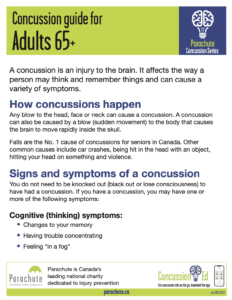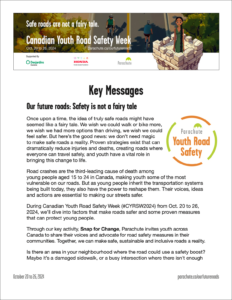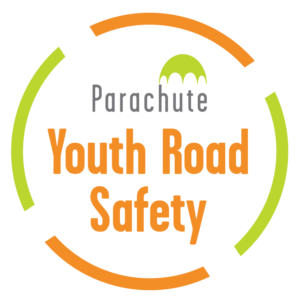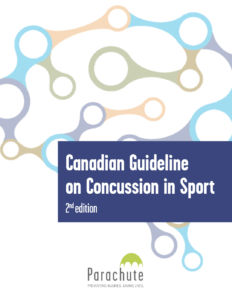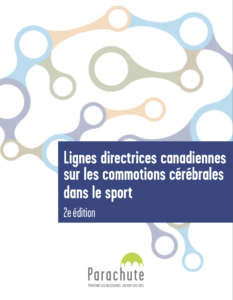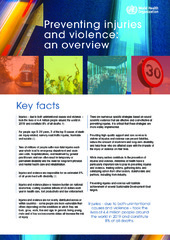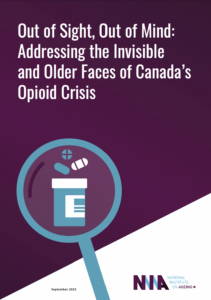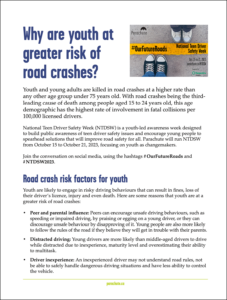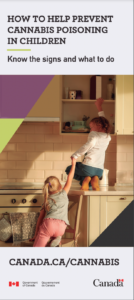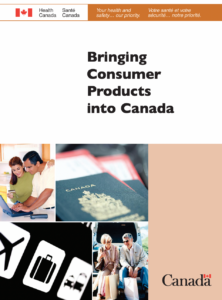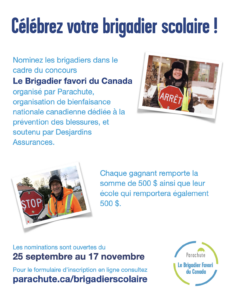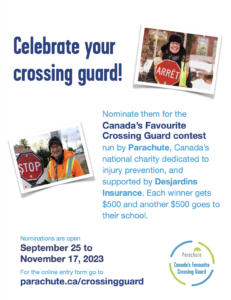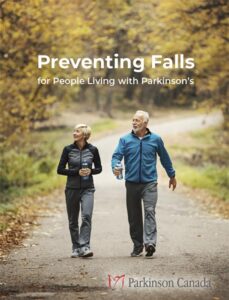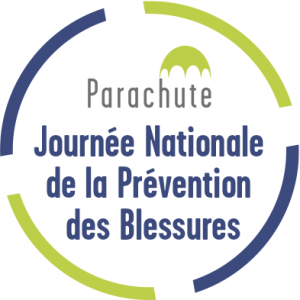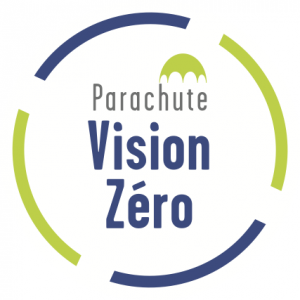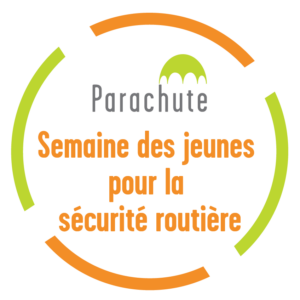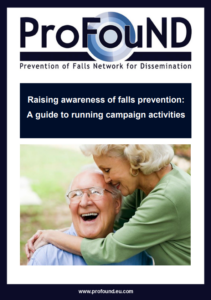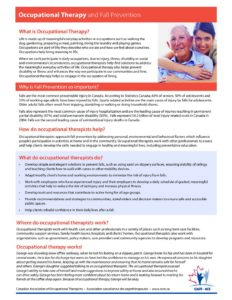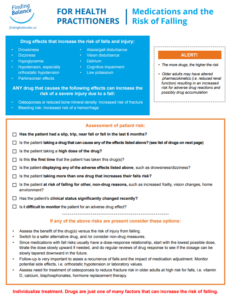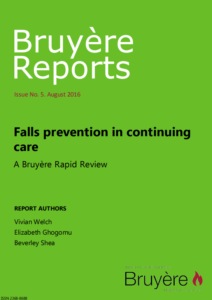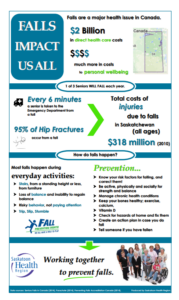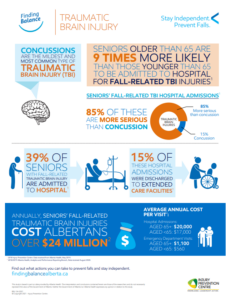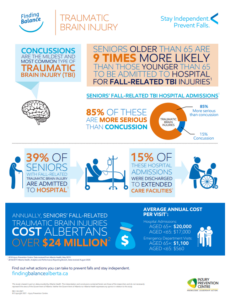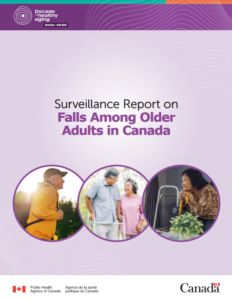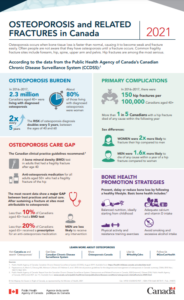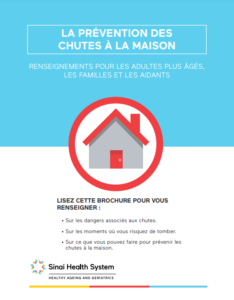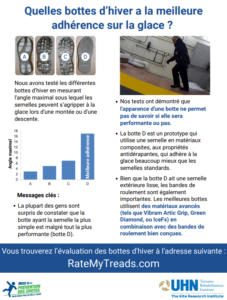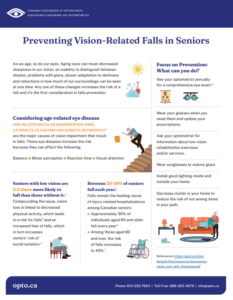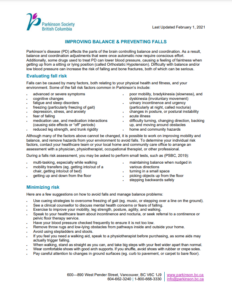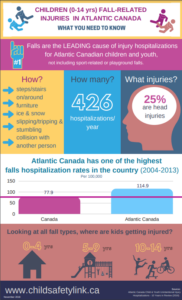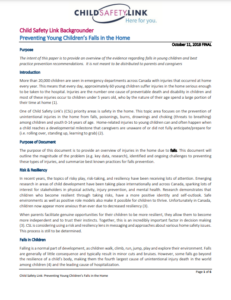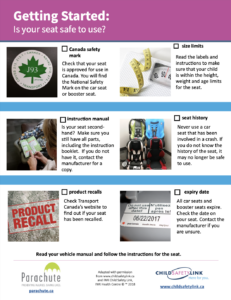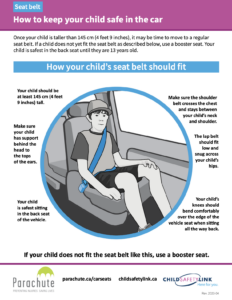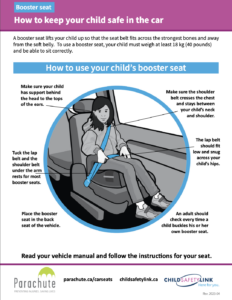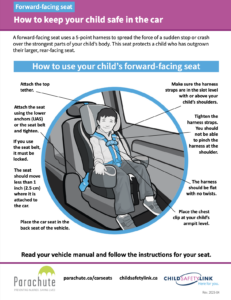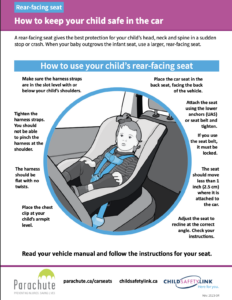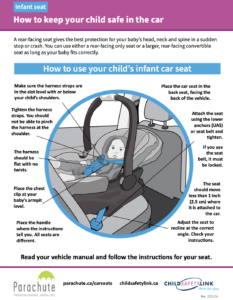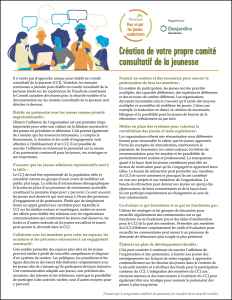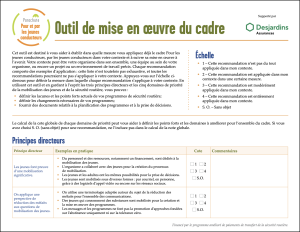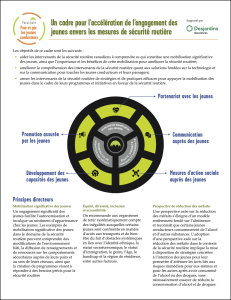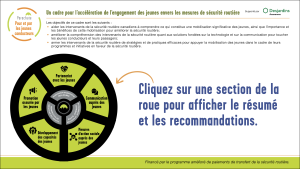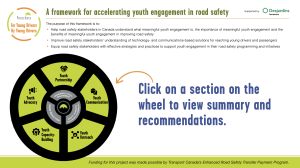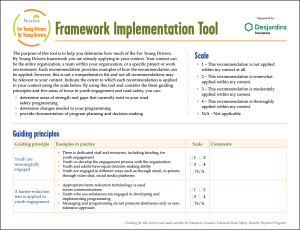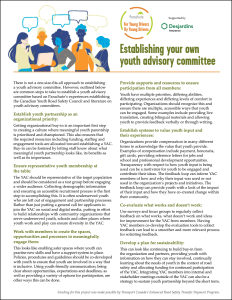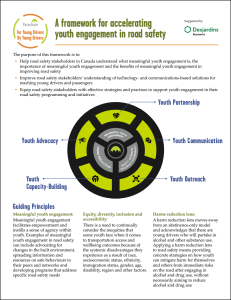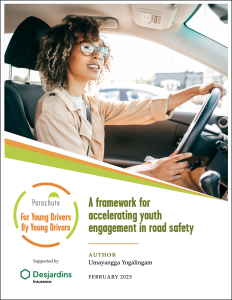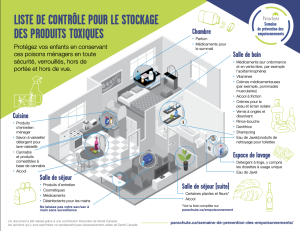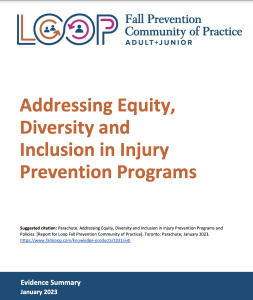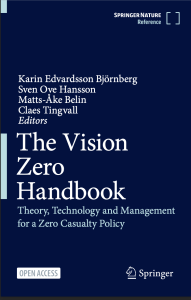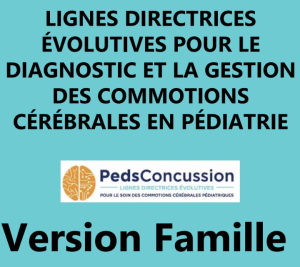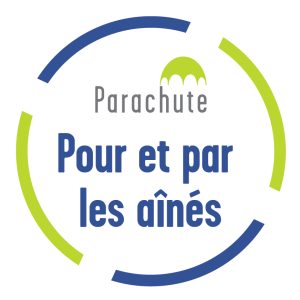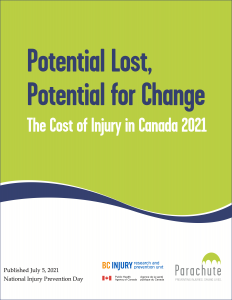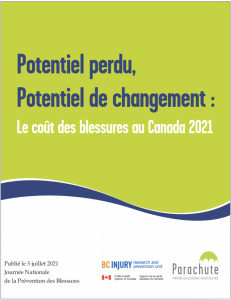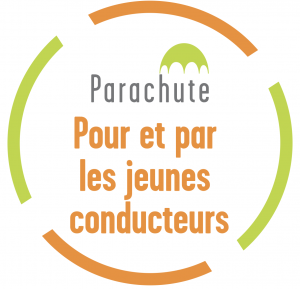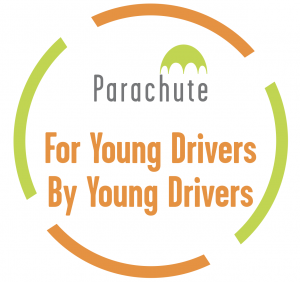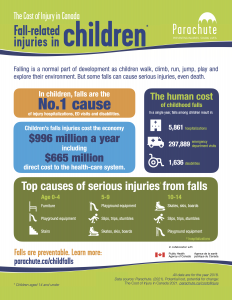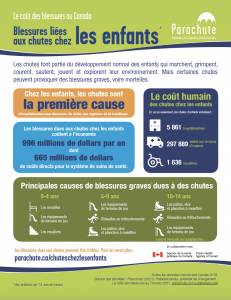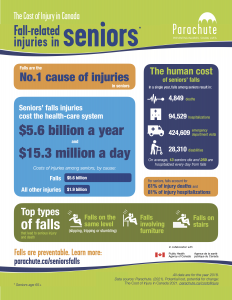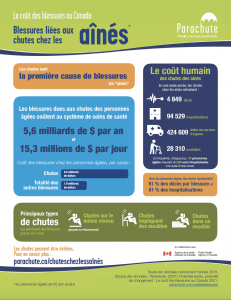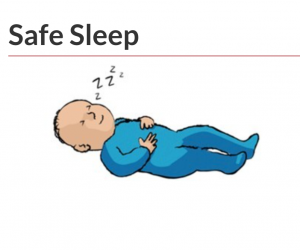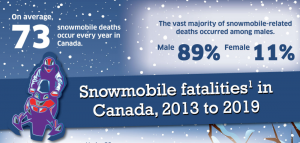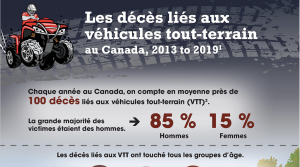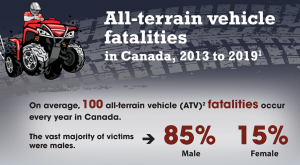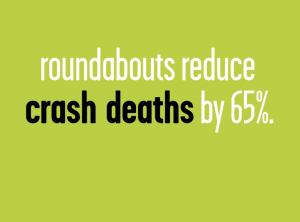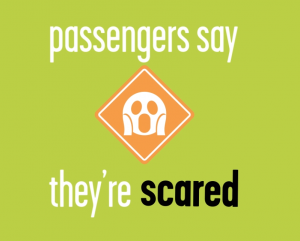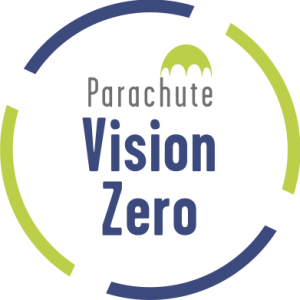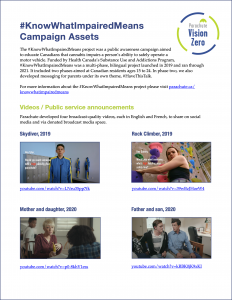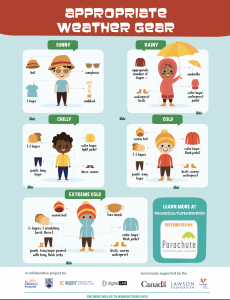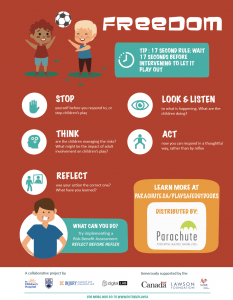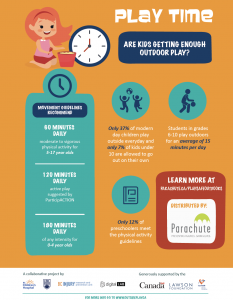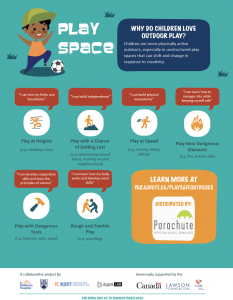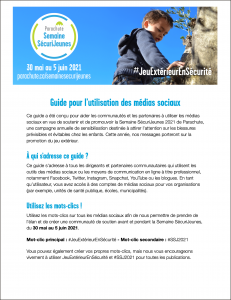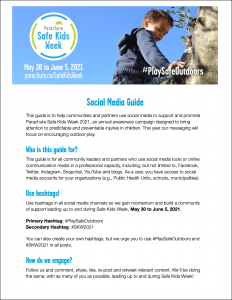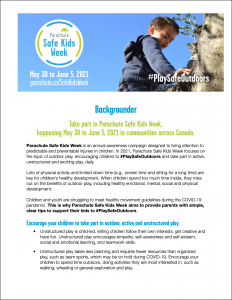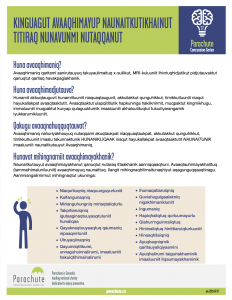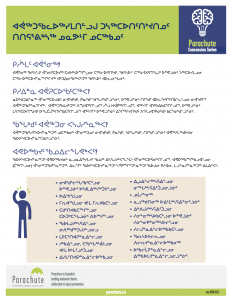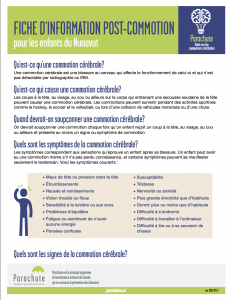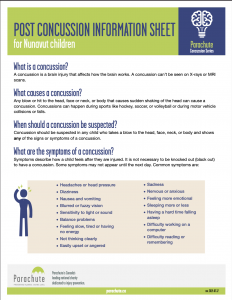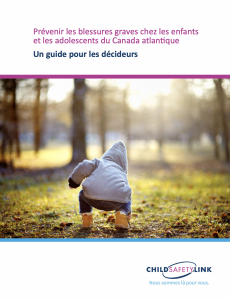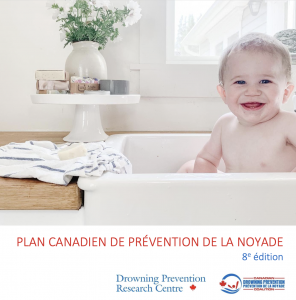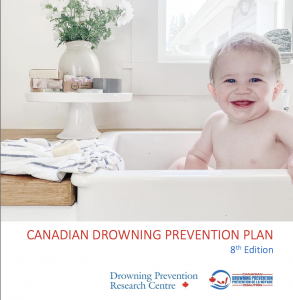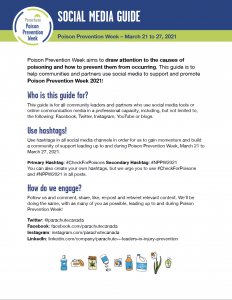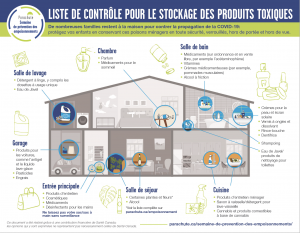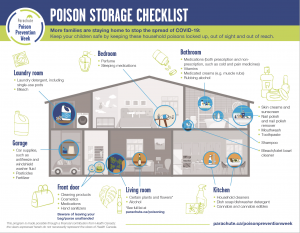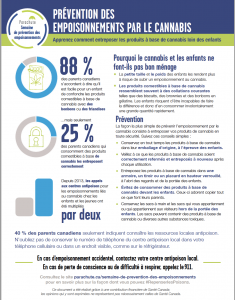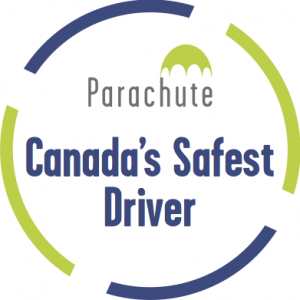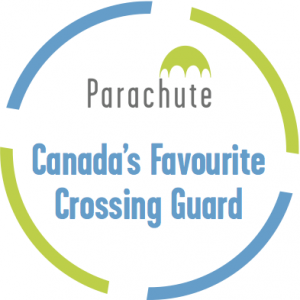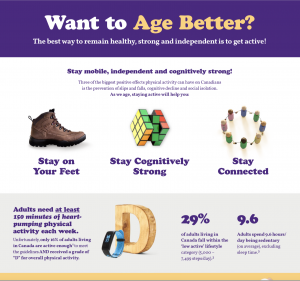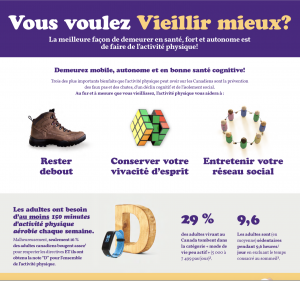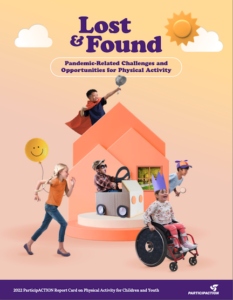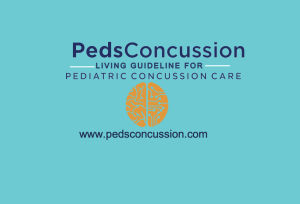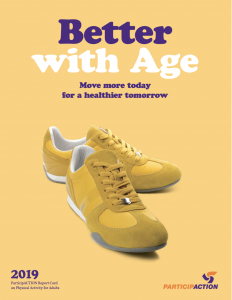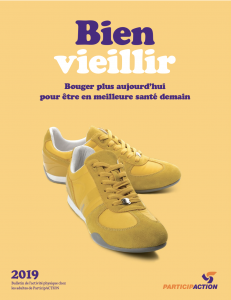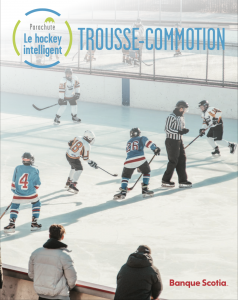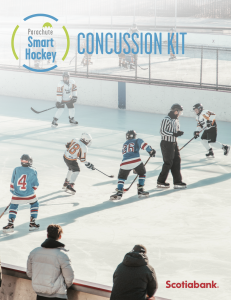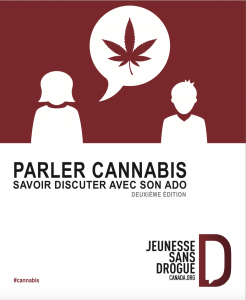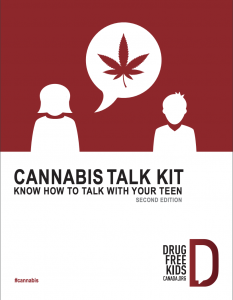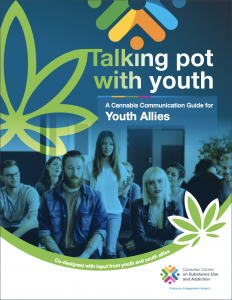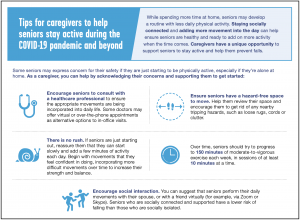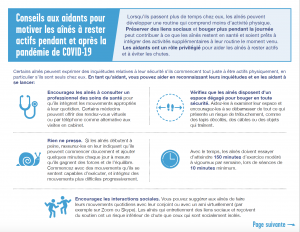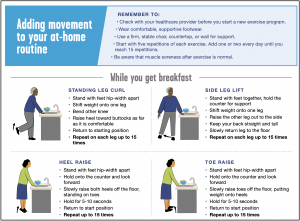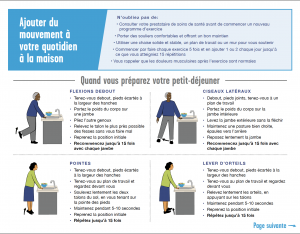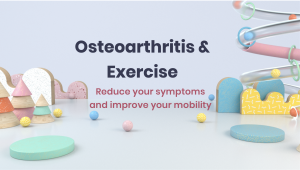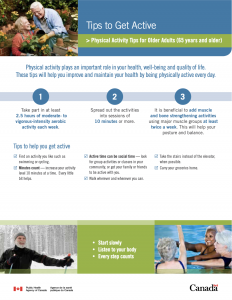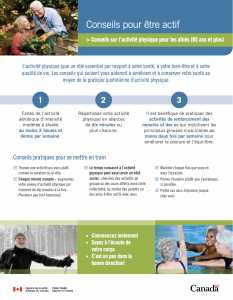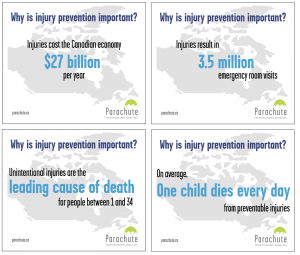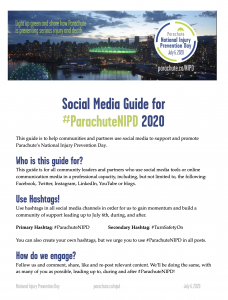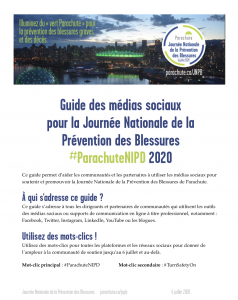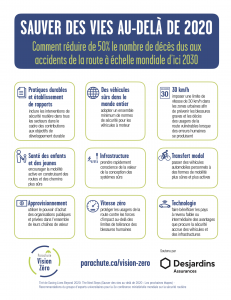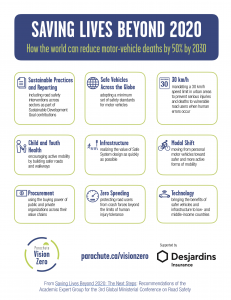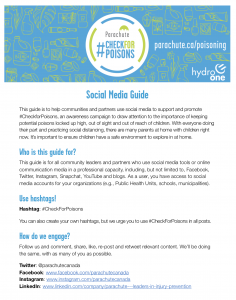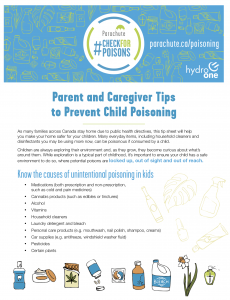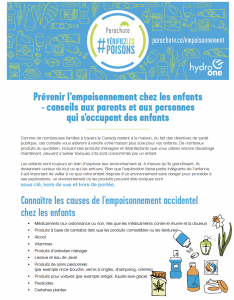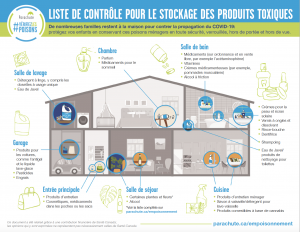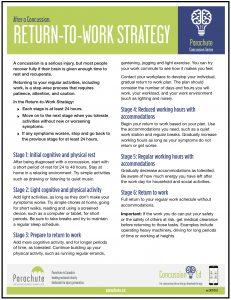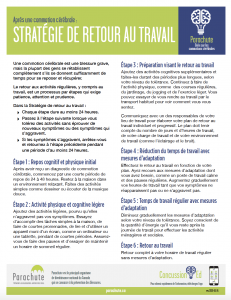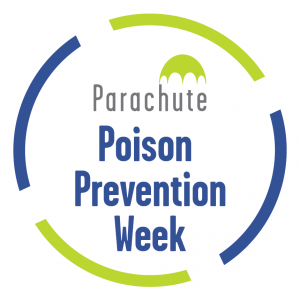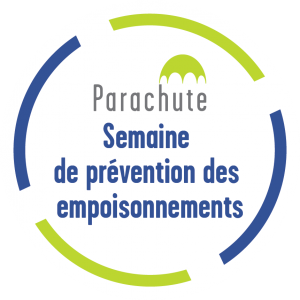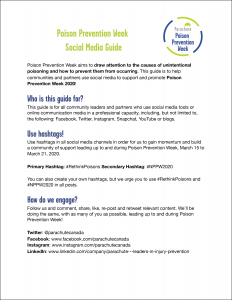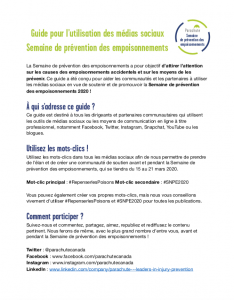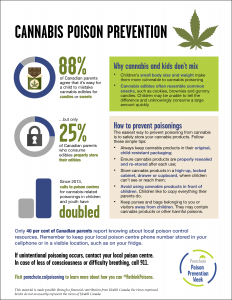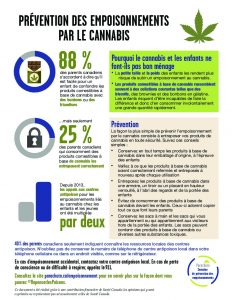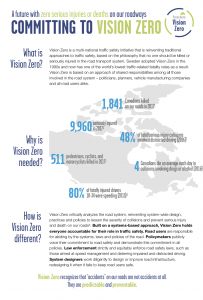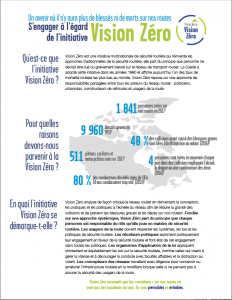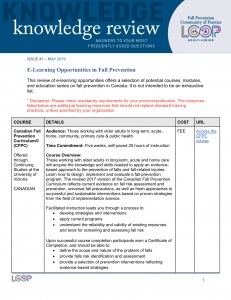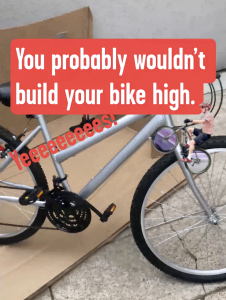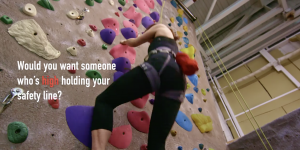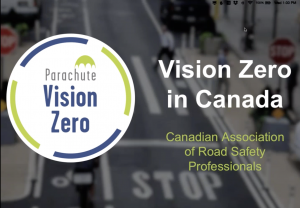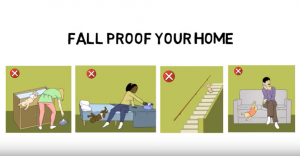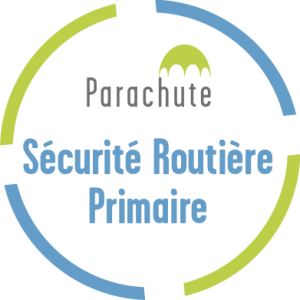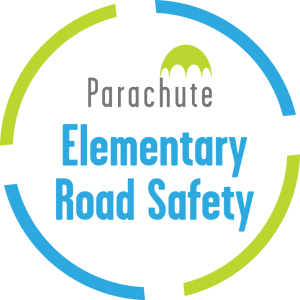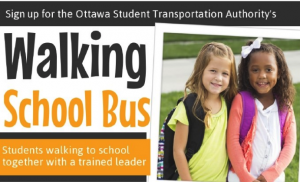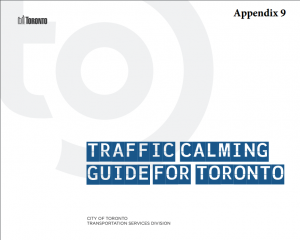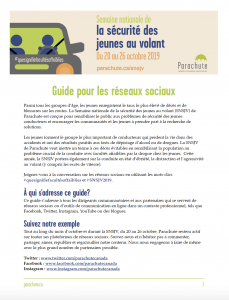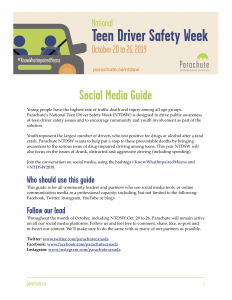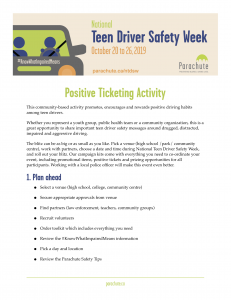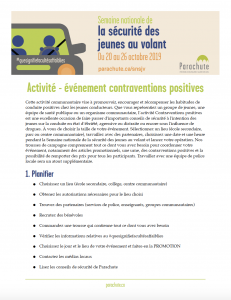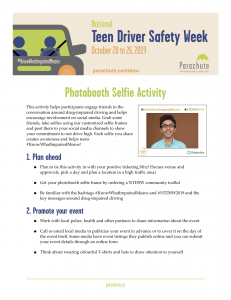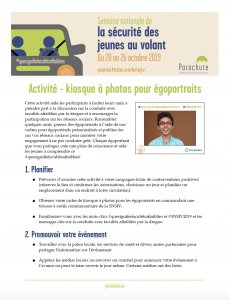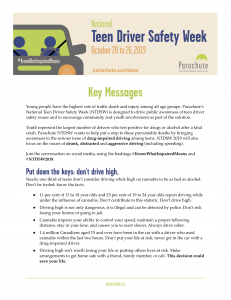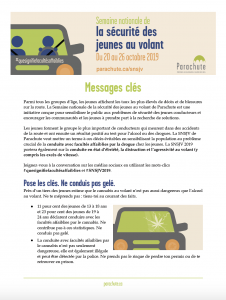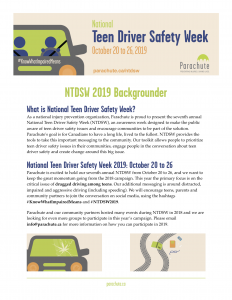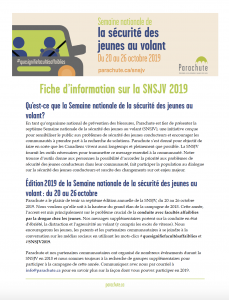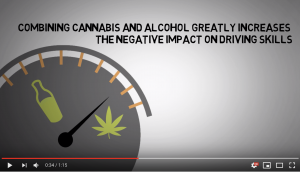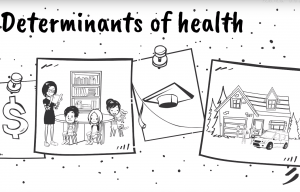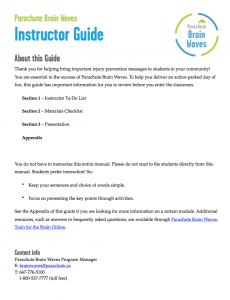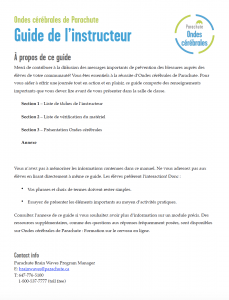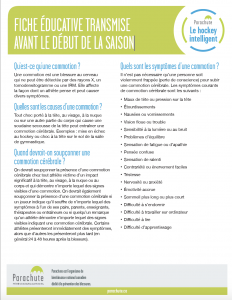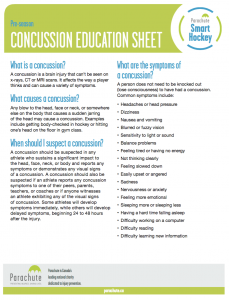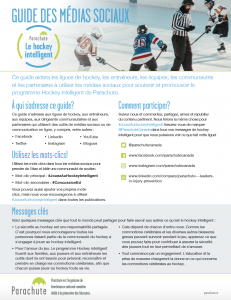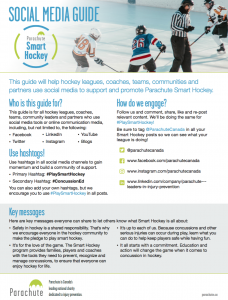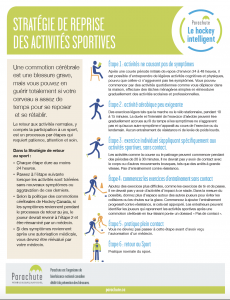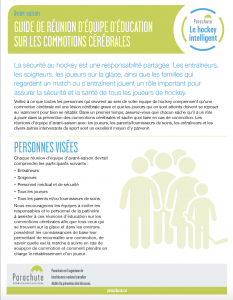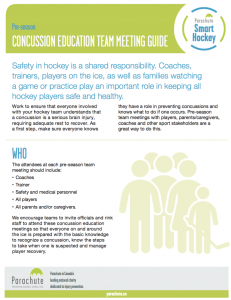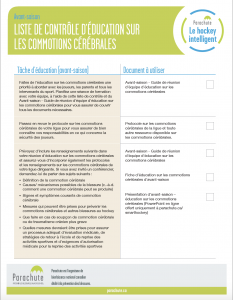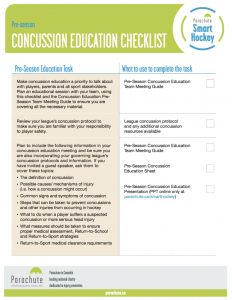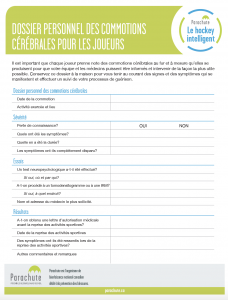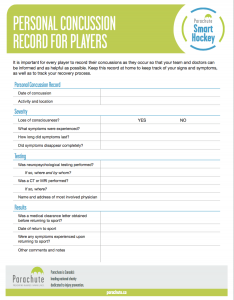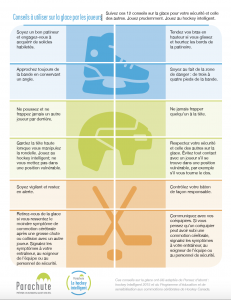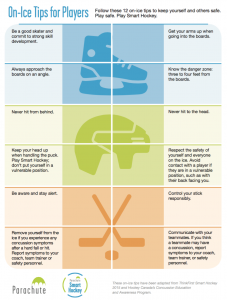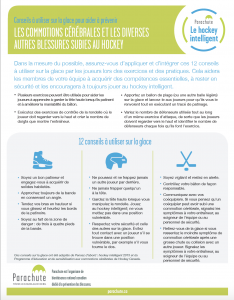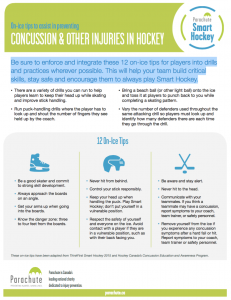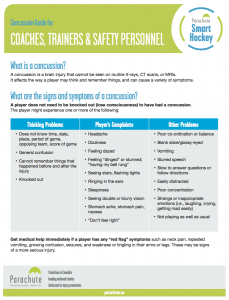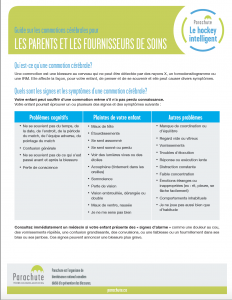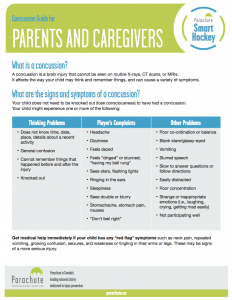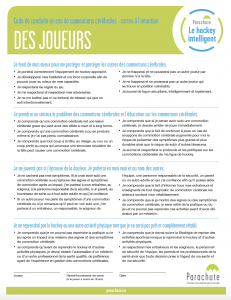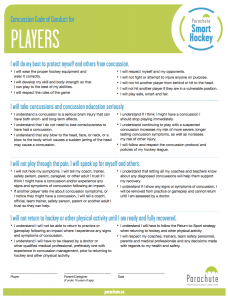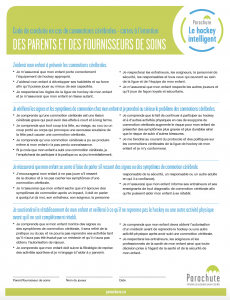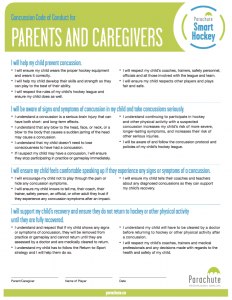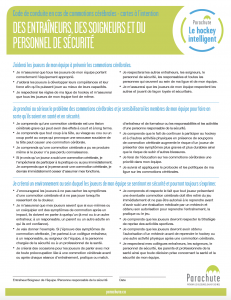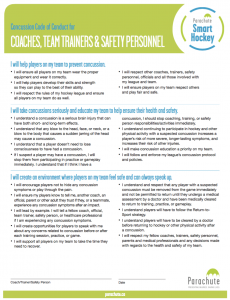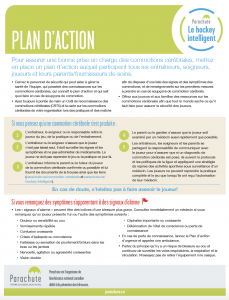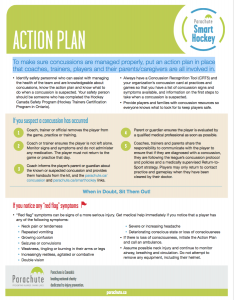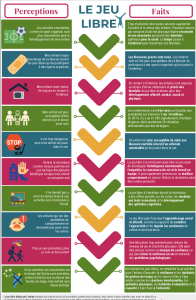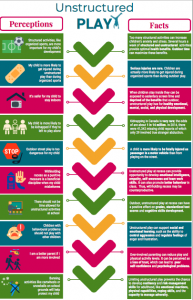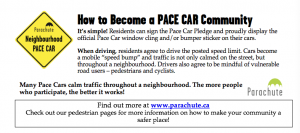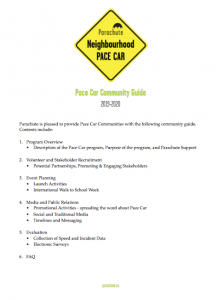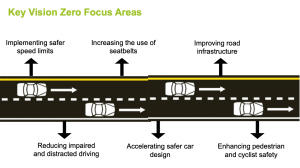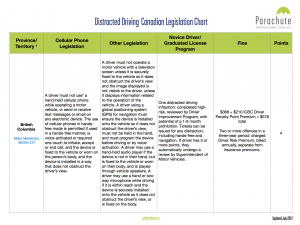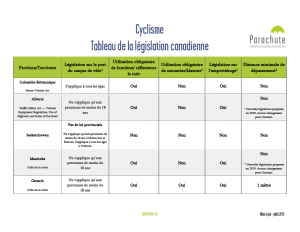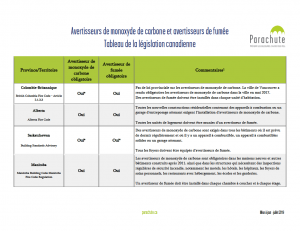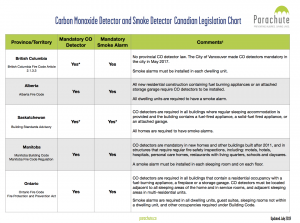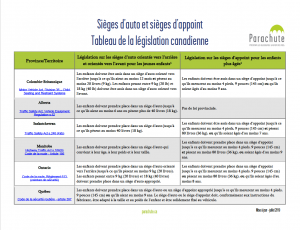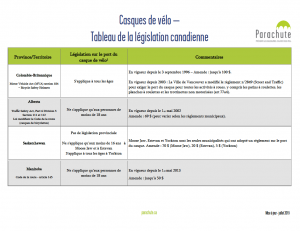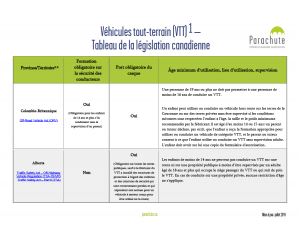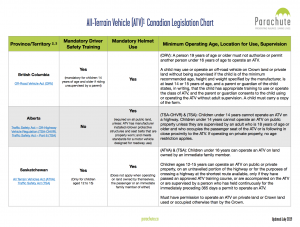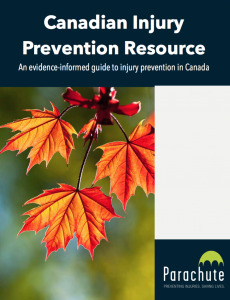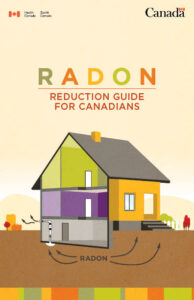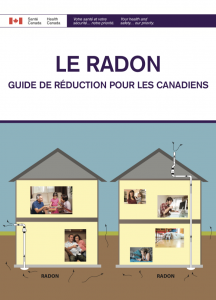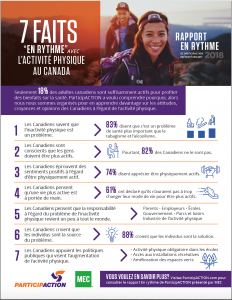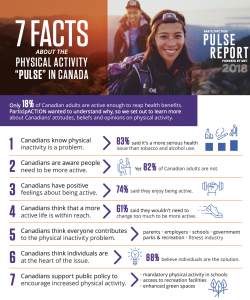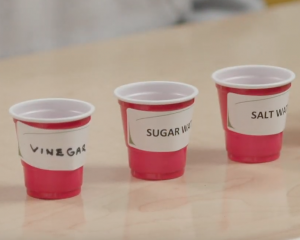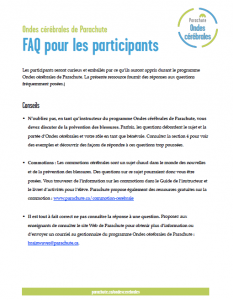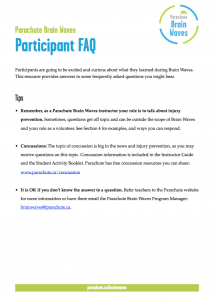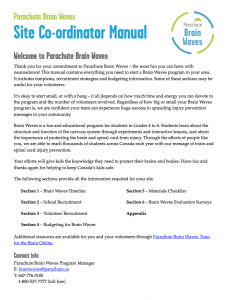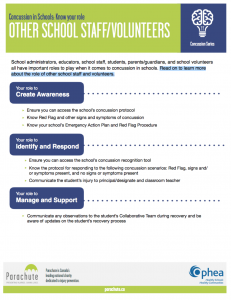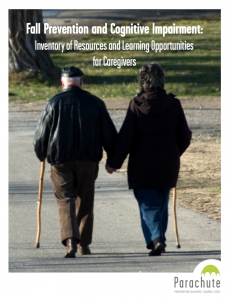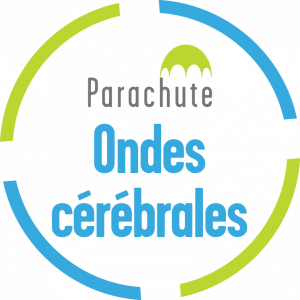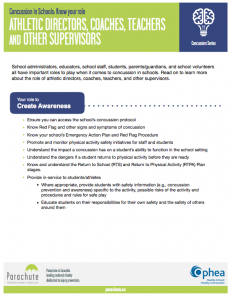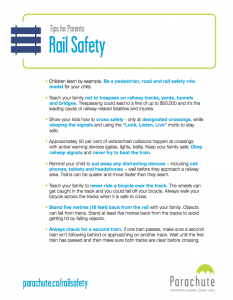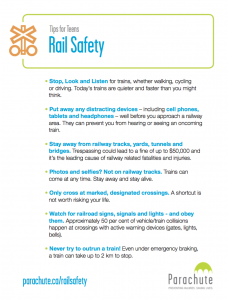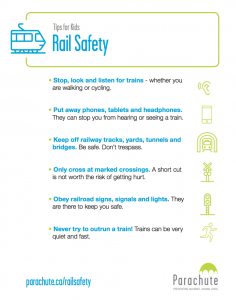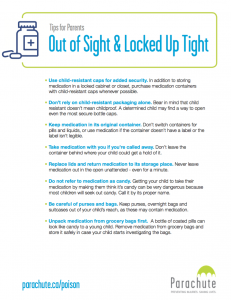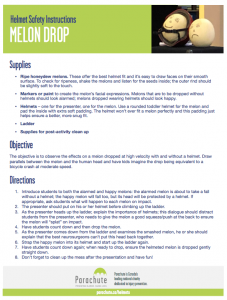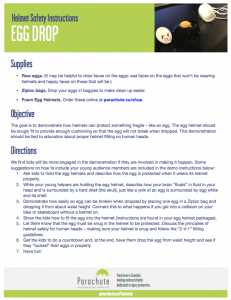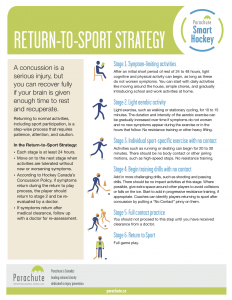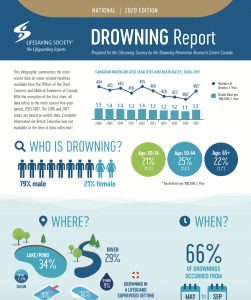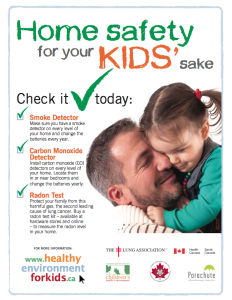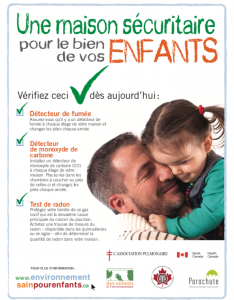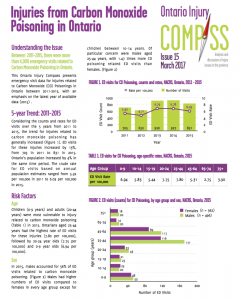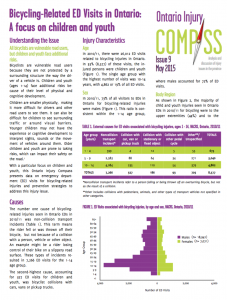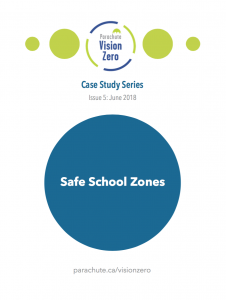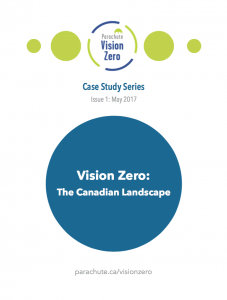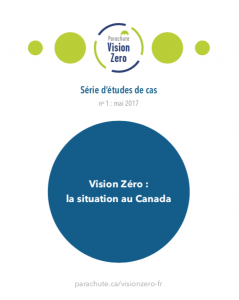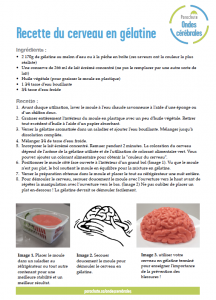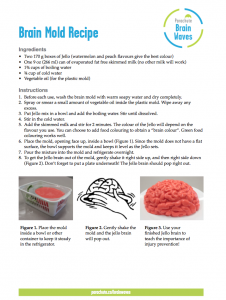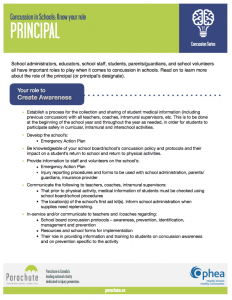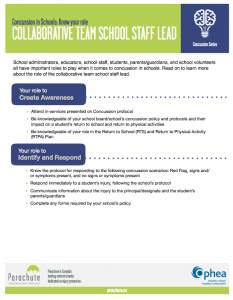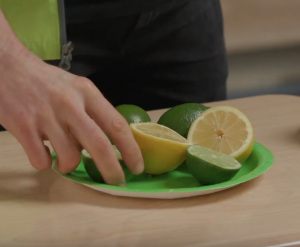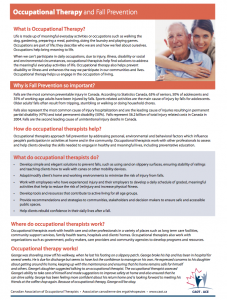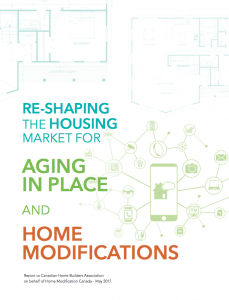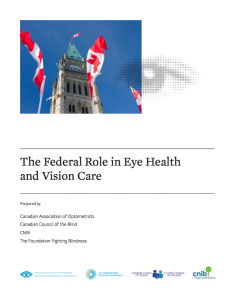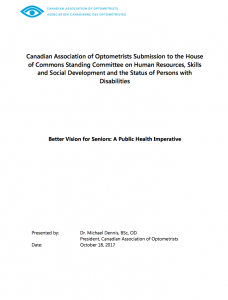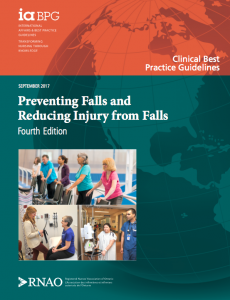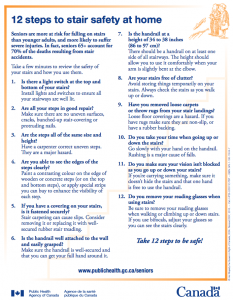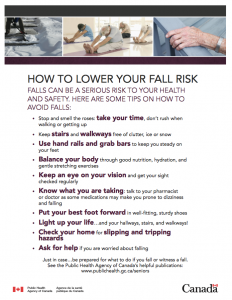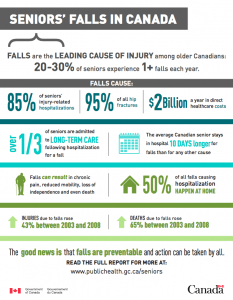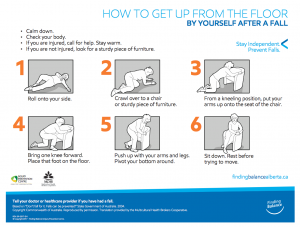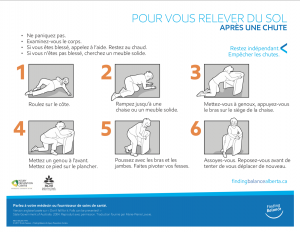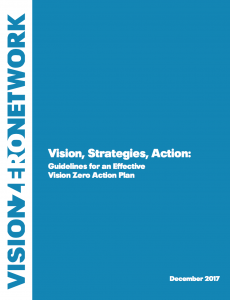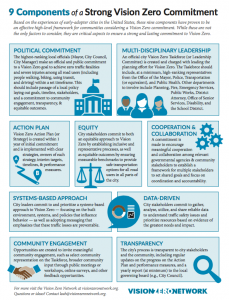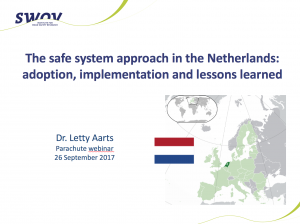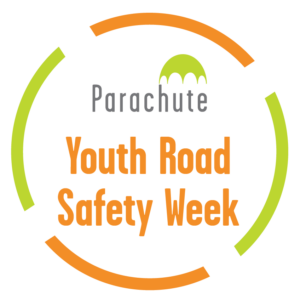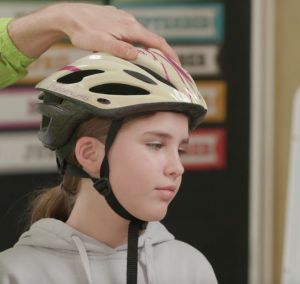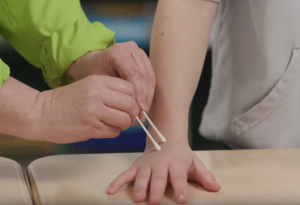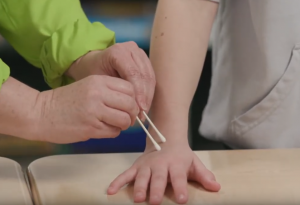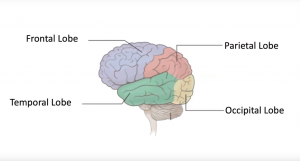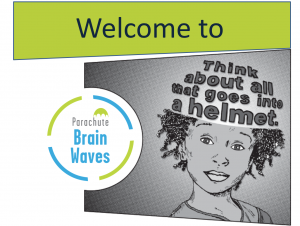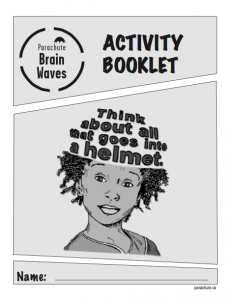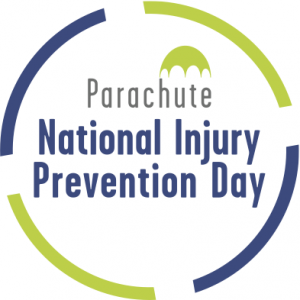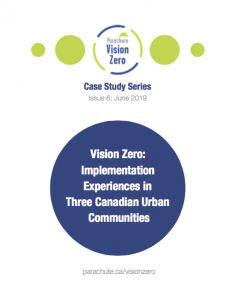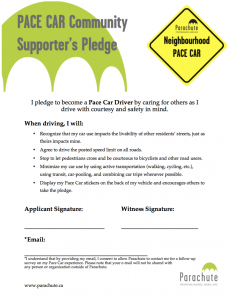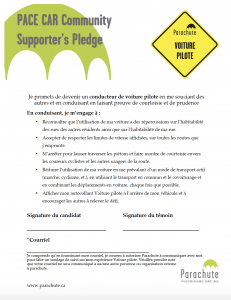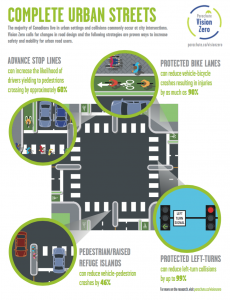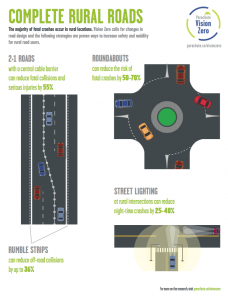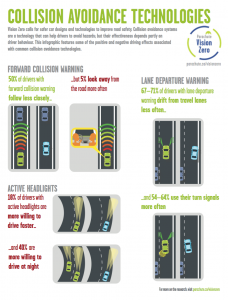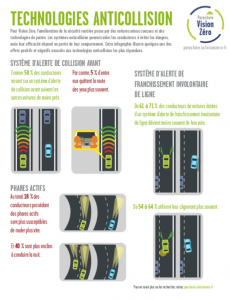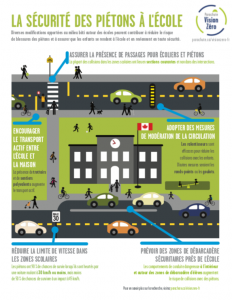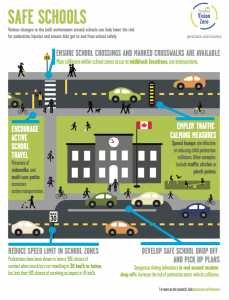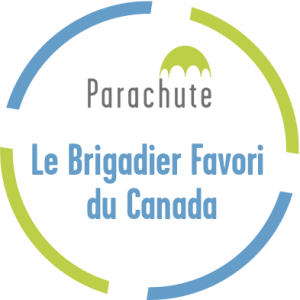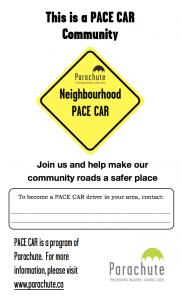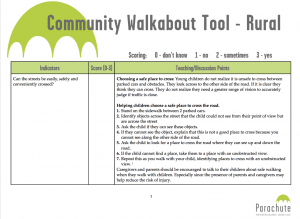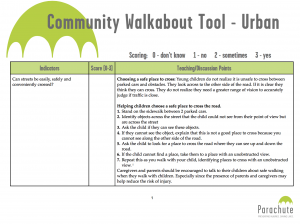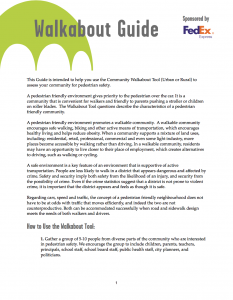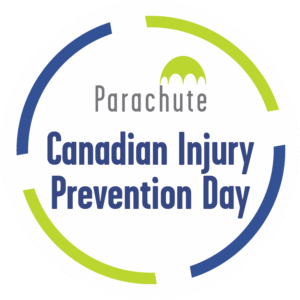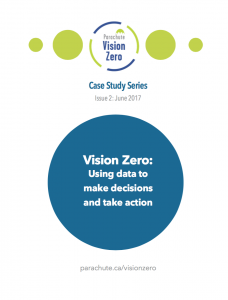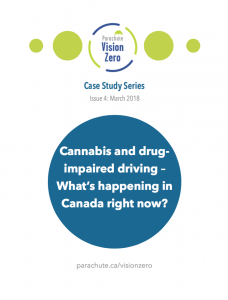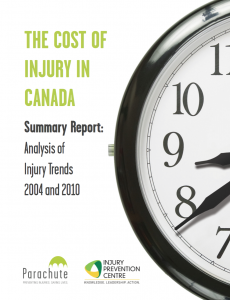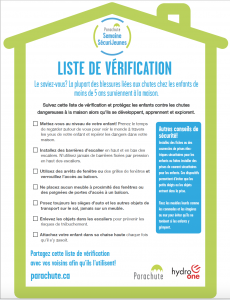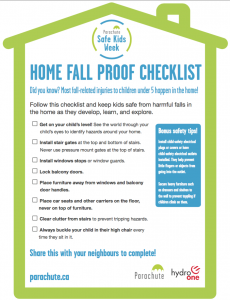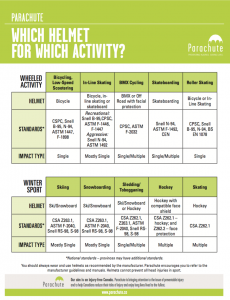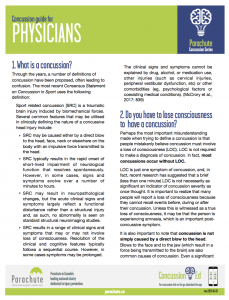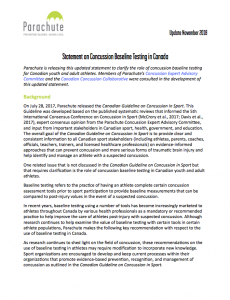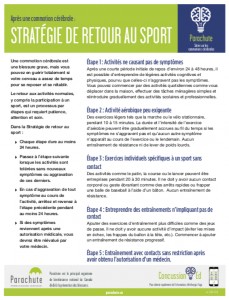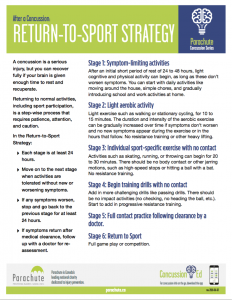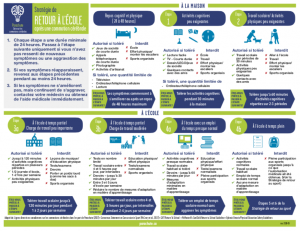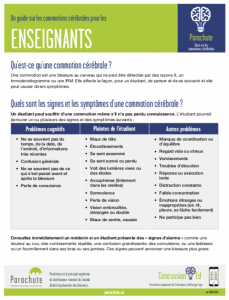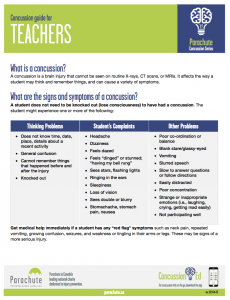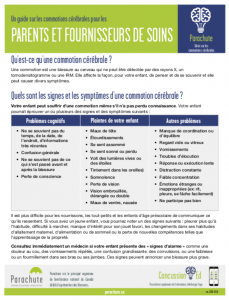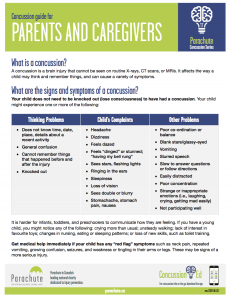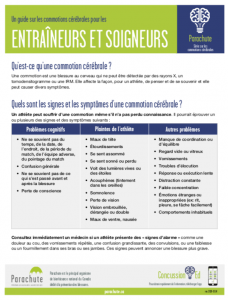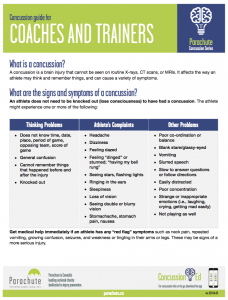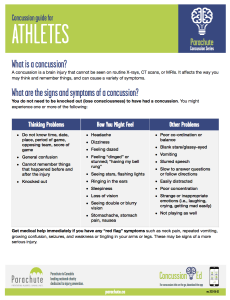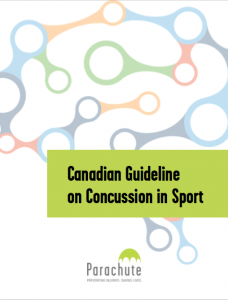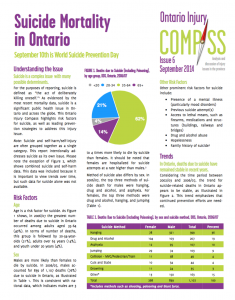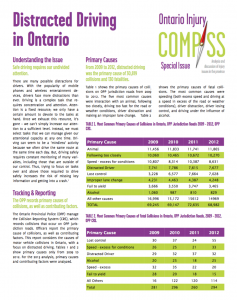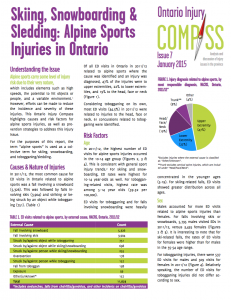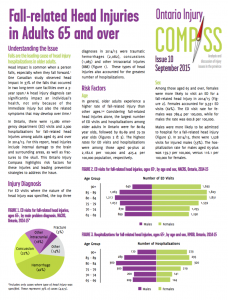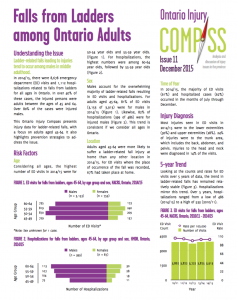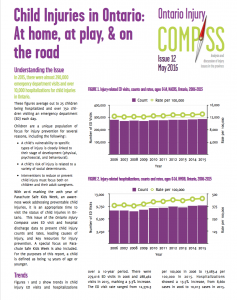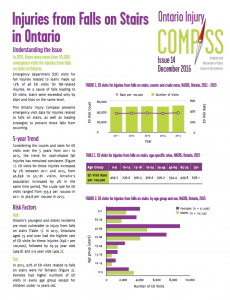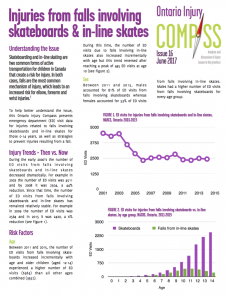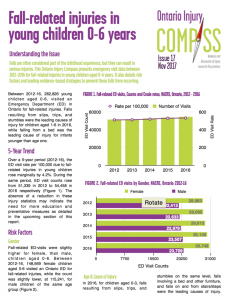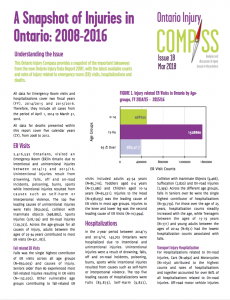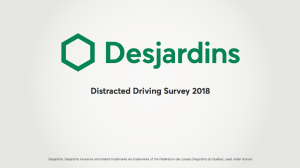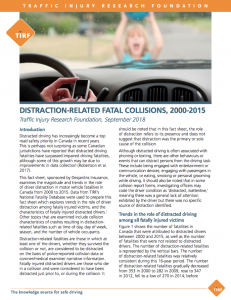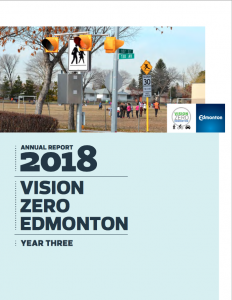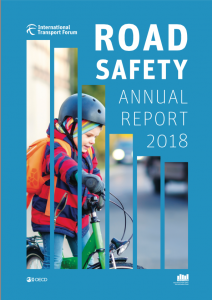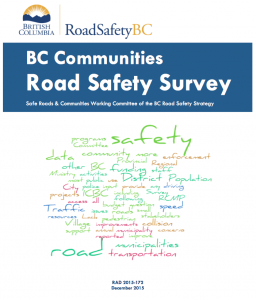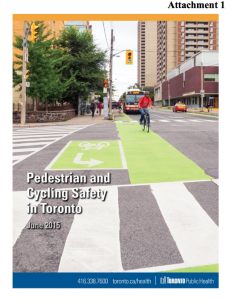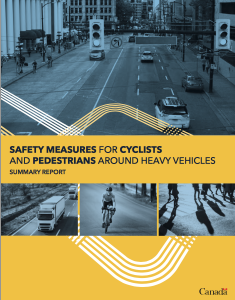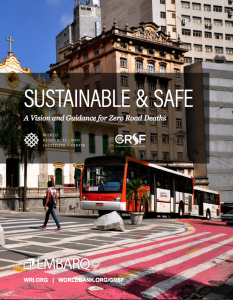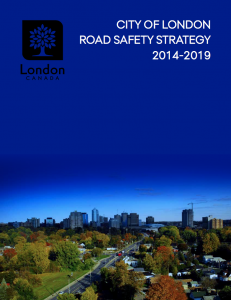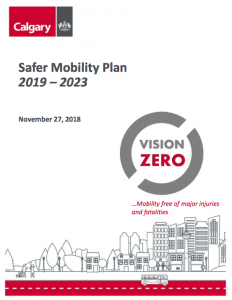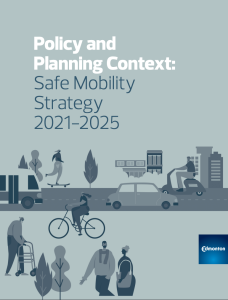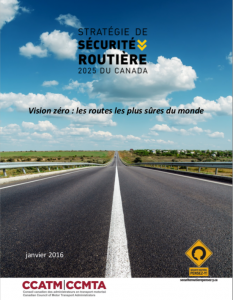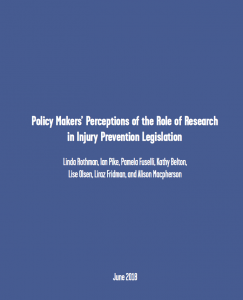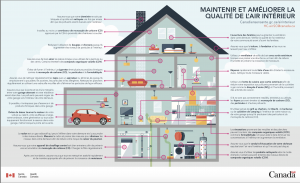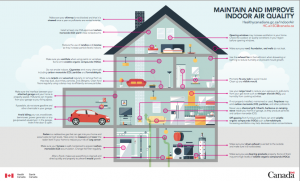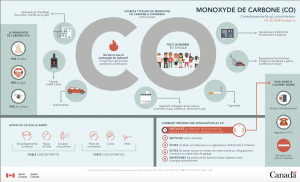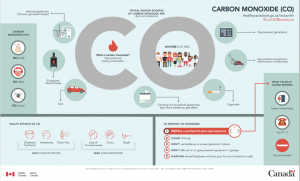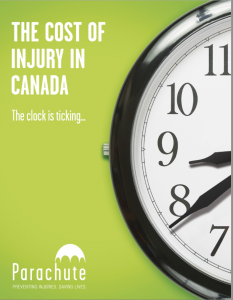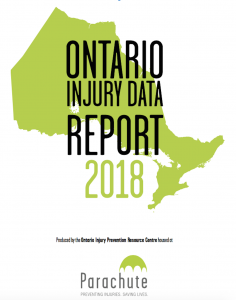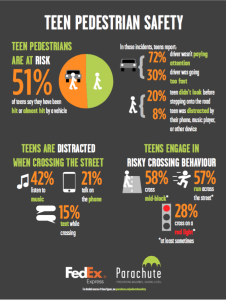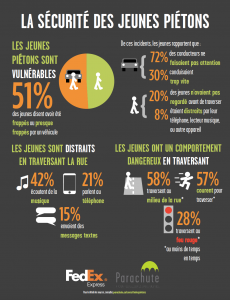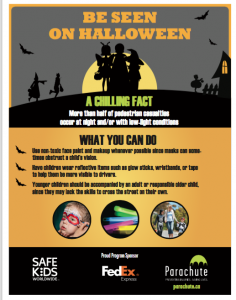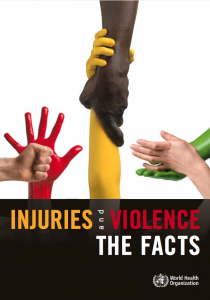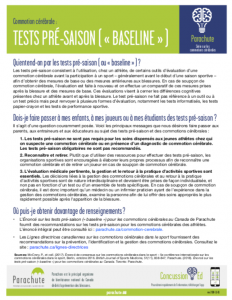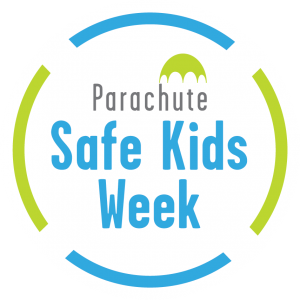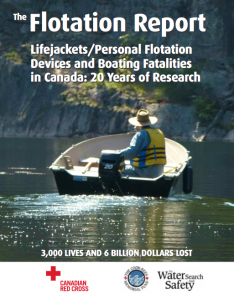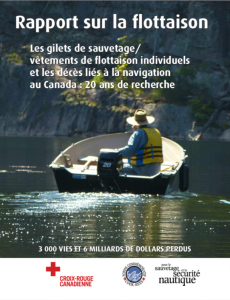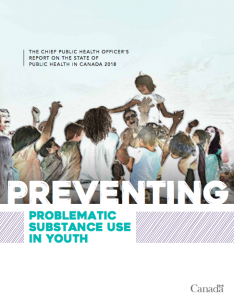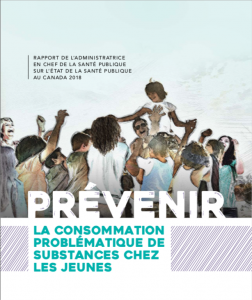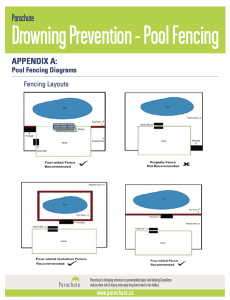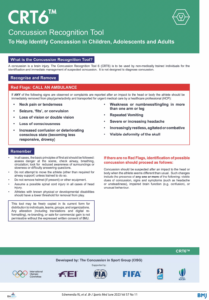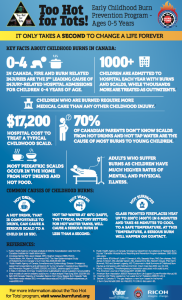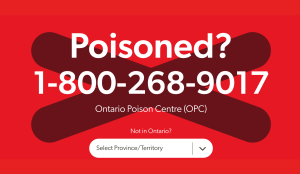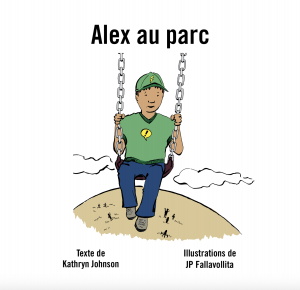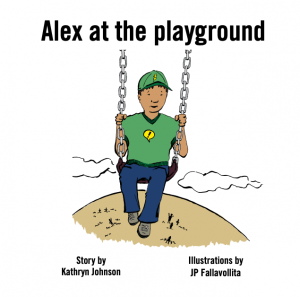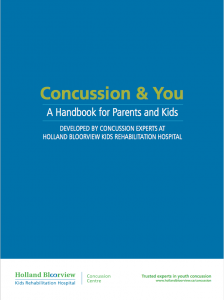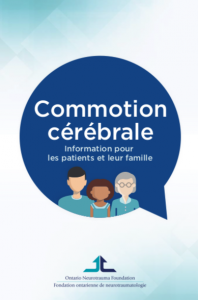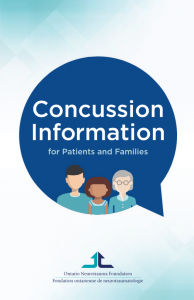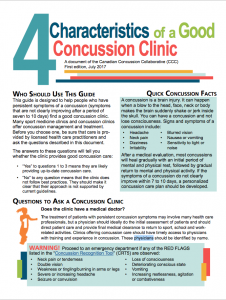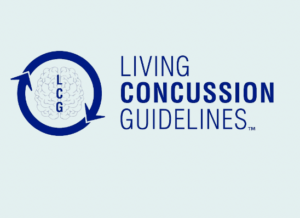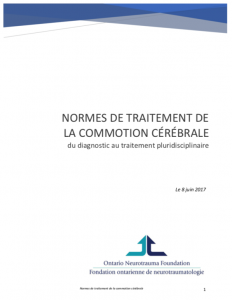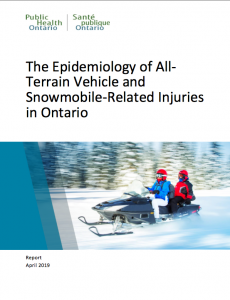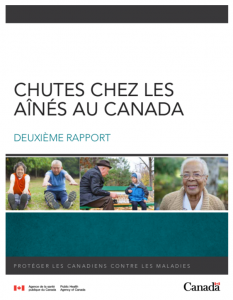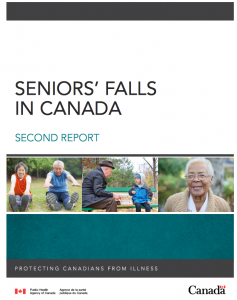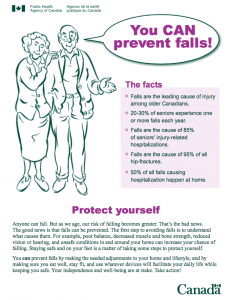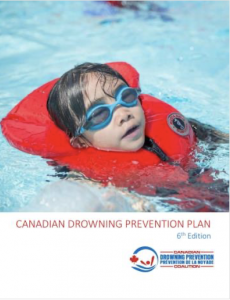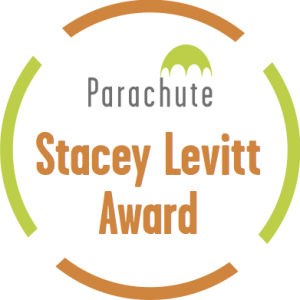Infographies/affiches
-
Lessons from sharing the waterfront with e-scooters and e-bikes
-
Les leçons tirées du partage du front de mer avec des trottinettes électriques et des vélos électriques
-
Insights from the 3rd Global Youth Assembly and 4th Global Ministerial Conference on Road Safety in Morocco
-
Comité des jeunes professionnels de l’ACPSER au Maroc : Perspectives de la troisième Assemblée mondiale des jeunes et de la quatrième Conférence mondiale sur la sécurité routière
-
Three crossing guards from Québec, Ontario and B.C. named Canada’s favourites for 2025
-
Trois brigadiers scolaires du Québec, de l’Ontario et de la Colombie-Britannique nommés les meilleurs du Canada pour 2025
-
Shaping the future: Youth voices in road safety (2025)
Across Canada, youth are driving meaningful change in road safety by leading innovative initiatives and advocacy efforts to create safer, more inclusive streets for everyone. Join moderator Benaaz Aronis, Senior Vice President, Desjardins Agent Network and Direct Insurance, Personal Lines for an inspiring webinar that highlights the power of youth-led road safety action and explores how organizations can meaningfully engage and collaborate with young leaders to strengthen their impact.
Opening remarks will be delivered by the Associate Deputy Minister of Transport Canada, Brigitte Diogo. Panelists will share how they have advanced road safety in their communities through improved infrastructure, policy influence and increased public awareness. We will also discuss key lessons learned and effective strategies for mobilizing peers and building partnerships to drive lasting change.
Panelists
Aidan D’Souza
Canadian Youth Road Safety Council MemberAlex Depew
Youth Program Coach, Golden Horseshoe Cycling HubWilamina Both
Civil Engineering student, York UniversitySponsors: Honda Canada Foundation and Desjardins Insurance
-
Introducing Canadian Injury Prevention Day
-
Présentation de la Journée Canadienne de la Prévention des Blessures
-
Maude Charron – Clique pour changer
-
Clique pour changer vidéo comment
-
Stephanie Henry on Snap for Change
-
Snap for Change how-to-submit video
-
Case study: the Québec walkshop Mis à jour
-
Étude de cas : L’atelier pédestre du Québec Mis à jour
-
Merci!
-
Learning from Success Stories in Injury and Violence Prevention
(45 minutes) Details success stories in injury prevention from the US and Canada, as well as the Public Health Approach to injury prevention.
-
Health Behaviour and Health Education: Examples from Injury Prevention (Short Version)
(22 minutes) Details the process of developing an intervention program for safe sleep using the precede/proceed planning framework.
-
Youth as Changemakers Award Nouveau
-
Prix Jeunes – Créateurs de changement Nouveau
-
Create a Snap for Change to improve road safety in your community
-
Participez à Clique pour changer pour améliorer la sécurité routière dans votre communauté
-
Revendiquer une meilleure sécurité par l’ajout d’un panneau d’arrêt
-
Advocating for improved safety through the addition of a stop sign
-
Revendiquer un marquage clair des voies sur une artère
-
Advocating for clear lane markings on an arterial road
-
Revendiquer des changements à une intersection achalandée près d’une école et d’un parc
-
Advocating for change at busy Belleville intersection near school and park
-
Revendiquer des vitesses sécuritaires et de meilleures infrastructures
-
Advocating for safe speeds and improved road infrastructure
-
Sécuriser une large chaussée par un marquage clair et une piste cyclable séparée
-
Addressing an unsafe wide road through clear markings and separated bike lane
-
RECOVR P.2: Lessons from the Road-Safety Evaluation During COVID-19 Among Vulnerable Users (2025)
Join moderator Stephanie Cowle, Director of Knowledge Translation at Parachute, in conversation with a panel of experts who will be presenting on:
• spatial trends in KSI collisions from Montreal, Toronto, Calgary and Vancouver with an equity lens.
• the evolution of bicycling infrastructure and its impact on cyclist infrastructure over time in Toronto, Calgary and Vancouver
• an evaluation of automated speed enforcement on speed reduction in the City of Toronto.Panelists:
Tim Chevrier
Research technician and GIS analyst, Laboratoire piétons et espaces urbainsPhilippe Brodeur-Ouimet
Research assistant, Laboratoire piétons et espaces urbainsRichard Wen
Postdoctoral Fellow, University of TorontoBrice Batomen Kuimi
Assistant Professor, Dalla Lana School of Public Health, University of TorontoSaroar Zubair
Clinical Research Co-ordinator, The Hospital for Sick Children -
From Pavement to Policy: Designing Streets for Safety, Equity, and Engagement (2025)
The Society for Advancement of Violence and Injury Research (SAVIR) and Parachute, Canada’s national charity dedicated to injury prevention, co-hosted a virtual Ask the Experts: Pedestrian Safety discussion. Moderators Valerie Smith, Director of Programs at Parachute and Dr. Elizabeth O’Neal, Assistant Professor, Department of Community and Behavioral Health, University of lowa and SAVIR Board Director, brought together experts across borders and disciplines. They covered factors and behaviours, engineering, citizen and community engagement, and policy to consider when designing and implementing solutions to create safe environments.
-
CIHR’s RECOVR project part 1: Insights into data gaps in vulnerable road user injury research (2025)
Moderator Pamela Fuselli, Parachute’s President and CEO, in conversation with panelists, discussed issues with the available road user data needed to estimate the burden of collision injury, with some examples from the Road-safety Evaluation During COVID-19 Among Vulnerable Road Users in Canada (RECOVR) project funded by the Canadian Institutes of Health Research (CIHR). Recent trends in cycling and pedestrian injuries following the COVID-19 pandemic in Canadian cities were presented using some of these data.
-
Snap for Change map
-
Carte de Clique pour changer
-
Addressing hazardous road conditions
-
Enhancing pedestrian safety through the addition of a sidewalk
-
Advocating for pothole repairs in the Richmond Hill High School parking lot
-
Advocating for traffic calming measures to promote pedestrian safety
-
Improving school zone safety in the Tuscany community
-
Advocating for a pedestrian-activated crosswalk to improve pedestrian safety
-
Advocating for road repairs to address sunken maintenance hole and pavement cracks
-
Advocating for traffic restrictions to improve safety and reduce congestion near Vaughan Mills
-
Advocating for pedestrian safety through leading pedestrian intervals at a high-risk intersection
-
Advocating for improved safety through additional pedestrian crossings
-
Advocating for improved safety through additional pedestrian pushbuttons
-
Advocating for clear lane markings
-
Remédier aux conditions routières dangereuses
-
Améliorer la sécurité des piétons par l’ajout d’un trottoir
-
Revendiquer la réparation des nids-de-poule dans le stationnement de la Richmond Hill High School
-
Revendiquer des mesures d’apaisement de la circulation pour protéger les piétons
-
Améliorer la sécurité des zones scolaires dans la communauté de Tuscany
-
Revendiquer un passage piéton activé par bouton-poussoir pour améliorer la sécurité
-
Revendiquer des réparations : regard de chaussée affaissé et fissures du revêtement
-
Revendiquer des restrictions de circulation pour améliorer la sécurité et réduire la congestion près de Vaughan Mills
-
Revendiquer la sécurité des piétons au moyen d’un intervalle de démarrage piétonnier à une intersection à risque
-
Revendiquer la sécurité des piétons par l’ajout de traversées
-
Revendiquer une meilleure sécurité par l’ajout d’un bouton-poussoir piétonnier
-
Revendiquer un marquage clair des voies
-
Amélioration de la visibilité pour les cyclistes et les piétons
-
Intersection visibility improvements
-
Bike and pedestrian safety enhancements
-
Speed control in school zones
-
Cycling and pedestrian visibility improvements
-
Speed reduction on gravel roads
-
Feeder bridge in need of repairs
-
Crossing light with a broken timer
-
Crosswalk needed near Pickering High School
-
Pedestrian facilities needed at a major crossing
-
Speed reduction and ASE cameras
-
Pedestrian facilities needed near transit exchange
-
Enhancing safety through speed reduction
-
Addressing hazardous maintenance holes on Victoria Park Road
-
Advocating for safe speeds at Newcastle Public School
-
Improving speed bump visibility near schools
-
Enhancing wildlife safety with increased signage and lighting
-
Addressing pedestrian safety gaps near Willoughby Town Centre
-
Repairing hazardous conditions on a bike path in Tuscany
-
Advocating for traffic calming measures near UBC
-
Advocating for improved pedestrian safety near Divine Mercy Catholic School
-
Améliorations de la visibilité aux intersections
-
Améliorations pour la sécurité des cyclistes et des piétons
-
Contrôle de la vitesse dans les zones scolaires
-
Réduction de la vitesse sur les chemins de gravier
-
Pont d’alimentation en eau nécessitant des réparations
-
Feu piétonnier à minuterie défectueuse
-
Nécessité d’un passage piéton près de l’école secondaire Pickering
-
Besoins en aménagements piétonniers à une importante traversée
-
Réduction de la vitesse et caméras de CAV
-
Aménagements piétonniers nécessaires près d’une station de correspondance de transport en commun
-
Améliorer la sécurité par la réduction de la vitesse
-
Rajustement de regards de chaussée dangereux
-
Revendiquer des vitesses sécuritaires à l’école publique Newcastle
-
Améliorer la visibilité des dos d’âne près des écoles
-
Sécurité de la faune : augmenter la signalisation et l’éclairage
-
Combler les lacunes de sécurité piétonne près de Willoughby Town
-
Remédier aux conditions dangereuses sur une piste cyclable à Tuscany
-
Revendiquer des mesures d’apaisement de la circulation près de l’UBC
-
Revendiquer une meilleure sécurité des piétons près de la Divine Mercy Catholic School
-
Is your local crossing guard a safety champion? Nominate them today to be Canada’s Favourite Crossing Guard!
-
Votre brigadier scolaire local est-il un champion de la sécurité ? Sélectionnez-le dès aujourd’hui pour recevoir le prix de Brigadier favori du Canada!
-
2024 Annual Report
-
2024 Annual Report
-
Q&A with Paul Mackey on Street Redesign and Traffic Calming
-
Séance de questions-réponses avec Paul Mackey sur la refonte des rues et la modération de la circulation
-
Q&A with Dr. Linda Rothman on Automated Speed Enforcement (ASE) in Toronto
-
Séance de questions-réponses avec la Dre Linda Rothman sur le contrôle automatisé de la vitesse (CAV) à Toronto
-
Projets d’ambassadeur 2024-2025
-
Parachute Youth Ambassadors projects 2024-25
-
Les gagnants
-
Previous years’ winners
-
testform
-
Key Messages – Canadian Youth Road Safety Week 2025
Key messages for Canadian Youth Road Safety Week 2025
2,60 MB PDF/UA
-
Messages clés – Semaine canadienne des jeunes pour la sécurité routière 2025
-
Managing speed, saving lives: A multifaceted approach webinar (2025)
Join us for an engaging and insightful webinar exploring the many facets of speed management, moderated by Valerie Smith, Director of Programs at Parachute. This panel discussion will bring together leading experts to highlight the importance of a comprehensive approach to reducing road speeds and improving safety.
Dr. Linda Rothman will share evidence on the effectiveness of Automated Speed Enforcement (ASE) in Toronto, Canada, backed by recent research. Paul Mackey will discuss the role of road design, road diets and traffic calming in managing vehicle speeds. Dr. Peter Burns, Chief of Human Factors and Crash Avoidance Research at Transport Canada, will provide insights into Intelligent Speed Assistance (ISA) and how vehicle design can help shape safer driving behaviour.
Whether you’re involved in transportation planning, policy, public health or road safety, this session will offer valuable perspectives on how evidence-informed, co-ordinated strategies can create safer roads for all.
Panelists:
Dr. Linda Rothman, Associate Professor, School of Occupational and Pubic Health, Toronto Metropolitan UniversityPaul Mackey, President at Safestreet
Dr. Peter Burns, Chief of Human Factors and Crash Avoidance Research, Transport Canada
-
L’Appui – English
L’Appui works to preserve the health, well-being and quality of life of caregivers by helping caregivers connect to resources available across Quebec. They provide caregivers with a resource directory, training and a helpline for support.
-
L’Appui
L’Appui travaille à préserver la santé, le bien-être et la qualité de vie des aidants en les aidant à se connecter aux ressources disponibles à travers le Québec. L’organisme met à la disposition des aidants un répertoire de ressources, des formations et une ligne téléphonique de soutien.
-
Caregivers Nova Scotia
Caregivers Nova Scotia is a non-profit organization providing free programs and services, support and advocacy to unpaid family and friend caregivers in Nova Scotia.
-
Caregivers Nova Scotia – français
Caregivers Nova Scotia est un organisme à but non lucratif qui apporte du soutien aux amis et membres des familles soignantes en Nouvelle-Écosse.
-
Caregivers Alberta
Caregivers Alberta provides resources, support and education to help people provide care to family members or friends. Services are wide-ranging to match the needs of caregivers: from a caregiver support line to one-on-one coaching and peer support groups to an award-winning caregiver education program, COMPASS for the Caregiver.
-
Canadian Centre for Caregiving Excellence
The Canadian Centre for Caregiving Excellence supports and empowers caregivers and care providers, advances the knowledge and capacity of the caregiving field, and advocates for effective and visionary social policy, with a disability-informed approach.
-
Centre canadien d’excellence pour les aidants
Le Centre canadien d’excellence pour les aidants appuie et habilite les aidants et les fournisseurs de soins, fait avancer les connaissances et la capacité d’agir dans le domaine des soins, et plaide en faveur de politiques sociales efficaces et visionnaires, tout en privilégiant une approche qui se veut à l’écoute des personnes ayant une incapacité.
-
Caregiving Matters
Caregiving Matters is an internet-based charity providing education and support to family caregivers.
-
Family Caregivers of British Columbia
Family Caregivers of BC (FCBC) proudly and compassionately supports more than one million people in British Columbia who provide physical and/or emotional care to a family member, partner, friend or neighbour. FCBC supports caregivers by providing access to information, education,and supports that enable caregivers to feel more confident and successful in their role.
-
How to Get Up From a Fall Instruction Video – Finding Balance Alberta
Description: This 30-second video explains what to do if you fall and how to get up safely by yourself if you are not hurt.
-
Feeding your baby in the first year
From the Canadian Paediatric Society, this resource provides tips for parents on feeding your baby in the first year, including information about nutrition, allergens, recognizing your child’s readiness to start solids and tips for preventing choking.
-
L’alimentation de votre bébé jusqu’à un an
Cette ressource de la Société canadienne de pédiatrie fournit des conseils aux parents sur l’alimentation de votre bébé au cours de la première année y compris des informations sur la nutrition et les aliments allergènes. Cette resource aide aussi les parents à comprendre comment savoir quand votre bébé est prêt à consommer des aliments solides et comment éviter les étouffements.
-
Battery safety: Lithium-ion batteries
The Government of Canada provides tips on how to safely use, charge and store your lithium-ion batteries, found in many electronic devices such as power tools, portable power banks and personal electronics.
-
Sécurité des piles : Piles au lithium-ion
Le gouvernement du Canada fournit des conseils sur la façon d’utiliser, de recharger et d’entreposer les piles au lithium-ion en toute sécurité. Les piles au lithium-ion se trouvent dans de nombreux appareils électroniques, notamment les outils électriques, chargeurs portatifs et appareils électroniques personnels.
-
I may be tired, but I can’t turn away
-
Je peux être fatigué, mais je ne peux pas me détourner
-
Social media images – Safe Kids Week 2025
-
Images des médias sociaux de la Semaine Sécuri
Jeunes 2025 -
Social media guide – Parachute Safe Kids Week 2025
-
Parachute Canadian Injury Prevention Day Template
-
Coco – Concussions in Early Childhood
The COCO tools support parents, educational staff, and healthcare professionals in identifying concussions and aiding the recovery of young children.
-
Keep safety in mind when shopping online
Learn how to be a smart shopper and keep safety in mind when buying consumer products and cosmetics online.
-
Pensez sécurité lors de vos achats en ligne
Renseignez-vous sur les façons de faire des achats intelligents et pensez sécurité lorsque vous achetez des produits de consommation et des cosmétiques en ligne.
-
Reflections on the 4th Global Ministerial Conference on Road Safety
-
Réflexions sur la 4e Conférence ministérielle mondiale sur la sécurité routière
-
Multilingual concussion resources
-
Ressources multilingues sur les commotions cérébrales
-
Return-to-Work Strategy (2024) (Traditional Chinese)
A six-step approach for a gradual return to work activities and the workplace.
365,87 KB PDF/UA
-
Stratégie de retour au travail (2024) (Chinois traditionnel)
Une approche en six étapes pour un retour graduel aux activités et à l’environnement de travail.
365,87 KB PDF/UA
-
Return-to-Work Strategy (2024) (Tagalog)
A six-step approach for a gradual return to work activities and the workplace.
230,54 KB PDF/UA
-
Stratégie de retour au travail (2024) (Tagalog)
Une approche en six étapes pour un retour graduel aux activités et à l’environnement de travail.
230,54 KB PDF/UA
-
Return-to-Work Strategy (2024) (Spanish)
A six-step approach for a gradual return to work activities and the workplace.
246,52 KB PDF/UA
-
Stratégie de retour au travail (2024) (Espagnol)
Une approche en six étapes pour un retour graduel aux activités et à l’environnement de travail.
246,52 KB PDF/UA
-
Return-to-Work Strategy (2024) (Simplified Chinese)
A six-step approach for a gradual return to work activities and the workplace.
402,97 KB PDF/UA
-
Stratégie de retour au travail (2024) (Chinois simplifié)
Une approche en six étapes pour un retour graduel aux activités et à l’environnement de travail.
402,97 KB PDF/UA
-
Return-to-Work Strategy (2024) (Punjabi)
A six-step approach for a gradual return to work activities and the workplace.
248,59 KB PDF/UA
-
Stratégie de retour au travail (2024) (Pendjabi)
Une approche en six étapes pour un retour graduel aux activités et à l’environnement de travail.
248,59 KB PDF/UA
-
Return-to-Work Strategy (2024) (Hindi)
A six-step approach for a gradual return to work activities and the workplace.
292,70 KB PDF/UA
-
Stratégie de retour au travail (2024) (Hindi)
Une approche en six étapes pour un retour graduel aux activités et à l’environnement de travail.
292,70 KB PDF/UA
-
Return-to-Work Strategy (2024) (Arabic)
A six-step approach for a gradual return to work activities and the workplace.
324,42 KB PDF/UA
-
Stratégie de retour au travail (2024) (Arabe)
Une approche en six étapes pour un retour graduel aux activités et à l’environnement de travail.
324,42 KB PDF/UA
-
Return-to-Sport Strategy (2024) (Traditional Chinese)
A six-step approach for a gradual return to physical activity and sport participation.
352,73 KB PDF/UA
-
Stratégie de retour au sport (2024) (Chinois traditionnel)
Une approche en six étapes pour un retour graduel à l’activité physique et à la participation aux activités sportives.
352,73 KB PDF/UA
-
Return-to-Sport Strategy (2024) (Tagalog)
A six-step approach for a gradual return to physical activity and sport participation.
247,73 KB PDF/UA
-
Stratégie de retour au sport (2024) (Tagalog)
Une approche en six étapes pour un retour graduel à l’activité physique et à la participation aux activités sportives.
247,73 KB PDF/UA
-
Return-to-Sport Strategy (2024) (Spanish)
A six-step approach for a gradual return to physical activity and sport participation.
205,15 KB PDF/UA
-
Stratégie de retour au sport (2024) (Espagnol)
Une approche en six étapes pour un retour graduel à l’activité physique et à la participation aux activités sportives.
205,15 KB PDF/UA
-
Return-to-Sport Strategy (2024) (Simplified Chinese)
A six-step approach for a gradual return to physical activity and sport participation.
360,08 KB PDF/UA
-
Stratégie de retour au sport (2024) (Chinois simplifié)
Une approche en six étapes pour un retour graduel à l’activité physique et à la participation aux activités sportives.
360,08 KB PDF/UA
-
Return-to-Sport Strategy (2024) (Punjabi)
A six-step approach for a gradual return to physical activity and sport participation.
199,17 KB PDF/UA
-
Stratégie de retour au sport (2024) (Pendjabi)
Une approche en six étapes pour un retour graduel à l’activité physique et à la participation aux activités sportives.
199,17 KB PDF/UA
-
Return-to-Sport Strategy (2024) (Hindi)
A six-step approach for a gradual return to physical activity and sport participation.
266,72 KB PDF/UA
-
Stratégie de retour au sport (2024) (Hindi)
Une approche en six étapes pour un retour graduel à l’activité physique et à la participation aux activités sportives.
266,72 KB PDF/UA
-
Return-to-Sport Strategy (2024) (Arabic)
A six-step approach for a gradual return to physical activity and sport participation.
250,76 KB PDF/UA
-
Stratégie de retour au sport (2024) (Arabe)
Une approche en six étapes pour un retour graduel à l’activité physique et à la participation aux activités sportives.
250,76 KB PDF/UA
-
Return-to-School Strategy (2024) (Traditional Chinese)
A four-step approach for a gradual return to cognitive activities and the learning environment.
218,19 KB PDF/UA
-
Stratégie de retour à l’école (2024) (Chinois traditionnel)
Une approche en quatre étapes pour un retour progressif aux activités cognitives et à l’apprentissage.
218,19 KB PDF/UA
-
Return-to-School Strategy (2024) (Tagalog)
A four-step approach for a gradual return to cognitive activities and the learning environment.
143,35 KB PDF/UA
-
Stratégie de retour à l’école (2024) (Tagalog)
Une approche en quatre étapes pour un retour progressif aux activités cognitives et à l’apprentissage.
143,35 KB PDF/UA
-
Return-to-School Strategy (2024) (Spanish)
A four-step approach for a gradual return to cognitive activities and the learning environment.
150,69 KB PDF/UA
-
Stratégie de retour à l’école (2024) (Espagnol)
Une approche en quatre étapes pour un retour progressif aux activités cognitives et à l’apprentissage.
150,69 KB PDF/UA
-
Return-to-School Strategy (2024) (Simplified Chinese)
A four-step approach for a gradual return to cognitive activities and the learning environment.
241,42 KB PDF/UA
-
Stratégie de retour à l’école (2024) (Chinois simplifié)
Une approche en quatre étapes pour un retour progressif aux activités cognitives et à l’apprentissage.
241,42 KB PDF/UA
-
Return-to-School Strategy (2024) (Punjabi)
A four-step approach for a gradual return to cognitive activities and the learning environment.
170,36 KB PDF/UA
-
Stratégie de retour à l’école (2024) (Pendjabi)
Une approche en quatre étapes pour un retour progressif aux activités cognitives et à l’apprentissage.
170,36 KB PDF/UA
-
Return-to-School Strategy (2024) (Hindi)
A four-step approach for a gradual return to cognitive activities and the learning environment.
213,99 KB PDF/UA
-
Stratégie de retour à l’école (2024) (Hindi)
Une approche en quatre étapes pour un retour progressif aux activités cognitives et à l’apprentissage.
213,99 KB PDF/UA
-
Return-to-School Strategy (2024) (Arabic)
A four-step approach for a gradual return to cognitive activities and the learning environment.
228,22 KB PDF/UA
-
Stratégie de retour à l’école (2024) (Arabe)
Une approche en quatre étapes pour un retour progressif aux activités cognitives et à l’apprentissage.
228,22 KB PDF/UA
-
Concussion Guide for Parents and Caregivers (2024) (Traditional Chinese)
Key concussion information for parents and caregivers.
603,17 KB PDF/UA
-
Guide sur les commotions cérébrales pour les parents et les fournisseurs de soins (2024) (Chinois traditionnel)
Informations clés sur les commotions cérébrales pour les parents et fournisseurs de soins.
603,17 KB PDF/UA
-
Concussion Guide for Parents and Caregivers (2024) (Tagalog)
Key concussion information for parents and caregivers.
472,68 KB PDF/UA
-
Guide sur les commotions cérébrales pour les parents et les fournisseurs de soins (2024) (Tagalog)
Informations clés sur les commotions cérébrales pour les parents et fournisseurs de soins.
472,68 KB PDF/UA
-
Concussion Guide for Parents and Caregivers (2024) (Spanish)
Key concussion information for parents and caregivers.
498,41 KB PDF/UA
-
Guide sur les commotions cérébrales pour les parents et les fournisseurs de soins (2024) (Espagnol)
Informations clés sur les commotions cérébrales pour les parents et fournisseurs de soins.
498,41 KB PDF/UA
-
Concussion Guide for Parents and Caregivers (2024) (Simplified Chinese)
Key concussion information for parents and caregivers.
646,04 KB PDF/UA
-
Guide sur les commotions cérébrales pour les parents et les fournisseurs de soins (2024) (Chinois simplifié)
Informations clés sur les commotions cérébrales pour les parents et fournisseurs de soins.
646,04 KB PDF/UA
-
Concussion Guide for Parents and Caregivers (2024) (Punjabi)
Key concussion information for parents and caregivers.
491,69 KB PDF/UA
-
Guide sur les commotions cérébrales pour les parents et les fournisseurs de soins (2024) (Pendjabi)
Informations clés sur les commotions cérébrales pour les parents et fournisseurs de soins.
491,69 KB PDF/UA
-
Concussion Guide for Parents and Caregivers (2024) (Hindi)
Key concussion information for parents and caregivers.
507,72 KB PDF/UA
-
Guide sur les commotions cérébrales pour les parents et les fournisseurs de soins (2024) (Hindi)
Informations clés sur les commotions cérébrales pour les parents et fournisseurs de soins.
507,72 KB PDF/UA
-
Concussion Guide for Parents and Caregivers (2024) (Arabic)
Key concussion information for parents and caregivers.
531,06 KB PDF/UA
-
Guide sur les commotions cérébrales pour les parents et les fournisseurs de soins (2024) (Arabe)
Informations clés sur les commotions cérébrales pour les parents et fournisseurs de soins.
531,06 KB PDF/UA
-
Takeaways from the 4th Global Ministerial Conference on Road Safety (2025)
Join Moderator Valerie Smith, Director of Programs at Parachute, as we dive into key takeaways from the 4th Global Ministerial Conference on Road Safety held in February in Marrakech, Morocco. As 2025 marks the halfway point of the Global Decade of Action for Road Safety (2021-2030), our panel of Canadian conference attendees will focus on progress made and the urgent need for cohesive, evidence-based action to drive real change worldwide.
Panelists:
Mavis Johnson
Road Safety Consultant
Low- and Middle-Income CountriesOusseynou Tall
Director, Community Partnerships
Traffic Injury Research FoundationRobert Colonna
Post-Doctoral Research Fellow
Chair, CARSP Young Professionals Committee -
Guide sur les commotions cérébrales chez les adultes de 65 ans et plus (2025)
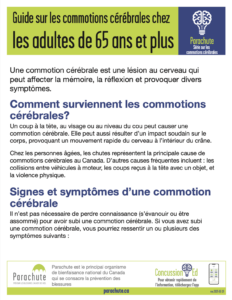
Il existe des considérations uniques pour la reconnaissance et la gestion des commotions cérébrales chez les adultes de 65 ans et plus. Cette ressource fournit des renseignements aux adultes de 65 ans et plus sur ce qu’il faut faire en cas de commotion cérébrale, ainsi que des conseils pour gérer et récupérer d’une commotion cérébrale et reprendre ses activités régulières.
403,00 KB PDF/UA
-
Concussion Guide for Adults 65+ (2025)
-
Concussion Guide for Adults 65+
-
Guide sur les commotions cérébrales chez les adultes de 65 ans et plus
-
Posters éducatifs sur l’empoisonnement aux opioïdes
La Croix-Rouge canadienne propose des affiches sur les signes d’un empoisonnement aux opioïdes et sur les soins à apporter à une personne victime d’un empoisonnement aux opioïdes.
-
Bud Talks: Cannabis and Older Adults
This resource for older adults outlines the risks associated with cannabis use, cannabis drug interactions as well as considerations around certain medical conditions and cannabis use.
-
Opioid Poisoning Educational Posters
From the Canadian Red Cross, posters are available on the signs of opioid poisoning and how to care for someone experiencing opioid poisoning
-
Creating Safe Environments: Indigenous Programs Virtual Learning (2024)
This webinar series from the Canadian Red Cross National Indigenous Programs Team details learnings, resources and tools regarding opioid harm reduction
-
Réduction des méfaits associés aux opioïdes
La formation de la Croix-Rouge canadienne sur la réduction des méfaits associés aux opioïdes vise à réduire le nombre de décès liés à un empoisonnement aux opioïdes et employons divers moyens pour y arriver : faire tomber les préjugés, encourager les comportements à adopter et faciliter l’accès à la formation sur l’administration de la naloxone.
-
Support Opioid Harm Reduction
Canadian Red Cross Opioid Harm Reduction training aims to reduce opioid-related deaths by eliminating stigma, promoting helpful behaviors, and training on how to administer naloxone.
-
Diet and nutrition
The Canadian Nutrition Society provides information about protein and protein foods for older adults.
-
Alimentation et nutrition
La Société canadienne de nutrition fournit des renseignements sur les protéines et les aliments protéinés pour les personnes âgées.
-
Mindfulness and mental health
Brain Injury Canada provides information about mindfulness for people with brain injuries, and ways to practise it.
-
Pleine conscience et santé mentale
Lésion Cérébrale Canada offre des informations sur la pleine conscience pour les personnes ayant subi une lésion cérébrale, ainsi que des méthodes pour la pratiquer.
-
Conserving energy after a concussion
-
Préserver son énergie après une commotion cérébrale
(en anglais seulement)
-
Sleep Diary
A sleep diary lets you track your sleep habits and patterns. Sharing this information with your healthcare professional can help address sleep problems.
-
Journal de sommeil
Un journal de sommeil vous permet de suivre vos habitudes et vos cycles de sommeil. Partager ces informations avec votre professionnel de la santé peut aider à identifier et à traiter les problèmes de sommeil.
-
Appointment Tracker
This chart can be used to record the information for your appointments.
-
Canadian Red Cross Friendly Calls Program
The Friendly Calls program matches people over the age of 18 with trained Red Cross personnel who connect with them regularly to check in, provide emotional support, encourage healthy coping strategies, and suggest wellbeing resources and community connections to other existing services.
-
Programme d’appels amicaux de la Croix-Rouge canadienne
Le programme d’appels amicaux jumelle des personnes de 18 ans et plus avec des membres du personnel de la Croix-Rouge dûment formés qui communiqueront régulièrement avec elles pour prendre de leurs nouvelles, leur offrir du soutien émotionnel, favoriser l’adoption de stratégies d’adaptation saines, proposer des ressources en matière de bien-être et, au besoin, leur donner des références vers d’autres services au sein de leur communauté.
-
Canadian Association of Occupational Therapists (CAOT)
The CAOT has a “Find an OT” listing you can use to locate occupational therapy services in your area.
-
Association canadienne des ergothérapeutes (ACE)
L’ACE propose un répertoire « Trouver un ergothérapeute » pour vous aider à localiser des services d’ergothérapie dans votre région.
-
Local brain injury associations
Provincial and local brain injury associations across Canada provide support, information, education, advocacy, and a variety of programs and services to those affected by brain injury.
-
Associations des lésions cérébrales
Des associations provinciales et locales de lésions cérébrales partout au Canada offrent du soutien, de l’information, de l’éducation, de la défense des droits ainsi qu’une variété de programmes et de services aux personnes touchées par une lésion au cerveau.
-
Brain Injury Canada
Brain Injury Canada provides resources and supports for people in Canada living with the effects of brain injury, their families and caregivers, and advocate for needs and services.
-
Lésion Cérébrale Canada
Lésion Cérébrale Canada offre des ressources et du soutien aux personnes touchées par une lésion au cerveau, ainsi qu’à leurs familles et à leurs soignants, et défend les besoins et les services.
-
Images pour les médias sociaux – Semaine de prévention des empoisonnements 2026
-
Fiche d’information – Semaine de prévention des empoisonnements 2025
-
Social media images — Poison Prevention Week 2026
-
Backgrounder – Poison Prevention Week 2025
-
Introduction to Injury Prevention e-learning course (2025)
-
Association pour la recuperation de produits santé : Rapporter des medicaments
Trouver un point de collecte près de chez vous où vous pouvez déposer les medicaments périmés et inutilisés et les objets piquants.
-
Health Products Stewardship Association: Returning medications
Find a collection location near you where you can drop off expired and unwanted medications and used medical sharps.
-
Injury Prevention Centre: Giving medication safely
This resource from the Injury Prevention Centre provides guidance for parents and caregivers on how to safely administer medication to children.
-
Injury Prevention Centre: Tableau Canadien D’Information Sur Les Médicaments Vendus Sans Ordonnance
Cette resource du Injury Prevention Centre explique le tableau canadien d’information sur les medicaments, que l’on trouve sur les medicaments en vente libre au Canada.
-
Injury Prevention Centre: Canadian Drug Facts table for non-prescription medication from IPC
This resource from the Injury Prevention Centre explains the Canadian Drug Facts Table, found on non-prescription medications in Canada.
-
Creating a common language for injury prevention
-
Créer un langage commun pour la prévention des blessures
-
Anne Stewart
-
Anne Stewart
-
Training
Parachute and our partners offer injury-training programs in areas such as concussion recognition and management, fall prevention, road safety and child safety.
-
Parachute Youth Ambassadors
-
Three crossing guards from across the country named Canada’s favourites for 2024
-
Trois brigadiers et brigadières gagnent le cœur du Canada en 2024
-
Prendre en compte l’équité, la diversité et l’inclusion dans les programmes et les politiques de prévention des blessures (2023)
L’abrégé du savoir de Loop a pour objet d’aider les intervenants à intégrer des stratégies fondées sur l’équité, la diversité et l’inclusion dans les processus d’élaboration des programmes et des politiques de prévention des blessures.
-
Infographie : Prévention des chutes d’enfants à la maison
Cette infographie présente des statistiques de l’Atlantique sur les chutes chez les enfants et des conseils pour éviter les chutes graves à la maison.
-
Loop Junior webinars
Loop Junior Fall Prevention Community of Practice provides webinars on topics related to childhood fall prevention. These webinars are recorded and uploaded to Loop’s YouTube channel.
-
Interventions environnementales pour la prévention des chutes chez les personnes âgées vivant dans la communauté
Cette étude évalue les effets (bénéfices et risques) des interventions environnementales (telles que la réduction des risques de chute, la technologie d’assistance, les modifications du domicile et l’éducation) pour prévenir les chutes chez les personnes âgées vivant dans la communauté.
-
Dashboard of reports received about consumer products and cosmetics
Health Canada’s Consumer Product Safety Program regularly receives reports of health and safety and other concerns about consumer products and cosmetics. This dashboard summarizes those reports.
-
Tableau de bord des rapports reçus concernant des produits de consommation et des cosmétiques
Le Programme de la sécurité des produits de consommation de Santé Canada reçoit régulièrement des rapports sur la sécurité et la santé ainsi que d’autres préoccupations en lien avec les produits de consommation et les cosmétiques. Ce tableau de bord résume ces rapports.
-
Canadian Substance Use Costs and Harms Data Visualization Tool
Explore the data about the costs and harms related to substance use in Canada from 2007 to 2020. Developed by Canadian Centre on Substance Use and Addiction (CCSA) and the University of Victoria’s Canadian Institute for Substance Use Research (CISUR).
-
Coûts et méfaits de l’usage de substances au Canada – Outil de visualisation des données
Consultez les données sur les coûts et méfaits de l’usage de substances au Canada de 2007 à 2020. Piloté par le Centre canadien sur les dépendances et l’usage de substances (CCDUS) et l’Institut canadien de recherche sur l’usage de substances (ICRUS) de l’Université de Victoria.
-
Trop en forme pour se fracturer
Trop en forme pour se fracturer sont des recommandations fondées sur des preuves pour aider à réduire le risque de fractures
-
Groupe de travail canadien sur la malnutrition
Le Groupe de travail canadien sur la malnutrition a pour objectif de réduire la malnutrition dans tous les secteurs de soins de santé en favorisant la recherche et l’acquisition de connaissances, en communiquant des données scientifiques, en collaborant avec les acteurs du milieu et en préconisant des pratiques axées sur l’alimentation et les soins nutritionnels. L’un des effets cachés de la malnutrition est un risque accru de chutes.
-
Prévention des chutes chez les personnes atteintes de la maladie de Parkinson
Cette ressource de Parkinson Canada vous aidera à déceler certaines causes de chutes et vous fera des suggestions simples et pratiques pour rester actif, autonome et debout.
-
Faut y voir : prévenir les chutes liées à la vision chez les aînés
Cette infographie de l’Association canadienne des optométristes décrit comment les changements dans vos yeux à mesure que vous vieillissez peuvent augmenter le risque de chutes et les stratégies de prévention.
-
Proche aidance Québec
Fondé en 2000, Proche aidance Québec regroupe 124 organismes communautaires qui soutiennent plus de 41 000 personnes proches aidantes partout au Québec. Ces organismes ont pour mission d’améliorer les conditions de vie des proches aidants et offrent, entre autres, du service conseil, du soutien psychosocial et du répit.
-
Rate my Treads (Évaluation de la résistance au glissement des bottes d’hivers)
Rate my Treads est un site Web qui évalue les différents types de chaussures d’hiver en fonction de leur résistance au glissement dans différentes conditions hivernales.
Rate my Treads est un produit d’iDAPT, la branche de recherche de l’institut de réhabilitation de Toronto, un hôpital dans le Réseau universitaire de santé à Toronto. iDAPT travaille avec un large éventail de cliniciens, d’ingénieurs, de scientifiques, de chercheurs, d’étudiants et autres afin de trouver des solutions pratiques aux problèmes communs.
-
Vision
This webpage from the Government of British Columbia offers questions to ask yourself and suggested actions to take to assess and reduce your risk of vision-related falling risks.
-
Ariane Brewer – Participez à l’initiative « Image pour le changement » CYRSW 2024
-
Matt Gupta for Canadian Youth Road Safety Week 2024
-
Our future roads: the power of youth in creating safe mobility
This is a recording of a keynote address and panel held at Toronto Metropolitan University (TMU) on Oct. 23, 2024. TMU Professor Linda Rothman introduced the event, followed by a keynote speech from Guy Cormier, President and CEO of Desjardins. Brandon Mahoney, a member of the Canadian Youth Road Safety Council, moderated a panel of three experts: TMU Professor Raktim Mitra; Parachute President and CEO Pamela Fuselli; and Desjardins Insurance VP Valérie Lavoie.
-
Finding Balance Alberta (en français)
-
Avancez de pied ferme du Nord-Est de l’Ontario
Avancez de pied ferme est une stratégie de prévention des chutes utilisée dans les communautés du nord-est de l’Ontario pour aider les personnes âgées à rester actives, indépendantes et debout. Ce programme offre une variété de ressources de prévention des chutes, des cours d’exercices gratuits et des opportunités de réseautage et de formation.
-
Atelier de vie saine et active (Vieillir Activement Canada)
Les ressources pour des Ateliers de vie saine et active comprennent :
Votre passeport personnel vers une vie saine
Trousse d’outils pour des ateliers de vie saine et active pour les aînés
Guide pour les animateurs communautaires
Jeux de diapositives de formation sur la présentation en ligne d’ateliers (en anglais seulement)
Affiches sur les Directives en matière de mouvement sur 24 h -
Utilisation des medicaments chez les personnes âgées (2017)
Mise à jour de la politique de l’Association médicale canadienne 2017.
-
Clinical Practice Guideline for Management of Osteoporosis and Fracture Prevention (2023)
This guideline developed by Osteoporosis Canada provides recommendations on the diagnosis and management of osteoporosis. The guideline has 25 key recommendations and 10 good practice statements with emphasis on the areas of exercise, nutrition, fracture risk assessment, treatment and interventions.
-
Interventions for preventing falls in older people in care facilities and hospitals
This review assesses the effects of interventions designed to reduce the incidence of falls in older people in care facilities and hospitals.
-
Environmental interventions for preventing falls in older people living in the community
This review assesses the effects (benefits and harms) of environmental interventions (such as fall‐hazard reduction, assistive technology, home modifications, and education) for preventing falls in older people living in the community.
-
Le coût des blessures en Ontario
Ce rapport de Santé publique Ontario fournit des informations sur le nombre et le coût des blessures en Ontario pour 2019.
-
The Cost of Injury in Ontario
This report from Public Health Ontario provides information on the number and cost of injuries in Ontario for 2019.
-
Réduire la vitesse excessive – SCJSR 2024
-
Réduire les émissions – SCJSR 2024
-
Voies cyclables séparées – SCJSR 2024
-
Conduite avec facultés affaiblies – SCJSR 2024
-
Reducing emissions – CYRSW 2025
-
Reducing speed – CYRSW 2025
-
Impaired driving – CYRSW 2025
-
Separated bike lanes – CYRSW 2025
-
New name, new focus, for Canadian Youth Road Safety Week – October 20 to 26, 2024
-
Nouveau nom, nouvel objectif, pour la Semaine canadienne des jeunes pour la sécurité routière – Du 20 au 26 octobre 2024
-
Guide des médias sociaux
-
Social media guide
-
Messages clés – Semaine canadienne des jeunes pour la sécurité routière 2024
-
Key Messages – Canadian Youth Road Safety Week 2024
-
Does your local crossing guard go beyond the call of duty? Nominate them today to be Canada’s Favourite Crossing Guard!
-
Est-ce que votre brigadier local brille au-delà des responsabilités de son poste? Sélectionnez-le dès aujourd’hui pour recevoir le prix de Brigadier favori du Canada!
-
Règlement officiel – Le Brigadier Favori du Canada
-
Canada’s Road Safety Strategy 2025
Road Safety Strategy 2025 is Canada’s fourth national road safety strategy that provides a flexible approach to allow for jurisdictions to implement road safety programs that meet their own needs. A new strategy is currently in development and will be shared when it is available.
-
Vision Zero and the Safe System Approach: A Primer for Canada
Developed by the Transportation Association of Canada (TAC), the objectives of this primer are to establish clear definitions and principles for Vision Zero and the Safe System Approach, to promote greater understanding of these concepts, and to support the development, identification and sharing of Canadian best practices.
-
Ontario Traffic Council Vision Zero Guide
The Guide offers in-depth background information on the fundamentals of Vision Zero, the Safe System Approach, and Traffic Safety Culture, and leads municipalities through the steps required to develop, integrate, and implement their own Vision Zero programs.
-
Clique pour changer Mis à jour
Dans l’initiative Clique pour changer, partagez vos idées pour améliorer la sécurité routière dans votre communauté et recevez une carte-cadeau de 100 $.
-
Snap for Change Mis à jour
Parachute wants to hear from you about how our roads can be safer for everyone. In the Snap for Change initiative, share your ideas for improving road safety in your community to receive a $100 gift card!
-
Thank you for your submission
-
Le Programme canadien des jeunes pour la sécurité routière
-
Youth Road Safety
-
2023 Annual Report
-
2023 Annual Report
-
Bigger, heavier, higher … large SUVs and pickups pose serious safety threats to vulnerable road users
-
Plus gros, plus lourds, plus hauts… les grands VUS et les camionnettes constituent une menace sérieuse pour la sécurité des usagers vulnérables de la route.
-
Étude de cas : L’atelier pédestre d’Ottawa
-
Case study: the Ottawa Walkshop
-
The story of Leslie Bangamba’s daughter: The life-threatening dangers of swallowing a button battery
Health Canada produced this video in 2024 to educate Canadians about the dangers of ingesting button batteries.
-
L’histoire de la fille de Leslie Bangamba : Avaler une pile bouton peut mettre la vie en danger
-
La Loi Rowan : Information pour les prestataires de soins de santé
Sur cette page du site Web du gouvernement de l’Ontario, apprenez-en plus sur certaines dispositions de la Loi Rowan de 2018 sur la sécurité en matière de commotions cérébrales, qui est entrée en vigueur le 1er janvier 2022.
-
Document de principes de la SCP : Les commotions cérébrales liées au sport et les mises en échec chez les enfants et les adolescents : l’évaluation, la prise en charge et les répercussions sur les politiques
Ce document de la Société canadienne de pédiatrie résume et fait ressortir les données probantes récentes et les pratiques exemplaires à jour pour prendre les commotions cérébrales en charge chez les enfants et les adolescents. Le document revient également sur la relation entre les mises en échec au hockey et le taux de blessures.
-
Questionnaire Rivermead sur les symptômes du syndrome post-commotionnel
Ce questionnaire permet aux individus d’évaluer la gravité de leurs symptômes par rapport à avant l’incident de commotion cérébrale.
-
Rowan’s Law: Information for health care providers
On this page of Government of Ontario website, learn about certain provisions under Rowan’s Law (Concussion Safety), 2018, that came into effect on January 1, 2022.
-
Concussion in para sport: the first position statement of the Concussion in Para Sport (CIPS) Group
This statement from the Concussion in Para Sport Group offers considerations for assessment, treatment and return to play after concussion in the para athlete.
-
CPS Position Statement: Sport-related concussion and bodychecking in children and youth: Evaluation, management, and policy implications
This statement from the Canadian Paediatric Society summarizes and highlights recent evidence and current best practice guidelines for managing concussion in children and youth, and re-examines the relationship between bodychecking in hockey and injury rates.
-
Christina Rodrigues
-
Bill Pratt
-
Lirim Hajrullahu
-
Eileen Patterson
-
Eileen Patterson
-
Christina Rodrigues
-
Lirim Hajrullahu
-
Bill Pratt
-
Supersized vehicles, supersized safety risk (2024)
Large SUVs and pick-up trucks pose a safety threat to all road users. The collisions where a light truck is involved is both more likely to occur, and to cause fatal or serious injury to the involved vulnerable road user. Join panelists from Transport Canada, the Insurance Institute for Highway Safety (IIHS), Équiterre, Piétons Québec and the Coalition to Reduce Auto Size Hazards (CRASH) to learn more about the evidence and discuss how to mobilize and promote use of safer vehicles within Vision Zero.
PANEL:
Samuel Monfort is a Senior Statistician at the Insurance Institute for Highway Safety (IIHS) with a PhD in Human Factors Psychology. His research interests include vulnerable road users, crash compatibility, and the use and misuse of automation.
Dominique Charlebois works at Transport Canada as a Senior Project Manager, Engineering.
Albert Koehl is an Environment Lawyer and Coordinator of CRASH, a Toronto cycling and pedestrian advocate and author of editorials and other publications.
Anne-Catherine Pilon, Sustainable Mobility Analyst at Équiterre advocates for cities and vehicles that are at a human scale and for competitive alternatives to solo cars, through public transit funding.
Francis Garnier is a Public Affairs Analyst at Piétons Québec advocating for pedestrian road safety and transit funding in Québec based in Montréal.
-
Canadian Guideline on Concussion in Sport, 2nd edition webinar (2024)
The Canadian Guideline on Concussion in Sport, 2nd edition was published in March 2024 with updated recommendations for the prevention, recognition and management of concussions. This webinar will provide an overview of key changes to recommendations and highlight resources available from Parachute and its partners for concussion policy and protocol development, training and education/awareness.
Presenter: Stephanie Cowle, Director, Knowledge Translation, Parachute
-
Région de York, ON
-
Plan de sécurité des voyageurs Vision Zéro 2024-2028 de la région de York
-
Philippe Brodeur-Ouimet
-
Philippe Brodeur-Ouimet
-
Asma Chohan
-
What’s in a name? Plenty!
-
Qu’est-ce que contient un nom? Beaucoup de choses!
-
York Region Vision Zero Traveller Safety Plan 2024-2028
-
York Region, ON
-
Conférence canadienne sur la prévention des chutes
Co-hosts Parachute and KITE/UHN are pleased to invite you to join colleagues from across Canada to the first in person Canadian Fall Prevention Conference in six years.
-
Canadian Fall Prevention Conference
In April 2025, Parachute and KITE/UHN cohosted the first in-person Canadian Fall Prevention Conference in six years.
-
Pourquoi Hugo Houle soutient Parachute
Hugo Houle, cycliste professionnel québécois, est l’ambassadeur de Parachute pour nos campagnes de sécurité routière Vision Zéro et explique pourquoi il soutient notre travail au Canada.
-
Pourquoi Hugo Houle soutient Vision Zéro
Hugo Houle, cycliste professionnel québécois, raconte l’histoire de son frère Pierrik, tué par un automobiliste. Hugo soutient les initiatives de Vision Zéro pour mettre fin aux décès sur nos routes.
-
Why Hugo Houle supports Parachute
Hugo Houle, a professional cyclist from Québec, is Parachute’s ambassador for our Vision Zero road safety campaigns and shares why he supports our work in Canada.
-
Why Hugo Houle supports Vision Zero
Hugo Houle, a professional cyclist from Québec, is Parachute’s ambassador for our Vision Zero road safety campaigns and shares why he supports our work in Canada.
-
Fiche d’information – Semaine Sécuri
Jeunes 2024 -
Guide sur les médias sociaux – La Semaine Sécuri
Jeunes de Parachute 2025 -
Images des médias sociaux de la Semaine Sécuri
Jeunes 2024 -
Safe Kids Week 2024 – Backgrounder
-
Safe Kids Week 2024 – Social media images
-
Health Canada Consumer Products and Cosmetics
This site has Information on incident reporting, recalls and alerts, cosmetic information, product safety education and consumer product requirements.
-
Canadian Product Safety Pledge
In 2023, Health Canada signed a Canadian product safety pledge for consumer products and cosmetics with Amazon and eBay. Online marketplaces are making a commitment to take 14 preventative and corrective actions. These actions will help strengthen the safety of consumer products and cosmetics purchased through their online marketplaces.
-
L’engagement canadien en matière de sécurité des produits
Renseignez-vous sur l’engagement canadien en matière de sécurité des produits. Les places de marché en ligne signent l’engagement pour renforcer la sécurité des produits de consommation et des cosmétiques vendus en ligne.
-
Reducing cannabis and chemical exposure risks in Canada: Strategies and resources for public safety (2024)
Unintended exposures to cannabis and to chemicals and pollutants in and around the home pose risks to public health and safety in Canada. Hosted by Sarah Macdonald from Parachute, this webinar will highlight two Health Canada initiatives targeting risk management and reduction in these areas.
First, presenter Sieara Plebon-Huff, Scientific Evaluator in Health Canada’s Office of Cannabis Science and Surveillance – Pharmacovigilance Division, will introduce participants to Health Canada’s Vigilance Framework for Cannabis. Participants will hear about data findings, key issues (e.g., pediatric cannabis exposures), and activities and resources developed by the program to help track and mitigate these exposures.
Second, presenters Odette Bose and Heloise Tachaeur from Health Canada’s Environmental Health Program will share outreach activities conducted under the Chemicals Management Plan aimed at helping people reduce environmental risks posed by chemicals and pollutants in and around the home. Participants will learn about the resources and tools used by Risk Communication and Public Involvement Officers to support public outreach and engagement for poison prevention awareness and chemical exposure reduction.
Presenters:
Sieara Plebon-Huff
Scientific Evaluator, Controlled Substances and Cannabis Branch, Health CanadaOdette Bose
Risk Communication and Public Involvement Officer in Alberta and North region, Regulatory, Operations and Enforcement Branch, Health CanadaHeloise Tachaeur
Risk Communication and Public Involvement Officer in Ontario, Regulatory, Operations and Enforcement Branch, Health Canada -
Drug checking: Harm reduction practices for unregulated drug use at Canadian music festivals (2024)
Each year, British Columbia is home to two of the largest electronic music festivals in Canada. At these events, drug use is an integral part of the culture and most attendees interact with drugs in one way or another. The death of at least five young adults in 2014 at music festivals in Canada, where drug use was likely a contributing factor, spurred a national effort to establish evidence-based harm reduction strategies for drug use at music festivals. Drug checking, a non-judgemental and nuanced chemical analysis of substances that allows people to know what is in their substances and potentially take action to reduce the risk of any related harms, emerged out of this work. In addition to potentially helping prevent substance-related toxicity, the analysis of drug checking data contributes to understanding of the types and contents of substances used in music festival settings.
Hosted by Sarah Macdonald from Parachute, this webinar will provide insight into the development of evidence-based harm reduction strategies at music festivals and share learnings from the implementation of drug checking, in particular. The webinar will include presentations from Antoine Marcheterre, Drug Checking Lead, Interior Health and Jarred Aasen, Pharmacist, Founder of Lantern Services and Co-Founder/Co-Author of the Drug Resource and Education (DRED) Project. A Q&A session will follow their presentations. With a focus on drug use prevalence and poison prevention at music festivals, the presentations will emphasize a philosophy of taking up non-prohibitive methods to keep people safe.
Presenters:
Antoine Marcheterre, Drug Checking Lead, Interior Health
Jarred Aasen, Licenced Pharmacist, Founder of Lantern Services, Co-Founder/Co-Author of the Drug Resource and Education (DRED) Project -
Canadian Guideline on Concussion in Sport, 2nd edition
-
Lignes directrice canadiennes sur les commotions cérébrales dans le sport, 2e édition
-
Ondes cérébrales – présentation
-
L’atelier pédestre de Vision Zéro
-
Étude de cas : L’atelier pédestre de Guelph
-
St. John’s, NL
-
Mississauga, ON
-
Fiche d’information – Semaine de prévention des empoisonnements 2024
-
Backgrounder — Poison Prevention Week 2024
-
Intoxications pédiatriques au cannabis – Images pour les réseaux sociaux (CCDUS)
-
Pediatric cannabis poisoning social media images (CCSA)
-
Social media images — Poison Prevention Week 2024
-
Ville de Windsor, Plan d’action Vision Zéro
-
Stratégie de sécurité routière Vision Zéro de Kamloops
-
Plan d’action pour la sécurité routière 2023-2028 — Québec
-
Mise à jour du Plan Stratégique de Transport de Coquitlam
-
Coquitlam adopte le plan ‘Vision Zéro’ pour sécuriser ses routes
-
City of Windsor, Vision Zero Action Plan
-
Vision Zero Kamloops Road Safety Strategy
-
Quebec
-
Québec
-
Road Safety Action Plan 2023-2028 — Quebec
-
Coquitlam Stategic Transportation Plan Update
-
Coquitlam adopts ‘Vision Zero’ to make its roads safer
-
Rapport annuel pancanadien 2021 des centres antipoison
Ce rapport, produit par L’Association canadienne des centres antipoison et de toxicologie clinique (ACCAP), Santé Canada et Parachute, présente les données les plus récentes (2021) des cinq centres antipoison du Canada. Le rapport donne un aperçu du nombre de cas gérés par les centres antipoison au Canada et de leur nature, et souligne le rôle de ces centres dans les efforts de prévention des empoisonnements.
-
Pan-Canadian Poison Centres 2021 Annual Report
This report, produced by the Canadian Association of Poison Centres and Clinical Toxicologists, Health Canada and Parachute, presents the most current data (2021) from all five of Canada’s poison centres. The report provides an overview of the number and nature of cases managed by posion centres across Canada and highlights the role of these centres in poison prevention efforts.
-
Affichage d’un poste d’administrateur auconseil d’administration
-
Coûts et méfaits de l’usage de substances au Canada 2007-2020
Publié par le Centre canadien sur les dépendances et l’usage de substances et l’Institut canadien de recherche sur l’usage de substances de l’Université de Victoria, ce rapport résume les coûts et méfaits de l’usage de substances au Canada de 2007 à 2020, selon les plus récentes données disponibles. Porte notamment sur les coûts associés à plusieurs substances, dont l’alcool, le tabac, les opioïdes et le cannabis, qui sont répartis en quatre catégories, soit soins de santé, perte de productivité, justice pénale et autres coûts directs.
-
Écart entre milieu rural et milieu urbain : différences dans les caractéristiques des blessures
Cette étude compare la nature et la gravité des blessures en milieu urbain et rural à l’aide des données de 2011 à 2017 de la base électronique du Système canadien hospitalier d’information et de recherche en prévention des traumatismes (eSCHIRPT).
-
Burnaby, BC
-
Relier Burnaby : Plan de transport de Burnaby
-
Transportation Master Plan Update – Leduc, AB
-
City of Saint John Road Safety Strategy
-
Saint John, NB
-
Regina, SK
-
Points forts du projet de budget 2022 — Regina
-
Région de Niagara, ON
-
Chronologie — Région de Niagara
-
Coquitlam, BC
-
Plan de sécurité routière des services de protection 2023 à 2026 — Fort Saskatchewan
-
Chronologie de la Vision Zéro à Edmonton
-
Plan d’action stratégique pour la sécurité routière — Durham
-
Stratégie d’engagement et plan de communication du processus de planification du plan d’action pour la sécurité routière — Saanich, BC
-
Rapport FINAL du processus de planification du plan d’action pour la sécurité routière au Conseil — Saanich, BC
-
Saanich, BC
-
Stratégie Vision zéro de la ville de Kitchener 2022-2025 (Anglais seulement)
-
Kitchener, ON
-
Guelph, ON
-
Sécurité routière : Plan directeur des transports de la ville de Guelph (anglais seulement)
-
Connecting Burnaby: Burnaby’s Transportation Plan
-
Burnaby, BC
-
Parachute’s Strategic Plan 2024-2028 – Framework
-
Parachute’s Strategic Plan 2024-2028
-
Three crossing guards from Ontario and Québec named Canada’s favourites for 2023
-
Trois brigadières de l’Ontario et du Québec nommées Brigadiers favoris du Canada 2023
-
Politique de prévention des empoisonnements
-
Politique
Parachute plaide pour des politiques visant à réduire blessures graves et décès pour : sièges d’appoint, monoxyde de carbone, commotions cérébrales, casques de vélo, vitesse de conduite, véhicules hors route, poison et clôture de piscine.
-
Réduction de la vitesse de conduite
-
Législation sur les clôtures de piscine
-
Ressources pour les intervenants
-
Législation sur les détecteurs de monoxyde de carbone
-
Collection : prévention des empoisonnements
Trouver des données, déclarations, formations, lignes directrices et ressources pour la sensibilisation du public, de l’information sur les politiques publiques, la déclaration d’incidents, les centres antipoison et autres organisations.
-
Case study: the Guelph Walkshop
-
Vision Zero Walkshop
A walkshop is a mobile workshop on a pre-determined walking route in an urban area that allows attendees to visit, learn about and reflect on local Vision Zero and transportation projects.
-
Carbon monoxide poisoning: Trends and responses in Canada (2023)
Carbon monoxide (CO), often called “the silent killer”, is a leading cause of unintentional poisoning deaths in Canada and North America. Hosted by Stephanie Cowle from Parachute, this webinar will explore CO poisoning trends and responses from multiple perspectives, including poison centre responses to emergency weather events, a case study examining CO health literacy among homeowners and gaps relating to CO legislation in Canada. The speakers will cover key messages for preventing future occurrences, as well as opportunities for collaboration and action. A Q&A sessison will follow the presentations.
-
Conçu pour la vitesse – Vision Zéro 2023
-
Sécurité pour tous – Vision Zéro 2023
-
Les humains font des erreurs – Vision Zéro 2023
-
Accidents de la route – Vision Zéro 2023
-
Construit pour guider – Vision Zéro 2023
-
Road crashes – Vision Zero 2023
-
People make mistakes – Vision Zero 2023
-
Safety for all – Vision Zero 2023
-
Built to guide – Vision Zero 2023
-
Built for speed – Vision Zero 2023
-
Promoting physical activity for older people: a toolkit for action (2023)
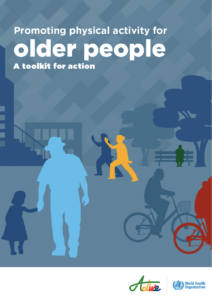
This World Health Organization toolkit provides evidence-based guidance on the key approaches to promote and enable older people to be physically active, regardless of who they are, where they live, or their intrinsic capacities (for example their visual or cognitive abilities) or whether they live with chronic conditions (for example, diabetes, hypertension, and arthritis).
-
Motoneige
-
Luge et traîneau
-
Ski et planche à neige Mis à jour
-
Patinage sur glace Mis à jour
-
Hockey sur glace Mis à jour
-
Sports et loisirs d’hiver
Apprenez comment profiter de l’hiver en pratiquant en toute sécurité le hockey sur glace, le patinage sur glace, le ski et la planche à neige, la luge, la traîne sauvage et la motoneige.
-
Sécurité en hiver à l’extérieur
Renseignez-vous sur les conditions météorologiques sécuritaires pour les enfants, sur la façon de prévenir les engelures et pour savoir si la glace est sécuritaire.
-
Vacances d’hiver
Conseils de sécurité auxquels penser pour les vacances d’hiver lorsque nous ajoutons des bougies, des sapins, des plantes potentiellement dangereuses, des cheminées, des lumières de Noël et des divertissements dans nos vies.
-
Sécurité en vacances
Vous partez en vacances? Lisez nos conseils de sécurité pour vous rendre dans des destinations où il fait froid ou chaud, et pour voyager avec des enfants.
-
Natation
-
Soccer
-
Planches à roulettes
-
Patins à roues alignées
-
Équitation
-
Football américain
-
Plongée
-
Camping et randonnée
-
Navigation et voile
-
Baseball
-
Sports et loisirs d’été
Conseils de sécurité pour le baseball, la navigation et la voile, le camping et la randonnée pédestre, le cyclisme, la plongée, le football, l’équitation, le patin à roues alignées, la planche à roulettes, le soccer et la natation.
-
Étranglement et suffocation
Conseils de sécurité destinés aux parents visant à prévenir l’étranglement et la suffocation chez les enfants à la maison.
-
Sécurité routière
Prévenez les collisions de la route en réduisant votre vitesse de conduite, en adoptant des pratiques de conduite exemplaires et en gérant les distractions.
-
Sécurité ferroviaire
Apprenez comment rester en sécurité près des voies ferrées : consultez nos fiches-conseils pour les enfants, les adolescents et les parents.
-
Sécurité des produits
Renseignez-vous sur les produits de consommation et la sécurité des enfants au Canada, y compris en ce qui a trait à la réglementation sur les cordons de stores et de rideaux, le bisphénol A, le plomb et les pesticides.
-
Gaz radon Mis à jour
-
Monoxyde de carbone Mis à jour
- How to prevent carbon monoxide poisoning at home.
- Installation and maintenance of carbon monoxide alarms.
-
Cannabis Mis à jour
Safety tips to ensure children are not accidentally exposed to cannabis.
-
Empoisonnement
Faites de votre maison un endroit exempt de produits toxiques : apprenez comment prévenir l’empoisonnement au monoxyde de carbone et l’empoisonnement des enfants par les médicaments et le cannabis.
-
Jeux extérieurs non structurés et jeux risqués
Benefits to your child engaging in unstructured outdoor play and risky play.
-
Trampolines Mis à jour
-
Les aires de jeu construites Mis à jour
What to look out for in community and backyard playgrounds.
-
Terrains et aires de jeu Mis à jour
Caractéristiques de sécurité et dangers à surveiller sur les terrains de jeu, préoccupations en matière de sécurité concernant les trampolines et avantages des jeux extérieurs non structurés et du jeu risqué.
-
Sécurité des piétons Mis à jour
Ce que vous pouvez faire pour apprendre aux enfants à traverser la rue en toute sécurité et comment déterminer à quel moment ils peuvent traverser seuls la rue sans danger.
-
Sommeil sécuritaire
Safety considerations for cribs, bunkbeds and sleepwear.
-
Le jeu
Conseils de sécurité pour les jouets, les trotteurs et les centres d’activités fixes
-
Sécurité électrique
Conseils de sécurité électrique pour les parents.
-
À la maison
How to keep your child safe from hazards around the house, such as fireplaces and televisions.
-
Sécurité à domicile
Conseils de sécurité clés pour les parents sur la façon d’assurer la sécurité des enfants à la maison concernant l’électricité, le moment du coucher et les périodes de jeu.
-
Casques pour les sports d’hiver
-
Casques
Renseignez-vous sur l’ajustement et le remplacement appropriés des casques, sur le type de casques pouvant être utilisés en toute sécurité et sur les casques à utiliser pour les différentes activités.
-
Sécurité à l’Halloween
Conseils de sécurité à l’intention des parents, des gardiens et des conducteurs pour faire de l’Halloween une soirée sans danger pour tous.
-
Chutes chez les aînés
Stratégies et ressources clés pour aider les personnes âgées à prévenir les chutes et importance de la prévention des chutes avec une population vieillissante au Canada.
-
Chutes chez les enfants
La plupart des blessures liées aux chutes chez les enfants de moins de cinq ans surviennent à la maison. Voici comment protéger vos enfants contre les chutes à la maison.
-
Parcs de jeux et aménagements aquatiques
How to help prevent drowning and other injuries from occurring on splash pads, wading pools, ponds, fountains and other water features.
-
Gilet de sauvetage ou vêtements de flottaison individuels (VFI)
Key safety information about picking and using lifejackets for you and your child.
-
Baignoires
Restez toujours à portée de vue et à proximité de votre enfant lorsqu’il est dans l’eau ou à proximité de l’eau, incluant les baignoires, les lavabos et les toilettes.
-
Piscines résidentielles
Reduce the risk of your child drowning in a backyard pool though pool fencing and safety equipment.
-
Noyade
Conseils de prévention de la noyade à l’intention des parents visant à assurer la sécurité des enfants dans les baignoires, les piscines de jardin, les parcs aquatiques et les plans d’eau.
-
Sièges d’enfant ou remorques
-
Cyclisme
Le vélo est un moyen sain de se déplacer et les risques de blessure diminuent quand les routes sont conçues pour protéger les cyclistes. Lisez les conseils de sécurité et les meilleures pratiques pour le cyclisme à tout âge.
-
Commotion cérébrale
-
Étouffement
Renseignez-vous sur les risques courants d’étouffement chez les enfants et consultez nos conseils pour prévenir les risques d’étouffement.
-
Sièges d’auto d’occasion/usagés
-
Choisir le bon siège d’auto
-
Sécurité des enfants en voiture
-
Sièges d’auto
Comment assurer la sécurité de votre enfant lorsqu’il voyage dans un véhicule automobile ou tout autre moyen de transport et conseils pour choisir un siège d’auto adapté.
-
Détecteurs de fumée Mis à jour
Comment installer et entretenir les détecteurs de fumée, et les types de modèles que vous pouvez utiliser.
-
Eau chaude du robinet
- Comment vérifier et abaisser la température de l’eau du robinet dans votre maison.
- Température de l’eau pour les problèmes de santé et de nettoyage.
-
Brûlures et échaudures
Conseils de sécurité pour prévenir les brûlures et les échaudures à la maison, y compris en ce qui concerne la réduction de la température de l’eau du robinet et l’installation de détecteurs de fumée.
-
Véhicules tout-terrain
Les VTT causent plus d’invalidités permanentes et de décès que la plupart des autres activités sportives ou récréatives. Voici nos conseils de sécurité pour l’utilisation des VTT.
-
Casques pour vélos, patins à roues alignées, trottinettes et planches à roulettes
-
Fall Prevention Month aims to safeguard Canadians from the leading cause of injury for children and older adults
-
Le mois de la prévention des chutes vise à protéger les Canadiens de la principale cause de blessures chez les enfants et les personnes âgées
-
Facteurs facilitant et entravant le dépistage et l’évaluation du risque de chutechez les aînés : un sommaire (2022)
Le présent document fait le survol des principaux facteurs entravant et facilitant le dépistage et l’évaluation du risque de chute à partir d’une synthèse des conclusions des recherches publiées dans la littérature et de sondages et d’entretiens réalisés auprès d’intervenants et de cliniciens
spécialisés dans la prévention des chutes au Canada.222,12 KB PDF/UA
-
Barriers and enablers for screening and assessing fall risk in older adults: an overview (2022)
Through a synthesis of the published literature as well as surveys and interviews conducted with Canadian fall prevention practitioners/ clinicians, the following report provides an overview of the key barriers to fall risk screening and assessment as well as the key enabling factors or facilitators promoting the implementation of screening/assessment.
226,19 KB PDF/UA
-
Recommandations canadiennes pour l’usage du cannabis à moindre risqué
Les Recommandations canadiennes pour l’usage du cannabis à moindre risque fournissent 10 recommandations fondées sur des données scientifiques afin de permettre aux gens de réduire les risques pour la santé associés à la consommation de cannabis.
-
Youth partnership – Youth engagement in road safety (NTDSW 2023)
Youth partnership requires long-term investment of resources to have representative youth involved in all parts of an initiative, including agenda setting, decision-making and evaluation. Organizations can tap into youths’ wealth of knowledge and expertise to create relevant programs while youths build their skills and capacity to do the work needed to improve road safety for themselves and their peers.
222,47 KB PDF/UA
-
Youth outreach – Youth engagement in road safety (NTDSW 2023)
Youth knowledge, attitude and behaviour are influenced by those in their networks due to their status, perceived power and trustworthiness. These groups can be an effective in delivering road safety messaging to youth and also lead by example. Groups likely to influence young people’s driving behaviour are peers, parents, schools and educators and experts.
188,81 KB PDF/UA
-
Youth communications – Youth engagement in road safety (NTDSW 2023)
Effectively communicating road safety messaging to youth through traditional, digital and social media is important to obtain buy-in from youth and potentially change behaviour. Organizations should strive to consistently ask youth about what kind of road safety content catches their eye, what they like and don’t like, and what kind of messaging is likely to resonate with them in the long term and change their road safety
attitudes, beliefs and behaviours.168,15 KB PDF/UA
-
Youth capacity-building – Youth engagement in road safety (NTDSW 2023)
Beliefs and risk perception have a significant impact on whether young people will engage in risky driving behaviour. There is a disconnect between what youth think safe driving is and what it actually is. Youth also have different attitudes and ideas of the perceived risk of different types of unsafe driving behaviour. There is a need to equip young people with strategies to prepare them for safe driving, prevent them from engaging in unsafe driving behaviour and help them safely avoid a collision to ultimately improve youth empowerment
and wellbeing.176,16 KB PDF/UA
-
Youth advocacy – Youth engagement in road safety (NTDSW 2023)
Youth advocacy can help rebuild the culture around driving behaviour to make being a responsible driver cool and attractive to youth. Involving youth in advocacy for measures that promote safer driving such as changes to road infrastructure, road rules and regulations, driver education and access to public transportation can get youth to start conversations both within their peer groups and demonstrate to others, including their peers, that this is an issue that matters to them.
180,77 KB PDF/UA
-
Conseils pour réussir un projet de sécurité routière (SNSJV 2023)
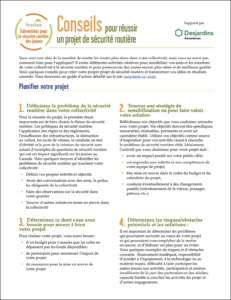
Vous avez une idée de la manière de rendre les routes plus sûres dans votre collectivité, mais vous ne savez pas comment faire pour l’appliquer? Il existe différentes activités créatives pour sensibiliser vos amis et les membres de votre collectivité à la sécurité routière et pour promouvoir des routes encore plus sûres et de meilleure qualité. Voici quelques conseils pour créer votre propre projet de sécurité routière et transformer vos idées en résultats concrets.
211,37 KB PDF/UA
-
Tips for a successful road safety project (NTDSW 2023)
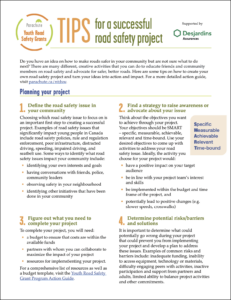
Do you have an idea on how to make roads safer in your community but are not sure what to do next? There are many different, creative activities that you can do to educate friends and community members on road safety and advocate for safer, better roads. Here are some tips on how to create your own road safety project and turn your ideas into action and impact.
212,15 KB PDF/UA
-
Mobilisation des jeunes pour la sécurité routière (SNSJV 2023)
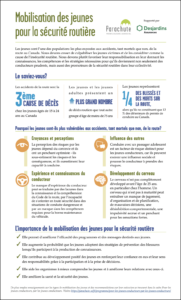
Les jeunes sont l’une des populations les plus exposées aux accidents, tant mortels que non, de la route au Canada. Nous devons cesser de culpabiliser les jeunes victimes et de les considérer comme la cause de l’insécurité routière. Nous devons plutôt favoriser leur responsabilisation en leur donnant les connaissances, les compétences et les stratégies nécessaires pour qu’ils deviennent non seulement des conducteurs prudents, mais aussi des promoteurs de la sécurité routière dans leur collectivité.
173,63 KB PDF/UA
-
Youth engagement in road safety – infographic (NTDSW 2023)
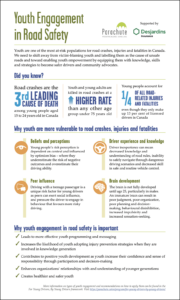
Youth are one of the most at-risk populations for road crashes, injuries and fatalities in Canada. We need to shift away from victim-blaming youth and labelling them as the cause of unsafe roads and toward enabling youth empowerment by equipping them with knowledge, skills and strategies to become safer drivers and community advocates.
121,42 KB PDF/UA
-
Les faits sur les chutes chez les enfants du Canada (infographie)
Cette infographie présente les statistiques canadiennes sur les chutes chez les enfants de 9 ans et moins. Les données de cette infographie ont été fournies par l’Agence de la santé publique du Canada.
-
The impact of falls on children in Canada (infographic)
This infographic highlights Canadian statistics on falls in children aged 0 to 9 years. Data for this infographic were supplied by the Public Health Agency of Canada.
-
Affiches: Demeurer, Améliorer, Éliminer
Ces affiches font la promotion du vieillissement en santé et de la prévention des chutes. Elles sont destinées aux aînés and sont conçues pour être affichées dans différents endroits (par exemple, hôpitaux, pharmacies, salles d’attente de cliniques, bâtiments communautaires, établissements de soins de longue durée et de retraite, etc.).
-
Move, Improve, Remove Posters
These posters promote healthy aging and fall prevention. They are aimed at older adults and designed to be posted in a variety of settings (e.g., hospitals, clinic waiting rooms, pharmacies, community buildings, long-term care and retirement facilities etc.).
-
Canadian Substance Use Costs and Harms 2007-2020
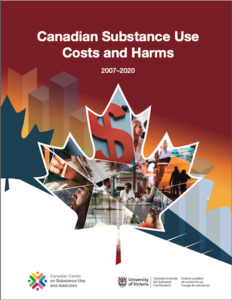
Developed by Canadian Centre on Substance Use and Addiction (CCSA) and the University of Victoria’s Canadian Institute for Substance Use Research (CISUR), this report summarizes key findings about the costs and harms of substance use in Canada from 2007 to 2020, based on the latest data available. It includes the costs associated with various substances, such as alcohol, tobacco, opioids and cannabis, which are broken down into four categories: lost productivity, healthcare, criminal justice and other direct costs.
-
The rural-urban gap: differences in injury characteristics (2019)
This study compares the nature and severity of injuries in urban and rural settings using electronic Canadian Hospitals Injury Reporting and Prevention Program (eCHIRPP) data from between 2011 and 2017.
-
Preventing injuries and violence: an overview (2022)
-
Centre for Aging SMART
The Centre for Aging SMART at Vancouver Coastal Health (VCH) is a University of British Columbia affiliated, internationally recognized research centre to accelerate discoveries and new knowledge to improve the lives of an aging population and individuals living with a disability.
-
Finding Balance British Columbia
Finding Balance British Columbia has a toolkit with posters, articles and screensavers as well as translated resources for older adults in Farsi, Cantonese and Punjabi. The site also has unique information including videos specific to vision, exercise, home safety, sidewalk safety, medications and long-term care.
-
Finding Balance New Brunswick
Finding Balance New Brunswick contains practice guidelines, tools, guides, and other resources in English and French.
-
Finding Balance Newfoundland and Labrador: Eastern Health Region
Finding Balance Newfoundland and Labrador has two websites for two of their health regions. This website is for their Eastern Health Region. Both websites provide information on the Finding Balance Campaign with posters available. Other resources link to Fall Prevention Month.
-
Together In Movement and Exercise (TIME)
TIME is a community-based program welcoming people with balance and mobility challenges to exercise. It focuses on functional mobility exercises, done mostly in standing, with hand supports available to assist with balance. The program is designed by physiotherapists at Toronto Rehab, and led by TIME-trained fitness instructors in community centres across the country.
-
Stay On Your Feet – Northeastern Ontario Region
The Stay on Your Feet strategy of Northeastern Ontario provides resources for older adults and healthcare providers focused on reducing falls and fall-related injuries and supporting older adults to stay active, social and strong
-
Preventing Falls in Long-Term Care
The Ontario Centres for Learning, Research and Innovation in Long Term Care (CLRI) at the Schlegel-UW Research Institute for Aging (RIA) offers self-paced orientation courses on fall prevention for clinical and non-clinical team members. Preventing Falls in Long-Term Care for Clinical Team Members teaches members in clinical roles about fall risk factors, falls risk assessments, interventions and strategies for falls prevention, and strategies for communicating about falls prevention with residents, essential care partners and other team members. Preventing Falls in Long-Term Care (Non-Clinical Team Members) teaches non-clinical team members about appropriate awareness and corresponding actions to take to effectively prevent falls and keep residents safe.
-
Technology for Injury Prevention in Seniors (TIPS) Fall Videos
Offered by Simon Fraser University, TIPS is a unique university-community partnership for developing new technologies to prevent falls and fall- related injuries in older adults. TIPS uses innovative approaches (such as video capture and wearable sensors) to determine the causes and circumstances of falls by older adults. TIPS also develops and tests the effectiveness of engineering interventions such as protective clothing and compliant flooring in reducing fall-related injuries. TIPS offers four fall prevention-specific modules on their YouTube channel: What causes falls?, Hip protectors, Protect your head and Clinical risk factors.
-
Out of Sight, Out of Mind: Addressing the Invisible and Older Faces of Canada’s Opioid Crisis (2023)
-
2023 National Teen Driver Safety Week focuses on empowering youth to improve road safety
-
L’édition 2023 de la Semaine nationale de la sécurité des jeunes au volant met l’accent sur la responsabilisation des jeunes pour améliorer la sécurité routière
-
Attitudes and perceptions of traffic safety enforcement among police officers in Ontario
-
Attitudes et perceptions des agents de police de l’Ontario à l’égard de l’application des règlements de la circulation
-
The crucial role of traffic enforcement in a safe systems approach to road safety
-
Le rôle crucial du contrôle de la circulation dans une approche de la sécurité routière fondée sur des systèmes sûrs
-
Engagement des jeunes envers les mesures de sécurité routière (SNSJV 2023)
Une forte mobilisation des jeunes mène à une meilleure santé et à une plus grande sécurité pour eux, étant donné qu’ils sont particulièrement exposés aux risques d’accidents et de mortalité sur nos routes. En étant sensibilisés à la sécurité routière, les jeunes peuvent perfectionner leurs compétences, comme le leadership et la prise de décisions et apprendre comment avoir
une incidence positive sur leur collectivité.411,17 KB PDF/UA
-
Pourquoi les jeunes sont-ils plus à risque d’accident de la route? (SNSJV 2023)
Les jeunes sont susceptibles d’adopter des comportements de conduite à risque qui
peuvent entraîner des amendes, la perte de leur permis de conduire, des blessures et
même la mort. Voici quelques raisons pour lesquelles les jeunes courent un plus grand
risque d’accident de la route.408,72 KB PDF/UA
-
Barriers and enablers for screening and assessing fall risk in older adults (2023)
This report provides an overview of the key barriers to fall risk screening and assessment as well as the key enabling factors or facilitators promoting the implementation of screening/assessment.
226,19 KB PDF/UA
-
Youth engagement in road safety (NTSDW 2023)
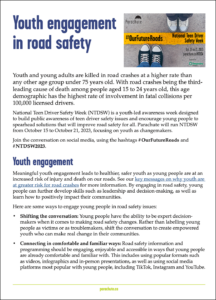
Meaningful youth engagement leads to healthier, safer youth as young people are at an increased risk of injury and death on our roads. By engaging in road safety, young people can further develop skills such as leadership and decision-making, as well as learn how to positively impact their communities.
422,21 KB PDF/UA
-
Why are youth at greater risk of road crashes (NTDSW 2023)
-
Does your local crossing guard go beyond the call of duty? Nominate them today to be Canada’s Favourite Crossing Guard!
-
Le brigadier ou la brigadière de votre localité sort du lot? Mettez dès aujourd’hui son nom en nomination pour le titre de brigadier.ère favori.te du Canada!
-
Official Contest Rules – Canada’s Favourite Crossing Guard
-
The Cost of Injury In Atlantic Canada (2022)
-
Cost of Injury in British Columbia (2022)
-
Toronto’s Vision Zero Road Safety Plan 2.0
The City of Toronto introduced their Vision Zero Road Safety Plan (2017-2021) in 2016, after two years of development with around 12 partner agencies and approval from Toronto City Council. In 2019, Toronto City Council approved Vision Zero 2.0, which represents a renewed commitment to the Vision Zero approach and an updated focus on efforts to achieve road safety goals.
-
La liste ‘Préserver votre autonomie’ personnalisable (2023)
Personnalisez cette liste Préserver votre autonomie en ajoutant le logo et les détails du site Web de votre organisation ou laissez-la telle quelle. La liste Préserver votre autonomie est un outil d’autoévaluation pour aider les aînés à déterminer leur risque de chutes. Les aînés sont encouragés à remplir la liste d’autoévaluation, puis d’effectuer, au besoin, un suivi auprès d’un professionnel de la santé.
2,26 MB Word
-
Customizable ‘Staying Independent Checklist’ (2023)
Customize this Staying Independent Checklist by adding your organization’s logo and website details or leave it as is. The Staying Independent Checklist is a self-screening tool for older adults to find out if they are at risk for falling. Older adults are encouraged to complete the Checklist and to follow-up with their healthcare provider as needed.
1,50 MB Word
-
Programme d’ambassadeur des jeunes pour la sécurité routière
-
Programme de subventions pour la sécurité routière des jeunes 2023
-
Youth Road Safety Grant Action Guide 2023
-
Youth Road Safety Grant application form 2023
-
9. Concussions – Kelli
-
8. Touch – Kelli
-
7. Hearing – Donna Mae
-
6. Vision – Henna
-
5. Taste – Adrian
-
4. Smell – Angus
-
2. Neuron – Guad
-
1. Introduction Video – Laura
-
Safe storage of cannabis
Storing cannabis responsibly helps keep everyone safe, especially children and pets. Learn how to store your cannabis safely and responsibly.
-
How to help prevent cannabis poisoning in children: Video
This video from Health Canada includes information on preventing cannabis poisonings in children, how to recognize the signs of cannabis poisoning and what to do about it.
-
How to help prevent cannabis poisoning in children: Brochure
-
Cannabis poisonings in children
Learn to recognize the signs of cannabis poisoning and what to do about it. Taking action quickly can help prevent serious harm.
-
Sensory water beads: what parents and caregivers should know
The Canadian Paediatric Society published this article in 2023 on the dangers of sensory water beads.
-
Saanich RSAP Engagement Strategy and Communications Plan
-
Windsor city council yet to see Vision Zero policy draft, despite four-year wait
-
Vision Zero Policy – Windsor, ON
-
Transportation Master Plan Update – Leduc, AB
-
City of Saint John Road Safety Strategy
-
City of Regina 2022 Proposed Budget Highlights
-
Timeline – Five-Year Road Safety Strategic Plan – Niagara Region
-
North Bay to develop strategy to improve road safety
-
Windsor, ON
-
Coquitlam, BC
-
Edmonton Vision Zero Timeline
-
Strategic Road Safety Action Plan – Durham, ON
-
Final Road Safety Action Plan report to council – Sannich, BC
-
Kitchener, ON
-
City of Kitchener Vision Zero Strategy 2022-2025
-
2022 Annual Report
-
2022 Annual Report
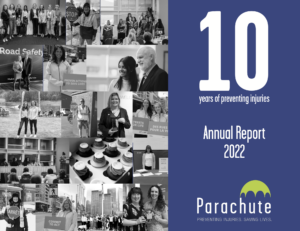
In 2022, Parachute celebrated its 10th anniversary with a series of events, including the Canadian Injury Prevention Conference held in Vancouver, B.C. from Nov. 4 to 6. The International Safety Media Awards recognized our work in injury prevention safety campaigns with nine awards, including one gold, three silver and two bronze. To support our work in Vision Zero road safety, we launched the Change for Good Roads initiative and founded the Canadian Youth Road Safety Council. Parachute supported the publication of the Pan-Canadian Poison Centres Annual Report, continued our work in fall prevention and concussion recognition and management, and launched our first-ever podcast: Popping the Bubble Wrap.
7,27 MB PDF/UA
-
Bringing Consumer Products into Canada (2012)
-
Water Smart Parents
-
Le Brigadier Favori du Canada – Affiche
-
Canada’s Favourite Crossing Guard – poster
-
Canadian Red Cross First Aid Training
The Canadian Red Cross website provides information on first aid and CPR courses, as well as first aid tips and resources.
-
Formation en secourisme de la Croix-Rouge Canadienne
Le site Web de la Croix-Rouge canadienne fournit des renseignements sur les cours de secourisme et de RCR, ainsi que des conseils et des ressources sur les premiers soins.
-
Preventing Falls: A Guide for People Living With Parkinson’s
-
Journée canadienne de prévention des blessures Mis à jour
-
Challenge JCPB des hôpitaux Mis à jour
-
Proclamations Mis à jour
-
Le chemin du bien-être : une étude de cas sur les solutions équitables pour améliorer la qualité de l’air à travers la sécurité routière et le transport (2023)

Cette étude de cas explore les relations multiformes entre la qualité de l’air, la sécurité routière et les transports, en mettant l’accent sur la promotion de solutions équitables pour améliorer la santé et la sécurité publiques. Elle présente les points de vue de professionnels travaillant dans le domaine de la sécurité routière et de la santé publique au Canada, en mettant l’accent sur le transport actif comme moyen de lutter contre le changement climatique, de réduire les émissions et d’améliorer la qualité de l’air.
542,97 KB PDF/UA
-
Road to Wellness: A case study on equitable solutions for improving air quality through the lens of road safety and transportation (2023)
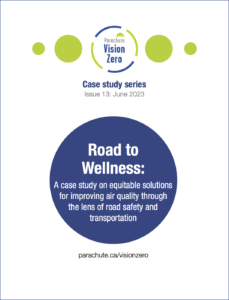
This case study explores the multifaceted relationship between air quality, road safety, and transportation, with a focus on promoting equitable solutions for enhancing public health and safety. It includes insights from professionals working in the field of road safety and public health in Canada, emphasizing active transportation as a means to combat climate change, reduce emissions, and improve air quality.
569,31 KB PDF/UA
-
Collection : Vision Zéro
-
Infographie sur l’efficacité des bottes d’hiver
Cette nouvelle infographie du KITE Research Institute du University Health Network souligne l’importance d’utiliser les tests en laboratoire de KITE pour déterminer l’efficacité des chaussures sur la glace, car l’apparence peut être trompeuse.
-
Nev Kent
-
Nev Kent
-
Semaine canadienne des jeunes pour la sécurité routière
-
World Guidelines for Falls Prevention and Management for Older Adults: A Global Initiative
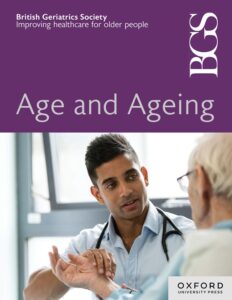
These guidelines were published in September 2022 in Age and Ageing, the scientific journal of the British Geriatrics Society. These guidelines were developed by the World Falls Task Force, which assembled 96 multidisciplinary experts from 39 countries across five continents, with representation from 36 scientific and academic societies.
-
Safe Use of Mobility Aids Checklist (SUMAC)
Cognitive and walking problems are common and progressive in dementia, leading to impaired mobility, falls and fall-related injuries. people with dementia have an annual fall risk of 60 to 80 per cent, twice that of the cognitively normal, and have a higher risk of major fall-related injuries, such as hip fractures. One rehabilitation strategy for balance and walking problems is the prescription of a mobility aid (e.g. a walker). Yet, paradoxically, use of a mobility aid in people with dementia is associated with a three-fold increased falls risk independent of other factors. One reason for this increased risk of falls include limited insight on safe use of the aid.
In 2020, a new assessment scale, Safe Use of Mobility Aids Checklist (SUMAC), for people with dementia who use a 4-wheeled walker was developed by Dr. Susan Hunter PT PhD, Associate Professor in the School of Physical Therapy at the University of Western Ontario. The tool standardizes the assessment of the quality of the person’s walking and safe practices while using the aid to improve communication across disciplines and aid in care planning. The scale was developed through focus groups with healthcare professionals who have experience of providing rehabilitation to people with dementia. The SUMAC assesses nine tasks that our panel of experts felt reflected a core set of skills needed for people to evaluate independent use of a 4-wheeled walker.
-
Liste de contrôle sur l’utilisation sécuritaire d’aide à la mobilité (SUMAC)
Chez les personnes atteintes de démence, les problèmes cognitifs et les troubles de la marche sont monnaie courante et s’aggravent progressivement jusqu’à conduire à une mobilité réduite, aux chutes et aux blessures attribuables à une chute. Soulignons en outre que les personnes atteintes de démence présentent un risque de chute annuel allant de 60 % à 80 %. Il s’agit d’un risque deux fois plus élevé que pour les personnes dont les fonctions cognitives sont normales. Les personnes atteintes de démence courent en plus un risque plus élevé de subir une blessure grave causée par une chute, comme une fracture de la hanche. L’une des techniques de réadaptation employée pour traiter les troubles de l’équilibre et de la marche consiste à prescrire une aide à la mobilité (p. ex., un déambulateur). Pourtant, chez les personnes atteintes de démence, on associe l’usage d’une aide à la mobilité, sans égard à d’autres facteurs, à un risque de chute trois fois plus élevé. Le peu d’information sur l’utilisation adéquate de l’aide à la mobilité pourrait en partie expliquer la situation.
En 2020, la physiothérapeute Susan Hunter a créé une nouvelle grille d’évaluation appelée Liste de contrôle pour l’utilisation sécuritaire des aides à la mobilité (SUMAC). La grille sert à évaluer les personnes atteintes de démence qui utilisent un déambulateur à quatre roues. Susan Hunter est professeure agrégée à l’école de physiothérapie de l’Université Western (Ontario) et détentrice d’un doctorat. (Cliquez ici pour lire les conclusions de l’étude https://bmcgeriatr.biomedcentral.com/articles/10.1186/s12877-020-01865-5 – texte en anglais.) La grille permet d’uniformiser l’évaluation de la manière de marcher et de manœuvrer en toute sécurité l’aide à la mobilité. Elle facilite ainsi la communication entre professionnels de diverses disciplines et la planification des soins. La grille est le fruit de groupes de réflexion formés de professionnels de la santé ayant de l’expérience en réadaptation auprès des personnes atteintes de démence. La liste de contrôle couvre neuf tâches considérées par le panel de spécialistes comme étant les compétences de base pour évaluer la capacité de manier un déambulateur à quatre roues de façon autonome.
-
Pro
Fou ND Raising Awareness for Falls Prevention: A guide to running campaign activities -
Occupational Therapy and Fall Prevention – Fact Sheet
-
Occupational Therapy in the Prevention and Management of Falls in Adults
Developed by the Royal College of Occupational Therapists, this document outlines the role of occupational therapy in preventing falls. It provides evidence-based recommendations of an occupational therapist’s role with the multifactorial assessment and interventions required to prevent and manage falls. It provides guidelines that focus on keeping individuals safe at home, keeping active, reducing the fear of falling, fall management with individuals and cost effectiveness.
-
NICE – Falls in older people: quality standard
A quality standard provides the principles of what to do and what to have ensuring the quality of interventions. Ultimately the standard helps to identify the goals to ensure a high quality of care. Standards are used in quality assessments and quality assurance programs, to identify gaps and where improvement in care can occur. Each province/health authority may have their own standards.
This quality standard covers prevention of falls and assessment after a fall in older people (aged 65 and over) who are living in the community or staying in hospital.
-
NICE – Falls in older people: clinical guideline
This clinical guideline covers assessment of fall risk and interventions to prevent falls in people aged 65 and over. It aims to reduce the risk and incidence of falls and the associated distress, pain, injury, loss of confidence, loss of independence and mortality.
-
Medications and the Risk of Falling – For Health Practitioners
-
Fracture Prevention Toolkit (in Long-Term Care)
The Ontario Osteoporosis Strategy for Long-Term Care is a province-wide program of outreach activities aimed at increasing awareness about fracture prevention, specifically in long-term care, with a focus on the importance of appropriate vitamin D and calcium intake, and on fall prevention. The toolkit contains valuable, practical information useful for healthcare professionals, caregivers and older adults living in long-term care homes and the community.
-
Bruyère Rapid Review: Falls Prevention in Continuing Care (2016)
-
La prévention des chutes en soins continus ― Un examen rapide de Bruyère (2016)
L’objet de cet examen était d’évaluer l’efficacité des outils de dépistage du risque de chute et de l’évaluation du risque de chute qui servent à établir un point de référence dans les interventions de prévention des chutes dans quatre environnements de soins continus, soient les soins palliatifs, la réadaptation gériatrique et post-AVC, les soins de longue durée et les soins médicaux de courte et de longue durée ou soins subaigus.
-
Alberta Health Services Falls Risk Management Post-Falls Review (2014)
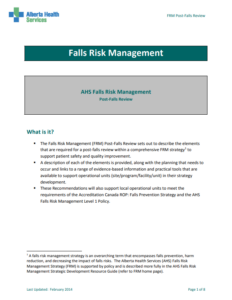
The review describes the elements required for a post‐falls review within a comprehensive falls risk management strategy to support patient safety and quality improvement. A description of each element is provided, along with the planning that needs to occur and links to evidence‐based information and practical tools available to support operational units (site/program/facility/unit) in their strategy development.
426,46 KB PDF
-
Step Ahead to Fall Prevention E-learning Module
The Step Ahead to Fall Prevention E-learning Module was developed by Toronto Public Health in partnership with York Region Public Health. The E-learning module is for health care providers, caregivers and individuals who provide care to older adults. The module examines age related changes and modifiable risk factors associated with falls and enables caregivers to incorporate fall prevention strategies when working with older adults.
-
STEADI Stopping Elderly Accidents Deaths & Injuries – CDC
The STEADI Initiative offers a co-ordinated approach to implementing the American and British Geriatrics Societies’ Clinical Practice Guideline for fall prevention. STEADI consists of three core elements: screen patients for fall risk; assess modifiable risk factors; and intervene to reduce risk by using effective clinical and community strategies. Combined, these elements can have a substantial impact on reducing falls, improving health outcomes and reducing health-care expenditures.
-
Reactive Balance Training Toolkit (Rebal Kit)
Many people, such as older adults and individuals with stroke, are at increased risk for falls. In order to keep from falling down, people must often perform rapid and sophisticated reactions, such as stepping or grasping movements. Reactive balance training (RBT) retrains these rapid reactions. RBT has been shown to improve control of rapid balance reactions and reduce fall rates by almost half compared to no exercise or typical balance training.
-
An Upstream Approach to Falls Prevention (learning module)
This online learning module was developed with public health professionals in mind, as well as others who work in the community who have an opportunity to impact the lives of older adults as they age. The purpose of the module is to understand the importance of older adult falls prevention and be aware of upstream actions and strategies that can be used to address falls. The module introduces facts about falls, risk factors for falls and provides a comprehensive health promotion framework to address falls in older adults and the broader population. The module takes approximately 30 minutes to complete.
-
Minds in Motion
Minds in Motion is a physical activity and brain stimulation program for people living with dementia and their care partners. The program runs in community-based recreation facilities and offers easy-to-follow physical activities as well as social recreation activities that are dementia-friendly.
-
Movement Snacks
To support older adults in moving more at home, Later Life Training in the United Kingdom developed movement snacks. These 20-minute videos posted on Facebook and YouTube encourage everyone to move more throughout the day, especially if you’re not able to get outside. There are more than 500 videos now on You Tube and it’s recommended you start at the beginning of the series.
-
Later Life Training™
This provides evidence-based exercise training to health and exercise professionals working with older people, frailer older people and stroke survivors. Their work is based in the United Kingdom. They provide courses and resources for download on their website.
-
Healthy Living Workshop (Active Aging Canada)
Active Aging Canada’s Healthy Living Workshop resources include:
Your Personal Passport to Healthy Living
Tool Kit for Healthy Living Workshops for Older Adults
Guidebook for Community Leaders
Virtual Facilitation Training Slide Deck (English only)
24-Hour Movement Guidelines and Workshop Posters
-
FAME
The Fitness and Mobility Exercise (FAME) Program is a group exercise program initially developed for people living with stroke who have some standing and walking ability. The program was developed to fulfill the urgent need for a safe and effective exercise program to enhance mobility and fitness of people living with stroke who are generally older, less fit, have mobility problems and are prone to falls.
-
Bone Fit™
This is an evidence-informed exercise training workshop for clinicians to address bone health and exercises for people with osteoporosis. It provides face-to-face instruction with two levels: One-day basics for those working in the community with clients with uncomplicated osteoporosis; and a two-day advanced workshop for rehabilitation practitioners working in a clinical environment for clients with simple or complicated osteoporosis.
-
Aging is a Contact Sport: Hip Protectors Video
-
Falls and Fall Prevention Among Older Adult Indigenous People of Australia, Canada, New Zealand and the United States: A systematic review (2016)
This systematic review presents detailed findings by the four countries represented in this review: Australia, Canada, New Zealand and the United States. The review of 34 articles shows that falls are the leading cause of injury for older adults in Indigenous communities, a pattern also found among non-Indigenous elderly, and the articles provide information on incidence and prevalence, as well as and fall prevention and related risk factors.
227,80 KB PDF
-
Saskatoon Health Region – Infographic
-
Finding Balance Nova Scotia – Infographic
-
Injury Data Online Tool (i
DOT) – BC Injury Research and Prevention Unit The iDOT is an easy-to-use, menu-driven system that makes injury data available to injury prevention practitioners and professionals, as well as the public. It is an effective and efficient way for users to access British Columbia injury data including mortality, morbidity, traffic-related incidents and sports.
-
Finding Alberta – Infographic
-
Public Health Ontario – Snapshots
These Interactive map-based dashboards show both geographic and temporal trends for key public health indicators by Public Health Unit (PHU), Local Health Integration Network (LHIN), LHIN sub-region (LHIN SR), and Ontario overall. It provides dynamically linked tables, graphs and maps with pre-calculated statistics. Snapshots uses Core Indicators developed by the Association of Public Health Epidemiologists in Ontario (APHEO).
-
Santé publique Ontario – Snapshots
Pour trouver des données liées aux chutes, cliquez sur Données et Analyses, Données sur les traumatismes.
-
Surveillance report on falls among older adults in Canada (2022)
-
Rapport de surveillance sur les chutes chez les aînés au Canada (2022)
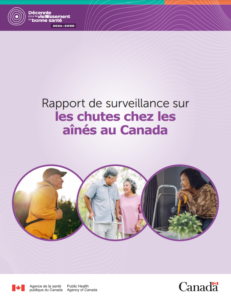
Publié par l’Agence de la santé publique du Canada en 2022, le présent rapport fournit des mises à jour des données nationales contenues dans le rapport « Chutes chez les aînés au Canada : Deuxième rapport » sur la nature et la gravité des chutes et sur le fardeau qu’elles représentent chez les personnes âgées de 65 ans ou plus, et décrit les changements survenus au fil du temps.
-
Osteoporosis and Related Fractures in Canada, 2021
-
L’ostéoporose et les fractures connexes au Canada, 2021
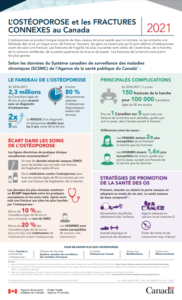
L’Agence de la santé publique du Canada a produit une infographie qui décrit le fardeau de l’ostéoporose et l’écart dans les soins au Canada, les principales complications de l’ostéoporose et les principales stratégies de promotion de la santé des os. L’infographie fournit également des ressources supplémentaires pour en savoir plus sur l’ostéoporose.
-
Physical activity for people living with osteoporosis
Osteoporosis Canada has developed a video series on exercise and osteoporosis in partnership with the University of Waterloo and Geriatric Education and Research in Aging Sciences Centre which provides ideas for safe and effective exercise and physical activity.
The video series tells the stories of four very different people with osteoporosis and showing their innovative solutions to keep healthy and active.
-
People living with arthritis
Arthritis Research Canada has developed two videos on fall prevention for those living with arthritis.
Episode 7 of the Arthritis Research Education Series focuses on how this organization is working to prevent falls in older adults through research and why this topic is important for people living with arthritis.
Learn how to prevent falls from Senior Scientist and physiotherapist, Dr. Linda Li, in Preventing Falls in Older Adults webinar recording.
-
Too Fit to Fracture
Too Fit To Fracture are evidence-based recommendations to help reduce the risk of fractures.
28,93 MB PDF
-
COVID-19 and Nutrition
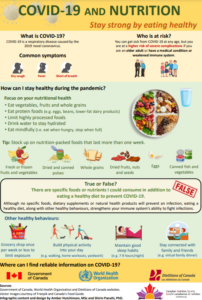
This infographic provides guidance on how to stay strong and healthy through good nutrition during the pandemic. Healthy eating can help prevent muscle and bone loss to reduce risk of falling or breaking bones. It provides basic information on symptoms of COVID-19, at-risk population, good nutrition guidance and other healthy behaviour.
970,17 KB PDF
-
COVID-19 et nutrition
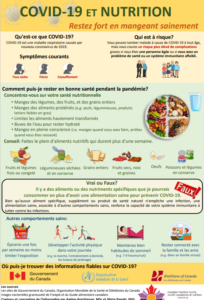
Comment rester en bonne santé durant la pandémie de COVID-19? Cette infographie fait le tour des symptômes de la COVID-19 et des populations à risque. Une saine alimentation peut aider à prévenir la perte musculaire et osseuse afin de réduire le risque de chute ou de fracture. On y donne aussi des conseils sur l’alimentation et les autres habitudes de vie à adopter pour rester en bonne santé durant la pandémie. L’infographie est disponible sur les sites Web de la Société canadienne de nutrition et du Groupe de travail canadien sur la malnutrition.
990,34 KB PDF
-
Canadian Malnutrition Task Force
The Canadian Malnutrition Task Force (CMTF) aims to reduce malnutrition by promoting nutrition care knowledge and optimal practice through research and education activities focused on preventing, detecting and treating malnutrition in Canadians. CMTF’s mandate also includes informing stakeholders and the public about the importance of optimal clinical nutrition care in hospital settings. One hidden impact of poor nutrition is an increased risk of falls.
-
Le groupe de travail canadien sur la malnutrition
Le groupe de travail canadien sur la malnutrition vise à réduire la malnutrition en favorisant les connaissances en soins nutritionnels et la pratique optimale par le biais d’activités de recherche et d’éducation axées sur la prévention, la détection et le traitement de la malnutrition chez les Canadiens. Le mandat du groupe de travail canadien sur la malnutrition comprend également d’informer les intervenants et le public, dont les aînés, de l’importance des soins de nutrition clinique optimaux dans les hôpitaux. Leur infographie ci-dessous note qu’un impact caché d’une mauvaise nutrition est un risque accru de chutes.
-
Canada’s Food Guide – Healthy Eating for Seniors
Learn why healthy eating is important for older adults. The Government of Canada’s website provides information on healthy eating specifically for older adults, further reading and healthy recipes.
-
Guide alimentaire canadien – une saine alimentation pour les aînés
Découvrez pourquoi une saine alimentation est essentielle pour les aînés sur la page Web du gouvernement du Canada.
-
Body
Break and Avoiding Frailty – Videos BodyBreak’s YouTube Channel consists of five videos on the topic of avoiding frailty.
-
Body
Break and Avoiding Frailty BodyBreak is a program that encourages Canadians to live healthy, active lifestyles. The BodyBreak program provides videos showcasing how practical and easy it is to do.
-
Vous pouvez éviter les chutes!
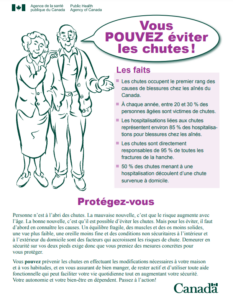
Rédigé par l’Agence de la santé publique du Canada. Ce guide de quatre pages décrit comment vous protéger contre les chutes à l’aide de modifications à la maison et aux habitudes de vie. Ce guide offre des conseils sur la façon de prévenir les chutes dans divers environnements (salle de bain, salon et chambre à coucher, cuisine, escalier et extérieur) et des conseils sur les pratiques saines de vie (repas sains, maintien en forme, utilisation sécuritaire de médicaments et d’aides fonctionnelles). Le document est écrit en langage clair.
-
Staying Independent Checklist
The Staying Independent Checklist is a tool that can be used by older adults, health care providers or caregivers to assess an adult’s risk for falls. This tool is for older adults living in their own home, as it is not validated for institutional living adults. Users answer « Yes »/ »No » to a list of statements and are given a score based on their response. The total score is tallied up and a recommendation is provided depending on how high the individual scores.
-
Évaluez votre risque de chutes
Cette liste de vérification est un outil pour les aînés, les fournisseurs de soins de santé ou les aidants. Elle permet d’évaluer le risque de chutes d’une personne. Cette liste de vérification vise les aînés vivant à domicile et non ceux vivant dans les institutions ou résidences d’aînés. Il suffit de répondre à chaque énoncé en encerclant « Oui » ou « Non » et de cliquer sur le bouton ‘Soumettre’. Des recommandations sont données en fonction du score total.
-
Preventing Falls in Older Adults (Saskatchewan Health Authority)
The Saskatchewan Health Authority Preventing Falls in Older Adults webpage has useful information for preventing falls in older adults.
-
Preventing Falls at Home
Sinai Geriatrics developed the ‘Preventing Falls at Home’ resource. This resource covers the dangers of falls, when you are at risk for a fall and how you can help prevent falls at home.
-
Prévention des chutes à la maison
-
How to safely help someone to get up – Video
Below is a video that provides instructions on what to do if someone falls.
-
Helping someone get up – Alberta Health Services
Guiding someone to get up after they’ve had a fall prevents you and them from being injured.
-
Gait and Balance in Older Adults: Slips, Trips and Falls (webinar)
Sinai Health and UHN (University Health Network) hosted this webinar on September 27, 2022, and is part of the Healthy Ageing 101 Webinar Series.
-
Finding Balance Newfoundland and Labrador: Western Health Region
Finding Balance Newfoundland has two websites for two of their health regions. This website is for their Western Health Region. Both websites provide information on the Finding Balance Campaign with posters available. Other resources link to Fall Prevention Month.
-
Trouver l’équilibre Nouveau-Brunswick
Trouver l’équilibre (Finding Balance) est une campagne de sensibilisation aux risques de glisser, de trébucher et de faire une chute chez les aînés. Une partie du matériel d’information disponible sur le site Web s’adresse aux intervenants et l’autre, aux aînés.
-
Finding Balance New Brunswick
The Finding Balance campaign raises awareness about preventing slips, trips, and falls among older Canadians. It offers resources for older adults and practitioners to promote safety and well-being.
-
Finding Balance BC
The Finding Balance campaign raises awareness about preventing falls among older Canadians. It provides valuable resources for both older adults and practitioners.
-
Trouver l’équilibre C.-B.
Trouver l’équilibre (Finding Balance) est une campagne de sensibilisation aux risques de glisser, de trébucher et de faire une chute chez les aînés. Une partie du matériel d’information disponible sur le site Web s’adresse aux intervenants et l’autre, aux aînés.
-
Falls: Common, Costly and Preventable (webinar)
Recorded Thursday Nov. 18, 2022, and organized by the Canadian Association of Retired Persons (CARP) featuring Nancy Edwards, Professor Emeritus and Distinguished Professor at the University of Ottawa; Dori Krahn, Community Relations Co-ordinator for the Saskatoon Fire Department who leads the Remembering When program, a fire safety and fall prevention program for older adults; and Stephanie Cowle, Director of Knowledge Translation at Parachute.
-
Fall Prevention: How Your Optometrist Can Help
Learn from the Ontario Association of Optometrists as to how an optometrist can detect and manage eye issues that may be increasing your risk of falling.
-
Carers Canada

Carers Canada is a priority initiative of the Canadian Home Care Association, a national non-profit membership group dedicated to advancing excellence in home and community care so Canadians can choose to live safely and independently in their communities. Through federal advocacy and national awareness campaigns, the goal of Carers Canada is to increase recognition and support for caregivers. Carers Canada’s vision is to “create a Canada that recognizes, respects and values the integral role of carers in society.” A founding member of the International Alliance of Carer Organizations, Carers Canada is part of a global initiative championing caregivers’ rights.
-
Virtual Care Guide for Patients
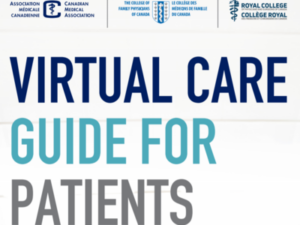
In collaboration with patients and their families, the Canadian Medical Association, the College of Family Physicians of Canada and the Royal College of Physicians and Surgeons of Canada have created this guide to help patients prepare for “virtual visits” with their doctor. It focuses on video visits, although it is also possible to receive virtual care through phone calls, text messaging and email. We recommend that you read the entire guide to gain the best possible results.
-
Guide sur les soins virtuels à l’intention des patients
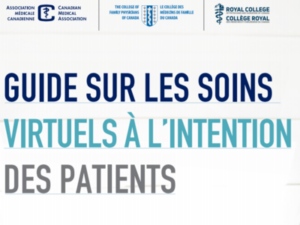
En collaboration avec des patients et leur famille, l’Association médicale canadienne, le Collège des médecins de famille du Canada et le Collège royal des médecins et chirurgiens du Canada ont créé ce guide pour aider les patients à se préparer aux consultations virtuelles avec leur médecin. Bien que ce guide porte essentiellement sur les consultations vidéo, il est également possible de recevoir des soins par téléphone, message texte et courriel. Nous vous recommandons de lire le guide en entier afin d’optimiser votre expérience.
-
Rate my Treads
Rate my Treads is a website that provides ratings for various types of winter footwear for their slip resistance in different winter conditions.
Rate my Treads is a product of iDAPT, the research arm of the Toronto Rehabilitation Institute – University Health Network located in Toronto. iDAPT works with a broad range of clinicians, engineers, scientists, researchers, students and more to find practical solutions to common problems.
-
Better Winter Footwear Handout
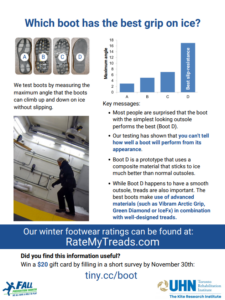
A new generation of winter footwear can significantly reduce the risk of slipping and falling on icy surfaces. This infographic produced by the KITE Research Institute at University Health Network highlights the importance of using KITE’s lab-based testing to determine footwear effectiveness on ice because looks can be deceiving.
-
Infographie sur l’efficacité des bottes d’hiver
-
CARP Ottawa: Winter footwear and staying active in winter
Session 1 of 3 from the C.A.R.P. Ottawa Chapter’s fall prevention webinar series in November 2020.
Leigh Vanderloo (Knowledge Translation Manager, ParticipACTION) describes the importance of maintaining physical activity during winter months and movement guidelines.
Tilak Dutta (Scientist, KITE Research Institute, University Health Network) describes how his lab tests gripability of winter boots and how they rate winter boots that provide better friction on ice.
Judy Andrew-Piel (Community Support Coordinator, Bushtukah) explains traction basics with practical tips regarding safer outdoor winter footwear.
-
Canadian Medication Appropriateness and Deprescribing Network – Medications and Falls
The Canadian Medication Appropriateness and Deprescribing Network has a webpage with information on medications that are more likely to cause you to fall. Learn about the different types of medications and which ones may increase your risk of falling. Always consult your doctor about your risk for falling when you are being prescribed new medication, or if you think your current medication will increase your risk for falling.
-
Le Réseau canadien pour l’usage approprié des médicaments et la déprescription – les médicaments et les chutes
Le Réseau canadien pour l’usage approprié des médicaments et la déprescription a une page Web avec de l’information sur les médicaments qui sont plus susceptibles de vous faire tomber. Consultez toujours votre médecin au sujet de votre risque de chute lorsque vous recevez une nouvelle prescription, ou si vous pensez que votre médicament actuel augmentera votre risque de chute.
-
Preventing Falls on Stairs
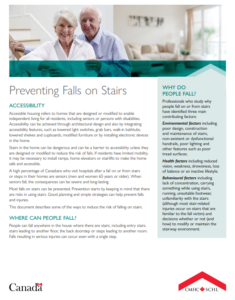
This fact sheet describes the common causes of falls on stairs and provides many strategies to help prevent them. Most falls can be prevented through good planning and recognition of the health, environmental and behavioural contributors to falls. Includes design suggestions for safe stairs and a glossary of terms. (© 2004 CMHC, Revised 2016)
-
Comment prévenir les chutes dans les escaliers
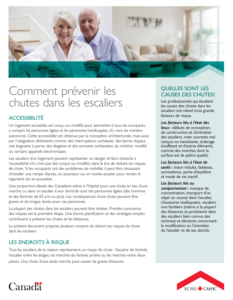
Ce feuillet d’information fait état des causes courantes des chutes dans les escaliers et fournit de nombreux moyens de les éviter. La plupart des chutes peuvent être évitées, soit par une bonne planification, soit en tenant compte des facteurs liés à l’état des escaliers et à l’état de santé et au comportement de ceux qui les utilisent. Le feuillet comporte des suggestions conceptuelles axées sur la sécurité ainsi qu’un glossaire. (© 2004 SCHL, révision 2016)
-
Maintaining Senior’s Independence Through Home Adaptations
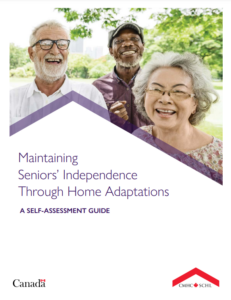
This self-assessment guide was developed by the Canada Mortgage and Housing Corporation. Designed for older adults, this large-print guide identifies the types of difficulties older adults can experience in the home and describes adaptations to overcome these difficulties. This Guide helps older adults assess their own unique circumstances including using stairs, moving around the house, doing laundry and answering the door. The Self-Assessment Guide would be of interest not only to older adults but their families and caregivers. (March 31, 2018).
-
Maintenir l’autonomie des aînés par l’adaptation des logements
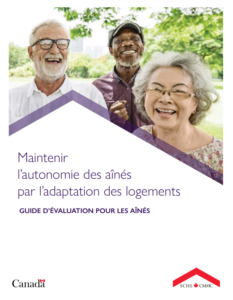
Destiné aux aînés, ce guide imprimé en gros caractères recense les types de difficultés qu’ils éprouvent à la maison et décrit les travaux d’adaptation permettant de surmonter ces difficultés. Il aide les aînés à évaluer leur milieu de vie et son influence sur leurs actes quotidiens (emprunter les escaliers, se déplacer dans la maison, faire la lessive, répondre à la porte, etc.). Utile non seulement pour les aînés, mais aussi pour leur famille et fournisseurs de soins. (Mars 31, 2018).
-
CARP Ottawa: Make your bathroom safer
Session 2 of 3 from the C.A.R.P. Ottawa Chapter’s fall prevention webinar series in November 2020.
Paulette Guitard (Professor and Occupational Therapist, School of Rehabilitation Scientist, University of Ottawa) describes how and why grab bars that are properly installed in bathrooms can prevent falls.
Peter Hache (Owner of Renos4Life – formerly Renos4Seniors) describes considerations and innovations in the design and renovation of bathrooms that are safer.
-
CARP Ottawa: How to make stairs safer for everyone
Session 3 of 3 from the C.A.R.P. Ottawa Chapter’s fall prevention webinar series in November 2020.
Sarah Fraser (Assistant Professor, Faculty of Health Sciences, University of Ottawa) describes assessing stairs for safety and showed common examples of fall hazards on stairs.
Craig White (Branch Manager, Stannah Stair Lifts) describes what to consider when deciding whether or not to install a stair lift as an option to more safely navigate stairs.
-
Safer Bathrooms, Safer Bathing
Navigating a slippery bathtub or shower can be challenging, but grab bars can help you move safely and confidently in your bathroom. In this infographic from the KITE Research Institute at University Health Network, find out what features to look for in a grab bar, and where to install it. Check out the links at the bottom of the infographic for resources, and where to turn if you need more help.
-
Une salle de bain sécuritaire pour un bain en sécurité
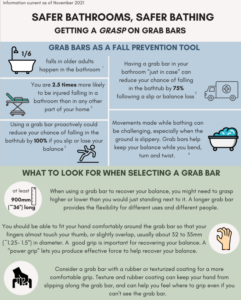
Naviguer dans une baignoire ou une douche glissante peut être difficile, mais les barres d’appui peuvent vous aider à vous déplacer en toute sécurité et en toute confiance dans votre salle de bain. Dans cette infographie du KITE Research Institute du University Health Network, découvrez quelles fonctionnalités à rechercher dans une barre d’appui et où l’installer. Consultez les liens au bas de l’infographie pour les ressources et les organismes à rejoindre si vous avez besoin d’aide.
-
Preventing vision-related falls in seniors
-
Balance exercises for people living with Parkinson’s disease – Video Series
This video series includes several low-impact balance exercise classes with Parkinson Society BC’s neuro physiotherapist, Shelly Yu. These classes focus on lower extremity strength and agility-type activities required for fall prevention, such as multidirectional stepping, weight shifting, and turning.
-
Balance exercises for people living with Parkinson’s disease – Tip Sheet
-
Physical activity for older adults – Active Aging Canada
Active Aging Canada promotes healthy aging among older adults across Canada. You can find a physical activity directory, information for active aging at home and details on local exercise programs across Canada.
-
Gens âgés actifs au Canada – Vieillir activement Canada
Vieillir activement Canada explique aux Canadiens et Canadiennes âgés comment pratiquer sans danger et avec succès l’activité physique.
-
Formation et communauté engagée
-
Training and communities of practice
Enhance your expertise and skills in preventing childhood falls through training and communities of practice. Access evidence-informed programs, connect with fellow professionals, and stay up to date with the latest practices for ensuring
-
Practitioner resources
Explore a diverse range of reports, guidelines, and research materials that support professionals in preventing childhood falls. Access evidence-based practice resources to inform and enhance your work in children’s safety.
-
Child falls collection
Find resources here on general fall and injury prevention, training and communities of practice, as well as statistics and infographics.
-
Collection : chutes chez les enfants
Trouvez ici des ressources sur la prévention générale des chutes et des blessures, la formation et les communautés de pratique, ainsi que des statistiques et des infographies.
-
ALTER – website
ALTER is an evidence-based approach that helps parents of children under 6 years old prevent injuries in the home. The five action principles are activities, location, timing, environment, and resources to alter for child safety.
-
ALTER – one pager
-
ALTER – brochure
-
ALTER – poster
-
Child Safety Link – Infographic
-
Loop – Fall Prevention Community of Practice for Adults
Loop is a no-cost, bilingual online platforms that brings together practitioners, caregivers, researchers, and policy planners working on fall prevention for adults. Loop provides a place to innovate, learn, share, and implement.
-
Stastiques et infographies
-
Statistics and Infographics
Data-driven decision-making starts here. Access most currently available statistics and visually engaging infographics that shed light on the prevalence, causes, and impact of childhood falls.
-
Child Safety Link – Backgrounder
-
Particip
ACTION app ParticipACTION is a national non-profit organization aimed at getting Canadians to sit less and move more. The ParticipACTION app is designed for all ages. Win prizes, track activities and receive customized workout and lifestyle content to help people along the way. Everything in the app is research-based, rooted in behaviour change science and designed for Canadians by Canadians.
-
Application Particip
ACTION ParticipACTION est un organisme national à but non lucratif qui aide les Canadiens à s’asseoir moins et bouger plus. L’application ParticipACTION est gratuite et conçue pour tous les âges. Elle donne accès à toutes sortes d’outils, de conseils, de vidéos instructives et à un objectif d’activité physique évoluant au gré de votre parcours. Tout le contenu présenté dans l’application est le fruit de recherches scientifiques et est axé sur la science de changement comportemental.
-
Is your child safe? Sleep time
Health Canada has produced this guide to provide parents and caregivers with information to keep children safe during sleep time. The guide provides information on general sleep safety tips and product safety standards for items that could cause fall related injuries (e.g., bunk beds).
-
Votre enfant est-il en sécurité? À l’heure du coucher
Santé Canada a produit ce guide pour fournir de l’information aux parents et aidants naturels pour garder leur enfant en sécurité pendant son sommeil. Le guide fournit de l’information sur les conseils généraux de sécurité du sommeil et les normes de sécurité des produits pour les articles qui pourraient causer des blessures liées aux chutes (p. ex., lits superposés).
-
Is your child safe?
This resource is from Health Canada. This resource provides parents/caregivers with information to reduce the risk of injuries associated with consumer products such as those around the house (blind and curtain cords, poison prevention, children’s products, and cosmetics), sleep time (bunk beds), and play time (toy boxes, ride-on-toys) through guidelines for proper use of consumer products.
-
Votre enfant est-il en sécurité?
Cette ressource provient de Santé Canada. Cette ressource fournit aux parents/soignants de l’information pour réduire le risque de blessures associées à des produits de consommation tels que ceux autour de la maison (cordons de couvre-fenêtres et de rideaux, prévention des empoisonnements, produits pour enfants et cosmétiques), à l’heure du lit (lits superposés) et à l’heure du jeu (coffres à jouets, jouets à enfourcher) grâce à des lignes directrices pour une utilisation appropriée des produits de consommation.
-
Kidsafe fall prevention
This resource is from Kidsafe New South Wales Inc. This resource provides parents/caregivers with common causes of serious fall injuries in and around the home. Some falls are serious enough to require hospital admission and serious preventable injuries can be avoided through community understanding of safety issues. This resource separates common causes of fall injuries into categories: Furniture and Nursery Products, Windows and Balconies, Stairs, Falls in Backyard, and Falls on and around Roads and Driveways, with each category linking to PDF files with prevention tips.
-
Keeping your children safe from falls
Resources provided by Alberta Health Services. Three resources based on the developmental stages of children provide parents/caregivers with key messages to prevent falls in toddlers, pre-schoolers, and babies (age 0-6) indoors and outdoors and what actions need to be done to keep them safe from falls.
-
Child safety: preventing falls (Saskatchewan Health Authority)
The Saskatchewan Health Authority ‘Child Safety: Preventing Falls’ webpage has useful information for protecting babies and young children from falls and injuries. The page also includes a video with « around-the-clock ideas to keep your baby safe ».
-
Child falls by Ottawa Public Health
The Ottawa Public Health website provides fall prevention tips for parents of babies, toddlers and children (0 to 6) focusing on the child’s stage of development. Resources such as posters and infographics are also available.
-
Chutes chez les enfants (Santé publique Ottawa)
Santé publique Ottawa fournit des conseils de prévention des chutes aux parents de bébés, de tout-petits et d’enfants (0 à 6) en mettant l’accent sur le stade de développement de l’enfant. Des ressources telles que des affiches et des infographies sont également disponibles.
-
Window fall prevention video

This resource is from Seattle Children’s Hospital. This resource is a 30-second video providing tips to parents/caregivers for preventing window falls. Children under 7 are at most risk of falling from windows. Window screens are ineffective in preventing falls. Instead parents should install child safety window stops and window guards, keep areas near windows clear of anything a child can climb on and enforce kid free zones in front of windows.
-
CPHA – unstructured play
-
ACSP – Le jeu libre
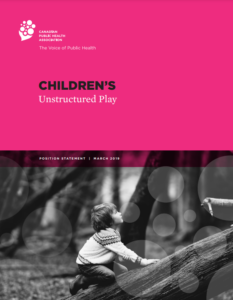
L’ Association canadienne de santé publique (ACSP) reconnaît le jeu libre comme un droit de l’enfant et un élément essentiel à la santé et au bien-être durant l’enfance et la jeunesse. Il faut agir pour réduire les obstacles qui limitent les occasions pour les enfants de jouer librement à l’école et dans leur quartier. L’ACSP invite les parents et proches aidants, les prestataires de services de garde, les enseignants, les conseils et commissions scolaires, les professionnels de la santé publique, le secteur privé et tous les ordres de gouvernement, y compris les gouvernements autochtones, à élargir l’accès au jeu libre dirigé par l’enfant.
Dans le cadre du projet, l’ACSP a mené des entretiens avec des informateurs (juristes, conseillers et commissaires scolaires, assureurs et gestionnaires de risques, conseillers et chefs de services municipaux, chercheurs et défenseurs du jeu, animateurs ludo-éducatifs, concepteurs et inspecteurs de terrains de jeux) et un sondage auprès de parents et de tuteurs pour orienter l’élaboration de la trousse.
-
Outside play
Outside Play is an online tool to help parents and caregivers gain the confidence to allow their kids to engage in more outdoor play. This site was created by injury prevention partners in British Columbia.
-
Atlantic Canada Child & Youth Unintentional Injury Hospitalizations: 10 years in review
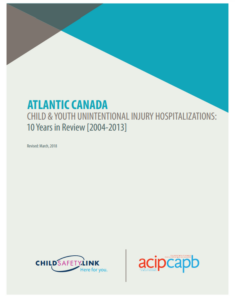
This report builds on the previous report from 2005 entitled Child & Youth Unintentional Injury Atlantic Canada: 10 years in review. Data was commissioned from the Canadian Institute for Health Information hospitalization trends (2004-2013) for childhood injury over a 10-year period, the most recent years for which data were available both at the national and provincial levels. The purpose of this report is to determine the pattern of injuries to children and youth in Atlantic Canada and, where possible, whether these injury patterns follow national trends. The data in this report mainly focus on hospitalizations of children from birth to age 14 (inclusive) and is about unintentional injuries only, including falls.
669,14 KB PDF
-
Canada Atlantique: hospitalisations à la suite de blessures accidentelles chez les enfants et les adolescents : étude sur une période de dix ans
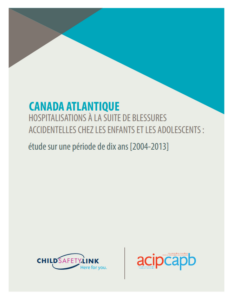
Cette étude repose sur le rapport précédent de 2005 intitulé Blessures accidentelles chez les enfants et les adolescents, provinces de l’Atlantique : études des dix dernières années. Les données ont été établies à partir des tendances observées par l’Institut canadien d’information sur la santé en matière d’hospitalisations (2004-2013) liées à des blessures chez les enfants sur une période de dix ans, soit les années les plus récentes pour lesquelles des données étaient disponibles tant à l’échelle nationale que provinciale. Notre objectif était de déterminer les types de blessures accidentelles subies par les enfants et les adolescents dans le Canada atlantique, ainsi que d’établir si ces types de blessures correspondent aux tendances nationales, incluant les chutes.
713,04 KB PDF
-
Ontario Childhood Falls Infographic 2017
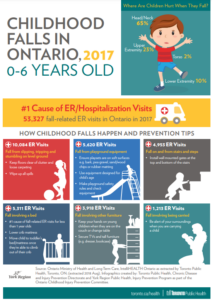
This infographic highlights statistics from Ontario data on falls in children ages 0 to 6 years. How childhood falls happen and where they are hurt are included. Data for this infographic were supplied by Toronto Public Health. This infographic was created in collaboration with York Region Public Health and Toronto Public Health.
73,94 KB PDF
-
Fact bank
-
Banque de statistiques

La banque de statistiques présente des données sur les chutes et leurs sources d’information pour les provinces et territoires du Canada ainsi que des données mondiales.Cette année, la banque de statistiques comprend des points clés du rapport de surveillance sur les chutes chez les aînés au Canada par l’Agence de santé publique du Canada et d’autres données récentes. La banque de statistiques est très utile lors de la création de matériel pour informer ou promouvoir la prévention des chutes dans votre communauté.
-
Child Safety Link
Child Safety Link is an injury prevention program at the Izaak Walton Killam Hospital (IWK) Health Centre in Halifax, Nova Scotia dedicated to reducing the incidence and severity of unintentional injury to children and youth in the Canadian Maritimes.
-
The Great Child Safety Challenge — preventing home injuries in the living room (1-3 years)
Given that children aged 0 to 4 are most likely to fall at home, Child Safety Link developed a video illustrating several challenges to safety that can occur in the living room for children between the ages of 1 and 3 years.
-
Child Safety Link: La prévention des chutes à la maison (Enfants de 1 à 3 ans)
Étant donné que les enfants âgés de 0 à 4 ans sont les plus susceptibles de tomber à la maison, Child Safety Link a mis au point une vidéo illustrant plusieurs défis à la sécurité qui peuvent se produire dans le salon pour les enfants âgés de 1 à 3 ans.
-
Preventing unintentional injuries in Indigenous children and youth in Canada

Unintentional injuries are the leading cause of death in Canadian Indigenous children and youth, occurring at rates three to four times the national average. This position statement discusses unintentional injuries in Canadian Indigenous children and youth, injury mechanisms and recommendations for reducing the rate and severity of these injuries.
-
La prévention des blessures non intentionnelles chez les enfants et adolescents autochtones au Canada

Les blessures non intentionnelles sont la principale cause de décès chez les enfants et adolescents autochtones canadiens, à un taux de trois à quatre fois la moyenne nationale. Cet énoncé de position de la Société canadienne de pédiatrie traite de divers mécanismes de blessures non intentionnelles chez les enfants et les jeunes autochtones canadiens, y compris les chutes, et propose des recommandations visant à réduire le taux et la gravité de ces blessures.
-
Injury in Review, 2020 Edition: Spotlight on Traumatic Brain Injuries across the Life Course
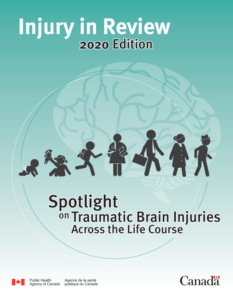
This report provides national surveillance statistics on head injuries and traumatic brain injuries across the life course, including deaths, hospitalizations and emergency department visits, using data sources including the Canadian Vital Statistics Death Database of Statistics Canada; the Hospital Morbidity Database and Discharge Abstract Database of the Canadian Institute for Health Information (CIHI); the National Ambulatory Care Reporting System of CIHI; and the Electronic Canadian Hospitals Injury Reporting and Prevention Program database (eCHIRPP).
4,23 MB PDF
-
Étude des blessures: Édition 2020. Pleins feux sur les traumatismes crâniens tout au long de la vie
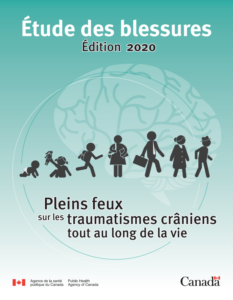
Ce rapport fait état des statistiques de surveillance nationale pour les blessures et traumatismes crâniens tout au long de la vie, et inclus des données sur les décès, les hospitalisations et les visites aux services d’urgence. Ces données proviennent de plusieurs sources incluant la base canadienne de données sur l’état civil – décès de Statistique Canada; la base de données sur la morbidité hospitalière de l’Institut canadien d’information sur la santé (ICIS); la base de données sur les congés des patients de l’ICIS ; le système national d’information sur les soins ambulatoires de l’ICIS; et la base de données électronique du système canadien hospitalier d’information et de recherche en prévention des traumatismes de l’Agence de la santé publique du Canada.
4,42 MB PDF
-
Child Safety Good Practice Guide
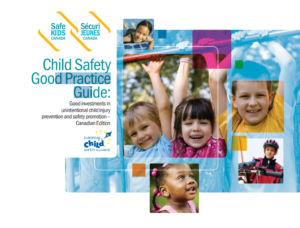
This resource is from Safe Kids Canada (now known as Parachute). This resource provides the first seminal comprehensive document in the country from which decision-makers, practitioners and legislators can base their work and recommendations. This resource can be used by health care professionals to promote good practice in planning and implementing strategies to address injury in children aged 0-14 years of age. Areas of safety included in this document include passenger safety, pedestrian safety, cyclist safety, water safety, fall prevention, burn and scald prevention, poisoning prevention, choking/strangulation prevention, general home safety, and general community-based injury prevention. This resource uses a series of evidence statements describing current good practice, provides an indication of whether a case study for that particular strategy has been identified and included, and provides suggestions for transferring and implementing that strategy.
3,97 MB PDF
-
A million messages
This online learning module from Alberta Health Services provides health care professionals with standardized child injury prevention messages and resources to pass along to parents/caregivers based on developmental stages and associated injury risk factors of children ages 0 to 3.
-
Safe and Healthy Children: A Public Health Resource Manual for Child Care Providers
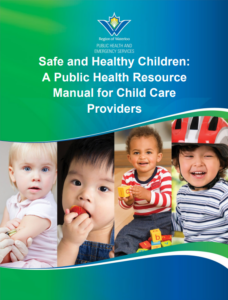
This resource provides childcare providers with fall prevention tips. These tips can be used by childcare centres themselves, the staff at the centres, and parents/caregivers of the children. Childcare providers play an important role in keeping children safe. This resource provides childcare providers as well as parents/caregivers with actions they could take to decrease the number of injuries in children.
707,19 KB PDF
-
Preventing falls – injury prevention & safety, information for health professionals
This is Alberta Health Service’s web page on preventing falls among children and older adults. It provides key messages and additional resources including Preventing Harm from Falls at Home and At Play toolkit.
-
Loop fall prevention webinars
Loop Fall Prevention Community of Practice provides webinars regularly on topics related to fall prevention. These webinars are recorded and uploaded to Loop’s YouTube channel. The webinars are hour-long presentations from experts in the field. They highlight evidence-based information with practical applications for health-care practitioners.
-
Webinaires de Loop sur la prévention des chutes
Les communautés engagées pour la prévention des chutes Loop et Loop Junior organisent régulièrement des webinaires sur des sujets liés à la prévention des chutes. Ces webinaires sont enregistrés et téléchargés sur la chaîne YouTube de Loop et Loop Junior. Les webinaires sont des présentations d’une heure d’experts dans le domaine. Ils mettent en évidence l’information fondée sur des données probantes avec des applications pratiques pour les professionnels de la santé.
-
Child safety (Middlesex-London Health Unit)
The Middlesex-London Health Unit’s website has information on home safety for babies, toddlers and children. Their site contains resources including checklists, posters and videos.
-
Child injury prevention and safety presentations
The Saskatchewan Prevention Institute developed this presentation for community-based programs to use in their work with families to help prevent child injuries. This presentation may also be of interest to public health professionals, early childhood educators, daycare providers and others working with parents/caregivers and children. The focus of this presentation is on falls, which are the leading cause of injury-related hospitalizations in Saskatchewan children and youth.
-
Loop Evidence Summary: Fall Prevention and COVID-19
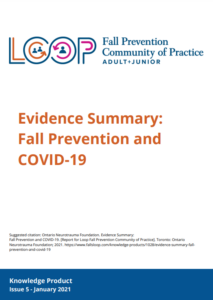
The Loop Fall Prevention Community of Practice developed an evidence summary that reviews the impact of COVID-19 on risk factors contributing to fall-related injuries. It also summarizes current and emerging evidence on the effective planning and implementation of fall risk screening and assessment, fall care, fall rehabilitation and fall prevention initiatives, all of which have become largely reliant on virtual modalities of delivery in order to comply with COVID-19 countermeasures. The summary concludes with key implications for fall prevention policy and practice over the course of the COVID-19 pandemic.
247,32 KB PDF
-
Impact of COVID-19 on Accidental Falls in Canada
-
Conséquences de la pandémie de COVID-19 sur les chutes accidentelles au Canada
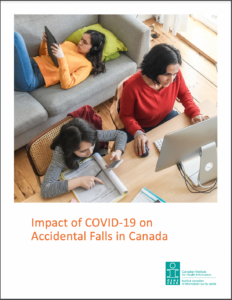
Le rapport présente des données préliminaires sur les visites aux urgences et les hospitalisations en raison de chutes accidentelles qui ont eu lieu entre le 1er mars et le 30 septembre 2020. Il se penche aussi sur les lieux des chutes, les types de chutes, ainsi que les caractéristiques des patients et les mesures d’égalité en santé.
-
Illuminez les réseaux sociaux Mis à jour
Our hashtags #ParachuteNIPD and #TurnSafetyOn garnered XX million social media impressions.
-
Illuminez le Canada ! Mis à jour
Nous invitons tout le monde au Canada à « s’allumer en vert » à l’occasion de la Journée nationale de prévention des blessures, le 6 juillet 2026 !
-
Votre siège d’auto convient-il à votre enfant?
-
Is your child in the right seat?
-
Hélène Gagné de Parachute discute avec Radio-Canada Toronto de notre soutien à l’obligation de porter des gilets de sauvetage sur les bateaux.
-
Pour un bon départ: Votre siège d’auto est-il sécuritaire?
-
Images des médias sociaux de la Semaine Sécuri
Jeunes 2023 -
Attachez votre enfant! Sécurité des sièges d’auto pour enfants
Nous souhaitons vous aider à choisir et à installer le bon siège d’auto pour assurer la sécurité de votre enfant.
-
Buckle up! Child car seat safety
Transport Canada wants to help you choose and install the right car seat to help keep your child safe and secure.
-
Occupant Restraints: A Road Safety Manual for Decision-Makers and Practitioners
This manual provides guidance and evidence for decision-makers and practitioners that should lead to an increase in the use of vehicle occupant restraints, such as car seats for babies and children.
-
Tigrinya : Vote siège d’auto convient-il à votre enfant? (2023)
-
Swahili : Vote siège d’auto convient-il à votre enfant? (2023)
-
Somalienne : Vote siège d’auto convient-il à votre enfant? (2023)
-
Népalaises : Vote siège d’auto convient-il à votre enfant? (2023)
-
Mandarin : Vote siège d’auto convient-il à votre enfant? (2023)
-
Arabe : Vote siège d’auto convient-il à votre enfant? (2023)
-
Anglais : Vote siège d’auto convient-il à votre enfant? (2023)
-
Français : Vote siège d’auto convient-il à votre enfant? (2023)
-
Ceinture de sécurité
Quand votre enfant fait plus que 145 cm (4 pi 9 po), le temps est peut-être venu de passer au simple port de la ceinture de sécurité. Par contre, si celle-ci ne peut être utilisée correctement tel qu’il est décrit ci-après, continuez à utiliser un siège d’appoint. La banquette ou le siège arrière est l’endroit le plus sécuritaire pour votre enfant jusqu’à ce qu’il ait 13 ans.
2,37 MB PDF/UA
-
Siège d’appoint
Un siège d’appoint élève l’enfant de sorte que la ceinture de sécurité s’ajuste sur les os les plus solides, loin des tissus mous du ventre. Pour utiliser un siège d’appoint, l’enfant doit peser au moins 18 kg (40 livres) et pouvoir s’asseoir correctement.
3,08 MB PDF/UA
-
Siège orienté vers l’avant
Un siège orienté vers l’avant utilise un harnais à 5 points d’ancrage pour répartir la force sur les parties les plus fortes du corps en cas d’arrêt soudain ou de collision. Ce type de siège protège un enfant maintenant trop grand pour le plus grand des sièges orientés vers l’arrière.
3,16 MB PDF/UA
-
Siège orienté vers l’arrière
Un siège orienté vers l’arrière offre la meilleure protection pour la tête, le cou et la colonne vertébrale de votre enfant en cas d’arrêt soudain ou de collision. Quand votre bébé devient trop grand pour le siège de bébé, utilisez un siège plus grand orienté vers l’arrière.
2,42 MB PDF/UA
-
Siège de bébé
Un siège orienté vers l’arrière offre la meilleure protection pour la tête, le cou et la colonne vertébrale de votre bébé en cas d’arrêt soudain ou de collision. Vous pouvez utiliser un siège qui s’installe uniquement orienté vers l’arrière ou un siège convertible plus gros orienté vers l’arrière pourvu que votre bébé puisse y être assis correctement.
3,07 MB PDF/UA
-
French: Is your child in the right seat? (2023)
This video was developed to provide basic child passenger safety information in an accessible way. For more information about #KidsInTheRightSeat go to parachute.ca/carseats
-
Tigrinya: Is your child in the right seat? (2023)
This video was developed to provide basic child passenger safety information in an accessible way. For more information about #KidsInTheRightSeat go to parachute.ca/carseats
-
Arabic: Is your child in the right seat? (2023)
This video was developed to provide basic child passenger safety information in an accessible way. For more information about #KidsInTheRightSeat go to parachute.ca/carseats
-
Mandarin Chinese: Is your child in the right seat? (2023)
This video was developed to provide basic child passenger safety information in an accessible way. For more information about #KidsInTheRightSeat go to parachute.ca/carseats
-
English: Is your child in the right seat? (2023)
This video was developed to provide basic child passenger safety information in an accessible way. For more information about #KidsInTheRightSeat go to parachute.ca/carseats
-
Nepalese: Is your child in the right seat? (2023)
This video was developed to provide basic child passenger safety information in an accessible way. For more information about #KidsInTheRightSeat go to parachute.ca/carseats
-
Swahili: Is your child in the right seat? (2023)
This video was developed to provide basic child passenger safety information in an accessible way. For more information about #KidsInTheRightSeat go to parachute.ca/carseats
-
Somali: Is your child in the right seat? (2023)
This video was developed to provide basic child passenger safety information in an accessible way. For more information about #KidsInTheRightSeat go to parachute.ca/carseats
-
Getting started: Is your car seat safe to use?
-
Car seats – Seat belts
-
Car seats – Booster
-
Car seats – Forward-facing
-
Car seats – Rear-facing
-
Car seats – Infant
-
Global road safety actions 2023: What you need to know (2023)
Presented by Parachute and CARSP, this webinar built upon the previous webinar and provide an update on the Global Plan for the Decade of Action for Road Safety 2021-2030, along with tools coming out of the eighth global meeting of NGOs advocating for road safety and road victims that took place March 6 to 10, 2023 in El Salvador.
We also shared turnkey social media messages and printable creative tools for all road safety partners to use for the upcoming UN Global Road Safety Week, running May 15 to 21, 2023, which calls on policy makers to #RethinkMobility to make walking, cycling and public transport safe and convenient so that people can make the shift to active, sustainable mobility.
PRESENTERS
Valerie Smith Director, Programs Parachute
Raheem Dilgir President Canadian Association of Road Safety Professionals -
Winnipeg Road Safety Strategic Action Plan
-
Backgrounder – Safe Kids Week 2023
-
Safe Kids Week 2023 social media images
-
Mobilité sécuritaire dans les zones urbaines – version compilée imprimable
-
Safe mobility in urban areas – combined printable version
Download a printable 28 cm x 43 cm (11” x 17”) PDF in poster format that combines the information from the Equity, Environment, and Health and Wellness infographics. (
232,00 KB PDF
-
Mobilité sécuritaire en zone urbaine – les données
-
Mobilité sécuritaire en zone urbaine – l’environnement
-
Mobilité sécuritaire en zone urbaine – la santé et le bien-être
-
Safe mobility in urban areas – Using data to drive road system decisions
-
More than half of Canadians say that road safety should be among the top five priorities for government to address in their community
-
Pour plus de la moitié des Canadiens, la sécurité routière devrait figurer parmi les cinq premières priorités gouvernementales au sein de leur communauté
-
Celebrating a toll-free poison centre number, a decade in the making
-
Dix ans plus tard, voici enfin le numéro gratuit du centre antipoison!
-
Safe mobility in urban areas – Health and wellbeing
-
Safe mobility in urban areas – Environment
-
Conversations communautaires : Les enjeux de vieillir chez soi en santé et autonome – 2 février 2023
Nous discuterons ensemble des enjeux de vieillir chez soi en santé et de façon autonome. Il y sera surtout question de continuer de vieillir de manière autonome et de ce que cela implique pour vous dans l’immédiat et dans l’avenir.
Les conversations communautaires ont lieu grâce à une subvention versée par le gouvernement du Canada dans le cadre du Programme Nouveaux Horizons pour les aînés et au travail de cocréation pour les aînés, par les aînés. Elles visent à créer un espace de rencontre virtuel afin que les aînés puissent parler de ce qui les préoccupe le plus par rapport à vieillir chez soi en santé et en sécurité. En participant, vous aurez l’occasion de vous entretenir avec d’autres aînés de partout au Canada, de connaître les ressources auxquelles vous avez accès et de parler de votre propre vécu si vous voulez.
Les organisateurs des rencontres (c’est-à-dire des aînés et des représentants d’organismes au service des aînés) se baseront sur les points ayant émergé des conversations de la série pour adresser des conseils aux groupes et aux organismes voués aux aînés ainsi qu’aux divers ordres de gouvernement.
-
Trousse d’information pour les Conversations communautaires : Les enjeux de vieillir chez soi en santé et autonome (2 février 2023)
Cette trousse a été distribuée à tous les inscrits et comprend une liste de programmes et de ressources disponibles à l’échelle provinciale, territoriale, et nationale.
75,98 KB Word
-
Conversation communautaires : Les enjeux de vieillir chez soi en santé et autonome (sommaire des discussions tenues le 2 février 2023)
Sommaire des discussions tenues le 2 février 2023 dans le cadre des « conversations communautaires : Les enjeux de vieillir chez soi en santé et autonome »
75,13 KB Word
-
Discussion Summary for Community Conversations: Challenges of aging in place healthily and independently (2023-02-02)
Summary of discussions held on Feb 2, 2023, as part of the “Community Conversations: Challenges of aging in place healthily and independently” event.
97,87 KB Word
-
Trends and responses to unintentional pediatric analgesic poisonings (2023)
Medications are the leading cause of poisoning in Canada. Medications that relieve pain, known as analgesics, are the No. 1 substance Canada’s poison centres receive calls about. Hosted by Patti Stark from the Injury Prevention Centre in Alberta and Pamela Fuselli from Parachute, this webinar will feature panellists from the Ontario Poison Centre, Atlantic Canada Poison Centre, Centre antipoison due Québec and the Institute for Safe Medication Practices Canada.
The webinar will provide an overview of trends, data and responses to unintentional analgesic poisonings among pediatric populations. Key messages for parents and caregivers will be highlighted as well as opportunities for collaboration and action.
Learning objectives will include:
- Understanding the burden and trend of unintentional analgesic related poisonings among pediatric populations in Canada
- Key messages for parents and caregivers on how to prevent analgesic poisonings
- Identifying opportunities for engaging stakeholders, such as pharmacists, in raising awareness and preventing analgesic poisonings
Panellists include:
- Jacqueline Burke, Certified Specialist in Poison Information, Ontario Poison Centre
- Audrée Elliot, Pharmacist, Centre antipoison du Québec (CAPQ)
- Laurie Mosher, Certified Specialist in Poison Information, Atlantic Canada Poison Centre
- Alice Watt, Senior Medication Safety Specialist, Institute for Safe Medication Practices Canada (ISMP Canada)
-
Exposition au monoxyde de carbone : Comment le Centre antipoison du Québec a aidé une famille
Le monoxyde de carbone est un gaz toxique incolore et inodore. Caroline Arsenault, spécialiste agréée en information sur les poisons au Centre antipoison du Québec, parle d’un cas impliquant une famille qui a été exposée au monoxyde de carbone dans leur maison. Découvrez comment les centres antipoison peuvent vous aider et trouvez le numéro de téléphone de votre centre antipoison à infopoison.ca.
-
Les médicaments sont une cause courante d’empoisonnement : comment le centre antipoison peut aider
Violaine Ayotte, spécialiste agréée en information sur les poisons au Centre antipoison du Québec, raconte comment elle est intervenue dans le cas d’une adulte qui avait pris involontairement deux doses de son médicament. Découvrez comment les centres antipoison peuvent vous aider et trouvez le numéro de téléphone de votre centre antipoison à infopoison.ca.
-
Quand les médicaments peuvent nuire : Comment un centre antipoison a aidé une personne en détresse
Violaine Ayotte, spécialiste agréée en information sur les poisons au Centre antipoison du Québec, raconte comment elle est intervenue dans le cas d’une adulte qui avait pris involontairement deux doses de son médicament. Découvrez comment les centres antipoison peuvent vous aider et trouvez le numéro de téléphone de votre centre antipoison à infopoison.ca.
-
Change for Good Roads, Episode 1 – Sustainable Cities
Economically, socially, and environmentally sustainable cities are key components of healthy, active and safe urban roads.
Safe, healthy, and sustainable urban roads are only possible if we treat the underlying issues as a complex problem, one that involves not only urban planning, but also public health, engineering and other sectors, and retains a focus on inclusion, equity, sustainability, community and more. There are a range of evidence-based frameworks and interventions that guide global efforts toward safer, healthier, and more sustainable roads. The Decade of Action for Road Safety 2021-2030 promotes the Safe System Approach and Vision Zero and sets targets and goals to guide us to achieve the UN’s Sustainable Development Goals. Through cross-sectoral collaboration, organizations and individuals would be able to make our cities both safer for all road users and healthier for all citizens.
Sustainable cities are ones that not only address transportation and the environmental impact, but also the social and economic aspects to sustainability.
Change is hard. Involve communities early in discussions about changes that will make their neighbourhoods and cities more sustainable to explore the rationale for changes, learn about their ideas, concerns and questions about sustainability.
Road safety is part of sustainable cities for two reasons. The first is that by improving the safety of roads for all road users, it will result in more people walking, biking and taking public transport. The second is by reducing transportation by motorized vehicles, greenhouse gas emissions will be reduced.
Former City Councillor for the City of Toronto Mike Layton joins host Pamela Fuselli for an in-depth discussion. -
When cannabis gummies fall into little hands: Calling the poison centre for help
Amin Rajwani, a Certified Specialist in Poison Information at the Poison and Drug Information Service in Alberta, shares a case where a child was hospitalized after eating their grandfather’s cannabis edibles. Learn how poison centres can help and find the phone number for your poison centre at infopoison.ca.
-
Medication is a common cause of poisoning: How the poison centre can help
Crissy Amiana, a Certified Specialist in Poison Information at the Ontario Poison Centre, shares her story of responding to a case of an older adult who reached out when she unintentionally took the wrong medication, but it turns out the real issue was the combination of medications she was taking for herself. Learn how poison centres can help and find the phone number for your poison centre at infopoison.ca.
-
When medication can harm: How a poison centre helped a caller in distress
Crissy Amiana, a Certified Specialist in Poison Information at the Ontario Poison Centre, shares her story of responding to a case of an older adult who unintentionally took the wrong medication. Learn how poison centres can help and find the phone number for your poison centre at infopoison.ca.
-
“Be open to making that call if you’re ever unsure”: Brittany on calling a poison centre for advice.
Brittany, a mom of two from Saskatoon, shares her experiences calling a poison centre. Learn how poison centres can help and find the phone number for your poison centre at infopoison.ca.
-
“The advice I’ve gotten has always been fantastic”: Brittany’s experience with a poison centre call
Brittany, a mom of two from Saskatoon, shares her experience calling a poison centre after her daughter unintentionally receives a double dose of medication. Learn how poison centres can help and find the phone number for your poison centre at infopoison.ca.
-
“Having the poison centre to call is such a reassurance”: Stephanie, a mother of three children.
Stephanie, a mom of three, talks about her experience calling the poison centre. Learn how poison centres can help and find the phone number for your poison centre at infopoison.ca.
-
Panicked when your child eats a mystery plant? Call the poison centre.
Stephanie, a mom of three, talks about her experience calling the poison centre after her daughter ate an unknown plant from the garden. Learn how poison centres can help and find the phone number for your poison centre at infopoison.ca.
-
Stephanie’s advice: keep the poison centre phone number nearby
Stephanie, a mom of three from P.E.I. talks about why she always keeps the poison centre phone number nearby in the event of a poisoning emergency. Learn how poison centres can help and find the phone number for your poison centre at infopoison.ca.
-
Création de votre propre comité consultatif de la jeunesse
-
Outil de mise en œuvre du cadre
-
Résumé du rapport (pour impression)
-
Résumé du rapport (interactive)
-
Un cadre pour l’accélération de l’engagement des jeunes envers les mesures de sécurité routière
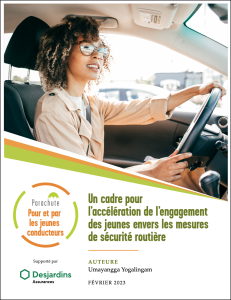
Le rapport-cadre présente un examen approfondi du cadre Pour les jeunes conducteurs, par les jeunes conducteurs, y compris des recommandations pour les cinq domaines de la mobilisation des jeunes, soit le partenariat avec les jeunes, la communication avec les jeunes, la sensibilisation des jeunes, le renforcement des capacités des jeunes et la défense des droits des jeunes.
1,53 MB PDF/UA
-
Framework summary (interactive)
-
Framework implementation tool
-
Establishing your own youth advisory committee
-
Framework summary (for print)
-
A framework for accelerating youth engagement in road safety
-
Wildcard redirect
-
Redirect child
-
Balado Changer pour de bon, pour de meilleures routes
-
Change for Good Roads podcast
-
Good roads for all: Moving the needle on road safety (2023)
Building on findings from our Change for Good Roads initiative, this webinar explores our next steps to creating safer roads and healthier communities on the one-year anniversary of that report’s release. Moderated by Parachute’s President and CEO Pamela Fuselli, influential Canadian experts from the sectors of sustainable cities, equity, health and wellbeing and road safety will discuss how to move the needle on support for road safety through multi-sectoral collaboration in Canada.
Panelists
Dr. John C. Spence
University of Alberta
Professor
Faculty of Kinesiology, Sport, and RecreationDr. Meghan Winters
Simon Fraser University
Professor
Faculty of Health SciencesArcy Canumay
BYCS Bicycle Mayor of Waterloo -
Poison storage checklist for your apartment
-
Liste de contrôle du stockage des poisons pour votre appartement
-
Addressing Equity, Diversity and Inclusion in Injury Prevention Programs (2023)
-
The role of equity in road safety and mobility interventions
-
Le rôle de l’équité dans le cadre des interventions liées à la sécurité routière et à la mobilité
-
Trends in Canada’s drug supply, polysubstance use and unintentional drug poisonings (2023)
Unintentional drug poisonings remain one of Canada’s most devastating public health issues. Hosted by Parachute and featuring presentations from Emily Biggar, Chealsea De Moor and Doris Payer from the Canadian Centre for Substance Use and Addiction, this webinar will provide an overview of emerging trends in Canada’s unregulated drug supply, polysubstance use and harms related to unintentional drug poisonings. Implications for reducing harms to people who use drugs and practising non-stigmatizing language around substance use will be highlighted.
Panelists
Emily Biggar, MPH
Research and Policy Analyst
Canadian Centre on Substance Use and Addiction (CCSA)Chealsea De Moor, MA
Knowledge Broker
Canadian Centre on Substance Use and Addiction (CCSA)Doris Payer, PhD
Senior Knowledge Broker
Canadian Centre on Substance Use and Addiction (CCSA) -
Mobilité sécuritaire en zone urbaine – l’équité
-
Safe mobility in urban areas – Equity
-
Dépistage et évaluation du risque de chute chez les aînés : portrait des guides de pratique clinique de l’Ontario (2022)
-
Fall risk screening and assessment in older adults: an overview of clinical practice guidelines (CPGs) in Ontario (2022)
-
Conversation communautaire : vieillir chez soi avec du soutien et des services (sommaire des discussions tenues le 23 novembre 2022)
Sommaire des discussions tenues le 23 novembre 2022 dans le cadre des « conversations communautaires : vieillir chez soi avec du soutien et des services »
69,41 KB Word
-
Conversation communautaire : commencer et continuer à bouger (sommaire des discussions tenues le 19 octobre 2022)
Sommaire des discussions tenues le 19 octobre 2022 dans le cadre des « conversations communautaires : commencer et continuer à bouger »
55,32 KB Word
-
Discussion Summary for Community Conversation: Supports and services to age in place (2022-11-23)
Summary of discussions held on Nov 23, 2022 as part of the “Community Conversations: Supports and services to age in place” event
82,59 KB Word
-
Information Package for Community Conversation: Supports and services to age in place (2022-11-23)
This package was distributed to all registrants and includes:
- A brief overview on what it means to age in place and how to plan ahead.
- Several resources, including national resources for seniors, seniors and caregivers’ information telephone lines by province and a list of existing programs and services through the federal, provincial, and territorial Canadian government.
78,84 KB Word
-
Recording of Community Conversations: Supports and services to age in place (2022-11-23)
This is the third event in the Community Conversation series and focuses on maintaining independence through community supports and services. Together, we’ll discuss the supports and services you feel you need to age in place and how to proactively plan for the future.
These Community Conversations are funded by the Government of Canada’s New Horizons for Seniors Program and are co-created with seniors, for seniors. They are meant to create a virtual gathering space connecting seniors to share and address the issues that matter most to them when it comes to aging in place healthily and safely. You will have the opportunity to connect with other seniors across Canada, talk to an expert, learn about resources available to you and share your own experiences if you wish to.The event organizers (which includes seniors and representatives from organizations serving seniors) will use the discussion points generated by the series to inform groups/organizations serving seniors as well as various levels of government.
-
The brave new world of content creation: Connecting with our audiences in a saturated media environment (2022)
The average American sees up to 10,000 advertisements, brands, messages or more a day. Fortune 500 companies spend billions of dollars to get their messages heard. So, how can a non-profit with little to no budget break through and connect to their audiences, supporters and the public?
This webinar, hosted by Laurie Mosher, a Specialist in Poison Information at the Atlantic Canada Poison Centre, will feature a presentation from Mike McCormick from the Florida Poison Information Center on how organizations can be more effective in their health messaging.
Emotional content creation is the key for us to share our important healthcare messages. Sharing our story in a disciplined, disruptive and distinct manner is the key to getting above the noise. The fundamentals of producing clear, concise, clean and contextual messages are more important than the dissemination medium. This session will focus on a method of content creation to cut through the clutter.
-
Equity in Vision Zero and road safety (2022)
Six Es of traffic safety are commonly used in Vision Zero planning: Engineering, Enforcement, Evaluation, Education, Engagement and Equity. The newest E, Equity, addresses how different barriers and power imbalances can increase road hazards: for instance, lower-income neighbourhoods have poorer built environments and lack of access to transit.
Join moderator Valerie Smith, Director, Programs at Parachute, in conversation with panelists from York University, The Centre for Active Transportation, and WATT Consulting Group` to learn more about applying an equity lens to Vision Zero and road safety planning.
Panelists
Jennie Geleff
Project Manager,
The Centre for Active TransportationEmily McCullogh, Postdoctoral Fellow, School of Kinesiology and Health Science, York University
Shabnem Afzal
Road Safety and Regional Lead
WATT Consulting Group
(previously Vision Zero leader, City of Surrey) -
Recognition and awards
-
Récompenses et prix
-
Three crossing guards from Ontario and Quebec named Canada’s favourites for 2022
-
Trois brigadiers de l’Ontario et du Québec nommés favoris du Canada pour 2022
-
The Vision Zero Handbook
-
Reflections on the Canadian Injury Prevention Conference
-
Réflexions sur la Conférence canadienne de prévention des blessures
-
Conversation communautaire : Chez soi (sommaire des discussions tenues le 21 septembre 2022)
Sommaire des discussions tenues le 21 septembre 2022 dans le cadre des « conversations communautaires : chez soi »
69,81 KB Word
-
Discussion Summary for Community Conversation: Getting and Staying Active (2022-10-19)
Summary of discussions held on Oct 19, 2022 as part of the « Community Conversations: Getting and Staying Active » event
70,25 KB Word
-
Discussion Summary for Community Conversation: Home (2022-09-21)
Summary of discussions held on Sept 21, 2022 as part of the « Community Conversations: Home » event
81,43 KB Word
-
Information Package for Community Conversation: Getting and Staying Active (2022-10-19)
This package was distributed to all registrants and includes:
- Information on physical activity to maintain and enhance independence and well-being – what that is, why we should do it and how to go about it.
- Additional resources that include more information on staying active, as well as programs, services, education, and activity videos for seniors.
119,47 KB Word
-
Information Package for Community Conversation: Home (2022-09-21)
This package was distributed to all registrants and includes:
- Grant and funding information for home modifications, organized by province.
- Online information and resources related to home modifications.
- Information about tenants’ rights related to home modifications in Canada.
201,83 KB Word
-
Adam Michael Segal
-
Adam Michael Segal
-
Recording of Community Conversations: Getting and Staying Physically Active (2022-10-19)
This is the second event in the Community Conversation series and focuses on maintaining and enhancing well-being and independence through physical daily activities. Together, we’ll discuss getting and staying physically active and other considerations to ensure you are able to realize the health benefits of active living.
These Community Conversations are funded by the Government of Canada’s New Horizons for Seniors Program and are co-created with seniors, for seniors. They are meant to create a virtual gathering space connecting seniors to share and address the issues that matter most to them when it comes to aging in place healthily and safely. You will have the opportunity to connect with other seniors across Canada, talk to an expert, learn about resources available to you and share your own experiences if you wish to.
The event organizers (which includes seniors and representatives from organizations serving seniors) will use the discussion points generated by the series to inform groups/organizations serving seniors as well as various levels of government.
-
Vision Zero: The Next Generation (2022)
The next generation has spoken, and they are in favor of Vision Zero. Based on a survey done by Desjardins in 2022, 61% of survey respondents between the age of 16-34 support the adoption of a Vision Zero strategy in their region and 56% support increasing government funding for Vision Zero. Road crashes are the third-leading cause of death among young people ages 15 to 24 in Canada. Join modertator Umayangga Yogalingam as she discusses Vision Zero: The Next Generation with Priynka Patil from Parachute, Sana’ Khasawneh, Junior Project Manager at YOURS, and Arianne Khorasani, Max Novak and Emily Shibata, members from our Canadian Youth Road Safety Council. Together, we will discuss the value of engaging youth in Vision Zero action and hear the voices of youth on their experience with road safety in Canada.
-
Caleon Twins – Rail safety
-
Marc-Antoine Delage – Sécurité ferroviaire
-
Caleon Twins – Distracted driving
-
Marc-Antoine Delage – La distraction au volant
-
Tableau de la législation canadienne sur la distraction au volant
-
Distracted Driving Canadian Legislation Chart
-
Approches systémiques sûres de la distraction au volant
Ce document met en lumière la façon dont les professionnels de la sécurité routière peuvent adopter une approche systémique sûre en ce qui concerne la distraction au volant.
59,19 KB Word
-
Safe Systems Approaches to Distracted Driving
A document highlighting how road safety professionals can reframe their thinking to apply a safe systems approach to distracted driving.
48,61 KB Word
-
2022 National Teen Driver Safety Week focuses on risks of distracted driving
-
La Semaine nationale de la sécurité des jeunes au volant 2022 met l’accent sur les risques de la distraction au volant
-
NTDSW 2022 media advisory template
Use this media advisory template to invite the media to bring attention to your NTDSW events.
64,05 KB Word
-
Recording of Community Conversations: Home (2022-09-21)
Does your home suit your needs? Now and into the future?
This is the first in a series of Community Conversations with Canadian seniors. This first session focuses on maintaining and building independence at home, wherever that is for you. Together, we discuss home modifications and other considerations to make to ensure you are happy with where you are living now and in the future.
These Community Conversations are funded by the Government of Canada’s New Horizons for Seniors Program and are co-created for seniors, by seniors. They are meant to create a virtual gathering space connecting seniors to share and address the issues that matter most to them when it comes to aging in place healthily and safely. Participants have the opportunity to connect with other seniors from across Canada, talk to an expert, learn about resources available to them and share their own experiences.
-
Rapport annuel pancanadien 2020 des centres antipoison
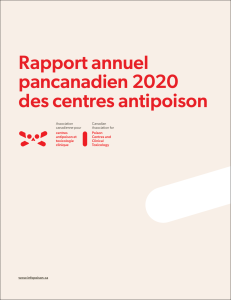
Ce rapport, produit par L’Association canadienne des centres antipoison et de toxicologie clinique (ACCAP), Santé Canada et Parachute, présente les données les plus récentes (2020) des cinq centres antipoison du Canada. Le rapport donne un aperçu du nombre de cas gérés par les centres antipoison au Canada et de leur nature, et souligne le rôle de ces centres dans les efforts de prévention des empoisonnements.
-
Pan-Canadian Poison Centres 2020 Annual Report
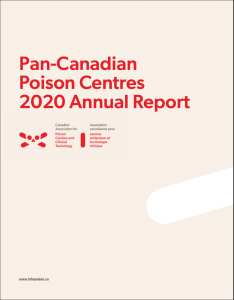
This report, produced by the Canadian Association of Poison Centres and Clinical Toxicologists, Health Canada and Parachute, presents the most current data (2020) from all five of Canada’s poison centres. The report provides an overview of the number and nature of cases managed by posion centres across Canada and highlights the role of these centres in poison prevention efforts.
-
Vehicle-for-Hire Driver Training Mis à jour
-
Formation « Vehicle-for-Hire » Mis à jour
-
New Poison Centres report reveals pain-relief medications, cleaning products top causes of reported poison exposures
-
Un nouveau rapport des centres antipoison révèle que les médicaments contre la douleur et les produits d’entretien ménager sont les principales causes d’exposition aux poisons
-
Outil de données sur les inégalités en santé à l’échelle du Canada
Cet outil contient des données sur des indicateurs se rapportant aux résultats pour la santé et aux déterminants de santé, stratifiés pour une gamme de caractéristiques sociales et économiques significatives pour les équités en santé. La source des données est l’enquête sur la santé dans les collectivités canadiennes.
-
Pan-Canadian Health Inequalities Data Tool
This tool contains data on indicators of health outcomes and health determinants, stratified by a range of social and economic characteristics meaningful to health equity. Data are from the Canadian Community Health Survey.
-
Linges directices évolutives pour le diagnostic et la gestions des commotions cérébrales in pédiatrie
-
The role of technology and data in Vision Zero interventions
Join moderator Valerie Smith, Director, Programs at Parachute, in conversation with panelists from Liveable Cities, the City of Brantford, Ontario, and the City of Bellevue, Washington, as we discuss the role of technology and data in Vision Zero and road safety strategies. This webinar will be of interest to municipal city planners, road safety professionals and road safety researchers.
In this webinar, you’ll hear from David Ferguson, Manager of Traffic Services at the City of Brantford, who will speak to his experience of integrating technology into Vision Zero road safety work. Ferguson supports the use of technology to assist practitioners in improving road safety for all road users. His previous role was Superintendent of Traffic Engineering with the City of Hamilton.
Ken Cartmill, Executive Vice President of Product Development from Livable Cities will then present on their technology solution that collects data on road activities, vehicle speed, traffic analytics, air quality, ambient noise and more. He will speak to how this data can be used for evidence-based decision-making to deploy targeted enforcement, traffic calming measures or other urban and mobility planning applications.
Franz Loewenherz, Mobility Planning and Solutions Manager, City of Bellevue, Washington, will speak to his experience in integrating technology and data into Vision Zero and road safety strategies. He will share his work in the City of Bellevue, as well as speak more generally about the important role of technology and data in Vision Zero and road safety interventions.
-
Cycling in Canada: Pedalling toward sustainable climate action and Vision Zero
Parachute and moderator Dr. Linda Rothman, Assistant Professor, School of Occupational and Public Health, Ryerson University, in conversation with panellists from Velo Canada Bikes and Ecology Action Centre.
In this webinar, you’ll hear from Brian Pincott, Executive Director, Velo Canada Bikes, about the new National Active Transportation Strategy and the need for safe and accessible cycling as a transportation option. Pincott will also discuss cycling in the context of new Global Plan for the Decade of Action for Road Safety 2021-2030, and Vision Zero.
Anika Riopel, Sustainable Transportation Co-ordinator, Ecology Action Centre, will talk about cycling and the role it plays in creating sustainable cities and addressing climate change. Riopel will also share information about their projects to make cycling and sustainable transportation decisions easy. The webinar will include a facilitated Q&A session.
PANEL
Brian Pincott
Executive Director
Velo Canada BikesAnika Riopel
Sustainable Transportation Co-ordinator
Ecology Action CentreSponsored by Desjardins
-
Maltraité et blessé au cerveau : une boîte à outils
Cette boîte à outils fournit des informations pour éduquer sur l’impact des blessures au cerveau chez les femmes survivantes de violence entre partenaires intimes, aider à identifier les survivantes avec une éventuelle blessure au cerveau et aider les prestataires de services à soutenir les survivantes avec les blessures au cerveau.
-
Abused & Brain Injured Toolkit
This toolkit provides information to educate about the impact of brain injury in women survivors of intimate partner violence, help identify survivors with possible brain injury, and help service providers support survivors with TBI.
-
Lignes directrices évolutives pour le diagnostic et la gestion des commotions cérébrales en pédiatrie
-
Online Concussion Course – University of Calgary, MOOC
This massive open online course (MOOC) demystifies concussion and explains how everyone can play a role in the prevention, identification, and management of this type of traumatic brain injury. The course also describes the revision and implementation of a concussion management protocol adapted to different environments.
-
The role of technology and data in road safety and Vision Zero interventions
-
Le rôle de la technologie et des données dans les interventions en faveur de la sécurité routière et de Vision Zéro
-
Does your local crossing guard go beyond the call of duty? Nominate them today to be Canada’s Favourite Crossing Guard!
-
Est-ce que votre brigadier local brille au-delà des responsabilités de son poste? Sélectionnez-le dès aujourd’hui pour recevoir le prix de Brigadier favori du Canada!
-
André Laperrière
-
André Laperrière
-
Iza Parker
-
Iza Parker
-
Cellulaire
-
Phone
-
Alcool
-
Alcohol
-
Cannabis
-
Cannabis
-
Manger/boire
-
Food
-
Vitesse
-
Speeding
-
Maquillage
-
Makeup
-
Train
-
Train
-
Guide du concours sur les contraventions positives (2022)
-
Messages-clés (2022)
-
Positive ticketing activity guide (2022)
-
Key messages (2022)
-
Association canadienne des centres antipoison et de toxicologie Clinique
L’Association canadienne des centres antipoison fournit les coordonnées des centres antipoison provinciaux ainsi que des ressources au sujet de la prévention des empoisonnements.
-
2022-2024 Plan d’action Vision Zéro décès et blessé grave (Montreal)
-
Road Safety: City of Guelph Transportation Master Plan
-
The 2020-2024 Road Safety Action Plan (Ottawa)
-
Vision Zero Action Plan (Mississauga)
-
Vision Zero: The City of Brantford’s Road Safety Plan (2021-2026)
-
The role of technology and data in Vision Zero interventions (2022)
Join moderator Valerie Smith, Director, Programs at Parachute, in conversation with panelists from Liveable Cities, the City of Brantford, Ontario, and the City of Bellevue, Washington, as we discuss the role of technology and data in Vision Zero and road safety strategies. This webinar will be of interest to municipal city planners, road safety professionals and road safety researchers.
In this webinar, you’ll hear from David Ferguson, Manager of Traffic Services at the City of Brantford, who will speak to his experience of integrating technology into Vision Zero road safety work. Ferguson supports the use of technology to assist practitioners in improving road safety for all road users. His previous role was Superintendent of Traffic Engineering with the City of Hamilton.
Ken Cartmill, Executive Vice President of Product Development from Livable Cities will then present on their technology solution that collects data on road activities, vehicle speed, traffic analytics, air quality, ambient noise and more. He will speak to how this data can be used for evidence-based decision-making to deploy targeted enforcement, traffic calming measures or other urban and mobility planning applications.
Franz Loewenherz, Mobility Planning and Solutions Manager, City of Bellevue, Washington, will speak to his experience in integrating technology and data into Vision Zero and road safety strategies. He will share his work in the City of Bellevue, as well as speak more generally about the important role of technology and data in Vision Zero and road safety interventions.
-
NTDSW proclamation request template 2022
-
NTDSW 2022 – Social media images
Social media images for use with NTDSW 2022.
2,57 MB ZIP
-
Balado « Popping the Bubble Wrap » – Protéger sans suprotéger votre enfant
-
Popping the Bubble Wrap podcast
-
St. John’s, NL
-
Saint John, NB
-
Saanich, BC
-
Regina, SK
-
Kamloops, BC
-
Kamloops, BC
-
Niagara Region, ON
-
Guelph, ON
-
Mississauga, ON
-
Camping basics
This Parks Canada website provides helpful tips, videos and resources on camping safety including a packing checklist, how to start a campfire and safety around wildlife.
-
Les essentiels pour le camping
Le site Web de Parcs Canada fournit des conseils utiles, des vidéos et des ressources sur la sécurité en camping, y compris une liste de vérification, comment allumer un feu et la sécurité à proximité de la faune.
-
Canada’s Lower-Risk Cannabis Use Guidelines
Canada’s Lower-Risk Cannabis Use Guidelines provide 10 science-based recommendations to enable people to reduce their health risks associated with cannabis use.
-
Reduce your risk: choose legal cannabis
This infographic from Health Canada provides tips for identifying legal cannabis products.
-
Réduisez vos risques : choisissez le cannabis légal
Cette infographie de Santé Canada fournit des conseils pour identifier le les produits de cannabis légaux.
-
Facteurs qui impactent le comportement de conduite des jeunes conducteurs et pratiques prometteuses pour l’engagement des jeunes conducteurs (2022)
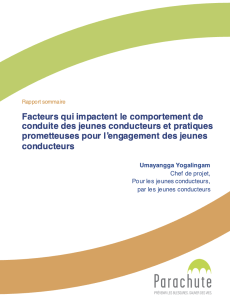
Le présent rapport résume les constatations découlant d’une revue de la littérature et d’une analyse du contexte vis-à-vis des points suivants : les facteurs qui influencent le comportement de conduite des jeunes; l’engagement des jeunes et les stratégies de partenariat pour les programmes de promotion de la santé et de prévention des blessures; et les outils et plateformes utilisés pour engager les jeunes dans les programmes de promotion de la santé et de prévention des blessures.
163,58 KB Word
-
Factors that impact driving behaviour in young drivers and promising practices for young driver engagement (2022)
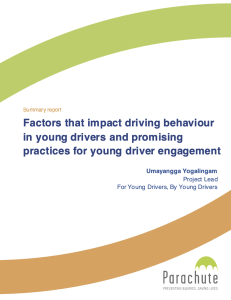
This report summarizes findings from a literature review and environmental scan on: factors that impact driving behaviour in young people; youth engagement and partnership strategies in health promotion and injury prevention programming; and tools and platforms used to engage young people in health promotion and injury prevention programming.
145,69 KB Word
-
Report a health and safety concern – Health Canada
-
Report a health and safety concern – Health Canada
Report side effects, injuries, and other product-related health and safety concerns to the Government of Canada.
-
Submit questions or concerns about cannabis
The Government of Canada provides contact information for questions and concerns about a cannabis site, product, service, accessory, promotion, or other aspects of laws and regulations regarding cannabis.
-
Soumettre des questions ou des préoccupations relatives au cannabis
Le gouvernement du Canada fournit les coordonnées pour les questions ou préoccupations relativement à un site de cannabis, un produit, un service, un accessoire, une publicité ou tout autre aspect des lois et règlements fédéraux concernant le cannabis.
-
Signaler un problème lié à la santé ou à la sécurité – Santé Canada
Déclarez les effets secondaires, les blessures et autres problèmes de santé et de sécurité liés aux produits au gouvernement du Canada.
-
Polysubstance use poisoning deaths in Canada: an analysis of trends from 2014 to 2017 using mortality data
This study published in BMC Public Health examines changes over time in crude mortality rates and proportions of poisoning deaths involving more than one substance.
-
Data, reports and research
-
Incident reporting, advisories and recalls
-
Poison centres and organizations
-
Training, guidelines and webinars
-
Données, rapports et recherche
-
Signalisation des incidents, avertissements et rappels
-
Centres et organisations antipoison
-
Formations, lignes directrices et webinaires
-
Poison prevention collection
Find data and reports, training and guidelines, and public awareness resources, as well as information on public policy, incident reporting, poison centres and other organizations.
-
For Seniors, By Seniors: Community Conversations
-
Pour les aînés, par les aînés : conversations communautaires
-
Institute for Safe Medication Practices Canada
The Institute for Safe Medication Practices Canada (ISMP Canada) is an independent national not-for-profit organization committed to the advancement of medication safety in all healthcare settings.
-
L’Institut pour la sécurité des médicaments aux patients du Canada
L’Institut pour la sécurité des médicaments aux patients du Canada (ISMP Canada) est un organisme canadien indépendant à but non lucratif. L’institut recueille et analyse les déclarations d’incidents liés à l’utilisation des médicaments et développe des recommandations pour améliorer la sécurité des patients.
-
Canadian Centre on Substance Use and Addiction
CCSA is a non-governmental organization providing national leadership on substance use and advancing solutions to address alcohol- and other drug-related harms.
-
Centre canadien sur les dépendances et l’usage des substances
Le CCLAT est une organisation non gouvernementale qui assure un leadership national en matière de consommation de substances et propose des solutions pour lutter contre les méfaits liés à l’alcool et aux autres drogues.
-
Child Safety Link
Child Safety Link works with the IWK Regional Poison Centre to help educate Maritime communities about poisoning prevention. The CSL website has information, resources and videos about preventing poisoning in children.
-
Child Safety Link
Child Safety Link est un programme de prévention des blessures au Centre de santé IWK qui vise à réduire l’incidence et la gravité des blessures non intentionnelles subies par les enfants et les jeunes dans les provinces maritimes canadiennes.
-
Saskatchewan Prevention Institute (SPI)
The Saskatchewan Prevention Institute has information and resources on preventing poisoning in children.
-
Injury Prevention Centre (IPC)
The Injury Prevention Centre website has resources and toolkits about poisoning related to cannabis, medications, and household products.
-
BC Injury Research and Prevention Unit (BCIRPU)
The BC Injury Research and Prevention Unit website has data and research on poisoning for all age groups.
-
Atlantic Canada Poison Centre, Nova Scotia
The Atlantic Canada Poison Centre provides a 24-hour, phone consultation service to both the public and health professionals in Newfoundland and Labrador, Nova Scotia and Prince Edward Island. They provide consult services for health care professionals in New Brunswick concerning the management of poisoned patients.
-
BC Drug and Poison Information Centre (DPIC)
The BC Drug and Poison Information Centre operates a 24-hour poison information line, as well as a drug information line for BC healthcare professionals. The BC DPIC website provides information and resources on poisoning and prevention, and serves B.C. and Yukon.
-
Sentinel Surveillance of Substance-Related Poisonings in Canada: Spotlight on Cannabis
This surveillance summary presents statistics from April 2011 onward on poisonings from select substances including cannabis, alcohol, methamphetamine, opioids and e-cigarette/vaping products.
-
Surveillance sentinelle des intoxications liées à la consommation de substances au Canada : Pleins feux sur le cannabis
Ce résumé de la surveillance présente des statistiques à partir d’avril 2011 sur les empoisonnements à certaines substances, notamment le cannabis, l’alcool, la méthamphétamine, les opioïdes et les cigarettes électroniques/produits de vapotage.
-
Increases in exposure calls related to selected cleaners and disinfectants at the onset of the COVID-19 pandemic: data from Canadian poison centres
This study published in Health Promotion and Chronic Disease Prevention in Canada presents results from poison centre data related to cleaning products for the years 2019-2020.
-
Augmentation du nombre d’appels relatifs à une exposition à certains nettoyants et désinfectants au début de la pandémie de COVID-19 : données des centres antipoison canadiens
Cette étude publiée dans Promotion de la santé et prévention des maladies chroniques au Canada présente les résultats des données des centres antipoison liés aux produits de nettoyage pour les années 2019-2020.
-
Opioid and Stimulant-related Harms in Canada – PHAC
This update presents available data on overdoses and deaths involving opioids and/or stimulants from January 2016 to March 2024.
-
Méfaits associés aux opioïdes et aux stimulants au Canada – ASPC
Cette mise à jour présente les données disponibles sur les surdoses et les décès impliquant des opioïdes et/ou des stimulants de janvier 2016 à juin 2024.
-
BC Road Safety Strategy 2025
-
Guidelines for establishing a poison centre
This 174-page publication by the World Health Organization provides information on the services that may be offered by a poison centre as well as detailed practical guidance on planning and operations.
-
Lignes directrices pour la création d’un centre antipoison – OMS
Cette publication donne ensuite un aperçu des services que peut proposer un centre antipoison et les considérations à prendre en compte dans la planification d’un centre antipoison.
-
Report a medication incident – ISMP Canada
The Institute for Safe Medication Practices Canada provides links to confidential reporting systems for health professionals, pharmacies, healthcare facilities, coroners and medical examiners, and the general public.
-
Déclarer un incident lié à la médication – ISMP Canada
Accédez à un formulaire confidentiel de déclaration d’incident lié à la médication pour les professionnels de la santé sur le site web de l’Institut pour la sécurité des médicaments aux patients du Canada.
-
Recalls and safety alerts – Health Canada
This Government of Canada website allows you to browse or search product recalls, advisories and alerts.
-
Rappels et avis de sécurité – Santé Canada
Le site Web du gouvernement du Canada vous permet de parcourir ou de rechercher des rappels, des avis et des avis de securité liés aux produits.
-
Circumstances surrounding unintentional fire-related deaths, 2011 to 2020
This report from Statistics Canada describes the factors in unintentional fire-related deaths from 2011 to 2019, with the intent to inform preventative measures.
-
Les circonstances entourant les décès non intentionnels liés à un incendie, 2011 à 2020
Ce rapport de Statistique Canada décrit les circonstances entourant les décès non intentionnels liés à un incendie de 2011 à 2020, dans le but de mettre en avant les mesures préventives.
-
Recreational Boating-Related Fatalities in Canada, 2008-2017
This report describes the epidemiology of fatal recreational boating- related incidents in Canada during 2008–2017, drawn from the Drowning Prevention Research Centre (DPRC) database.
-
Décès associés à la navigation de plaisance au Canada de 2008 à 2017
Ce rapport dresse le portrait épidémiologique des incidents mortels associés à la navigation de plaisance survenus au Canada de 2008 à 2017. Il a été élaboré à partir de la base de données du Centre canadien de recherche sur la prévention de la noyade (CCRPN).
-
Cost of Injury in Canada 2021
-
Le coût des blessures au Canada 2021
-
Cinq questions à poser à propos de vos médicaments
ISMP Canada, l’Institut canadien pour la sécurité des patients, Patients pour la sécurité des patients du Canada, l’Association des pharmaciens du Canada et la Société canadienne des pharmaciens d’hôpitaux ont travaillé à élaborer une série de cinq questions visant à aider les patients et les soignants à discuter des médicaments, afin d’améliorer les communications avec le personnel soignant.
-
Five questions to ask about your medications
ISMP Canada, the Canadian Patient Safety Institute, Patients for Patient Safety Canada, the Canadian Pharmacists Association and the Canadian Society for Hospital Pharmacists have collaborated to develop a set of 5 questions to help patients and caregivers start a conversation about medications to improve communications with their health care provider.
-
Politique de prévention des empoisonnements
Examiner la question des empoisonnements involontaires, le risque particulier pour les enfants et les solutions pour prévenir les empoisonnements.
-
Poison prevention policy
Examine the issue of unintentional poisonings, the particular risk to children, and solutions to prevent poisonings
-
Carbon monoxide alarm legislation
-
Législation sur les détecteurs de monoxyde de carbone
-
2021 Annual Report
-
2021 Annual Report
-
Cycling in Canada: Pedalling toward sustainable climate action and Vision Zero (2022)
Parachute and moderator Dr. Linda Rothman, Assistant Professor, School of Occupational and Public Health, Ryerson University, in conversation with panellists from Velo Canada Bikes and Ecology Action Centre.
In this webinar, you’ll hear from Brian Pincott, Executive Director, Velo Canada Bikes, about the new National Active Transportation Strategy and the need for safe and accessible cycling as a transportation option. Pincott will also discuss cycling in the context of new Global Plan for the Decade of Action for Road Safety 2021-2030, and Vision Zero.
Anika Riopel, Sustainable Transportation Co-ordinator, Ecology Action Centre, will talk about cycling and the role it plays in creating sustainable cities and addressing climate change. Riopel will also share information about their projects to make cycling and sustainable transportation decisions easy. The webinar will include a facilitated Q&A session.
PANEL
Brian Pincott
Executive Director
Velo Canada BikesAnika Riopel
Sustainable Transportation Co-ordinator
Ecology Action CentreSponsored by Desjardins
-
TVO’s The Agenda with Steve Paikin panel discussion on distracted driving
-
Cost of Injury in Atlantic Canada
-
Le coût des blessures dans la région de l’Atlantique au Canada
-
Cost of Injury in British Columbia
-
Vision Zero Canadian Landscape 3.0 (2022)
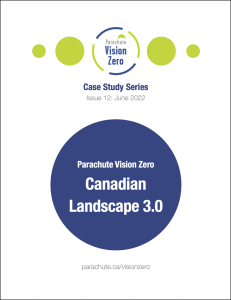
In 2019, Parachute published the Canadian Landscape 2.0, which profiled 24 jurisdictions. This included reviewing the current status of all jurisdictions in the process of considering, adopting or implementing Vision Zero; presenting the key features of their programs, using a consistent framework of the five (now six as of 2022) Es of traffic safety (further described in Section 1); and discussing the successes and challenges faced by these programs with key stakeholders, as well as any advice they have for jurisdictions contemplating formal adoption.
This issue of the Vision Zero Canadian Landscape (3.0) revisits these jurisdictions and profiles new areas that have adopted or are adopting Vision Zero. This focus is responsive to earlier feedback from our Parachute Vision Zero Network stakeholders, who had requested a better understanding of how to approach Vision Zero, and the facilitators and barriers to embracing a systems approach to increase road safety and end road fatalities and serious injuries.
969,22 KB PDF/UA
-
NIPD2022 social media images
-
Join Parachute’s National Injury Prevention Day on July 5
-
Prenez part à la Journée Nationale de la Prévention des Blessures de Parachute le 5 juillet
-
Why injury prevention is a key part of health care (2022)
Parachute’s President and CEO Pamela Fuselli interviews healthcare leaders about the role hospitals could and should play in injury prevention. At present, public health organizations are responsible for delivering injury prevention programs, while hospitals and trauma centres respond by providing medical care when injury happens. Traditionally, these systems have not worked collaboratively on a system level. Trauma centres may include injury prevention in their work, but how much and how well is not tracked or measured. In many cases, community agencies, public health units and trauma centres are effectively working with the same population but without connection, strategy, or goals. This space is messy, expensive, and ineffective. How can we do better together? How do we create a seamless or co-ordinated approach to injury prevention?
MODERATOR
Pamela Fuselli, President and CEO, ParachutePANELISTS
Ru Taggar
Executive Vice President, Chief Nursing and Health Professions Executive, Sunnybrook Health Sciences CentreMegan Oakey
Provincial Manager Injury Prevention, BC Provincial Health Services AuthorityDr. David Evans
Medical Director, Research and Analytics Unit, Trauma Services B.C.Richard Louis
Injury Prevention Specialist, NB Trauma Program -
CIPD2026 – Hospital poster 2
-
CIPD2026 – Hospital poster 1
-
Encouraging active transportation for children (2022)
Active transportation – such as waking, biking and wheeling – are sustainable forms of mobility that not only gets us to where we want to go, but also improve our physical and mental wellbeing.
Join moderator Pamela Fuselli, President & CEO of Parachute, as we discuss how to create and sustain active spaces for children to get to and from school and move though their communities safely.
-
An Integrated Approach to Preventing Fall-Related Injuries among Older Adults in Ontario
-
National Injury Prevention Day 2022 Social Media Guide
-
Guide des médias sociaux – Journée Nationale de la Prévention des Blessures 2022
-
Pre-season concussion education sheet
-
MTO Sécurité à vélo
Vidéo du ministère des Transports de l’Ontario.
-
MTO Cycling Safety
A video from the Ontario Ministry of Transportation.
-
MTO Les Automobilistes et Les Appareils de Micromobilité
Vidéo du ministère des Transports de l’Ontario.
-
Motorists and Micromobility Devices
Video from the Ontario Ministry of Transportation
-
P.E.I. teen Mairi Brydon wins the final Stacey Levitt Memorial Award
-
Mairi Brydon, une adolescente de l’île-du-Prince-Édouard remporte le prix commémoratif Stacey Levitt
-
Cycling in Canada: Pedalling toward sustainable climate action and Vision Zero (2022)
Parachute and moderator Dr. Linda Rothman, Assistant Professor, School of Occupational and Public Health, Ryerson University, in conversation with panellists from Velo Canada Bikes and Ecology Action Centre.
In this webinar, you’ll hear from Brian Pincott, Executive Director, Velo Canada Bikes, about the new National Active Transportation Strategy and the need for safe and accessible cycling as a transportation option. Pincott will also discuss cycling in the context of new Global Plan for the Decade of Action for Road Safety 2021-2030, and Vision Zero.
Anika Riopel, Sustainable Transportation Co-ordinator, Ecology Action Centre, will talk about cycling and the role it plays in creating sustainable cities and addressing climate change. Riopel will also share information about their projects to make cycling and sustainable transportation decisions easy. The webinar will include a facilitated Q&A session.
PANEL
Brian Pincott
Executive Director
Velo Canada BikesAnika Riopel
Sustainable Transportation Co-ordinator
Ecology Action CentreSponsored by Desjardins
-
Le Conseil canadien des jeunes pour la sécurité routière
-
Canadian Youth Road Safety Council
-
Taking Action: The Global Plan for the New Decade of Action for Road Safety 2021-2030 (2022)
This free webinar provides an overview of the Global Plan for the Decade of Action for Road Safety, 2021-2030, shares the regional call to action for Canada and discusses next steps. We also share information about the upcoming #CommitToAct 2022 campaign, running from May 16 to 20, and discuss the role NGOs, local government and other stakeholders can play to encourage their government leaders to make specific, meaningful commitments to reduce road traffic deaths and injuries.
-
SSJ2022-Images des réseaux sociaux
-
An interview with Jessie Singer, author of There Are No Accidents (2022)
Jessie Singer’s best friend died 15 years ago when he was 22, cycling in New York, and a driver hit and killed him. Singer, a journalist, also became a road safety advocate. Her quest to find out why society often doesn’t take effective action to prevent injury deaths has resulted in the landmark book, There Are No Accidents, published in February 2022. She spoke with Parachute’s President and CEO Pamela Fuselli about the book, which examines who is harmed most by injury in American society. Singer meticulously reviews data and interviews experts. « Accidents are not flukes or freak mishaps – whether or not you die by accident is just a measure of your power, or lack of it. »
Jessie Singer is a journalist whose writing appears in BuzzFeed, the Village Voice, The Awl, New York magazine, The Guardian, and elsewhere. She currently serves as Senior Strategist and Head Writer at Transportation Alternatives, the editor in chief of Reclaim Magazine, and the founding editor of the international Vision Zero Cities Journal. -
An Environmental Scan of Older Adult Fall Prevention Indicators (2020)
-
Screening and Assessment Tools for Falls in Older Adults in Ontario (2020)
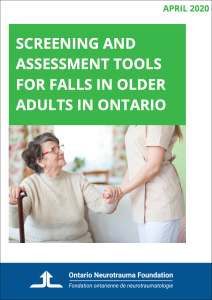
The Ontario Fall Prevention Collaborative (OFPC), Knowledge Resource Working Group has developed a draft document to help health systems partners and professionals in locating the right screening or assessment tools for fall prevention for older adults in Ontario. The purpose of this document is to provide a first version of what currently exists as screening or assessment tools for falls in older adults within Ontario. However, further work needs to be done around recommendations from the Ontario Fall Prevention Collaborative on fall prevention screening and assessment tools with high impact for the intended target population, broken down by sector. Further engagement with various provincial and national stakeholders is underway, and an updated phase 2 version of this resource document will be shared upon that time.
1,19 MB PDF/UA
-
« How to encourage kids to #Play
Safe Outdoors » – Safe Kids Week (2021) The topic of 2021’s Safe Kids Week digital campaign is outdoor play, encouraging children to #PlaySafeOutdoors and engage in active, unstructured and exciting play, daily.
Learn more at www.parachute.ca/safekidsweek #PlaySafeOutdoors -
The Global Plan for the New Decade of Action for Road Safety 2021-2030: What You Need to Know (2022)
The Decade of Action for Road Safety 2021-2030 has been proclaimed by a UN General Assembly Resolution with a target to reduce road traffic deaths and injuries by 50 per cent by 2030, recognizing the gravity of this global issue.
The Decade of Action is underpinned by the Global Plan, launched Oct. 28, 2021, which aims to inspire and guide national and local government, as well other stakeholders who can influence road safety. Those include civil society, academia, the private sector, donors, community and youth leaders, and other stakeholders as they develop supporting national and local action plans and targets. Through advocating for the Safe Systems Approach and providing recommendations based on best practices and research, the plan is an important resource both within Canada and abroad.
The webinar will provide an overview of the Global Plan, including three parts of road safety action: what to do, how to do it and who does it. Panelists will also discuss how road safety needs to be integrated into other policy agendas such as climate action and equity, to increase its reach and influence. The webinar will also refer to Canada’s Road Safety Strategy 2025.
MODERATOR
Brenda Suggett, Executive Director, CARSPPANELISTS
Raheem Dilgir, President, CARSP
Valerie Smith, Director, Programs, Parachute -
Cannabis & edibles poison prevention: Exploring parent attitudes and behaviours (2022)
Since the legalization and regulation of cannabis in 2018 and edible cannabis products in 2019, unintentional cannabis exposures in young children have increased. This webinar, hosted by Parachute, will explore key data findings from a 2021 survey of parents/caregivers regarding their cannabis use, storage habits and perceptions of unintentional cannabis exposure risk for young children.
The webinar will also provide an in-depth look at child cannabis poisoning trends and key issues, poison centre information and data from across Canada and recommended actions for cannabis poison prevention, as well as priorities for cannabis poison surveillance and prevention.
SPEAKERS
Stephanie Cowle
Director of Knowledge Translation, ParachuteMargaret Thompson
Medical Director, Ontario Poison CentreJacqueline Burke
Certified Specialist in Poison Information
Ontario Poison CentreAndrea Taylor
Acting Senior Policy Analyst, Health Canada -
Exploring illegal cannabis packaging, products and sellers (2022)
The legalization of cannabis in 2018 and cannabis edibles in 2019 was accompanied by regulation on cannabis production, distribution and packaging. However, illicit cannabis products continue to make their way into the Canadian market and consumers’ homes. Illegal cannabis products are often packaged to look like popular brands of candies, snacks or other food products or have more than the allowable limit of THC per package. These products pose a risk to Canadians, particularly young children who may mistakenly consume them.
This webinar, hosted by Parachute, will review the legal requirements for cannabis products, packaging and sellers in Canada and explore the impact of illegal products. Featuring presentations from the RCMP and IWK Poison Centre, the webinar will provide an in-depth look at the history and rationale of packaging requirements as well as the response of poison centres to illegal cannabis products.
-
Notable poisoning trends: what you need to know (2022)
This webinar covered three notable trends in poisoning: medication-related poisonings; youth self-harm poisoning hospitalizations; and essential oils-related poisonings and complaints.
-
Guide événementiel Journée Tout sauf une voiture (TSUV) : Semaine Sécuri
Jeunes de Parachute 2022 -
Conseils de sécurité pour un transport actif et sûr : Semaine Sécuri
Jeunes de Parachute 2022 -
Fiche d’information : Semaine Sécuri
Jeunes de Parachute 2022 -
Social media images – Safe Kids Week 2022
-
Event Guide: Anything But a Car Day (ABCD) – Safe Kids Week 2022
-
Tip Sheet – Safe Kids Week 2022
-
Backgrounder – Safe Kids Week 2022
-
Redirect Test
-
“The heroes of life’s journey”
-
Formulaire de projects de sécurité des usagers vulnérables de la route
-
VRU submission form
-
Snowmobile fatalities in Canda, 2013 to 2019
-
CIPD Hospital Challenge Mis à jour
-
Lock-up and put-away video No. 4
-
Verrouiller et ranger – Vidéo 4
-
Lock-up and put-away video No. 3
-
Verrouiller et ranger – Vidéo 3
-
Lock-up and put-away video No. 2
-
Verrouiller et ranger – Vidéo 2
-
Lock-up and put-away video No. 1
-
Verrouiller et ranger – Vidéo 1
-
Safety around the house
The Government of Canada provides tips on how to identify safety hazards and prevent injuries.
-
Sécurité à domicile
Le gouvernement du Canada fournit des conseils pour identifier les risques pour la sécurité et prévenir les blessures.
-
Collective action key to creating change that will lead to better, safer roads for all
-
L’action collective est essentielle pour créer un changement menant à des routes meilleures et plus sûres pour tous
-
Change for Good Roads – An intersectoral approach to urban road safety (2022)
-
Changer pour de bon, pour de meilleures routes – Une approche intersectorielle de la sécurité routière urbaine
-
Nos services de consultant
-
Our consulting services
-
#Share
Safe Roads « They Have a Lot of Passion » video – 12 seconds -
« Ils ont beaucoup de passion » #Partager
Des Routes Sûres – vidéo 12 secondes -
« Discussion productive » #Partager
Des Routes Sûres – vidéo 12 secondes -
#Share
Safe Roads « Active Listening » video – 12 seconds -
« Une bonne séance » #Partager
Des Routes Sûres – vidéo 12 secondes -
#Share
Safe Roads « Good Session » video – 12 seconds -
Thérapie de groupe #Partager
Des Routes Sûres – 30 secondes -
#Share
Safe Roads Road Counselling – 30 seconds -
« Un peu d’empathie » #Partager
Des Routes Sûres – vidéo 12 secondes -
#Share
Safe Roads « Course Correct » video – 12 seconds -
#Share
Safe Roads « They have a lot of passion » video -
#Share
Safe Roads « Active Listening » video -
#Share
Safe Roads « Good Session » video -
Preliminary Automated Speed Enforcement evaluation data points to increased compliance and reduced speeding in first year of implementation
News Release prepared by the City of Toronto (2021)
-
Truck side guard specifications: recommended standard
Report prepared for the U.S. Department of Transportation.
John A. Volpe National Transportation Systems Center (U.S.) (2016) -
Priynka Patil
-
Priynka Patil
-
Les circonstances entourant les décès liés aux véhicules tout-terrain (VTT) au Canada, 2013 à 2019
Ce rapport de Statistique Canada décrit les circonstances entourant les décès liés aux véhicules tout-terrain dans toutes les provinces et les territoires de 2013 à 2019, dans le but de mettre en avant les mesures préventives.
-
Circumstances surrounding all-terrain vehicle (ATV) fatalities in Canada, 2013 to 2019
This report from Statistics Canada describes the factors in ATV fatalities across all provinces and territories from 2013 to 2019, with the intent to inform preventative measures.
-
Résolution des Nations Unies sur la prévention de la noyade (2021)
Cette résolution reconnaît que la noyade est un problème mondial et encourage les États Membres à adopter des actions préventives volontaires. La résolution a été approuvée par l’Assemblée générale des Nations Unies et soutenu par le Canada.
-
United Nations Resolution on Drowning Prevention (2021)
This Resolution recognizes drowning as a global issue and encourages Member States to adopt voluntary preventative actions. It was approved by the United Nations General Assembly and supported by Canada.
-
Résolution des Nations Unies sur la prévention de la noyade (2021)
Cette résolution reconnaît que la noyade est un problème mondial et encourage les États Membres à adopter des actions préventives volontaires. La résolution a été approuvée par l’Assemblée générale des Nations Unies et soutenue par le Canada.
-
Harvey Glower
-
Harvey Glower
-
Groupe de collaboration pour la prévention des chutes
Ce groupe de praticiens de la santé et des services sociaux d’Ontario se réunit pour partager de l’information, analyser les tendances et répondre collectivement au besoin de changement et d’innovation en matière de prévention des chutes.
-
Screening and Assessment Tools for Falls in Older Adults
-
Screening and Assessment Tools for Falls in Older Adults
-
An Environmental Scan of Adult Fall Prevention Indicators
-
An Environmental Scan of Adult Fall Prevention Indicators
-
Merci pour votre candidature
-
Thank you
-
Les collisions routières : changer le langage pour changer de point de vue
-
Change the language, change perceptions: how we talk about road collisions (2021)
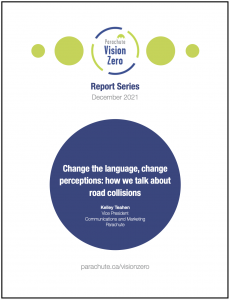
For many years, road safety advocates have argued it’s inaccurate to use the word “accident”to describe road collisions because that implies nothing could be done to prevent them. Thanks to advocacy by Parachute, the Canadian Press now has made this change to its Caps and Spelling style manual. Under the word “accident”it now reads: “avoid in reference to motor vehicles; prefer crash or collision.” A change in Canadian Press style means an enforceable change in language used in news coverage across the country.
Read the report detailing how we achieved this policy change and our plans for future advocacy.
918,98 KB PDF/UA
-
Pour les jeunes conducteurs, par les jeunes conducteurs
-
For Young Drivers, By Young Drivers
-
Ontario Fall Prevention Collaborative
This diverse group of health and social service practitioners from across Ontario come together to share information, analyze trends and respond collectively to the need for change and innovation in fall prevention.
-
Cost of injury – Falls in children infographic
-
Le coût des blessures – Infographie chutes chez les enfants
-
Cost of injury – Falls in seniors infographic
-
Coûts des blessures – Infographie chutes chez les aînés
-
Laurie Blouin on speed and road safety
-
Laurie Blouin sur la vitesse et la sécurité routière
-
Laurie Blouin on speed and rail safety
-
Laurie Blouin sur la vitesse et la sécurité ferroviaire
-
Government of Canada 2021 public advisory on dangers of button batteries
Loose button batteries and products containing button batteries should be kept out of sight and reach of children; if a suspected button battery ingestion occurs, seek immediate emergency medical attention.
-
L’Avis public 2021 du gouvernement du Canada sur les dangers des piles boutons
Les piles boutons et les produits contenant des piles boutons doivent être tenus hors de la vue et de la portée des enfants ; en cas d’ingestion suspectée d’une pile bouton, consultez immédiatement un médecin d’urgence.
-
Safe Sleep – Government of Canada
-
Sommeil sécuritaire – Gouvernement du Canada
-
Snowmobile fatalities in Canda, 2013 to 2019
-
Les décès liés à la motoneige au Canada, 2013 à 2019
-
Concussion Policy and Protocol Implementation Roles and Responsibilities Matrix Templates [word doc]
-
Modèles de matrice des rôles et responsabilités [document word]
-
Concussion Communication Tool [word doc]
-
Modèle d’outil de communication sur les commotions [document word]
-
Moderator Guide: Concussion Recognition Tool 5 (CRT5) Scenarios [word doc]
-
Scénarios de l’outil CRT5 Guide de l’animateur [document word]
-
Concussion Recognition Tool 5: Scenarios
-
Scénarios de l’outil CRT5 Guide de l’animateur
-
Changing perceptions around the importance of concussion education [word doc]
-
Changer les perceptions sur l’éducation aux commotions cérébrales [document word]
-
Changing perceptions around the importance of concussion education
-
Changer les perceptions sur l’éducation aux commotions cérébrales
-
Concussion Protocol Summary Template [word doc]
-
Modèle de résumé du protocole
-
Improving Awareness of Your Organization’s Concussion Protocol: Strategies Checklist [word doc]
-
Sensibilisation au protocole sur les commotions cérébrales de votre organisation : liste de contrôle des stratégies
-
Concussion Policy Development in Canadian Sport: A checklist for national sport organizations
Developed in collaboration with the Sport Information Resource Centre (SIRC), this resource will help you understand what components to include in a concussion policy to meet Sport Canada’s requirements.
-
Élaboration d’une politique en matière de commotions cérébrales dans le sport canadien : liste de contrôle pour les organismes nationaux de sport
Développée en collaboration avec le Centre de ressources d’information sur le sport (SIRC), cette ressource vous aidera à comprendre les éléments à inclure dans le cadre d’une politique sur les commotions cérébrales pour répondre aux exigences de Sport Canada.
-
Halving road deaths and injuries by 2030: a key commitment in Global Road Safety Plan
-
Diminuer de moitié le nombre de décès et de blessés sur les routes d’ici 2030 : un engagement clé du Plan mondial pour la sécurité routière
-
Claire Westmacott
-
Claire Westmacott
-
Odette Lachance – One mother’s fight for young driver safety
-
Odette Lachance – Le combat d’une mère pour la sécurité des jeunes au volant :
-
2021 National Teen Driver Safety Week focuses on risks of speeding
-
La Semaine nationale de la sécurité des jeunes au volant 2021 met l’accent sur les risques liés aux excès de vitesse
-
Parachute co-founder remembered
-
Why it is important to examine Vision Zero initiatives through a gender lens
-
Pourquoi il est important d’examiner les initiatives de la Vision Zéro selon une optique de genre.
-
Modèle de présentation pour un engagement envers Vision Zéro au Canada

Parachute a développé une présentation Powerpoint personnalisable que les champions locaux peuvent utiliser avec les principaux décideurs pour faire progresser Vision Zéro, qu’ils soient en phase de pré-adoption ou d’adoption.
La présentation inclut :
- Historique de Vision Zéro et de son importance
- Outils de mise en œuvre
- Étapes de la réussite d’une juridiction Vision Zéro
4,43 MB PowerPoint
-
Making a Vision Zero Commitment in Canada presentation template

Parachute has developed a customizable Powerpoint presentation for local champions to use with senior policy makers to move Vision Zero forward, whether they are in the pre-adoption or adoption stage.
The presentation includes:
- Background of Vision Zero and its importance
- Tools for implementation
- The stages of becoming a successful Vision Zero jurisdiction
4,49 MB PowerPoint
-
NTDSW poster
-
Poster SNSJV
-
Ride safe, ride on radio spot – Country (audio only)
-
Roule prudent, roule responsable et ça roule – Rock (audio uniquement)
-
Ride safe, ride on radio spot – Rock
-
Roule prudent, roule responsable et ça roule – Country
-
Concussion Awareness Week Toolkit
This toolkit was developed by the Federal-Provincial/Territorial Working Group on Concussions in Sport to support jurisdictions across Canada to implement activities during Concussion Awareness Week.
-
Semaine de sensibilisation aux commotions cérébrales : Boite à outils 2022
Cette boîte à outils a été créée par le Groupe de travail fédéral-provincial/territorial sur les commotions cérébrales dans le sport pour aider les provinces et territoires pour mettre en œuvre la Semaine de sensibilisation aux commotions cérébrales.
-
Véhicules tout-terrain
-
NTDSW key messages
-
SNSJV – Messages clés
-
NTSDW social media images
-
Images médias sociaux SNSJV
-
NTDSW backgrounder
-
SNSJV – Fiche d’information
-
NTDSW social media guide
-
SNSJV – Guide des médias sociaux
-
Five Saskatchewan schools join Elementary Road Safety program
-
Elementary Road Safety program extends to Saskatchewan
-
Le programme Sécurité Routière Primaire s’étend à la Saskatchewan
-
2020 Annual Report
-
2020 Annual Report
-
Second hand/used car seats
Learn about the issues involved with used car seats.
-
Les décès liés aux véhicules tout-terrain au Canada, 2013 à 2019
-
All-terrain vehicle fatalities in Canada, 2013 to 2019
-
Vous avez 6X plus de risque de tuer un piéton si vous le heurtez à 50 km/h qu’à 30 km/h

Vous avez 6X plus de risque de tuer un piéton si vous le heurtez à 50 km/h qu’à 30 km/h.
Moins de la moitié des résidents canadiens considéraient les limites de vitesse réduites comme une stratégie de sécurité routière efficace dans notre sondage national sur la sécurité routière d’Ipsos. Pourtant une revue systématique de la vitesse d’impact a montré que les piétons heurtés par un conducteur roulant à 50 km/h sont près de six fois plus susceptibles de mourir qu’une personne heurtée par un conducteur roulant à 30 km/h.3,33 MB Vidéo
-
You are six times more likely to kill a pedestrian if you hit them driving 50 km/h than at 30 km/h

You are six times more likely to kill a pedestrian if you hit them driving 50 km/h than at 30 km/h
Less than half of Canadian residents saw reduced speed limits as an effective road safety strategy in our Ipsos National Road Safety Survey; yet a systematic review of impact speed showed pedestrians struck by a driver travelling 50 km/h is nearly six times more likely to die than a person struck by a driver travelling 30 km/h.2,37 MB Vidéo
-
La vitesse est un facteur dans un quart des décès sur les routes

Notre enquête nationale Ipsos sur la sécurité routière a révélé que seulement 22% des personnes interrogées étaient d’accord pour dire que les limites de vitesse devraient être abaissées pour rendre les routes plus sûres, et que la moitié des conducteurs interrogés avaient déjà reçu une amende pour excès de vitesse. Cependant, une recherche publiée en 2018 par la Traffic Injury Research Foundation montre qu’un quart des conducteurs étaient en excès de vitesse au moment d’une collision mortelle.
3,23 MB Vidéo
-
Speed is a factor in one-quarter of road deaths

Our Ipsos National Road Safety Survey found that only 22 per cent of respondents agreed that speed limits should be lowered to make roads safer, and that half of the drivers surveyed had been fined for speeding. However, research published in 2018 from the Traffic Injury Research Foundation shows that one quarter of drivers were speeding at the time of a fatal crash.
2,59 MB Vidéo
-
Conducteurs : cause numéro 1 de blessures pour les piétons, non pas leurs cellulaires

65% des personnes interrogées identifient les piétons qui marchent en parlant au téléphone comme étant le danger le plus important et 79% considèrent que d’envoyer des textos en traversant la rue est la cause numéro 1 de danger pour les piétons. Cependant, une étude de Transports Canada démontre que ce sont les conducteurs qui sont distraits, commettent des excès de vitesse et qui ne cèdent pas le passage qui sont les plus grands dangers pour les piétons.
4,35 MB Vidéo
-
Drivers, not cellphones, biggest cause of pedestrian injury
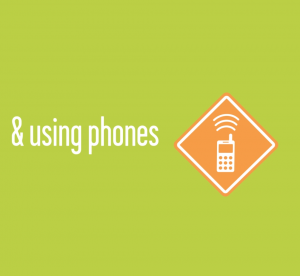
More people surveyed (65 per cent) identified pedestrians walking while talking on a cell phone as an increased danger on our roads than any other dangerous activity and 79 per cent chose texting and crossing the street as the no. 1 danger to pedestrians. However, Transport Canada analysis shows that drivers who are distracted, speed and fail to yield are the biggest danger to pedestrians.
3,05 MB Vidéo
-
Nous pouvons modifier nos routes pour les rendre sécuritaires pour les cyclistes

Notre sondage a révélé que seulement un Canadien sur cinq déclare que les routes sont sûres pour les cyclistes, comparativement à trois sur cinq qui disent que les routes sont sûres pour les conducteurs. Cependant, les routes construites avec des voies cyclables séparées et d’autres ajustements à la circulation, comme l’interdiction de tourner à droite aux feux rouges, réduisent considérablement le nombre de collisions entre les conducteurs et les cyclistes.
4,03 MB Vidéo
-
We can change our roads to make them safe for cyclists
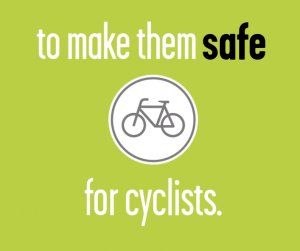
Our survey found that only one in five Canadians say roads are safe for cyclists, compared to three in five who say roads are safe for drivers. However, roads constructed with separated bike lanes and other adjustments to traffic flow, such as no right turn on red lights, greatly reduces the number of collisions between drivers and cyclists.
2,89 MB Vidéo
-
Les carrefours giratoires réduisent les risques de collision mortelle de 65%

L’enquête nationale Ipsos sur la sécurité routière montre que seulement la moitié des personnes sondées considéraient les carrefours giratoires comme étant efficaces quant à réduire les décès sur les routes. Cependant, une analyse effectuée sur les effets des carrefours giratoires montre qu’ils permettent de réduire les risques de collision mortelle de 65%.
2,95 MB Vidéo
-
Roundabouts reduce crash deaths by 65%
-
Vous faites peur à vos passagers quand vous roulez trop vite

Le sondage sur la sécurité routière de Parachute en 2021 a révélé que la majorité des Canadiens, lorsqu’ils sont passagers d’une voiture, disent qu’ils ne se sentent pas en sécurité à cause de la vitesse. Cependant, les trois quarts de tous les conducteurs ont admis avoir déjà dépassé une limite de vitesse sur autoroute au moins une fois au cours de l’année précédente.
3,82 MB Vidéo
-
You are scaring your passengers when you speed
-
Vision Zero
-
Sarah Macdonald
-
Sarah Macdonald
-
Injuries divert essential hospital resources and cost Canadian residents $29.4 billion annually
-
Les blessures monopolisent des ressources hospitalières essentielles et coûtent 29,4 milliards de dollars par an aux résidents canadiens
-
Population de référence
-
Classifications des codes CIM-10
-
Méthodologie
-
Définitions
-
Remerciements
-
Reference population
-
The highest costs: Falls and transport
-
Methodology
-
Injury costs across the lifespan
-
ICD-10 Code Classifications
-
Definitions
-
Costs by cause of injury
-
Acknowledgements
-
Cost of Injury in Canada
Parachute’s Cost of Injury in Canada 2021 report quantifies the cost of injury from a societal perspective, including costs to the health-care system, to productivity and to the people behind the numbers: individuals, families, communities.
-
Cost of Injuries in Alberta, 2017
-
Les coûts les plus élevés : chutes et incidents de transport
-
Coûts par cause de blessure
-
Coûts des blessures tout au long de la vie
-
National Injury Prevention Day 2021 Social Media Guide
This guide is to help communities and partners use social media to support and promote Parachute’s National Injury Prevention Day.
1,81 MB Word
-
Costs to the health system and society
-
Coûts au système de santé et à la société
-
There’s a cannabis for everything … except for driving (30 seconds)
-
Elementary Road Safety Program extends to Atlantic Canada
-
Le programme Sécurité Routière Primaire s’étend au Canada atlantique
-
The human cost of injury
-
Le coût humain des blessures
-
Test
Tableau -
Ressources pour la campagne #Que
Signifie Facultés Affaiblies QueSignifieFacultésAffaiblies était une campagne de sensibilisation du public visant à attirer l’attention des Canadiens sur le fait que le cannabis altère les facultés d’une personne à conduire un véhicule motorisé en toute sécurité. Financé par le Programme de Santé Canada sur l’usage et les dépendances aux substances, #QueSignifieFacultésAffaiblies était un projet bilingue à phases multiples lancé en 2019 et se poursuivant jusqu’en 2021. Il comprenait deux phases à destination des résidents canadiens.
15,05 MB PDF/UA
-
Prendre la bonne voie : vers une conduite plus sûre (2021)

Parachute a développé et mené des campagnes de sensibilisation afin d’impliquer les jeunes résidents canadiens, de remettre en question leurs perceptions et de les sensibiliser aux dangers de la conduite sous l’emprise de l’alcool et de la vitesse – tout cela dans le cadre de notre engagement plus large de Réseau Vision Zéro, série d’études de cas Numéro 11 changement de système pour la sécurité routière par le biais de Vision Zéro.
14,29 MB PDF/UA
-
#Know
What Impaired Means Campaign Assets -
Taking the high road: campaigning for safe driving (2021)
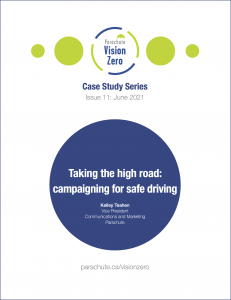
Parachute has developed and led awareness campaigns to engage young Canadian residents, challenge their perceptions and raise awareness of the dangers of driving while high and speeding – all within the framework of our larger, systems- change commitment to road safety through Vision Zero.
10,92 MB PDF/UA
-
La Semaine Sécuri
Jeunes de Parachute, du 30 mai au 5 juin, encourage les enfants à s’adonner au #Jeu Extérieur En Sécurité -
Parachute Safe Kids Week, May 30 to June 5, encourages kids to #Play
Safe Outdoors -
Outdoor Play: Myths and Facts
-
Nearly all Canadians want safer roads, but fewer are willing to embrace proven measures to make that happen
-
La quasi-totalité des Canadiens souhaite des routes plus sûres, mais ils sont moins nombreux à vouloir adopter des mesures efficaces pour y parvenir
-
Appropriate weather gear infographic
-
Freedom infographic
-
Play time infographic
-
Play space infographic
-
Benefits of Play infographic
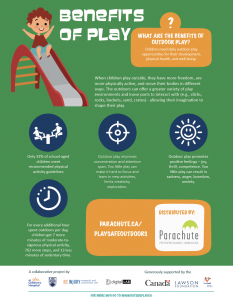
When children play outside, they have more freedom, are more physically active, and move their bodies in different ways. The outdoors can offer a greater variety of play environments and loose parts to interact with (e.g., sticks, rocks, buckets, sand, crates) – allowing their imagination to shape their play.
1,73 MB PDF/UA
-
Snack and binge (15 seconds)
-
Snack and binge (six seconds)
-
Lost your job (15 seconds)
-
Lost your job (six seconds)
-
Lost your job (six seconds)
-
New Brunswick teen Carly Smith winner of the 2021 Stacey Levitt Memorial Award
-
Carly Smith, une adolescente du Nouveau-Brunswick remporte le prix commémoratif Stacey Levitt 2021
-
Loi Rowan : ressources de sensibilisation aux commotions cérébrales
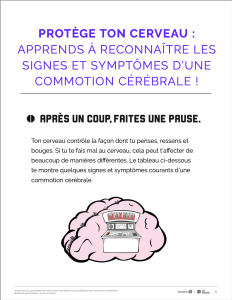
Ce site Web du gouvernement de l’Ontario héberge des ressources de sensibilisation aux commotions cérébrales créées par Parachute à destination de toutes les organisations sportives de la province. Il comprend des liens vers des livrets électroniques, des vidéos et des modules d’apprentissage en ligne ainsi que des modèles de codes de conduite et de plans de retrait du sport et de retour au sport.
-
Rowan’s Law Concussion Awareness Resources
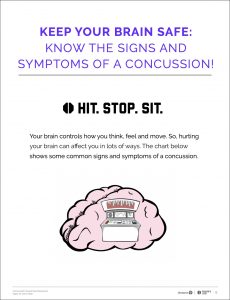
This Government of Ontario website hosts concussion awareness resources created by Parachute to be used by all sport organizations in the province. It includes links to e-booklets, videos and e-learning modules as well as templates for codes of conduct and removal-from-sport and return-to-sport plans.
-
Guide pour l’utilisation des médias sociaux – Semaine Sécuri
Jeunes 2021 -
Safe Kids Week 2021 – Social Media Guide
-
24 Hour Movement Guidelines for Children and Youth
ParticipACTION provides the 24-Hour Movement Guidelines for Children and Youth, looking at « sweat, step, sit and sleep » and providing resources to encourage kids to get active.
-
Directives en matière de mouvement sur 24 heures pour les enfants et adolescents
ParticipACTION fournit les directives en matière de mouvement sur 24 heures pour les enfants et les adolescents, avec pour principaux points « suer, bouger, s’asseoir et dormir », tout en fournissant des ressources pour encourager les enfants à devenir actifs
-
The Ability Toolkit
[From ParticipACTION] The Ability Toolkit aims to help parents and caregivers support their child or youth with a disability meet the Canadian 24-Hour Movement Guidelines, providing information to adapt the guidelines to the unique movement abilities of children or youth with any type of disability.
-
Le guide d’accessibilité
Le guide d’accessibilité a été développé pour aider les parents, ou autres, à encourager leur enfant ou adolescent ayant une limitation à respecter les Directives canadiennes en matière de mouvement sur 24 heures, fournissant ainsi des informations pour adapter les directives aux capacités de mouvement uniques des enfants ou des jeunes avec tout type de limitation.
-
Should I go outside in the COVID-19 Era?
[From Outdoor Play Canada] This resource addresses why it is so important to spend time outdoors, especially during the COVID-19 pandemic.
-
Puis-je aller dehors en cette période de COVID-19 ?
[De Outdoor Play Canada] Cette ressource explique pourquoi il est si important de passer du temps à l’extérieur, en particulier pendant la pandémie de COVID-19.
-
Be a lifeguard to your child’s « risky » play
[From Active for Life] This resource outlines how to take a « lifeguard approach » when your child is engaging in risky play, discussing three different levels of vigilant care: open attention, focused attention, and active protection.
-
Votre enfant et le jeu risqué : jouez le rôle d’un sauveteur
[De Actif pour la vie] Cette ressource explique comme mettre en place l’approche « sauveteur » quand votre enfant s’adonne au jeu risqué/jeu libre, expliquant les trois différents niveaux de vigilance à adopter selon le contexte : l’attention ouverte, l’attention centrée et la protection active.
-
Active for Life podcast: Dr. Mariana Brussoni on the value of risky play
[From Active for Life] Dr. Mariana Brussoni speaks with Active for Life editor-in-chief, Richard Monette, regarding the value of risky play and parental concerns.
-
39 fun ways kids can play outside this spring
[From Active for Life] Use this resource to find fun, new ways to encourage your kids to #PlaySafeOutdoors in the warm weather.
-
39 activités extérieures amusantes au printemps
[De Actif pour la vie] Utilisez cette ressource pour trouver de nouvelles activités amusantes pour encourager vos enfants à s’adonner au #JeuExtérieurEnSécurité dès l’arrivée des beaux jours.
-
Why outdoor play is more important than ever
[From Active for Life] A discussion of the importance of active, outdoor play for kids, especially during COVID-19. This resource also addresses overcoming barriers, such as not having a backyard or your child not wanting to play outdoors.
-
Pourquoi le jeu à l’extérieur est plus important aujourd’hui qu’il ne l’a jamais été
[De Actif pour la vie] Une discussion sur l’importance du jeu actif en plein air pour les enfants, en particulier pendant la pandémie de COVID-19. Cette ressource évoque également certains des obstacles que l’on peut rencontrer, comme le fait de ne pas avoir de jardin ou que votre enfant ne veuille pas jouer à l’extérieur.
-
Safe Kids Week 2021 Backgrounder
-
Fiche d’information – Semaine Sécuri
Jeunes 2021 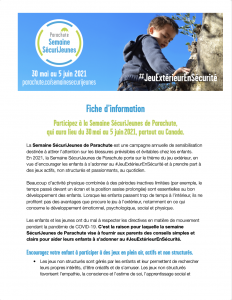
La semaine SécuriJeunes 2021 de Parachute porte sur le thème du jeu extérieur, en vue d’encourager les enfants à s’adonner au #JeuExtérieurEnSécurité et à prendre part à des jeux actifs, non structurés et passionnants, au quotidien. Cette fiche d’information fournit des conseils pour encourager le jeu extérieur en toute sécurité pour les enfants.
3,01 MB PDF/UA
-
3. Brain Anatomy – Negin
-
Poison Prevention – It’s Not Just For Poison Prevention Week (2021)
The “Poison Prevention – It’s Not Just For Poison Prevention Week” webinar, hosted by Parachute and the Injury Prevention Centre, will bring together partners from across Canada to share their activities for Poison Prevention Week 2021 and ideas for how to continue to promote poison prevention to parents, caregivers and others, year-round.
-
Outil de formation et de sensibilisation aux commotions cérébrales pour les professionnels scolaires
L’Outil de formation et de sensibilisation aux commotions cérébrales (le « CATT ») est un programme conçu pour apporter professionnel d’école l’information dont ils ont besoin pour avoir une approche fondée sur des données probantes afin de répondre et gérer une commotion.
-
Connaître votre rôle : directeurs sportifs, entraîneurs, enseignants et autres superviseurs
En savoir plus sur le rôle qu’ont les directeurs sportifs, les entraineurs, les enseignants et autres superviseurs en matière de commotion cérébrale à l’école.
-
Fiche d’information post-commotion pour les enfants du Nunavut (Inuinnaqtun)
-
Fiche d’information post-commotion pour les enfants du Nunavut (Inuktitut)
-
Fiche d’information post-commotion pour les enfants du Nunavut (Français)
-
Post Concussion Information Sheet for Nunavut Children (Inuinnaqtun)
-
Post Concussion Information Sheet for Nunavut Children (Inuktitut)
-
Post Concussion Information Sheet for Nunavut Children (English)
-
Traumatismes et violence: les faits 2014
-
Les circonstances entourant les décès liés à la motoneige au Canada, 2013 à 2019
Ce rapport de Statistique Canada décrit les circonstances entourant les décès liés à la motoneige dans toutes les provinces et les territoires de 2013 à 2019, dans le but de mettre en avant les mesures préventives.
-
Prévenir les blessures graves chez les enfants et les adolescents du Canada atlantique – Un guide pour les décideurs (2019)
-
Plan canadien de prévention de la noyade, 9ème edition (2022)
-
National Poison Prevention Week campaign calls on Canadian residents to #Check
For Poisons among ordinary household items -
La campagne de la Semaine nationale de prévention des empoisonnements invite les Canadiens à vérifier la présence de poisons dans les produits ménagers courants. #Vérifiez
Les Poisons -
Circumstances surrounding snowmobile fatalities in Canada, 2013 to 2019
This report from Statistics Canada describes the factors in snowmobile fatalities across all provinces and territories from 2013 to 2019, with the intent to inform preventative measures.
-
Preventing Serious Injuries in Children and Youth in Atlantic Canada: A Guide for Decision Makers (2019)
-
Canadian Drowning Prevention Plan, 9th Edition (2022)
-
Images pour les médias sociaux – Semaine de prévention des empoisonnements 2024
Images pour utilisation sur les réseaux sociaux.
-
Poison Prevention Week 2023 – Social media images
Graphics to use for social media
3,77 MB ZIP
-
Concussion Awareness Training Tool (CATT) for Women’s Support Workers
The Concussion Awareness Training Tool (CATT) is a program designed to provide people who work with survivors of intimate partner violence with the information they need to take an evidence-based approach in responding to and managing concussion.
-
#Know
What Impaired Means: Connecting youth and parents on cannabis impaired driving (2021) 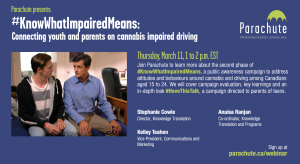
Since the legalization of cannabis in Canada, cannabis-impaired driving among youth and young-adult drivers has become a growing concern. In response to this issue, Parachute launched phase one of the #KnowWhatImpairedMeans public awareness campaign in 2019 to address attitudes and behaviours around cannabis and driving among Canadians aged 15 to 24. Since then, Parachute launched phase two of the campaign in 2020, which, in addition to targeting young Canadians, also targeted parents through a new component: the #HaveThisTalk campaign.
The webinar will focus on the second phase of the campaign, including an in-depth look at the development and key messages of #HaveThisTalk. It will also present campaign evaluations and key learnings.
-
Poison Prevention Week 2022 – Social Media Guide
-
Guide des médias sociaux – Semaine de prévention des empoisonnements 2022
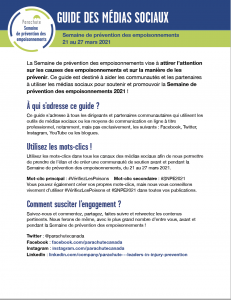
La Semaine de prévention des empoisonnements vise à attirer l’attention sur les causes des empoisonnements et sur les moyens de les prévenir. Ce guide vise à aider les communautés et les partenaires à utiliser les médias sociaux pour soutenir et promouvoir la Semaine de prévention des empoisonnements 2022.
1,28 MB PDF/UA
-
Liste de contrôle pour le stockage des produits toxiques pour votre maison
-
Poison Prevention Storage Checklist
-
Surveillance to Action: Canada’s response to emerging poisoning issues during COVID-19 (2021)
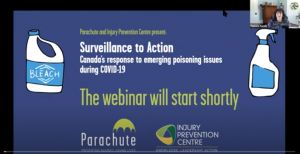
This 90-minute webinar hosted by Parachute and the Injury Prevention Centre on Feb. 26, 2021, focused on how The COVID-19 pandemic has introduced new poison prevention challenges, with more time spent at home and the introduction of more household cleaners, bleaches and hand sanitizers than ever before. The 11 panelists, including several from Health Canada, addressed how poison-related issues are reported and addressed in Canada discussed the timely detection of dangerous products, the development of public advisories and outreach, the process of stop sales and recalling non-compliant products, developing new policy, and the value of information sharing and collaboration in poison prevention.
-
Cannabis and kids: Parent Survey 2022
Find out about parents’ understanding of the dangers of cannabis edibles for children, and learn how to safely store cannabis products away from kids.
81,32 KB PDF/UA
-
Infographie sondage parents – Semaine de prévention des empoisonnements 2022
-
Poison Prevention Week 2023 – Backgrounder
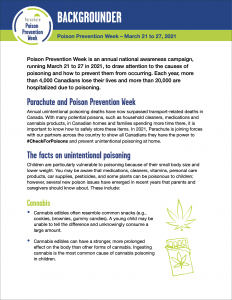
Annual unintentional poisoning deaths have now surpassed transport-related deaths in Canada. With many potential poisons, such as household cleaners, medications and cannabis products, in Canadian homes and families spending more time there, it is important to know how to safely store these items. In 2022, Parachute is joining forces with our partners across the country to show all Canadians they have the power to #CheckForPoisons and prevent unintentional poisoning at home.
231,55 KB PDF/UA
-
Fiche d’information – Semaine de prévention des empoisonnements 2023
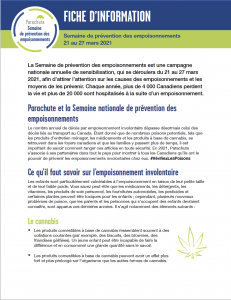
Le nombre annuel de décès par empoisonnement involontaire dépasse désormais celui des décès liés au transport au Canada. Étant donné que de nombreux poisons potentiels, tels que les produits d’entretien ménager, les médicaments et les produits à base de cannabis, se retrouvent dans les foyers canadiens et que les familles y passent plus de temps, il est important de savoir comment ranger ces articles en toute sécurité. En 2022, Parachute s’associe à ses partenaires dans tout le pays pour montrer à tous les Canadiens qu’ils ont le pouvoir de prévenir les empoisonnements involontaires chez eux. #VérifiezLesPoisons
197,24 KB PDF/UA
-
« Poison Prevention…It’s in Your Hands », Saskatchewan Prevention Institute
-
Infographie La politique sociale et la prévention des blessures – Comment vous pouvez influencer le changement
-
Social policy and injury prevention infographic – How you can influence change
-
Being an Influencer for Social Policy – An injury prevention perspective
The purpose of this document is to provide a guide for stakeholders to see their role in influencing social policy that supports injury prevention. This document defines social policy, its importance and connection to injury prevention, outlines examples of activities that can influence social policy in injury prevention, as well as provides overall supporting documents and definitions.
(Atlantic Collaborative on Injury Prevention & Child Safety Link (2020). Being an influencer for social policy: An injury prevention perspective. Halifax, NS.) -
Être un influenceur pour les politiques sociales – Une perspective de prévention des blessures
L’objectif du présent document est d’offrir un guide permettant aux intervenants de voir le rôle qu’ils peuvent jouer pour influencer les politiques sociales qui appuient la prévention des blessures. Ce guide définit ce qu’est une politique sociale, souligne son importance et son lien à la prévention des blessures, et donne un aperçu d’activités qui peuvent influencer les politiques sociales en matière de prévention des blessures. On y trouve également des documents généraux et des définitions à l’appui.
(Collaboration atlantique pour la prévention des blessures & Child Safety Link, 2020. Être un influenceur pour les politiques sociales : Une perspective de prévention des blessures. Halifax, N.-É.) -
Detection of Cyclist and Pedestrians Around Heavy Commercial Vehicles
Charlebois, D., Meloche, E., Burns, P. (n.d.)
-
Acceptance and Experience of a Vulnerable Road User Detection System Among Heavy Vehicle Operators: A Year-long Multi-city Field Trial
To be published on the Canadian Association for Road Safety Professionals (CARSP) website, 2021) Lau, C. P., Burns, P. C., Charlebois, D.
-
An Investigation of Municipal Truck Size and Safety Guards on Vulnerable Road Users
Report prepared for the City of Toronto, Schuelke-Leech, B. (2019)
-
A Literature Review of Lateral Protection Devices on Trucks Intended for Reducing Pedestrian and Cyclist Fatalities
Report prepared for the Federal Motor Carrier Safety Administration at the U.S. Department of Transportation. Badgley, J., Breck, A., Dawes, M., Epstein, A. K., Welty, K., McNally, A., & Peirce, S. (2020)
-
Oakland Chinatown Pedestrian Scramble: An Evaluation
UC Berkeley: Safe Transportation Research & Education Center. Bechtel, A. K., MacLeod, K. E., Ragland, D. R. (2003)
-
Pedestrian Scramble Crossings – A Tale of Two Cities
Bissessar, R., & Tonder, C. (n.d.)
-
Pedestrian Scramble Operations: Pilot Study in Calgary, Alberta, Canada
Transportation Research Record: Journal of the Transportation Research Board 2140(1). Kattan, L., Acharjee, S., & Tay, R. (2009)
-
Key2Access Accessible Pedestrian Signal Update
Bambrick, V. (2019)
-
Improving Pedestrian Safety at Unsignalized Crossings
Transit Cooperative Research Program Report 112/National Cooperative Highway Research Program Report 562. Fitzpatrick, K., Turner, S., Brewer, M., Carlson, P., Ulman, B., Trout, N., Lord, D. (2006)
-
The Impact of Pedestrian Crossing Flags on Driver Yielding Behavior in Las Vegas, NV
Sustainability, 11(17) Clark, S., Coughenour, C., Bumgarner, K., de la Fuente-Mella, H., Reynolds, C., & Abelar, J. (2019)
-
The Effectiveness of Crosswalk Flags: A Review of the Evidence
Author/s: The Crosswalk Safety Society of Nova Scotia (2017)
-
Use of a video monitoring approach to reduce at-risk driving behaviours in commercial vehicle operations
Transportation Research Part F 14. Hickman, J. S., & Hanowski, R. J. (2010)
-
Evaluation of an in-vehicle monitoring system (IVMS) to reduce risky driving behaviors in commercial drivers: Comparison of in-cab warning lights and supervisory coaching with videos of driving behavior
Journal of safety research, 60. Bell, J. L., Taylor, M. A., Chen, G. X., Kirk, R. D., & Leatherman, E. R. (2017)
-
Trucks and Bikes: Sharing the Roads
Procedia – Social and Behavioural Sciences 125. Pattinson, W., & Thompson, R. G. (2014)
-
The effects of left-turn traffic-calming treatments on conflicts and speeds in Washington, DC
Journal of Safety Research, 75. Hu, W., & Cicchino, J. B. (2020)
-
Pedestrians: Turn Calming Program
New York City Department of Transportation (2021)
-
An Evaluation of the Photo Speed Enforcement Pilot Program in Saskatchewan: (March 2015–March 2017) Final Report
Traffic Safety Program Evaluation Saskatchewan Government Insurance (2018)
-
Bilan du projet pilote de coopération municipale des cinémomètres photographiques et systèmes photographiques de contrôle de circulation aux feux rouges
Période : octobre 2015 à juin 2017. Gouvernement du Québec, ministère des Transports (2018)
-
Understanding Safety-Related Issues for Pedestrians at Modern Roundabouts
Journal of Sustainable Development 5(4). Giuffre, O., & Grana, A. (2012)
-
Off street trials of a Dutch-style roundabout: Draft Project Report RPN751
Yor, I., Helman, S., & Vermaat, P. (2015)
-
Traversées dans toutes les directions
-
Technologies d’alerte de sortie
-
Essai opérationnel sur le terrain d’un système de détection d’usagers vulnérables de la route pour véhicules lourds dans plusieurs villes
-
Stratégies d’augmentation de la résistance des lignes médianes aux intersections munies de feux de circulation
-
Stratégie de sécurité à vélo – Sécurité des véhicules et éducation routière
-
Protections latérales des camions
-
Drapeaux de sécurité de haute visibilité aux passages pour piétons
-
Dispositifs de contrôle automatisé de la vitesse
-
Carrefour giratoire d’inspiration néerlandaise
-
Signaux accessibles pour les piétons ayant des problèmes de visibilité et de mobilité
-
Multi-city Field Operational Test of a Vulnerable Road User Detection System for Heavy Vehicles
-
Truck Side Guards
-
Pedestrian Scramble Operations
-
Accessible Signals for Pedestrians with Visibility and Mobility Challenges
-
High-visibility Safety Flags for Pedestrian Crossings
-
Exit Warning Technology
-
Cycling Safety Strategy – Vehicle Safety and Driver Education
-
Centreline Hardening Strategies at Signalized Intersections
-
Automated Speed Enforcement
-
Dutch-inspired Roundabout
-
Poisoning Prevention in Canada: Data, trends and calls to action (2021)
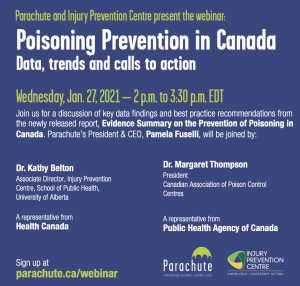
This January 2021 webinar features a discussion of key data findings and best practice recommendations from the Evidence Summary on the Prevention of Poisoning in Canada. Featuring Parachute President and CEO Pamela Fuselli, Dr. Kathy Belton of the Injury Prevention Centre, Alberta, Dr, Margaret Thompson, President of the Canadian Association of Poison Centres, and representatives from Health Canada and the Public Health Agency of Canada.
-
Transport multimodal : Faire le lien entre l’action climatique et la sécurité routière (2021)
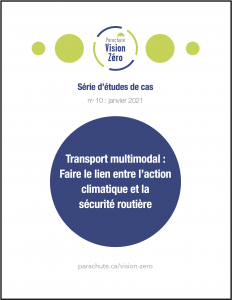
Cette étude de cas se concentrera sur le transport multimodal et son lien unique entre l’action climatique et la sécurité routière, en tenant compte principalement du contexte urbain. L’objectif de cette étude de cas sera de comprendre comment le TMM peut être un outil essentiel pour atteindre à la fois les objectifs de réduction des émissions de GES et ceux de Vision Zéro, et de plaider pour que les administrations prennent en compte ce croisement dans leur planification de la sécurité routière.
7,68 MB PDF/UA
-
Multi-modal transportation: Making the link between climate action and road safety (2021)
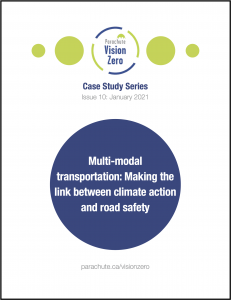
This case study will focus on multi-modal transportation and its unique link between climate action and road safety, primarily considering urban settings. The purpose of this case study will be to understand how MMT can be a vital tool for meeting both GHG emissions reduction and Vision Zero goals and make the case for jurisdictions to consider this intersection in their road safety planning.
1,91 MB PDF/UA
-
Safer driving behaviours are hard to sustain, but it can be done
-
Les bonnes habitudes de conduite sont difficiles à maintenir, mais c’est possible
-
Canadian 24-Hour Movement Guidelines for Adults ages 65 years and older: An Integration of Physical Activity, Sedentary Behaviour, and Sleep
This guideline offers clear direction on what a healthy 24 hours looks like for Canadian adults aged 65 years and older.
-
Directives canadiennes en matière de mouvement sur 24 heures pour les adultes âgés de 65 ans et plus : une approche intégrée regroupant l’activité physique, le comportement sédentaire et le sommeil
-
International Walk to School Month
-
Mois international J’marche pour aller à l’école
-
Vulnerable Road User (VRU) Safety Resources Repository
-
Répertoire des ressources de sécurité pour les usagers vulnérables de la route (UVR)
-
Focus on women (Fall Prevention Conference 2020)
November 20, 2020 from 12pm to 1pm (EST)
Theme: Balance Flow Yoga: A Community-Based Intervention for Peri and Post-Menopausal Women
Presenters: Dr. Brenna Bath, Dr. Cathy Arnold and Shelly Prosko, School of Rehabilitation Science, University of Saskatchewan Prosko PhysioYoga -
Focus on Indigenous peoples: Part 2 (Fall Prevention Conference 2020)
November 19, 2020 from 3pm to 4pm (EST)
Theme: It takes a village to prevent a fall – how Loop helps you stay connected and informed
Presenter: Shameeza Allard, Ontario Neurotrauma Foundation -
Focus on Indigenous peoples: Part 1 (Fall Prevention Conference 2020)
November 19, 2020 from 12pm to 1:30pm (EST)
Theme 1: Pan-Canadian Fall Prevention Training: Current and Future Opportunities
Presenter: Dr. Vicky Scott, School of Population and Public Health at the University of British Columbia
Theme 2: Indigenous Fall Prevention Network: An Overview
Presenter: Dr. Kathy Belton, Injury Prevention Centre, School of Public Health, University of Alberta -
Falls among older adults: Part 4 (Fall Prevention Conference 2020)
November 18, 2020 from 3pm to 4pm (EST)
Theme 1: #FallPreventionCanada
Presenter: Valerie Smith, Parachute
Theme 2: Functional Independance in Acute Care
Presenter: Suzanne Baker, Nova Scotia Health
Theme 3: The Injury Pyramid of Impacts and Injuries to Body Parts from Video-Captured Falls in Long-term-care
Presenter: Dr. Vicki Komisar, Simon Fraser University
Theme 4: Vitamin D Supplementation for the Prevention of Falls and Fractures in Residents of Long-Term Care
Presenter: Kathleen Kulyk, Canadian Agency for Drugs and Technologies in Health (CADTH)
Theme 5: Seniors’ Falls in Canada
Presenter: Wendy Thompson and Joanne Bowater, Public Health Agency of Canada -
Falls among older adults: Part 3 (Fall Prevention Conference 2020)
November 18, 2020 from 12pm to 1 pm (EST)
Theme: Strong, Balanced and FAST: Working Together to Prevent Fall-Related injuries in Older Adults
Presenter: Dr. Cathy Arnold, School of Rehabilitation Science, University of Saskatchewan
Theme 2: Assessing mobility and safety of people with dementia using mobility aids to prevent falls
Presenter: Dr. Susan Hunter, School of Physical Therapy, University of Western Ontario -
Falls among older adults: Part 2 (Fall Prevention Conference 2020)
November 17, 2020 from 3pm to 4pm (EST)
Theme 1: Finding Balance: Prevention Older Adult Falls in an Evolving Context
Presenter: Nan Shybunka, Injury Prevention Centre, School of Public Health, University of Alberta
Theme 2: Medications and Fall Risk: Educational Outreach as an Intervention Strategy
Presenter: Loren Regier, Canadian Academic Detailing Collaboration (RxFiles AD and CEP AD)
Theme 3: Medication Prescribed to Ontario Older Adults One Year prior to a fall-related injury
Presenter: Yu Ming, Health and Rehabilitation Sciences, Western University
Theme 4: Falls Risk Assessment and Management for Community-Dwelling Older Adults: Developing a BC Clinical Practice Guideline
Presenters: Denise Beaton and Megan Oakey, British Columbia Centre for Disease Control -
Falls among older adults: Part 1 (Fall Prevention Conference 2020)
November 17, 2020 from 12pm to 1pm (EST)
Theme 1: Steppin’ Up with Confidence Plus: The Development and Delivery of a Community Falls Prevention Exercice Program
Presenter: Kristine MacDonald, Prairie Mountain Health
Theme 2: Care Communities – An Opportunity for Upstream Fall Prevention
Presenter: Phyllis Hegstrom, Home Instead Senior Care
Theme 3: Remembering When – Fire Departments Working fo Prevent Fire and Falls
Presenter: Dori Krahn, Saskatoon Fire Department -
Preventing Childhood Falls (Fall Prevention Conference 2020)
November 16, 2020 from 3pm to 4 pm (EST)
Theme 1: Preventing Childhood Falls
Presenter: Cara Zukewich, Saskatchewan Prevention Institute
Theme 2: Childhood Fall Prevention: Connecting the Dots
Presenter: Hélène Gagné, Ontario Neurotrauma Foundation -
Children’s falls/ Popping the bubble wrap: Making space for risky play (Fall Prevention Conference 2020)
November 16, 2020 from 12pm to 1pm (EST)
Theme: Children’s falls/ Popping the bubble wrap: Making space for risky play
Presenter: Dr Mariana Brussoni, B.C. Children’s Hospital Research Institute, University of British Columbia -
Canada’s Favourite Crossing Guard Mis à jour
-
Three crossing guards from Newfoundland, Ontario and B.C. chosen as Canada’s favourites
-
Trois brigadiers scolaires de Terre-Neuve-Et-Labrador, de l’Ontario et de la Colombie-Britannique choisis parmi les favoris du Canada
-
Trampolines at Home and Playgrounds Position Statement
-
L’utilisation des trampolines à la maison et au terrain de jeux
-
2020 Holiday Safely Social Media Guide
This guide is to help communities and partners use social media to support and promote our 2020 Winter Holidays Safety campaign. There’s nothing like keeping warm by the fire with your family over the holidays. Make sure everyone can enjoy it safely.
33,54 MB PDF/UA
-
Vacances Et Sécurité – Guide des réseaux sociaux 2020
Ce guide a pour but d’aider les communautés et les partenaires à utiliser les réseaux sociaux pour soutenir et promouvoir notre campagne sur la sécurité durant les vacances d’hiver de 2020. Il n’y a rien de tel que se réchauffer au coin du feu avec sa famille pendant les vacances. Assurez-vous que tout le monde puisse en profiter en toute sécurité.
3,81 MB PDF/UA
-
Perceptions of Vision Zero in Canada (2020)
Join Parachute’s President and CEO, Pamela Fuselli, in conversation with a panel of journalists from across Canada to discuss perceptions of road safety in our communities and Vision Zero measures being implemented by Canadian jurisdictions. Are they working? Do people think they’re working? Panel: Jason Magder, transportation reporter, Montreal Gazette; Elizabeth Payne, reporter, Ottawa Citizen; Ben Spurr, transportation reporter, Toronto Star; Jason Tchir, freelance journalist and columnist, Vancouver, B.C.
-
Strategies and Actions for Independent Living (SAIL) Course
This short, practical fall-prevention course is designed for home health care aides who provide day-to-day in-home care for frail older adults or persons with disabilities. In addition to training, after the course is completed, optional renewable access to the SAIL Resources is available to graduates, as well as to organizations such as home care agencies, health authorities and community health services.
-
Twice as many people in Canada now die from unintentional poisoning than from transport-related injuries
-
Les Canadiens sont deux fois plus nombreux à mourir d’un empoisonnement involontaire que d’un accident lié au transport
-
Evidence Summary on the Prevention of Poisoning in Canada (2020)
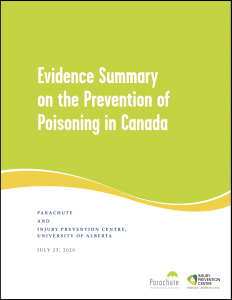
This 2020 report, written by Parachute and the Injury Prevention Centre at University of Alberta, draws together statistics and research on poisonings in Canada and documents prevention work and strategies, both underway and recommended. One key finding reveals that twice as many people in Canada now die from unintentional poisoning, driven mostly by increase in opioid use, than from transport-related injuries.
4,48 MB PDF/UA
-
Synthèse des preuves en matière de prévention des empoisonnements au Canada (2020)
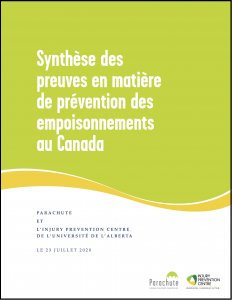
Ce nouveau rapport de 2020, rédigé par Parachute et l’Injury Prevention Centre de l’Université de l’Alberta, rassemble des statistiques et des recherches sur les empoisonnements au Canada et documente le travail et les stratégies de prévention en cours et recommandées. Une constatation clé révèle que deux fois plus de personnes au Canada meurent maintenant d’un empoisonnement involontaire, principalement due à l’augmentation de la consommation d’opioïdes, qu’à des blessures liées au transport.
4,42 MB PDF/UA
-
F1 driver Nicholas Latifi supports National Teen Driver Safety Week
-
Gunnarolla: Speed Is No Game
-
Élie Pilon : « Les roadtrips en 4 étapes »
-
La Semaine nationale de la sécurité des jeunes au volant vise les risques liés aux excès de vitesse
-
National Teen Driver Safety Week focuses on risks of speeding
-
2019 Annual Report
-
2019 Annual Report
-
POLL: Even with reduced in-class school attendance, school zone traffic safety has not improved, parents report
-
SONDAGE : Malgré une présence réduite des élèves en classe, la sécurité routière en zone scolaire ne s’est pas améliorée, selon les parents
-
Elementary Road Safety Back to School Survey
-
Active and Safe
This website provides evidence-based information on common injuries and injury prevention for 50 different sports and recreational activities.
-
Infographic from Particip
ACTION Report Card on Physical Activity for Adults, 2021 -
Infographie Bulletin de l’activité physique chez les adultes de Particip
ACTION, 2021 -
Particip
ACTION Report Card on Physical Activity for Children and Youth, 2024 -
Bulletin de l’activité physique chez les enfants et les jeunes de Particip
ACTION, 2024 Ce bulletin de ParticipACTION constitue l’évaluation la plus détaillée de l’activité physique des enfants et des jeunes au Canada.
-
SNSJV Guide des médias sociaux
-
SNSJV Messages clés
-
SNSJV Fiche d’information
-
NTDSW social media guide
-
NTDSW backgrounder
-
Living Guideline for Diagnosing and Managing Pediatric Concussion
-
Concussion Awareness Training Tool (CATT) for Medical Professionals
CATT (Concussion Awareness Training Tool) Medical Professionals is designed to provide medical professionals with the information they need to provide evidence-based care for their patients who have sustained a concussion. Accredited by UBC Continuing Professional Development, Faculty of Medicine. This course is accredited for MOC Section 3 credits
-
Guideline for Concussion/Mild Traumatic Brain Injury & Prolonged Symptoms (3rd Edition, 2018)
-
Campaign images for NTDSW 2020
Download this collection of campaign images for use with social media.
3,17 MB ZIP
-
NTDSW proclamation request template
-
Modèle de requête de proclamation SNSJV
-
NTDSW general proclamation template
-
Modèle de proclamation générale SNSJV
-
Are you Canada’s Safest Driver? Find out starting October 1!
-
Avez-vous La meilleure conduite au Canada ? Découvrez-le dès le 1er octobre !
-
La meilleure conduite au Canada-Guide des réseaux sociaux
-
Canada’s Safest Driver social media guide
-
You probably wouldn’t dye your hair high?
-
Tu ne teindrais probablement pas tes cheveux gelé ?
-
You probably wouldn’t give your dog a trim high?
-
Tu ne couperais probablement pas les poils de ton chien gelé ?
-
You probably wouldn’t decorate your mom’s birthday cake high?
-
Tu ne décorerais probablement pas le gâteau de fête de ta mère gelé ?
-
Changer la perception de Vision Zéro au Canada : audit médiatique
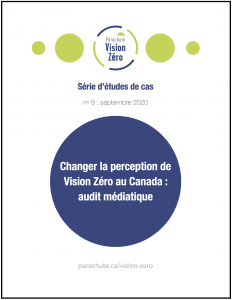
Cette étude de cas, réalisée avec la généreuse contribution de Desjardins, porte sur la couverture médiatique accordée à Vision Zéro dans différentes régions du Canada. L’analyse compare cette couverture sur deux périodes distinctes et s’intéresse à l’évolution, le cas échéant, du langage utilisé pour parler de sécurité routière, de l’attribution de la responsabilité des blessures et des incidents sur la route ainsi que de la fréquence et du ton des discussions à propos de Vision Zéro.
1,78 MB PDF/UA
-
Changing perceptions on Vision Zero in Canada: A media audit (2020)
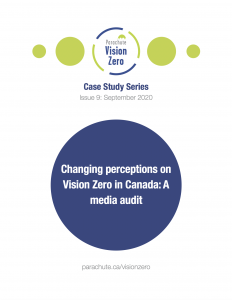
This Case Study, developed with generous support from Desjardins, reviews media coverage in various Canadian jurisdictions related to Vision Zero. This point-in-time audit compares media coverage over two time periods, reflecting on changes, or lack thereof, over time in language used to report on road safety, apportion of blame for injury and incidents on the road, as well as the frequency and tone of Vision Zero discussions.
1,67 MB PDF/UA
-
The shocking pile of shoes
-
Une pile de chaussures impressionnante
-
Particip
ACTION Report Card on Physical Activity for Adults, 2021 -
Bulletin de l’activité physique chez les adultes de Particip
ACTION 2021 -
#Have
This Talk Mis à jour Our year-two campaign to educate about the negative effects of cannabis impairment on driving focuses on reaching parents and other influencers of drivers and passengers ages 15 to 24.
-
#Have
This Talk – Mom (30 sec) -
#Avoir
Cette Discussion – Maman (30 sec) -
#Have
This Talk – Dad (15 sec, square) -
#Avoir
Cette Discussion – Maman (15 sec) -
#Have
This Talk – Dad (30 sec) -
#Avoir
Cette Discussion Mis à jour Our year-two campaign to educate about the negative effects of cannabis impairment on driving focuses on reaching parents and other influencers of drivers and passengers ages 15 to 24.
-
Trousse-commotion Le hockey intelligent (2025)
-
Smart Hockey Concussion Kit (2025)
-
Collecte et partage des données
-
Data collected and shared
-
Règles officielles
-
Parler cannabis : savoir discuter avec son ado
-
Cannabis Talk Kit: Know How to Talk With Your Teen
-
Parler pot avec les jeunes : un guide de communication sur le cannabis pour les alliés de jeunes
-
Talking pot with youth: A Cannabis Communication Guide for Youth Allies
-
Health Facts Sheets: Circumstances surrounding cycling fatalities in Canada, 2006 to 2017
This Health Facts Sheet by Statistics Canada looks at cycling fatalities in Canada from 2006-2017. This report provides a breakdown of fatalities by various factors such as age, sex, helmet use, use of alcohol/drugs, and more.
-
Rail safety videos
-
Brian Thom
-
Brian Thom
-
Leslie Dunning
-
Leslie Dunning
-
Dr Shahab Shahnazari
-
Dr. Shahab Shahnazari
-
Seanna Millar
-
Seanna Millar
-
Brittlestar and his mom: Stand for clear floors (or you’ll fall for anything)
-
Brittlestar et sa mère : des sols nets…ou bien vous tomberez à tout bout de champ (en anglais)
-
Brittlestar and his mom: Fall prevention exercises are easy (for some people)
-
Brittlestar et sa mère : les exercices de prévention des blessures sont faciles…pour certains (en anglais)
-
Brittlestar and his mom: Explaining fall prevention
-
Brittlestar et sa mère : explicatif sur la prévention des chutes (en anglais)
-
Tips for caregivers to help seniors stay active during the COVID-19 pandemic and beyond
-
Conseils aux aidants pour aider les aînés à rester actifs pendant et après la pandémie de COVID-19
-
Adding movement to your at-home routine
-
Ajouter du mouvement à votre quotidien à la maison
-
Room-by-room guide to eliminate causes of falls – Philips Lifeline
Use this resource to eliminate common fall risks in each room of your home.
-
Réduire les risques de chutes à la maison – Philips Lifeline
Utilisez cette ressource pour éliminer les causes typiques de chute dans chaque pièce de votre maison.
-
Osteoarthritis and Exercise – Health
HQ -
Physical Activity Tips for Older Adults (65 years and older) – Government of Canada
-
Conseils pratiques pour les aînés (65 ans et plus) – Gouvernement du Canada
-
Official contest rules, Canada’s Safest Driver
-
Join us for Parachute’s fourth annual National Injury Prevention Day, Monday July 6
-
Rejoignez-nous pour la quatrième Journée Nationale de la Prévention des Blessures de Parachute le lundi 6 juillet
-
Cannabis Knowledge Exchange Hub
-
Pôle d’échange des connaissances sur le cannabis
-
National Injury Prevention Day – Social media images
-
National Injury Prevention Day 2020 – Social Media Guide
-
Guide des médias sociaux – Journée Nationale de la Prévention des Blessures 2020
-
Why are cars made to go that fast? Speeding and road safety during COVID-19 (2020)
Join Parachute’s President and CEO, Pamela Fuselli, in conversation with a panel of experts to discuss the road safety and public health concerns due to the recent spike in speeding and stunt driving on now-emptier roads across Canada, the reasons why drivers speed, and what we can do about it. Panel: Ken Lindhardsen, Vice-President of Accident Benefits and Benefits and Bodily Injury for Desjardins; David Mele, Product Planning Manager at Volvo Cars Canada; Sgt. Kerry Schmidt, Ontario Provincial Police Highway Safety Division; Dr. Christine Wickens, Independent Scientist with the Institute for Mental Health Policy Research at the Centre for Addiction and Mental Health
-
Grande Prairie, AB teen Erin Pelé winner of the 2020 Stacey Levitt Memorial Award
-
Erin Pelé, une adolescente de Grande Prairie en Alberta, remporte le prix commémoratif Stacey Levitt 2020
-
Imagining Car Use and Road Safety Post COVID-19 (2020)
Parachute’s President and CEO, Pamela Fuselli, in conversation with Rachel MacCleery, Robin Mazumder, and Craig Milligan to discuss international examples such as Milan’s proposal to permanently reallocate street space from cars to cycling and walking following the COVID-19 crisis, what this could look like in a Canadian context and how we can all advocate for changes.
-
Cartographie Vision Zéro
-
Map of Vision Zero adoption
-
Sauver des vies au-delà de 2020 : Comment réduire de 50% le nombre de décès dus aux accidents de la route à échelle mondiale d’ici 2030
-
Saving lives beyond 2020: How the world can reduce motor-vehicle deaths by 50% by 2030
-
Embracing a new decade of improved road safety goals
-
Vers une nouvelle décennie d’amélioration des objectifs de sécurité routière
-
Thinking Differently – A look at Canadian cities’ immediate response to COVID-19 to make space for social distancing (2020)
Parachute’s President and CEO, Pamela Fuselli, discusses with a panel of experts the current and next phase of Canadian road use post-COVID-19 as restrictions are lifted. Panelists include: Bartek Komorowski, Planning Advisor, Road Safety and Human Behaviour, Ville de Montréal; Linda Rothman, Assistant Professor, School of Occupational and Public Health, Ryerson University, Toronto; and Brent Toderian, Urban design and planning consultant, TODERIAN UrbanWORKS, Vancouver
-
High
And Locked Fisgard Lighthouse, B.C. video -
En
Hauteur Et Verrouillé – Vidéo Phare Fisgard, C.-B. -
High
And Locked Grain Elevator, Saskatchewan video -
En
Hauteur Et Verrouillé – Vidéo Silo à céréales, Saskatchewan -
Exercise for Preventing Falls for Older People Living in the Community
This review assesses the effects (benefits and harms) of exercise interventions for preventing falls in older people living in the community.
-
L’exercice physique pour la prévention des chutes chez les personnes âgées en milieu communautaire
Cette étude évalue les effets (avantages et inconvénients) de l’intervention sur l’exercice physique pour prévenir les chutes chez les personnes âgées vivant dans la communauté.
-
#Check
For Poisons Social Media Guide -
#Vérifiez
Les Poisons – Guide pour l’utilisation des médias sociaux 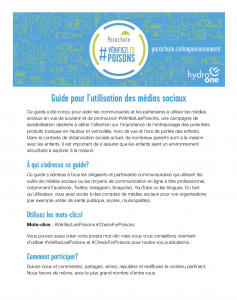
Ce guide permet d’aider les communautés et les partenaires à utiliser les médias sociaux pour soutenir et promouvoir #VérifiezLesPoisons, une campagne de sensibilisation sur l’importance d’entreposer les produits toxiques en hauteur et verrouillés, hors de vue et hors de protée des enfants.
981,78 KB PDF/UA
-
Parent and Caregiver Tips to Prevent Child Poisoning
-
Prévenir l’empoisonnement chez les enfants – Conseils aux parents et aux personnes qui s’occupent des enfants
-
Poison storage checklist for your house
Keep your children safe by keeping these household poisons locked up, out of sight and out of reach.
1,17 MB PDF/UA
-
Liste de contrôle pour le stockage des produits toxiques
-
COVID-19, Safer Roads and Urban Planning (2020)
Jennifer Keesmaat, former Toronto chief city planner, and Oliver Moore, urban affairs reporter at the Globe and Mail, discuss safe streets and urban planning in the context of COVID-19 and the lessons that we can learn from it. Facilitated by Pamela Fusell, President and CEO, Parachute.
-
Brain Waves alumnus at frontlines of pandemic response
-
Un ancien participant au programme Ondes Cérébrales en première ligne face à la pandémie
-
Preventing home injuries in the time of COVID-19
-
La prévention des blessures à domicile en période de COVID-19
-
En
Hauteur Et Verrouillé – Vidéo Hoodoo, Drumheller, Alberta -
High
And Locked Hoodoo, Drumheller, Alberta video -
High
And Locked mountain video -
En
Hauteur Et Verrouillé – Vidéo montagne -
High
And Locked water tower video -
En
Hauteur Et Verrouillé – Vidéo château d’eau -
En
Hauteur Et Verrouillé – Vidéo grue de construction -
High
And Locked construction crane video -
En
Hauteur Et Verrouillé – Vidéo gratte-ciel -
High
And Locked skyscraper video -
En
Hauteur Et Verrouillé – Vidéo Citadel Hill Halifax -
High
And Locked Citadel Hill Halifax video -
En
Hauteur Et Verrouillé – Vidéo Université OCAD Toronto -
High
And Locked OCAD University Sharp Centre Toronto video -
En
Hauteur Et Verrouillé – Vidéo Signal Hill St. John’s, Terre-Neuve-et-Labrador -
High
And Locked Signal Hill St. John’s NFLD video -
En
Hauteur Et Verrouillé – Vidéo Parc olympique de Montréal -
High
And Locked Olympic Stadium Montreal video -
Return-to-Work Strategy (2024)
-
Stratégie de retour au travail (2024)
-
Vidéo Tour de la Paix – En
Hauteur Et Verrouillé -
Our best story is no story
-
Notre meilleure histoire, c’est quand il n’y a rien à raconter.
-
#En
Hauteur Et Verrouillé Parachute a lancé cette campagne nationale pour apprendre aux parents et à ceux qui s’occupent d’enfants comment entreposer les produits comestibles au cannabis de façon sécuritaire hors de vue et de portée des enfants.
-
#High
And Locked Parachute launches this national campaign to teach parents and others who care for children how to safely store cannabis edibles out of sight and reach of curious kids.
-
High
And Locked Peace Tower Ottawa Video -
En
Hauteur Et Verrouillé – Vidéo Tour de la Paix, Ottawa -
National Poison Prevention Week campaign focuses on children and cannabis
-
La campagne organisée dans le cadre de la Semaine nationale de prévention des empoisonnements met l’accent sur les enfants et le cannabis
-
Preventing poisoning in Alberta children (Injury Prevention Centre)
-
Social media images for Poison Prevention Week
A collection of images to use when promoting Poison Prevention Week on social media.
1,02 MB ZIP
-
Semaine de prévention des empoisonnements Mis à jour
-
Social Media Guide
-
Guide pour l’utilisation des médias sociaux
-
Infographic – Cannabis poison prevention
-
Infographie – Prévention des empoisonnements par le cannabis
-
Poison Prevention Week Mis à jour
-
Backgrounder
-
Fiche d’information Semaine de prévention des empoisonnements
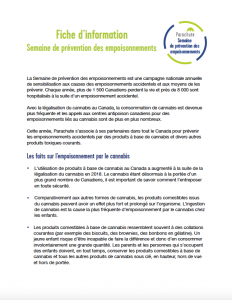
Avec la légalisation du cannabis au Canada en 2018, l’usage du cannabis s’est répandu et les appels des Canadiens dans les centres antipoison pour des empoisonnements relatifs au cannabis ne font qu’augmenter. Avec la généralisation de l’usage du cannabis, il est crucial de savoir comment l’entreposer de façon sécuritaire.
85,33 KB PDF/UA
-
Brain Waves celebrates 15th anniversary of injury prevention education
-
Le programme Ondes cérébrales fête son 15ème anniversaire de sensibilisation à la prévention des blessures
-
Brain Waves parent resource

As part of the Brain Waves experience, this “Ask Me Anything” sheet is designed to help you, as a parent/caregiver, engage in the learning experience of your child. Discuss the following questions with your child to help ensure that the critical learning taking place in the classroom can be carried home and shared and reinforced with parents/caregivers.
485,58 KB PDF
-
Learn how Canadian jurisdictions can make their Vision Zero commitment
-
Découvrez comment les juridictions canadiennes peuvent endosser les principes de Vision Zéro
-
Becoming a Vision Zero community
-
Devenir une collectivité Vision Zéro
-
Indicators of a Vision Zero community
-
Indicateurs d’une collectivité Vision Zéro
-
Making a Vision Zero commitment in Canada
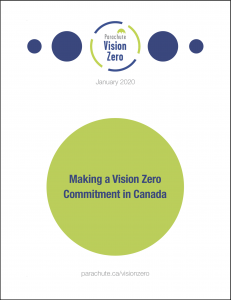
This paper, developed with generous support from Desjardins, provides national thought leadership on a practical implementation of Vision Zero in Canada. It briefly summarizes the roots of Vision Zero and the current status of Vision Zero across Canada. It also provides a high-level review of Vision Zero and road safety frameworks from Canada and internationally. By using an injury-prevention approach based in public health theory, the paper provides information not only on Vision-Zero-specific implementation but will also address the contextual factors that impact these efforts, such as community readiness. Tools created by Parachute and links to other tools supplement the paper by providing useful resources that address the needs of stakeholders at all stages of their Vision Zero commitment.
23,02 MB PDF/UA
-
S’engager en faveur de Vision Zéro au Canada (2020)
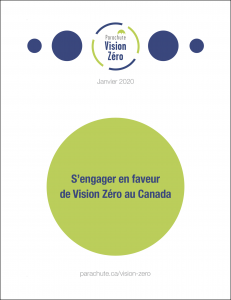
Ce document, développé avec le généreux soutien de Desjardins, fournit un modèle national de leadership éclairé pour une mise en œuvre pratique de Vision Zéro au Canada. Il résume brièvement les origines de Vision Zéro et l’état actuel de celle-ci au Canada. Il présente également un examen de haut niveau de Vision Zéro et des cadres de sécurité routière au Canada et à l’étranger. Utilisant une approche de prévention des blessures établie en fonction de la théorie de la santé publique, ce document fournit des renseignements sur la mise en œuvre précise de Vision Zéro, et aborde également les facteurs contextuels qui ont une incidence sur ces efforts de mise en oeuvre, comme l’état de réparation des collectivités. Des outils créés par Parachute et des liens vers d’autres outils complètent le document et fournissent des ressources utiles qui répondent aux besoins des intervenants à toutes les étapes de leur engagement en faveur de Vision Zéro.
8,19 MB PDF/UA
-
Vision Zero tool references
-
Références d’outils Vision Zéro
-
Ontario Poison Centre
Serving Ontario, Manitoba, and Nunavut, this website has information for families and health professionals, including common causes of poisoning in Ontario.
-
Centre antipoison de l’Ontario
Desservant l’Ontario, ce site web contient des informations pour les familles et les professionnels de la santé, incluant les causes communes d’empoisonnement en Ontario.
-
Québec Poison Control Centre
The Québec Poison Control Centre website has information and resources on poison prevention; basic information is provided in English and French, with extensive resources for professionals in French.
-
Centre antipoison du Québec
Ce site web du Centre antipoison de Québec contient informations et ressources sur la prévention des empoisonnements; les informations de base sont proposées en français et en anglais, avec des ressources supplémentaires en français pour les professionnels.
-
Saskatchewan Prevention Institute: Poisoning
The SPI Poisoning webpage has provincial data on child poisonings and downloadable fact sheets, posters and activities.
-
Poison and Drug Information Service (PADIS), Alberta
From Alberta Health Services, the webpage has information about PADIS services and answers to frequently asked questions. PADIS serves Alberta, Saskatchewan and the Northwest Territories.
-
Child Safety Link Safety at Home: Poison Prevention
Child Safety Link is based out of the IWK Regional Poison Centre and its goal is to help educate Maritime communities about poisoning prevention This Poison Prevention webpage includes resources and videos.
-
Child Safety Link Safety – La prévention des empoisonnements à la maison
Child Safety Link est basé sur le IWK Regional Poison Centre et son objectif premier est de sensibiliser les communautés maritimes à la prévention des empoisonnements. Cette page dédiée à la prévention des empoisonnements inclut différentes ressources.
-
Injury Prevention Centre, Alberta, poisoning webpage
IPC’s Poison-Related Injuries webpage offers provincial statistics for Alberta, prevention messages and poisoning resources and toolkits.
-
BC Injury Prevention Unit: quick facts about poisoning
The BCIRPU’s Poisoning webpage provides provincial statistics for British Columbia, prevention tips and resources.
-
Health Canada: Is Your Child Safe?
-
Santé Canada – Votre enfant est-il en sécurité ?
-
The Youth Concussion Awareness Network (You-CAN) protocol for a cluster randomized trial
This study published in February 2020 by BMC Public Health has Parachute President and CEO Pamela Fuselli among its co-authors. The Youth Concussion Awareness Network (You-CAN) is a school-based peer-led program designed to increase high school students’ intent to report a concussion, and provide social support to a peer. This study aims to investigate whether participation in You-CAN, a program grounded in service learning principles, impacts concussion knowledge, attitudes, intent to report a suspected concussion to an adult, and intent to provide social support to a peer. Secondary aims include assessing the implementation fidelity and acceptability of the intervention.
-
Check For Concussion – Steve Podborski
-
Check for Concussion – Scott Moir
-
Check For Concussion PSA – English
-
Hip fracture: Care for people with fragility fractures
This resource provides a guide for patients; a guide for clinicians; an information brief demonstrating why the quality standard is needed; quality improvement tools and resources; and performance indicators to help clinicians and organizations track their progress against the standard.
-
Fracture de la hanche : soins destinés aux personnes présentant des fractures de fragilisation
Cette ressource propose un guide pour les patients; un guide pour les cliniciens; une note d’information démontrant pourquoi la norme de qualité est nécessaire; l’amélioration de la qualité des outils et des ressources; ainsi que des indicateurs de performance pour aider les cliniciens et les organisations à suivre leurs progrès par rapport à la norme.
-
Your newborn: Bringing baby home from hospital
Tips from the Canadian Paediatric Society.
-
Votre nouveau-né : l’arrivée de bébé à la maison à la sortie de l’hôpital
Informations et conseils de la Société canadienne de pédiatrie.
-
Vision Zero: Toronto’s Road Safety Plan 2017-2021
-
Vision Zero 2.0 – Road Safety Plan Update
-
Traffic Safety Strategic Plan 2020
-
Safer Roads Ottawa Program
-
Vision Zero: Kingston’s Road Safety Plan
-
Vision Zero Surrey Safe Mobility Plan 2019-2023
-
Halifax Regional Municipality Road Safety Strategy
-
Vision Zero Road Safety Strategic Plan 2018-2022
-
Saskatoon’s Vision Zero recommendation
-
Moving Towards Zero Safety Action Plan
-
Plan d’action Vision Zéro décès et blessé grave 2019-2021
-
Vision Zero Hamilton: 2019-2025 Action Plan
-
Road to Zero: Manitoba Road Safety Plan 2017 to 2020
-
St. Albert Transportation Safety Plan 2018 to 2025
-
Protective Services Traffic Safety Plan 2023 to 2026
-
Safer Mobility Plan 2019-2023
-
Moving to Vision Zero: Road Safety Strategy Update and Showcase of Innovation in British Columbia
-
Vision Zero: The Next Generation
An important step toward achieving zero fatalities and serious injuries on our roads is to create a new generation of drivers committed to improving their skills and reducing their chances of causing a serious crash.
-
Vision Zéro: la prochaine génération
Créer une nouvelle génération de conducteurs engagés dans l’amélioration de leurs compétences et la réduction des risques de collision constitue l’une des étapes clés pour atteindre l’objectif zéro décès et blessure grave sur nos routes.
-
Anuisa Ranjan
-
La paralympienne et championne du monde Cindy Ouellet soutient #Checkfor
Concussion -
La médaillée d’or olympique Marie-Philip Poulin soutient #Checkfor
Concussion -
World downhill ski champion Steve Podborski supports # Check
For Concussion -
Olympian ice dance champion Scott Moir supports #Checkfor
Concussion -
« Are you OK? » A public service announcement promoting concussion recognition and management
-
« Est-ce que ça va? » Un message d’intérêt public pour la reconnaissance et la prise en charge des commotions cérébrales

Les athlètes et champions canadiens Scott Moir, Marie-Philip Poulin, Cindy Ouellet et Steve Podborski mettent l’accent sur le fait que quand quelqu’un est frappé ou heurté, nous demandons souvent « est-ce que ça va? » et que si nous posons la question, nous devons aussi vérifier que cette personne n’ait pas de commotion cérébrale.
-
Organisme de soutien aux aidants naturels de l’Ontario
L’Organisme de soutien aux aidants naturels de l’Ontario soutient les 3,3 millions d’aidants de l’Ontario; les personnes qui fournissent un soutien physique et émotionnel à un membre de la famille, à un partenaire, à un ami ou à un voisin. Il s’agit d’un point d’accès principal d’information pour que les aidants aient toutes les clés en main pour le rôle qu’ils ont à jouer.
-
Ontario Caregiver Organization
The Ontario Caregiver Organization (OCO) exists to support Ontario’s 3.3 million caregivers; ordinary people who provide physical and emotional support to a family member, partner, friend or neighbour. It supports caregivers by being their one point of access to information, so they have what they need to be successful in their role.
-
Vision Zero Canadian Landscape 2.0: Successes and Opportunities (2019)
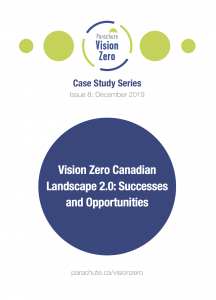
This case study reviews the current status of Canadian jurisdictions in the process of implementing or considering Vision Zero, presenting the key features of their programs. The study profiles 24 jurisdictions, including 14 interviews with local road safety advocates. These interviews discuss the successes and challenges faced by these programs with key stakeholders and provide advice for jurisdictions contemplating formal adoption of Vision Zero.
1,24 MB PDF
-
Cartographie Vision Zéro
-
Vision Zero map
-
Politique relative aux véhicules hors route
-
Législation sur les casques de vélo
-
Politique sur les commotions cérébrales
-
Législation sur les sièges d’appoint
-
Soumission terminée
-
Submission complete
-
Winnipeg, MB
-
Winnipeg, MB
-
Windsor, ON
-
Comté de Strathcona, AB
-
Strathcona County, AB
-
Ottawa, ON
-
Ottawa, ON
-
North Bay, ON
-
North Bay, ON
-
Leduc, AB
-
Leduc, AB
-
Comté de Grande Prairie No. 1
-
County of Grande Prairie No. 1
-
Kingston, ON
-
Kingston, ON
-
Durham Region, ON
-
Région de Durham, ON
-
Surrey, BC
-
Surrey, BC
-
Halifax, NS
-
Halifax, NS
-
Region of Peel, ON
-
Région de Peel, ON
-
Saskatoon, SK
-
Saskatoon, SK
-
Vancouver, BC
-
Vancouver, BC
-
Trois-Rivières, QC
-
Trois-Rivières, QC
-
Montreal, QC
-
Montréal, QC
-
Toronto, ON
-
Toronto, ON
-
London, ON
-
London, ON
-
Hamilton, ON
-
Hamilton, ON
-
Brantford, ON
-
Brantford, ON
-
Manitoba
-
Manitoba
-
St. Albert, AB
-
St. Albert, AB
-
Fort Saskatchewan, AB
-
Fort Saskatchewan, AB
-
Edmonton, AB
-
Edmonton, AB
-
Calgary, AB
-
Calgary, AB
-
British Columbia
-
Colombie-Britannique
-
Aviva Canada and Parachute partner up to make Canadian school zones safer
-
Aviva Canada s’associe à Parachute pour améliorer la sécurité dans les zones scolaires du pays
-
Télécharger votre trousse d’outils SRP
-
Liste de contrôle de la sécurité pour l’automobiliste et le piéton
-
Formulaire de décompte par observation
-
Questionnaire pour la personne qui s’occupe de l’enfant
-
Interventions
-
Votre équipe de direction SRP
-
Le processus SRP
-
Site audit
-
Pourquoi adopter Vision Zéro
-
Why adopt Vision Zero
-
Committing to Vision Zero – A Primer
-
S’engager pour Vision Zéro – Introduction
-
Follow these tips for a Happy Hallowe’en
-
Promouvoir votre projet SRP
-
Technology for Injury Prevention in Seniors (TIPS) Fall Videos
[Offered by Simon Fraser University] TIPS is a unique university-community partnership for developing new technologies to prevent falls and fall- related injuries in older adults. TIPS uses innovative approaches (such as video capture and wearable sensors) to determine the causes and circumstances of falls of older adults. We also develop and test the effectiveness of engineering interventions such as protective clothing and compliant flooring in reducing fall-related injuries.
-
Step Ahead to Fall Prevention Training
[Developed in partnership between York Region Public Health and Toronto Public Health] The e-learning module is for health care providers, caregivers and individuals who provide care to older adults. The program consists of two modules. Module 1 on Fall Prevention is available to complete online at your own pace.
-
Positive Steps Work
[Provided by Durham Region Health Department] This evidence-based course helps you to understand how a fall affects seniors, their family and the healthcare system. It looks at the risks that can lead to a fall; and caregiver, family and of seniors’ point of view and the importance of fall prevention. Finally, it helps to identify community resources to help prevent falls.
-
Prévention des chutes chez les personnes âgées – Cours d’apprentissage en ligne
[Développé par Santé Publique Ottawa et par le Réseau local d’intégration des services de santé de Champlain (RLISS)] Ce module s’adresse à toute personne qui s’occupe ou se préoccupe de la santé et de la sécurité de personnes âgées, particulièrement en matière de prévention des chutes, notamment :
• Les préposé(e)s aux services de soutien personnel;
• Les bénévoles auprès de personnes âgées;
• La famille et les ami(e)s;
• Les aînés qui s’occupent d’un proche ou d’autres aînés. -
Learn how to prevent falls
Developed by Ottawa Public Health and Champlain Local Health Integration Network (LHIN)This module is for anyone concerned about older adults who would like to learn valuable information regarding falls and fall prevention, such as:
• Personal support workers;
• Volunteers;
• Friends and family; and
• Older adults who support others close to them. -
Fall Prevention Module Accredited CME
[Produced by University of Ottawa and the Regional Geriatric Program of Eastern Ontario, in partnership with the Champlain Local Health Integration Network] Continuing Medical Education course for physicians and health-care professionals, covering the importance of the Fall Prevention program, screening and clinical assessing patients, and referring to Geriatric Services.
-
Fall Prevention Education Series
Provided by Upper Grand Family Health Team & VON Canada. A YouTube playlist. Presentations by allied health professionals from the Upper Grand Family Health Team & Wellington County area, filming and editing by Adam Olivero on behalf of Wightman Telecom (last updated Feb. 19, 2019).
-
Falls & Mobility
Falls & Mobility, offered by the Centre for Studies in Aging & Health, is an online educational course designed for health care providers’ continuing education and professional development. The course aims to improve knowledge about risk factors, recommendations for screening and management strategies.
-
Slips Trips and Fall Prevention e
Learning [Offered by the Public Services Health & Safety Association] Slips, trips and falls are common workplace occurrences that can result in serious injuries and disabilities to workplace parties. This course offers guidance on how to prevent injuries in the workplace that are the result of slips, trips or falls from the same level, and from heights. The purpose is to provide awareness and information on generic STF legislation, duties, responsibilities, hazard awareness and controls.
-
Community Care Slips, Trips and Falls
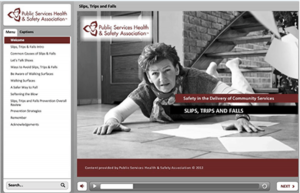
[Offered by the Public Services Health & Safety Association] This community care web tutorial will describe the risk of slipping, tripping or falling in the workplace and how you can protect yourself and prevent injuries.
These community care web tutorials were developed through a collaboration with the Ontario Association of Community Care Access Centres (OACCAC).
-
Review of E-Learning Opportunities in Fall Prevention
-
NTDSW images
-
Images SNSJV
-
Child fall prevention images
-
Illustrations – Prévention des chutes chez les enfants
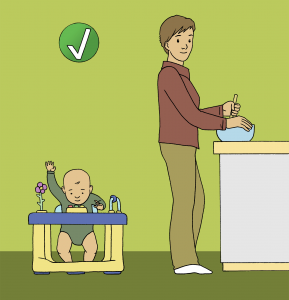
Ces images illustrent différents scénarios sur la façon de protéger les enfants contre les chutes à la maison et au jeu, comme par exemple prévenir les chutes des escaliers, des tables à langer, des chaises hautes, des poussettes, des fenêtres ou encore les chutes dans les aires de jeu.
17,49 MB ZIP
-
#Que
Signifie Facultés Affaiblies – GIF panneau lumineux -
Brain Waves resources
-
Teen Driver Safety Week focuses on risks of impaired driving
-
La Semaine nationale de la sécurité des jeunes au volant met l’accent sur les risques de la conduite avec facultés affaiblies
-
#Know
What Impaired Means Sign GIF -
#Know
What Impaired Means Bike Build GIF -
#Que
Signifie Facultés Affaiblies – Clip vidéo Échec rasage de cheveux -
#Know
What Impaired Means Line-up Fail GIF -
#Que
Signifie Facultés Affaiblies – Clip vidéo Épilation sourcils à la cire -
#Know
What Impaired Means Eyebrow Wax GIF You probably wouldn’t wax your eye brows high. So why would you drive high? #KnowWhatImpairedMeans
67,53 MB Vidéo
-
Spot Parachutisme (15 sec) – « Accepterais-tu qu’une personne gelée emballe ton parachute? »
-
Skydive (15 sec) – « Would you want someone who’s high packing your parachute? »
-
Spot Escalade (15 sec) – « Accepterais-tu qu’une personne gelée tienne ta corde de sécurité? »
-
Climbing (15 sec) – « Would you want someone who’s high holding your safety line? #Know
What Impaired Means » -
Spot Parachutisme (30 sec) – « Accepterais-tu qu’une personne gelée emballe ton parachute? »
-
Skydive (30 sec) – « Would you want someone who’s high packing your parachute? »
-
Spot Escalade (30 sec) – « Accepterais-tu qu’une personne gelée tienne ta corde de sécurité? »
-
Climbing (30 sec) – « Would you want someone who’s high holding your safety line? #Know
What Impaired Means » -
Vision Zero in Canada (webinar) (2019)
-
Vision Zero Canadian Landscape: Learning from Key Stakeholder Experiences (2019)
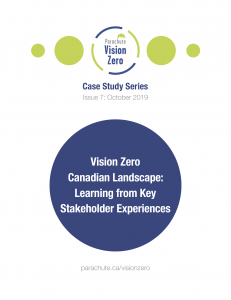
This case study shares interview responses from nine Canadian cities, regions and provinces implementing Vision Zero. These interviews discuss the successes and challenges faced by these programs with key stakeholders, and provide advice for jurisdictions that are contemplating formal adoption of Vision Zero.
1,06 MB PDF/UA
-
Vision Zéro – La situation au Canada : apprendre des expériences des parties prenantes clés (2019)
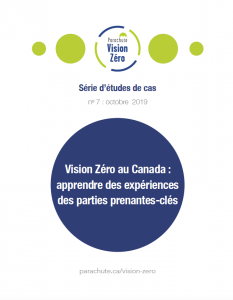
Cette étude de cas partage les réponses de neuf villes canadiennes, régions et provinces interrogées mettant en place Vision Zéro. Ces interviews abordent les succès et difficultés rencontrés au cours des programmes avec les parties prenantes clés et fournit des conseils pour les juridictions qui envisagent l’adoption de Vision Zéro.
1,06 MB PDF/UA
-
NTDSW proclamation request template
-
NTDSW proclamation template
-
Fall Proof Your Home video
-
Faites partie du Réseau
-
Join the network
-
Open your Parachute!
-
Ouvrez votre parachute !
-
Présentation de parachute.ca
-
Introducing parachute.ca
-
Sécurité Routière Primaire
-
Elementary Road Safety
-
Elementary Road Safety resource kit
-
Trousse de ressources Sécurité routière primaire
-
Download your ERS resource kit
-
Promote your ERS project
-
Walking School Bus Guide, Ottawa Student Transportation Authority
-
Programme scolaire pédestre Bus (WSB), Ottawa Student Transportation Authority
-
Interventions
-
Caregiver questionnaire
-
Observational counts
-
Observing driver and pedestrian behaviour
-
Formulaire de contrôle de site
-
City of Toronto Traffic Calming Guide
-
The ERS process
-
Your ERS leadership team
-
Smart Hockey
-
Guide pour les réseaux sociaux
-
Social Media Guide
-
Positive Ticketing Activity Guide
-
Activité – Événement Contraventions positives
-
Photobooth Selfie Activity Guide
-
Activité – Kiosque à photos pour égoportraits
-
Key Messages
-
Messages clés
-
Backgrounder
-
Fiche d’information
-
« We Play Smart Hockey » sign lettering
-
Panneau lettres « Jouez au Hockey Intelligent »
-
#Know
What Impaired Means video -
Test
-
Newsletter Signup
-
NHL/NHLPA 2019 Concussion Education Video
-
Mesurer les inégalités en santé : trousse d’outils
-
Measuring Health Inequalities: A Toolkit
-
“Walk Safe” en français
-
Help make back to school safer for Canadian children
-
Aidez à rendre la rentrée scolaire plus sécuritaire pour les enfants canadiens
-
Government of Canada implements new regulations to help stop strangulation deaths linked to corded window coverings
In 2019, Canada improved regulations that govern how corded window coverings can be manufactured. Parachute’s President and CEO Pamela Fuselli is quoted in this news release.
-
Le gouvernement du Canada met en œuvre un nouveau règlement pour contribuer à mettre fin aux décès par strangulation liés aux couvre-fenêtres à cordes
En 2019, le Canada a amélioré les réglementations sur la fabrication des couvre-fenêtres à cordes. Pamela Fuselli, Présidente-directrice générale de Parachute est citée dans ce communiqué de presse.
-
2018 Annual Report
-
Parachute Annual Report 2018
-
Autres modes de transport
How to safely transport your child on school buses, airplanes, taxis, ride shares and motor homes.
-
Brain Waves instructor guide
-
Guide de l’instructeur Ondes cérébrales
-
Fiche éducative transmise avant le début de la saison (2025)
-
Pre-season concussion education sheet (2025)
-
L’affiche « #Jouez
Au Hockey Intelligent » 
Encouragez votre équipe et tout ceux qui sont impliqués à prendre l’engagement Hockey intelligent en posant avec l’affiche « #JouezAuHockeyIntelligent ». Avec leur accord, publiez cette photo sur le site web et les médias sociaux de votre équipe et/ou de votre ligue en utilisant le mot-clic #JouezAuHockeyIntelligent.
593,60 KB PDF/UA
-
« We Play Smart Hockey » sign guide
-
Guide des médias sociaux Le hockey intelligent (2025)
-
Smart Hockey social media guide (2025)
-
Stratégie de reprise des activités sportives (2025)
-
Avant-saison – Guide de réunion d’équipe d’éducation sur les commotions cérébrales (2025)
-
Pre-season concussion education team meeting guide (2025)
-
Liste de contrôle d’éducation sur les commotions cérébrales (2025)
-
Pre-season concussion education checklist (2025)
-
Dossier personnel des commotions cérébrales pour les joueurs
-
Personal concussion record for players
-
Guide en ligne Le hockey intelligent
-
Smart Hockey online guide
-
Conseils à utiliser sur la glace par les joueurs (2025)
-
On-ice tips for players (2025)
-
Conseils à utiliser sur la glace pour prévenir les commotions cérébrales et diverses autres blessures subies au hockey (2025)
-
On-ice tips to assist in preventing concussion and other injuries in hockey (2025)
-
Guide sur les commotions cérébrales pour les joueurs (2025)
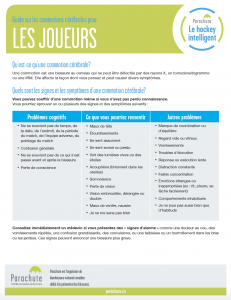
Ce guide fournit aux joueurs de hockey les informations nécessaires sur les signes et symptômes d’une commotion cérébrale pour qu’ils puissent mieux les comprendre et les reconnaitre que ce soit sur la glace ou en dehors. Ce guide permet également aux joueurs de savoir quoi faire s’ils identifient qu’eux-mêmes ou leurs coéquipiers souffrent de ces symptômes.
2,12 MB PDF/UA
-
Concussion guide for players (2025)

This handout provides hockey players with information on the signs and symptoms of a concussion so they can better understand and recognize concussion symptoms on and off the ice. This guide also helps players know what to do if they notice concussion symptoms in themselves or their teammates.
2,14 MB PDF/UA
-
Guide sur les commotions cérébrales à l’intention des entraîneurs, des soigneurs et du personnel de sécurité (2025)
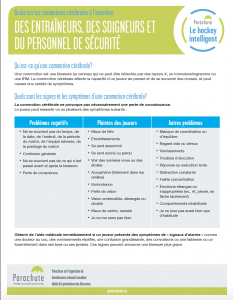
Ce guide aide les entraîneurs, soigneurs et le personnel de sécurité à reconnaitre les signes et symptômes d’une commotion, que le joueur se soit blessé sur la glace, à la maison ou à l’école. Cela permet aux entraîneurs de comprendre les étapes requises pour le retour du joueur à la pratique du hockey en toute sécurité.
213,58 KB PDF/UA
-
Concussion guide for coaches, trainers and safety personnel (2025)
-
Guide sur les commotions cérébrales pour les parents et les fournisseurs de soins (2025)
-
Concussion guide for parents and caregivers (2025)
-
Code de conduite en cas de commotions cérébrales pour les joueurs (2025)
-
Concussion code of conduct for players (2025)
-
Code de conduite en cas de commotions cérébrales pour les parents et fournisseurs de soins (2025)
-
Concussion code of conduct for parents and caregivers (2025)
-
Code de conduite en cas de commotions cérébrales pour les entraîneurs, soigneurs et le personnel de sécurité (2025)
-
Concussion code of conduct for coaches, team trainers and safety personnel (2025)
-
Plan d’action Le hockey intelligent (2025)
-
Smart Hockey action plan (2025)
-
#Que
Signifie Facultés Affaiblies Mis à jour Cette campagne publique de sensibilisation vise à informer les Canadiens que le cannabis nuit à la capacité d’une personne de conduire un véhicule automobile en toute sécurité.
-
#Know
What Impaired Means Mis à jour This public awareness campaign aims to educate Canadians that cannabis impairs a person’s ability to safely operate a motor vehicle.
-
Ressources sur les commotions cérébrales pour les professionnels de la santé
-
Ressources des protocoles sur les commotions cérébrales pour les organisations sportives
-
Ressources des protocoles sur les commotions cérébrales pour les écoles
-
Lignes directrices canadiennes sur les commotions cérébrales dans le sport
-
Projet d’harmonisation des Lignes directrices et des protocoles sur les commotions cérébrales
-
Trousse d’outils sur le jeu libre – Association canadienne de santé publique
Infographies, pratiques prometteuses, résumé des recherches, outils pour la prise de décision et documents relatifs à la question du jeu libre.
-
Unstructured play toolkit – Canadian Public Health Association
Infographics, promising practices, research summaries, decision making tools and discussion documents related to unstructured play.
-
Jeux d’extérieur non structurés : perceptions vs. faits
-
Unstructured play: perceptions vs. facts
-
Children’s unstructured play – Canadian Public Health Association position statement (2019)
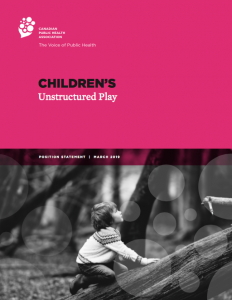
The Canadian Public Health Association (CPHA) recognizes unstructured play as a child’s right and a critical component to child and youth health and well-being. Actions are necessary to reduce the barriers limiting opportunities for unstructured play at school and in the community. CPHA commends those school boards, municipalities, other governments and non- governmental organizations that are taking positive steps to improve children’s access to unstructured play; however, further steps are needed.
-
Le jeu libre des enfants – Association canadienne de santé publique (2019)

L’Association canadienne de santé publique (ACSP) reconnait le jeu libre comme un droit de l’enfant et une composante essentielle de la santé et du bien-être des enfants et des jeunes. Il est nécessaire d’agir pour favoriser les opportunités du jeu libre à l’école et des les communautés. ACSP félicite les conseils scolaires, municipalités, autres instances gouvernementales et organisations non gouvernementales qui agissent en faveur de l’amélioration de l’accès des enfants au jeu libre ; bien qu’il soit nécessaire d’aller encore plus loin.
-
Vision Zéro ville de Montréal 2022-2024
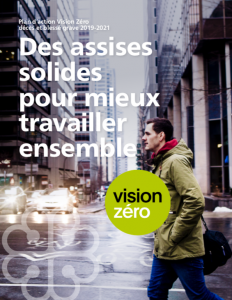
Ce plan d’action de la ville de Montréal s’inspire de l’approche Vision Zéro qui a apporté des résultats probants dans plusieurs villes du monde qui l’ont appliquée rigoureusement. Il est le fruit d’une concertation entre la Ville de Montréal et tous les acteurs concernés par la sécurité des usagers de la route.
-
Child carriers and trailers
-
Transport Canada
Contact Transport Canada for more information on safety during transportation.
-
Pace car handout
-
Pace Car community guide
-
What’s speed got to do with it?
-
How to improve pedestrian safety – Guide for communities
-
Aperçu du programme de Voiture pilote
-
Vision Zero in Canada: The Canadian Association of Road Safety Professionals (2019)
-
Articles de blogue
-
Vidéos et webinaires
-
Infographies
-
Études de cas
A quarterly series featuring real-world examples of what Vision Zero is and how it’s currently being done in Canada.
-
Le Groupe CSA « Canadian Standards Association »
Le Groupe CSA « Canadian Standards Association » a développé le seul standard reconnu nationalement sur les équipements et aires de jeu pour enfants.
-
Canadian Standards Association (CSA)
The Canadian Standards Association (CSA) has developed the only nationally recognized standard on children’s playspaces and equipment.
-
Pace Car media advisory template
-
Pace Car media release template
-
Clôtures de piscine sécuritaires – Tableau de la législation canadienne
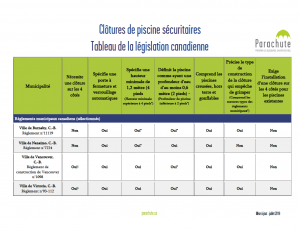
Ce tableau décrit quelle municipalité ou province canadienne :
- Requiert une clôture sur les 4 côtés
- Spécifie une porte à fermeture et verrouillage automatiques
- Spécifie une hauteur minimale de 1,2 mètre (4 pieds)
- Définit la piscine comme ayant une profondeur d’eau d’au moins 0,6 mètre (2 pieds)
- Comprend les piscines creusées, hors terre et gonflables
- Précise le type de construction de la clôture qui empêche de grimper
- Exige l’installation d’une clôture sur les 4 côtés pour les piscines existantes
148,24 KB PDF/UA
-
Safer pool fencing legislation chart
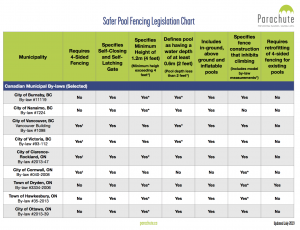
This chart outlines which Canadian municipality and province:
- Requires 4-sided fencing
- Specifies self-closing and self-latching gate
- Specifies minimum height of 1.2 m (4 feet)
- Defines pool as having a water depth of at least 0.6 m (2 feet)
- Includes in-ground, above ground and inflatable pools
- Specifies fence construction that inhibits climbing
- Requires retrofitting of 4-sided fencing for existing pools
198,16 KB PDF/UA
-
Distracted driving Canadian legislation chart
-
Cyclisme – Tableau de la législation canadienne
-
Cycling Canadian legislation chart
-
Carbon monoxide detector and smoke detector Canadian legislation chart
-
Avertisseurs de monoxyde de carbone et avertisseurs de fumée – Tableau de la législation canadienne
-
Car seat and booster seat Canadian legislation chart
-
Sièges d’auto et sièges d’appoint – Tableau de la législation canadienne
-
Casques de vélo – Tableau de la législation canadienne
-
Bicycle helmet Canadian legislation chart
-
Véhicules tout-terrain (VTT) – Tableau de la législation canadienne
-
All-terrain vehicle Canadian legislation chart
-
Canadian Injury Prevention Resource
-
Radon Reduction Guide for Canadians (2023)
-
Le radon – Guide de réduction pour les Canadiens (2013)
-
Testing for Radon – Take Action on Radon
Testing for radon is simple to do and should be done in every home – here’s how to test your home for radon.
-
Dépistage du Radon – Occupe toi du Radon
Le dépistage du radon est simple à faire et devrait être effectué dans chaque foyer. Voici comment dépister le radon dans votre maison.
-
Concussion Ed, l’App mobile
-
Concussion Ed app
-
Rapport En Rythme de Participaction 2018
-
Participaction Pulse Report 2018
-
Infographie Rapport En Rythme de Participaction sur l’activité physique, 2018
-
Infographic from Participation Pulse Report on physical activity, 2018
-
Concussion Ed app
-
Concussion Ed, l’App mobile
-
Défense des intérêts et politique publique
Accédez à des résumés et à des rapports sur les politiques, les lois et les normes qui peuvent être utilisés pour promouvoir des changements positifs.
-
Formations et webinaires
Trouver de l’information pour la formation professionnelle et l’éducation et des publications de lignes directrices pour aider à orienter la pratique clinique.
-
Rapports, statistiques, recherches, et lignes directrices
Les données probantes actuelles sont essentielles à la compréhension de la question. Il s’agit de la première étape pour accéder aux publications et aux documents clés qui vous permettront d’éclairer votre travail.
-
Programmes, communautés de pratique et initiatives
Du Mois de la prévention des chutes à Avancez de pied ferme, des programmes et des initiatives de sensibilisation sont offerts partout au Canada, à l’échelle régionale et nationale, pour prévenir les blessures graves causées par les chutes.
-
La conduite après usage de cannabis et les jeunes
-
Cannabis, driving and implications for youth
-
Taste bud mapping activity
-
FAQ pour les participants Ondes cérébrales
-
Brain Waves participant FAQ
-
Manuel du coordinateur de site Ondes cérébrales
-
Brain Waves site co-ordinator manual
-
Activité « Localisation des papilles gustatives »
-
Know your role: Other staff/volunteers
-
Fall Prevention and Cognitive Impairment: Inventory of resources and learning opportunities for caregivers (2018)
-
Guide d’activité – Adaptation olfactive
-
Formation en ligne sur le cerveau
-
Know your role: Athletic directors, coaches, teachers and other supervisors
-
Pendant combien de temps les sièges d’auto pour enfant et les sièges d’appoint sont-ils sécuritaires ? – Transports Canada
-
How long are child car seats and booster seats safe? – Transport Canada
-
Securing furniture and TVs: Tips for parents
Download our tip sheet on securing furniture and televisions.
90,51 KB PDF/UA
-
Rail safety: Tips for parents
-
Rail safety: Tips for teens
-
Rail safety: Tips for kids
-
Out of sight and locked up tight: Tips for Parents
-
Helmet safety activity – melon drop
-
Helmet safety activity – egg drop
-
Wrestling Return-to-Sport Strategy
-
Water Polo Return-to-Sport Strategy
-
Volleyball Return-to-Sport Strategy
-
Softball Return-to-Sport Strategy
-
Soccer Return-to-Sport Strategy
-
Ski Jumping Return-to-Sport Strategy
-
Sailing Return-to-Sport Strategy
-
Rugby Return-to-Sport Strategy
-
Nordic Return-to-Sport Strategy
-
Judo Return-to-Sport Strategy
-
Hockey Return-to-Sport Strategy (2025)
-
Freestyle Ski Return-to-Sport Strategy
-
Field Hockey Return-to-Sport Strategy
-
Equestrian Return-to-Sport Strategy
-
Curling Return-to-Sport Strategy
-
Cross-country Ski Return-to-Sport Strategy
-
Canoe and Kayak Return-to-Sport Strategy
-
Badminton Return-to-Sport Strategy
-
Artistic Gymnastics Return-to-Sport Strategy
-
Alpine Ski Return-to-Sport Strategy
-
Player code of conduct
Have players sign this code of conduct to agree to respect themselves and respect others at play.
-
Code de conduite pour les joueurs et les joueuses
Faites signer aux joueurs ce code de conduite de respect des autres et d’eux-mêmes au jeu.
-
Bike Safe English PSA
-
Know What Impaired Means
Parachute’s one minute video on « Know What Impaired Means ».
-
Terms of Use and Privacy Policy
-
Conditions d’utilisation et politique de confidentialité
-
Walk + Roll Peel
Walk + Roll Peel promotes Peel’s bicycle and pedestrian initiatives and infrastructure as well as the benefits of active transportation. They are committed to getting more people walking and cycling- instead of driving- for everyday trips.
-
Active & Safe Routes to School Program
-
Transport scolaire actif et en sécurité
-
Ontario Active School Travel
Ontario Active School Travel is an Ontario-wide program dedicated to children’s mobility, health and happiness.
-
Transport scolaire actif en Ontario
Transport scolaire actif en Ontario est un large programme ontarien dédié à la mobilité des enfants, à la santé et au bien-être.
-
National Drowning Report infographic (2024)
-
Rapport national sur la noyade infographie (2024)
Cette infographie résume la plupart des données de 2015 à 2019 sur les décès liés à l’eau disponibles auprès des bureaux des coroners en chef et des médecins légistes du Canada. Préparé pour la Lifesaving Society par le Drowning Prevention Research Centre Canada.
-
Sandra Padovani
-
Liste de vérification du protocole canadien harmonisé sur les commotions cérébrales dans le sport
Un outil pour vous assurer que votre protocole de commotion cérébrale soit en accord avec les Lignes directrices canadiennes sur les commotions cérébrales dans le sport.
64,26 KB Word
-
Canadian harmonized sport concussion protocol checklist
A tool to help you ensure your concussion protocol aligns with the Canadian Guideline on Concussion in Sport.
39,99 KB Word
-
Statement on Concussion Baseline Testing in Canada
-
Strangulation and suffocation
Safety tips for parents to prevent strangulation and suffocation in children around the house.
-
White Paper on the Prevention of Poisoning of Children in Canada (2011)
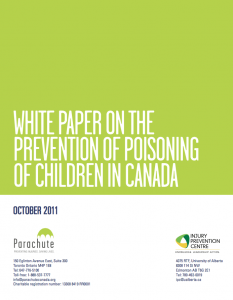
The white paper provides background about the poisoning problem in Canada, identify the key concepts, theories sources of evidence and gaps in knowledge relating to poisoning in Canada. Focus is placed on children as they are a population vulnerable to poisoning and have historically been the target for poisoning prevention interventions.
1,54 MB PDF
-
Home safety for your kids’ sake
-
Une maison sécuritaire pour le bien de vos enfants
-
P.A.R.T.Y. (Prevent Alcohol and Risk-Related Trauma in Youth) Program
The P.A.R.T.Y. (Prevent Alcohol and Risk-Related Trauma in Youth) Program is a one-day injury awareness and prevention program for youth age 15 and older. Developed in 1986 at Sunnybrook Health Sciences Centre, this program is a vital component of the growing community effort to reduce death and injury in alcohol, drug and risk-related crashes and incidents.
-
Pub
Med Central Canada Pub Med Central Canada is a new initiative launched in 2009 that provides free access to peer-reviewed Canadian health and life sciences literature, including CIHR-funded research.
-
Pub
Med PubMed is the U.S. National Library Medicine’s freely available database of medical literature and can be used to search injury research.
-
Safety
Lit SafetyLit is an injury research database that provides a weekly e-mail update with summaries of research articles and reports on injury prevention from a variety of disciplines that are relevant to preventing unintentional injuries, violence and self-harm. SafetyLit service scans more than 3,000 scholarly international journals, conference proceedings, government and agency reports to develop these summaries.
-
Injury Prevention
This is an international journal dedicated to injury prevention and includes peer-reviewed articles that focus on injury for all ages. Injury Prevention regularly includes a News and Notes section and many other special features including brief reports, editorials, commentaries, policy forums, fillers, book reviews and correspondence.
-
National Centre for Injury Prevention and Control – Centers for Disease Control and Prevention
The CDC’s National Center for Injury Prevention and Control is the lead national agency in the United States for injury prevention. The Center’s website lists injury reports and research summaries on a large number of unintentional and intentional injury topics.
-
Health Evidence – Données probantes de santé publique
Health Evidence est une base de données gérée par le Centre de collaboration nationale des méthodes et outils. Health Evidence propose des évaluations de la qualité de synthèses de données probantes publiées et examinées par des pairs. Elles sont évaluées en fonction de l’efficacité et de la rentabilité des interventions en santé publique.
-
Health Evidence
Health Evidence is a database maintained by the National Collaborating Centre for Methods and Tools. Health Evidence includes quality-appraisals on peer reviewed, published evidence syntheses evaluating the effectiveness and cost-effectiveness of public health interventions.
-
The Cochrane Library Reviews
The Cochrane Library is a collection of databases and systematic reviews that contain high-quality, independent evidence that can inform healthcare decision-making.
-
Injuries from carbon monoxide poisoning in Ontario (2017)
-
Trauma hospitalizations in Ontario (2015)
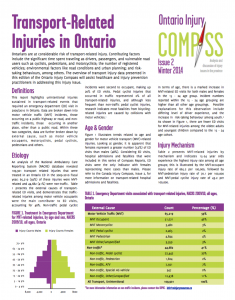
Based on data collected at Ontario’s Lead Trauma Hospitals, this issue of the Ontario Injury Compass presents counts and characteristics for hospitalizations due to traumatic injury in Ontario. The report also highlights evidence-informed prevention strategies for this injury issue.
208,72 KB PDF/UA
-
Bicycling-related ED visits in Ontario: A focus on children and youth (2015)
-
Drowning-related ED visits in Ontario: A focus on infants, children and youth (2014)
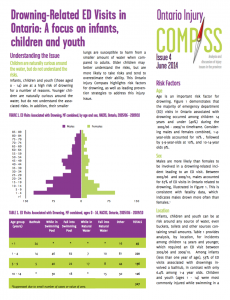
Drowning is an important issue for Ontario residents as we move into the summer months. This issue looks at ED visits associated with drowning, and discusses important prevention strategies such as improved legislation for pool fencing, lifejackets, adult supervision, CPR, and swimming lessons.
205,79 KB PDF/UA
-
Safe School Zones (2018)
-
La sécurité des piétons à l’école (2018)
-
The Canadian landscape (2017)
-
La situation au Canada (2017)
-
Dr. Ian Pike
-
Dr. Ian Pike
-
Guide d’activité – Démonstration de la discrimination tactile
-
Two point discrimination demonstration activity guide
-
Recette du cerveau en gélatine
-
Brain mold recipe
-
Taste bud mapping activity guide
-
Guide d’activité – Cartographie des papilles gustatives
-
Know your role: Principal
-
Know your role: Collaborative team school staff lead
-
Guide d’activité – Localisation du son
-
Sound localization activity guide
-
Scrambled brain activity guide
-
Guide d’activité – Cerveau perturbé
-
Guide d’activité – Passer la note
-
Passing the note activity guide
-
Olfactory adaptation activity guide
-
Guide d’activité – Nommer les lobes
-
Naming the lobes activity guide
-
Guide d’activité – Images consécutives en couleur
-
Colour afterimage activity guide
-
Guide d’activité – Tache aveugle
-
Blind spot activity guide
-
Helmet fitting activity guide
-
Guide d’activité – Ajustement de casque
-
L’odorat – Activité « Adaptation olfactive »
-
Smell (olfactory adaptation) activity
-
Home Care Knowledge Network – Canadian Home Care Association
Explore the Knowledge Centre to find tools, educational modules, and informative reports to address more than 70 identified home care challenges. Choose the home care principle, select a specific policy or program issue and download the resource.
-
Portal for tools and resources – Canadian Patient Safety Institute
-
Que faire en cas de chute…
-
What to do after a fall…
-
Collectivités-amies des aînés – Agence de la santé publique du Canada
Ce site Web de l’Agence de la santé publique du Canada décrit l’initiative des collectivités-amies des aînés, explique ce qui constitue une collectivité-amie des aînés et fournit des renseignements sur les collectivités canadiennes qui s’efforcent de soutenir la santé et le mieux-être des aînés.
Le concept des collectivités-amies des aînés est de concert avec la prévention des chutes chez les aînés puisque le premier couvre les éléments de sécurité nécessaires à une collectivité-amie des aînés, tels que les espaces extérieurs et publics.
-
Age-friendly communities – Public Health Agency of Canada
This website from the Public Health Agency of Canada describes the Age-Friendly Communities initiative, explains what makes a community age-friendly and provides information about Canadian communities that are striving to support the health and well-being of older people.
-
Loi visant à faire du Canada un pays exempt d’obstacles (2019)
La Loi canadienne sur l’accessibilité favorise la participation pleine et égale dans la société de toutes les personnes, en particulier les personnes handicapées. La loi vise à parvenir à cette fin par la transformation du Canada, dans le champ de compétence législative du Parlement, en un pays exempt d’obstacles, particulièrement par la reconnaissance, l’élimination et la prévention d’obstacles.
-
Bill C-81 An Act to ensure a barrier-free Canada (2019)
The Accessible Canada Act enhances the full and equal participation of all persons, especially persons with disabilities, in society. This is to be achieved through the realization, within the purview of matters coming within the legislative authority of Parliament, of a Canada without barriers, particularly by the identification, removal and prevention of such barriers.
-
A Dementia Strategy for Canada: Together We Aspire (2019)
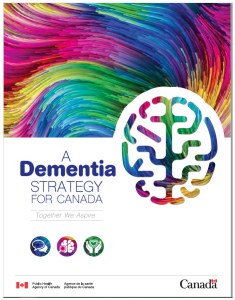
The Public Health Agency of Canada shares Canada’s first national strategy on dementia to set out a vision for the future and identifies common principles and national objectives to help guide actions by all levels of government, non-governmental organizations, communities, families and individuals.
-
Une stratégie sur la démence pour le Canada : Ensemble, nous y aspirons
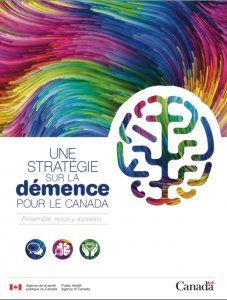
La première stratégie nationale sur la démence du Canada établit une vision pour l’avenir et définit des principes et des objectifs nationaux communs pour aider à orienter les mesures prises par tous les ordres de gouvernement, les organisations non gouvernementales, les collectivités, les familles et les particuliers.
-
La prévention des chutes chez les aînés et les déterminants sociaux de la santé dans la perspective des politiques sociales
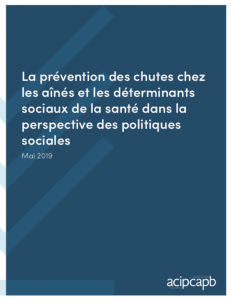
Créé par La Collaboration atlantique pour la prévention des blessures (CAPB), ce document sert à :
- Offrir des données contextuelles sur les blessures liées aux chutes chez les aînés;
- Souligner les déterminants sociaux de la santé et les preuves qui établissent un lien entre ces déterminants et la prévention des chutes chez les aînés;
- Proposer des activités qui traitent des déterminants sociaux de la santé dans le cadre de la prévention des chutes chez les aînés et enfin;
- Souligner les initiatives de prévention des chutes chez les aînés actuellement offertes dans chaque province de l’Atlantique et offrir des exemples de politiques sociales qui pourraient s’ajouter aux travaux actuels de prévention des chutes chez les aînés.
-
Seniors’ Fall Prevention and the Social Determinants of Health: A Social Policy Lens (2019)
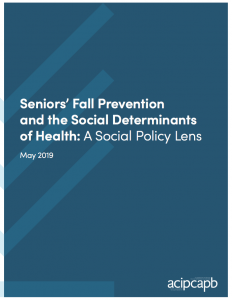
Produced by the Atlantic Collaborative on Injury Prevention (ACIP), this document:
- Provides background information on fall-related injuries among seniors;
- Highlights the social determinants of health and the evidence linking them to seniors’ fall prevention;
- Discusses activities that seek to address the social determinants of health in preventing falls among seniors; and, lastly,
- Highlights current seniors’ fall prevention initiatives by each Atlantic province and provides examples of social policies that could enhance and/or complement seniors’ fall prevention efforts.
-
Medication Use and Seniors (2017)
Canadian Medical Association policy update 2017.
-
Occupational therapists on home modification teams
-
Occupational therapy and fall prevention
-
Re-shaping the Housing Market for Aging in Place and Home Modifications (2017)
-
Long-term Care Best Practices Toolkit (2nd edition, 2018): Fall Prevention and Management
The following resource is designed to assist Long-Term Care (LTC) homes with the implementation of the Prevention of Falls and Fall Injuries in the Older Adult Best Practice Guideline. Provided by the Registered Nurses’ Association of Ontario.
-
Healthy Aging through Fall Prevention among Older Aboriginal People (2011)
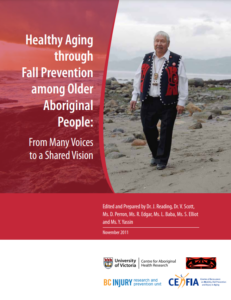
The Centre for Aboriginal Health Research, the Centre of Excellence on Mobility, Fall Prevention and Injury in Aging, the BC Injury Research and Prevention Unit, the BC Seniors Secretariat, and the University of Victoria Centre on Aging hosted a two-day symposium exploring the elements of an Aboriginal approach to Fall Prevention. The following report summarizes the agenda and rationale for the Symposium, the role of knowledge translation, key themes and emerging discussions, information generated, and suggestions for the next steps for creating an Aboriginal approach to fall prevention.
-
The Next Wave of Fall Prevention in British Columbia
This Special Report by the BC Fall and Injury Prevention Coalition provides an overview of the current state of fall prevention activities in BC and directions for the future based on a ‘capacities and gaps’ analysis.
-
Reducing Falls and Injuries from Falls Getting Started Kit
The Falls GSK was developed as part of the Canadian Patient Safety Institute’s signature program, Safer Healthcare Now! The Falls GSK was developed to engage interdisciplinary teams in a dynamic approach for improving quality and safety on the topic of falls prevention.
-
Guide des ressources disponibles sur la prévention des chutes – À l’intention des prestataires de soins
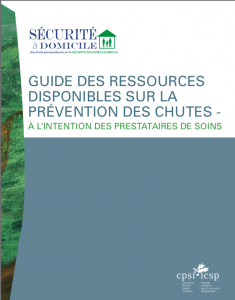
Une revue de la littérature grise canadienne montre que beaucoup de travail a été fait et que de nombreuses ressources ont été créées dans ce domaine, partout au Canada; cependant, il y a un manque d’infrastructures qui permettraient de partager et d’utiliser ces ressources, et il n’existe pas de stratégie nationale en matière de réduction des chutes dans les soins à domicile. Les ressources regroupées dans cette trousse, en provenance de sources nationales, provinciales et régionales, tentent de combler cette lacune. Produit par l’Institut canadien pour la sécurité des patients.
-
The Federal Role in Eye Health and Vision Care
-
Better Vision for Seniors: A Public Health Imperative (2017)
-
Centre of Excellence on Mobility, Fall Prevention and Injury in Aging – Centre for Hip Health Research & Mobility, BC
CEMFIA represents a unique collaborative of researchers, health care providers and policy makers with a shared goal of improving the health and safety of older British Columbians. Our mandate is to enhance mobility and reduce the risk for falls and fall-related injuries among older British Columbians, in partnership with the BC Fall and Injury Prevention Coalition, the CHHM, the BC Injury Research and Prevention Unit, University partners, and other fall prevention stakeholders in British Columbia.
-
Canadian Centre for Activity and Aging – University of Western Ontario
The CCAA is a unique, national research and education centre within the Faculty of Health Sciences at Western. It promotes physical activity and well-being for older adults through a combination of basic and applied research, education, and community-based exercise programs. Its education and leadership training programs instruct thousands of individuals across Canada in standard, evidence-based practices to enhance the functional fitness of older adults at every level of mobility.
-
Dementia and falls – Canadian Institute for Health Information (2018)
This webpage from the Canadian Institute for Health Information (CIHI) provides a spotlight on data relating to falls among older adults with dementia.
-
Démence et chutes – Institut canadien d’information sur la santé (2018)
-
Falls and vehicle collisions top causes of injury hospitalizations for seniors – Canadian Institute for Health Information
-
Chutes et collisions impliquant un véhicule : les principales causes d’hospitalisation à la suite d’une blessure chez les aînés – Institut canadien d’information sur la santé (2019)
-
Indigenous Fall Prevention Symposium Report to the Public Health Agency of Canada (2018)
This report, prepared by Dr. Vicky Scott, presents the Indigenous Fall Prevention Symposium’s findings and recommendations to the Public Health Agency of Canada.
-
Slips, trips and falls: Our newest data reveals causes of injury hospitalizations and ER visits in Canada – Canadian Institute for Health Information (2019)
This resource, created by the Canadian Institute for Health Information, provides valuable insights into slips, trips, and falls as causes of injury hospitalizations and emergency room visits in Canada.
-
Glissades, faux pas et chutes : nos plus récentes données révèlent les causes des hospitalisations et des visites à l’urgence à la suite d’une blessure au Canada – Institut canadien d’information sur la santé
-
Fall and injury prevention – Mc
Master Optimal Aging Portal Consult evidence-based blog posts, web resource ratings and evidence summaries for trustworthy information about health and social aspects of aging.
-
Falls Prevention Clinic – Vancouver Coastal Health
Enhancing mobility while preventing falls and fractures through evidence-based practice and research.
-
Homecare Safety Virtual Quality Improvement Collaboratives
A cutting-edge approach to falls management in the home setting, launched by the The Canadian Home Care Association, together with the Canadian Patient Safety Institute and the Canadian Foundation for Healthcare Improvement. Through shared learning, teams from a different jurisdictions and provider types work with each other and recognized safety experts to rapidly test and implement changes that lead to sustained improvement.
-
Falls Prevention Program – Toronto Rehabilitation Institute
The Falls Prevention Program helps patients prevent falls. At your first visit, you will be seen by a nurse, physiotherapist and doctor to identify why you have been falling. They work with you on your physical abilities, provide you with recommendations for lifestyle changes and discuss with you whether you need to modify your home to make sure you’re safe. In making assessments, they check your balance, mobility, muscle strength and if you have a fear of falling.
-
Seniors Maintaining Active Roles Together (SMART)
Community-based, volunteer-led exercise programs for seniors that accommodate all levels of ability.
-
Programme d’exercices pour les aînés (SMART)
Des programmes communautaires d’exercices pour les aînés animés par des bénévoles et adaptés à tous les niveaux de capacité.
-
Together In Movement and Exercise (TIME™)
Health care and community organizations working together to make exercise more accessible, do-able and fun! The group exercise program is designed by physiotherapists at Toronto Rehab, and led by fitness instructors in community centres across the country, presently in dozens of locations and growing.
-
Home Modification Council – Canadian Home Builders’ Association
This Council supports many aspects of aging in place for Canada’s seniors and for persons with disabilities and their caregivers, including: appropriate home modifications; appropriate training for renovators; access to occupational therapists, trained architects/designers, and community care professionals; information about disability funding organizations, government loans, grants & tax credits, and assistive device and industry representatives.
-
Loop, Fall Prevention Community of Practice
Loop is the online communication platform that brings together frontline workers, practitioners, caregivers, researchers and policy planners working for the health and independence of the public through fall prevention. Loop is a place to problem-solve together and discuss how to implement evidence-informed and promising practices.
-
Loop, Communauté engagée pour la prévention des chutes
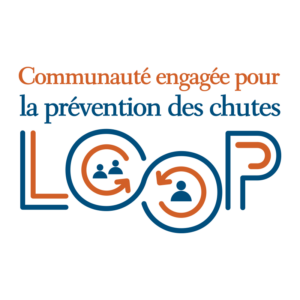
Loop est la plateforme de communication en ligne qui permet de rassembler les travailleurs, les praticiens, les aidants, les chercheurs, les groupes d’aînés et les responsables de l’élaboration des politiques qui œuvrent à assurer la santé et l’autonomie des aînés par l’entremise d’activités de prévention des chutes. Loop permet à ses membres de se rassembler pour trouver des solutions aux problèmes et discuter des moyens d’instaurer des pratiques prometteuses et fondées sur des données probantes.
-
Le hockey intelligent Mis à jour
-
Stay on Your Feet – Timiskaming Health Unit
-
Stay on Your Feet – North East Local Health Integration Network
-
Stay on Your Feet – North Bay Parry Sound District Health Unit
-
Clinical Best Practice Guidelines: Preventing Falls and Reducing Injury from Falls (Fourth Edition, 2017)
-
Strategies and Actions for Independent Living
The Strategies and Actions for Independent Living (SAIL) fall prevention program is an evidence-based fall prevention program designed for community health workers (CHWs) and home health professionals (HHPs) who provide support to clients who receive home support services.
-
Advocacy and public policy
Access summaries and reports related to policy, legislation, and standards that can be used to advocate for positive change.
-
Reports, statistics, research, guidelines and fact sheets
Current evidence is essential to understanding the issue. This is the first-stop to accessing key publications and documents to inform your work.
-
Programs, communities of practice and initiatives
From Fall Prevention Month to Stay on Your Feet, programs and awareness initiatives are offered across Canada, both regionally and nationally, to prevent serious injuries from falls.
-
Training, conferences and webinars
Find information for professional training and education, and published guidelines to help direct clinical practice.
-
Canadian Frailty Network – Réseau canadien des soins aux personnes fragilisées
Le Réseau canadien des soins aux personnes fragilisées est le seul regroupement au Canada à se consacrer à l’amélioration des soins destinés aux Canadiens âgés et fragilisés et du soutien offert à leur famille et leurs aidants.
-
Canadian Frailty Network
Canadian Frailty Network (CFN) is Canada’s sole network devoted to improving care for older Canadians living with frailty and supporting their families and caregivers.
-
Trouvez un ergo – Association canadienne des ergothérapeutes
Trouvez un ergo est une plateforme qui permet de trouver rapidement et efficacement un(e) ergothérapeute au Canada
-
Find an occupational therapist – Canadian Association of Occupational Therapists
A platform to help Canadians access the occupational therapy services they need.
-
Avoid falls with four simple tips – Mc
Master Optimal Aging This blog from McMaster Optimal Aging Portal describes four simple changes to your physical health that can help you stay steady on your feet.
-
Falls Prevention – Vancouver Coastal Health
Resources – including a brochure, a home activity program and services – available to help you understand and avoid falls.
-
Home Activity Program – Vancouver Coastal Health
Designed for home and community care clients to improve balance and muscle strength. To assist people with different abilities, the program has three levels of activities. These include activities that may be done while sitting, standing or moving. All levels promote health, well-being and prevent falls.
-
La sécurité dans les escaliers – Agence de la santé publique du Canada
Prenez quelques minutes pour vous assurer de la sécurité de vos escaliers et savoir comment les utiliser.
-
12 Steps to stair safety at home – Public Health Agency of Canada
-
Chez soi en toute sécurité — Guide de sécurité des aînés
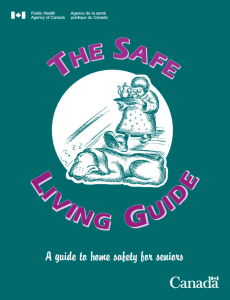
A travers ce guide, l’Agence de la santé publique du Canada donne des conseils sur la façon de prévenir les blessures en sécurisant votre domicile et votre environnement. Les listes de vérifications vous permettent d’améliorer la sécurité de votre quotidien. Des témoignages racontent leurs expériences.
-
The Safe Living Guide – A Guide to Home Safety for Seniors

Through this guide, the Public Health Agency of Canada provides advice on how to prevent injuries by keeping your home, yourself and your environment as safe as you can. Checklists allow you to verify and increase the safety of your surroundings and lifestyle, and real-life stories offer testimony to the value of adapting.
-
Les chutes… victime ou témoin, sachez comment réagir – Agence de la santé publique du Canada
-
If you fall or witness a fall, do you know what to do? – Public Health Agency of Canada
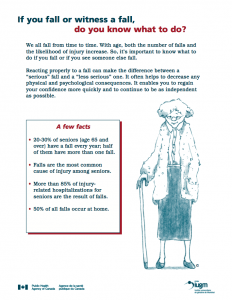
Discover essential knowledge and practical steps to prevent falls and respond effectively with the Fall Prevention and Response resource provided by the Public Health Agency of Canada. From prevention strategies to immediate response guidelines, empower yourself to promote safety and well-being in your community.
-
Comment réduire le risque de chute – Agence de la santé publique du Canada
-
How to lower your fall risk – Public Health Agency of Canada
-
Bruno et Alice – Une histoire d’amour en douze épisodes sur les aînés et la sécurité
Cette série de douze épisodes raconte l’histoire attendrissante de deux aînés qui, à cause d’un manque de prévention, se retrouvent dans des situations cocasses qui les feront presque manquer leur rendez-vous avec l’amour. Chaque histoire illustre certaines des mesures personnelles de prévention que peuvent adopter les aînés pour rendre leur milieu plus sûr et éviter les blessures.
-
Bruno and Alice: A Love Story in Twelve Parts About Seniors and Safety
This series of twelve illustrated stories follows the whimsical romance of two active seniors who, through lack of prevention, end up in awkward situations and almost miss their rendezvous with love. The stories offer insight into some of the personal preventive measures seniors can take to make their environment safer and prevent injuries.
-
Chutes chez les aînés au Canada
-
Seniors’ Falls in Canada
-
Movement for Adults Ages 65+ – Particip
ACTION From ParticipACTION, learn how following the Canadian 24-Hour Movement Guidelines can help you stay strong, mentally fit and independent.
-
Faites place au mouvement : les aînés de 65 ans et plus – Particip
ACTION L’organisation ParticipACTION explique comment suivre les Directives canadiennes en matière de mouvement sur 24 h peut vous aider à demeurer vigoureux, autonome et en bonne santé mentale.
-
How can I prevent a fall? – Finding Balance Alberta
Discover valuable information and practical strategies to help prevent falls with Finding Balance Alberta’s comprehensive resource.
-
If I fall, what do I do? – Finding Balance Alberta
-
Pour vous relever du sol APRÈS une chute – Finding Balance Alberta
-
Am I at risk for a fall? – Finding Balance Alberta
Use this falls risk self-assessment quiz to find out if you are at risk for a fall.
-
Finding Balance Alberta
Finding Balance is a falls prevention program that provides seniors and practitioners with the latest information and resources to help seniors live an active and independent lifestyle. The program uses real life strategies that older adults can use to lower their risk of a fall.
-
Light up social media Mis à jour
Our hashtags #ParachuteNIPD and #TurnSafetyOn garnered 5.6 million social media impressions in 2022.
-
2017 President’s Report
-
Complete Streets Evaluation tool
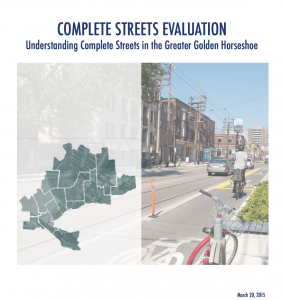
The Complete Streets Evaluation Tool is comprised of 21 performance indicators that are aimed at helping municipalities assess the effectiveness of their Complete Streets projects. The indicators are organized within four broad goals: (1) active transportation, (2) level of safety, (3) level of service, (4) surrounding environment.
-
Vision, Strategies, Action: Guidelines for an Effective Vision Zero Action Plan
-
Core Elements for Vision Zero Communities
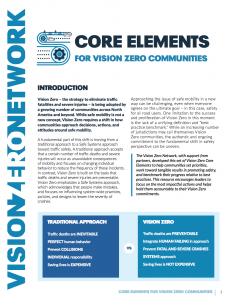
This resource was designed to help communities set out their Vision Zero priorities, create meaningful results related to road safety, and compare their progress to best practices. The resource encourages leaders to focus on the most effective actions and will help to hold them accountable to the commitment made to Vision Zero.
-
9 Components of a Strong Vision Zero Commitment
-
Fall proof your home
As a part of Safe Kids Week 2019, Parachute made this one-minute video to share the best tips for preventing serious falls and injuries to your children in your home.
-
Rail Safety Week 2018
Playlist of Parachute’s short (15-second) videos covering various aspects of rail safety.
-
Message vidéo d’intérêt public « Walk Safe » en français
-
Walk Safe English PSA
-
Halloween safety
Watch this one-minute video for safety tips to keep you and your family members safe on Halloween.
-
Guide to installing a booster seat
Watch this four-minute video to learn about when to transition your child from a forward-facing child car seat to a booster seat and when your child will be at the right growth stage to start using seat belts alone. Along with simple installation tips, demonstration and guidance, Dr. Andrew Howard talks about the importance of a booster seat in keeping your child safe.
-
Guide d’installation d’un siège d’appoint
Regardez cette vidéo de quatre minutes pour savoir quand passer d’un siège d’auto pour enfant face vers l’avant à un siège d’appoint et quand votre enfant atteindra le bon stade de croissance pour commencer à utiliser la ceinture de sécurité. En plus de conseils d’installation simples, de démonstrations et de conseils, le Dr Andrew Howard évoque l’importance d’un siège d’appoint pour assurer la sécurité de votre enfant.
-
Guide to installing a rear-facing car seat
Watch this seven-minute video for information on how long your infant should use a rear-facing car seat and a demonstration of how to install it. Dr. Andrew Howard of Toronto’s Hospital for Sick Children discusses the importance of a properly installed rear-facing child car seat in keeping your baby safe.
-
Guide d’installation de siège d’auto vers l’arrière
Regardez cette vidéo de sept minutes pour savoir combien de temps votre bébé devrait utiliser un siège d’auto orienté vers l’arrière et pour savoir comment l’installer. Le Dr Andrew Howard, de l’Hospital for Sick Children de Toronto, parle de l’importance de bien installer un siège d’auto pour enfant face vers l’arrière pour assurer la sécurité de votre bébé.
-
Guide to installing a forward-facing car seat
Watch this six-minute video to learn about when your child should transition to a forward facing car seat and tips on how to install it. You’ll also discover why it’s important to leave your child in a rear–facing seat for as long they meet the height and size requirements.
-
Guide d’installation de siège d’auto vers l’avant
Regardez cette vidéo de six minutes pour savoir quand votre enfant devrait passer à un siège d’auto face vers l’avant et obtenir des conseils sur la façon de l’installer. Vous découvrirez également pourquoi il est important de laisser votre enfant dans un siège orienté vers l’arrière tant qu’il répond aux critères de hauteur et de taille.
-
What you should know before buying a car seat or a booster seat
Watch this three-minute video for important information to consider before purchasing a car seat.
-
Ce qu’il faut savoir avant d’acheter un siège d’auto ou un siège d’appoint
Visionnez cette vidéo de trois minutes pour obtenir les renseignements importants à tenir compte avant d’acheter un siège d’auto.
-
Statement on Concussion Baseline Testing in Canada
-
Énoncé sur les tests pré-saison « baseline » pour les commotions cérébrales au Canada
-
In pursuit of « massive and long-lasting good »: Parachute’s Strategic Plan, 2021 to 2023
-
La volonté de faire un « grand bien et durablement » : plan stratégique de Parachute 2021 à 2023
-
Sgt. Kerry Schmidt describes how the OPP uses data (2017)
Sgt. Kerry Schmidt from the Ontario Provincial Police discusses collision statistics in Ontario and how enforcement uses data to allocate resources (two minutes).
-
The Parachute Vision Zero Network 2nd Annual Summit (2017)
This video promotes Parachute Vision Zero Network’s 2nd Annual Summit (October 16-17, 2017), a two day conference that brings together grassroots organizations, enforcement, public health professionals and researchers to discuss the implementation of Vision Zero (two minutes).
-
Interview with Heather Woods Fry from Traffic Injury Research Foundation (TIRF) (2018)
Parachute’s Matt Aymar interviews Heather Woods Fry with the Traffic Injury Research Foundation about their newly launched Drug-Impaired Driving Learning Centre, sponsored by State Farm Insurance (10 minutes).
-
A panel discussion on Safe School Zones: Vision Zero neighbourhood by neighbourhood (2018)
This moderated discussion features four panelists filmed at the Children’s Safety Village in Oakville. The discussion explores: What does a Safe School Zone look like under the Vision Zero framework? Can it work in your community? What are some of the issues and solutions around collision prevention in school zones? (50 minutes).
-
Distracted Driving: Changing the Culture (2018)
A Vision Zero panel discussion held at Espace Desjardins, Montreal. A panel of experts discuss the dangers of distracted driving and what is being done to counter it (60 minutes).
-
Vision Zero in Canada (2019)
Parachute Interim CEO, Pamela Fuselli, speaks about Vision Zero in Canada as keynote speaker at the Canadian Association of Road Safety Professionals conference in Calgary (30 minutes).
-
The Safe Systems Approach in the Netherlands: Adoption, implementation and lessons learned
-
Blog posts
-
Infographics
-
Proclamations Mis à jour
-
Light up Canada! Mis à jour
Light up Parachute Green on July 7, 2025!
-
Canadian Youth Road Safety Week
-
Réglage de casque
-
Helmet fitting activity
-
Démonstration du processus de discrimination de deux points statiques
-
Two point discrimination demonstration
-
Point aveugle et image rémanente en couleur
-
Blind spot and colour afterimage activities
-
Activité « Identifier le rôle des différents lobes »
-
Naming the lobes activity
-
Activité « Passer le mot »
-
Passing the note activity
-
Bienvenue dans le programme Ondes cérébrales de Parachute
Une introduction pour les bénévoles du programme Ondes cérébrales de Parachute avec quelques conseils généraux et préparatifs avant la présentation.
-
Welcome to Parachute Brain Waves
An introduction to volunteering at Parachute Brain Waves along with some general tips and things to prepare before the presentation.
-
Brain Waves full presentation
-
Brain Waves short presentation
-
Brain Waves activity booklet
-
Livret d’activités Ondes cérébrales
-
Janice Eales
-
The symptoms of a concussion
What are the symptoms of concussion? Find out by watching this video.
-
Les symptômes d’une commotion cérébrale
Quels sont les symptômes d’une commotion cérébrale ? Visionnez cette vidéo pour le découvrir.
-
Staff
-
Personnel
-
Expert Advisory Committee
-
Comité consultatif d’experts
-
Conseil d’administration
-
Board of Directors
-
Parachute’s third annual National Injury Prevention Day July 5
-
Implementation experiences in three Canadian urban communities (2019)
-
Expériences de mise en oeuvre dans trois collectivités urbaines canadiennes (2019)

Cette étude de cas explore les expériences vécues, les défis rencontrés et les solutions mises en oeuvre dans trois collectivités au Canada qui examinent ou planifient la Vision Zéro ou la mettent en œuvre : Surrey (Colombie-Britannique), la région de Durham (Ontario) et Kingston (Ontario).
5,62 MB PDF/UA
-
Agricultural fatalities in Ontario: 1990-2011 (2014)
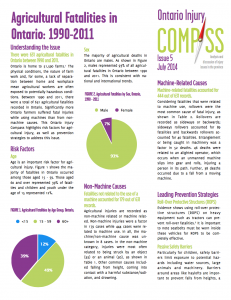
Agricultural injury is an important issue affecting Ontario residents living and working on the province’s over 50,000 farms. This July 2014 issue of the Ontario Injury Compass looks at agricultural fatalities and discusses prevention strategies including roll-over protective structures, age-appropriate work and occupational health and safety practices for farms.
128,26 KB PDF/UA
-
Pace Car sign-up sheet
-
Pace Car community supporter’s pledge
-
L’engagement des collectivités Voiture pilote
-
Complete urban streets
-
Rues urbaines complètes
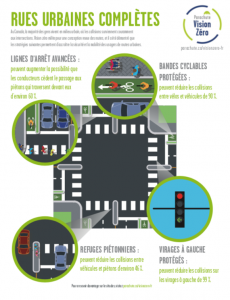
Cette infographie présente les stratégies qui se sont avérées efficaces pour améliorer la sécurité des usagers de la route aux intersections en milieu urbain. Mentionnons : les voies cyclables protégées, les virages à gauche protégés, les lignes d’arrêt avancées et les refuges pour piétons.
1,28 MB PDF
-
Complete rural roads
-
Rues rurales complètes
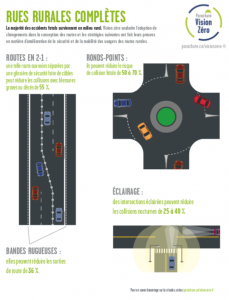
Vision zéro souhaite l’adoption de changements dans la conception des routes et les stratégies suivantes ont fait leurs preuves en matière d’amélioration de la sécurité et de la mobilité des usagers des routes rurales : routes en 2+1, ronds-points, bandes rugueuses et intersections éclairées.
1,11 MB PDF
-
Collision avoidance technologies
-
Technologies anti collision
-
Ce que pensent les adolescents au sujet de la conduite sous l’emprise du cannabis
-
Teen beliefs about cannabis and driving
-
La sécurité des piétons à l’école
-
Safe schools
-
Témoignages
-
Testimonials
-
Nos réseaux
-
Our networks
-
Rapports annuels
-
Annual reports
-
Chronologie des réalisations
-
Timeline of accomplishments
-
Careers
-
Carrières
-
La 3ème édition de l’annuelle Journée Nationale de la Prévention des Blessures
Les blessures évitables sont la cause principale de décès chez les jeunes Canadiens avec un enfant qui meurt toutes les neuf heures. Parachute, l’organisme national canadien à but non lucratif dédié à la réduction de l’impact dévastateur des blessures évitables, présente la troisième édition de la Journée Nationale de la Prévention des Blessures.
-
Summary Report #2 – Falls & Transport Injury Trends in Children 2004 and 2010
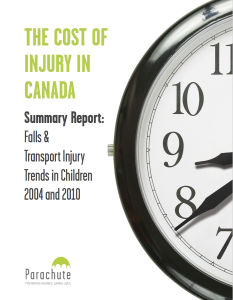
This is a compendium to the Cost of Injury in Canada Report, which analyzes fall and transport injuries in children using 2004 and 2010 injury data, focusing on mortalities, hospitalizations and emergency room visits. The findings from the compendium can be used by researchers, public health planners, practitioners and policy makers when designing and implementing injury prevention programs and services.
650,13 KB PDF/UA
-
Collection : chutes chez les adultes
Des ressources sur la défense des intérêts, les politiques publiques, les programmes, initiatives, données et la recherche, ainsi que la formation, des outils de prévention des chutes pour les aînés avec accès aux réseaux professionnels.
-
Adult falls collection
Find resources here on advocacy, public policy, programs and initiatives, data and research, training and guidelines, as well as fall prevention tools for seniors to use and access to professional networks.
-
Train for the Brain
-
Le Brigadier Favori du Canada Mis à jour
-
Pace Car promotional poster
-
Pace Car Community Walkabout Tool – Rural
-
Pace Car Community Walkabout Tool – Urban
-
Pace Car Community Walkabout Guide
-
Canadian Injury Prevention Day Mis à jour
-
Case studies
A quarterly series featuring real-world examples of what Vision Zero is and how it’s currently being done in Canada.
-
Using data to make decisions and take action (2017)
-
Utiliser les données pour prendre des décisions qui se transformeront en action (2017)
-
Do collision avoidance systems make our roads safer? (2017)
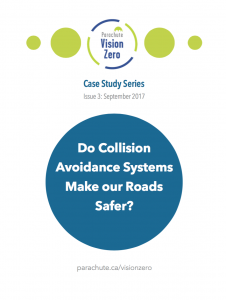
This Case Study goes into detail about the implementation of technology into cars and the effect that has on collision rates. It analyzes four collision avoidance systems: lane departure warnings, forward collision warning and braking, advanced forward lighting and blind spot detection.
The analysis discusses the safety benefits and risks of each system, the limitations of current research and the future of technology in motor vehicles.
1,96 MB PDF/UA
-
Est-ce que les systèmes anti collision rendent les routes plus sécuritaires ? (2017)
-
Cannabis and drug-impaired driving – what’s happening in Canada right now? (2018)
-
Le cannabis et la conduite sous l’emprise de la drogue – Que se passe-t-il au Canada à l’heure actuelle ? (2018)
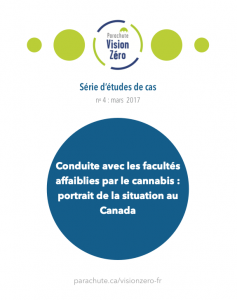
Cette étude de cas fournit un aperçu de la situation en matière de conduite sous l’emprise du cannabis au Canada, y compris un examen des statistiques actuelles, des défis uniques qui se posent dans le cadre de la prévention de la conduite sous l’influence du cannabis et des mesures prises par les gouvernements à l’heure actuelle pour traiter ce problème.
407,95 KB PDF/UA
-
Summary Report #1 – Analysis of Injury Trends 2004 and 2010
-
Liste de vérification contre les chutes d’enfants à la maison
-
Home fall proof checklist
-
Facts and myths about helmet legislation
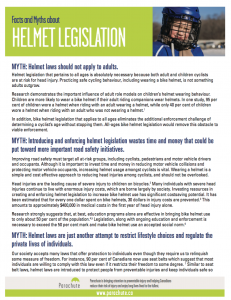
Mandating the use of helmets creates some controversy as public opinion varies and the evidence is not always in line with how people feel. As such, there are many myths related to bike helmet legislation. Parachute has developed this one page document to identify and address these common perceptions.
324,09 KB PDF/UA
-
Which helmet for which activity?
-
Concussion guide for physicians
-
Énoncé sur les tests pré-saison « baseline » pour les commotions cérébrales au Canada (2018)
-
Statement on Concussion Baseline Testing in Canada (2018)
-
Stratégie de retour au sport (2024)
-
Return-to-Sport Strategy (2024)
-
Stratégie de retour à l’école (2024)
-
Return-to-School Strategy (2024)
A four-step approach for a gradual return to cognitive activities and the learning environment.
371,73 KB PDF/UA
-
Guide sur les commotions cérébrales pour les enseignants (2024)
-
Concussion guide for teachers (2024)
-
Guide sur les commotions cérébrales pour les parents et fournisseurs de soins (2024)
-
Concussion guide for parents and caregivers (2024)
-
Guide sur les commotions cérébrales pour les entraîneurs et soigneurs (2024)
-
Concussion guide for coaches and trainers (2024)
-
Guide sur les commotions cérébrales pour les athlètes (2024)
-
Concussion guide for athletes (2024)
-
Canadian Guideline on Concussion in Sport 2nd Edition 2024
-
Transport-related injuries in Ontario (2014)
-
Suicide mortality in Ontario (2014)
-
Distracted driving in Ontario (2014)
-
Skiing, snowboarding and sledding: Alpine sports injuries in Ontario (2015)
-
Fall-related head injuries in adults 65 and over (2015)
-
Falls from ladders among Ontario adults (2015)
-
Child injuries in Ontario: At home, at play and on the road (2016)
-
Young driver injuries in Ontario (2016)
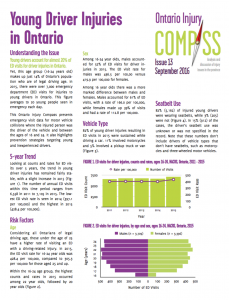
This September 2016 issue of the Ontario Injury Compass presents emergency visit data for motor vehicle collisions where the injured person was the driver of the vehicle and between the ages of 16 and 24. It also highlights prevention strategies targeting young and inexperienced drivers.
314,79 KB PDF/UA
-
Injuries from falls on stairs in Ontario (2016)
-
Injuries from falls involving skateboards and in-line skates (2017)
-
Fall-related injuries in young children 0-6 years (2017)
-
A snapshot of injuries in Ontario: 2008-2016 (2018)
-
Videos and webinars
-
Vision Zero collection
-
Concussion collection
As the author of the Canadian Guideline on Concussion in Sport, 2nd Edition, Parachute has developed a wide range of resources for health professionals, education professionals, and sports organizations.
-
Collection : commotion cérébrale
En tant qu’auteur des Lignes directrices canadiennes sur les commotions cérébrales dans le sport, Parachute a élaboré une vaste gamme de ressources pour les professionnels de la santé, de l’éducation et les organismes sportifs.
-
Skiing, snowboarding and sledding: Hospitalizations from alpine sports injuries in Canada (2015)
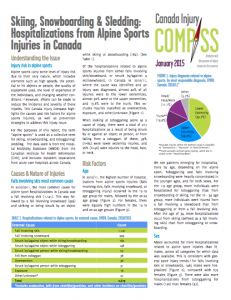
This January 2015 edition of the Canada Injury Compass highlights alpine sport injuries in Canada for the period of 2010-2011 in Canada. This report discusses the risks associated with alpines sport, the nature and circumstances of injuries and preventative strategies can reduce and prevent injuries while on the slopes.
231,96 KB PDF/UA
-
Bicycle injury hospitalization in Canadian children (2015)
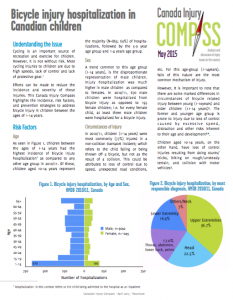
This May 2015 edition of the Canada Injury Compass highlights bicycle hospitalization in children in Canada from 2010-2011. The report provides an overview on the incidence of injury, factors associated with bicycle injuries, the nature and circumstances of injury and preventative measures to address the issue.
4,54 MB PDF/UA
-
Hospitalizations associated with drowning in Canada: A focus on infants, children and youth (2014)
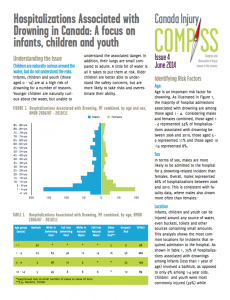
This Spring 2014 edition of the Canada Injury Compass emphasizes the message that safety around water is paramount with vulnerable populations like infants, children and youth. The report highlights incidence of drowning in Canada between 2006-2010 and recommends preventative strategies to reduce injuries and prevent fatalities.
201,88 KB PDF/UA
-
Distracted driving in Canada (2014)
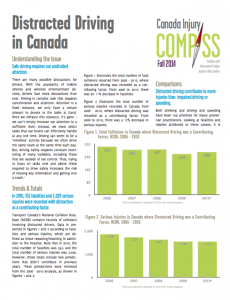
This Fall 2014 edition of the Canada Injury Compass focuses on injuries and fatalities due to distracted driving in Canada for the period of 2006-2010. Emphasizing the message that safe driving requires our undivided attention, the report highlights incidence of serious injuries and fatalities, contributing factors and mechanisms of injury and recommends preventative strategies to reduce and prevent injuries on the road.
142,12 KB PDF/UA
-
Safer Journeys New Zealand
-
The Netherland’s SWOV Institute for Road Safety Research
-
The U.S. Vision Zero Network
-
Sweden’s Vision Zero initiative
-
Australia’s Safe System approach
-
Distracted Driving Survey infographic (2018)
-
Distraction-Related Fatal Collisions, 2000-2015
-
Vision Zero Edmonton Annual Report 2018
-
Road Safety Annual Report 2018
-
Fatal and serious injuries related to vulnerable road users in Canada (2016)
This study analyzes possible trends of fatal and serious injuries related to vulnerable road users in Canada (pedestrians, cyclists and motorcyclists) from 1990 to 2012 and the role of alcohol and drugs in these cases.
-
B.C. Communities Road Safety Survey (2015)
-
Edmonton and Area Traffic Safety Culture Survey: Summary of Key Findings (2016)
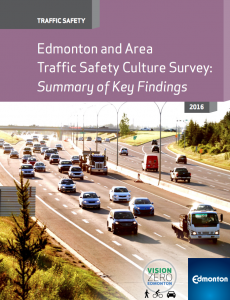
The City of Edmonton’s Office of Traffic Safety surveyed over 3,6000 drivers, pedestrians, cyclists and motorcyclists to provides insights into how road users perceive themselves and their actions, the actions of others and the rules of the road. This document presents the summary of findings from the survey to describe road user perceptions and behaviours.
-
Pedestrian and Cycling Safety in Toronto (2015)
-
Edmonton Zeros in on Traffic Safety – City of Edmonton
The City of Edmonton interviews the public on their knowledge, experience and opinion about fatalities and injuries on roads.
-
Traffic safety resources – City of Edmonton
Brochures, factsheets and posters related to traffic safety.
-
Vision Zero – City of Edmonton
The Vision Zero homepage of the City of Edmonton website.
-
Safety Measures for Cyclists and Pedestrians around Heavy Vehicles (2018)
-
Complete Street Transformations in the Greater Golden Horseshoe Region (2016)

This book features nine projects from municipalities throughout region which involved redesigning streets to make more space for one or more of pedestrians, cyclists or transit riders. In each case, a variety of photographs, illustrations and infographics tell the story of how each street was redesigned.
-
Toronto Complete Streets Guidelines (2017)
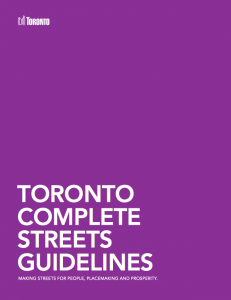
The City of Toronto developed Complete Streets Guidelines to provide a new approach to city street design and to provide an expanded toolbox of ways to improve Toronto’s streets. The document is organized in ten chapters that relate to the various steps of the street design and development process, with a particular focus on the planning and design phases where the majority of critical decisions take place.
-
B.C. Community Road Safety Toolkit
This toolkit contains three comprehensive modules, each with a different road safety focus. This resource details road safety interventions that can be implemented by municipalities, as well as implementation tools and strategies. The tools can be tailored to local contexts.
-
Moving from vision to action: Fundamental principles, policies & practices to advance Vision Zero in the U.S. (2017)
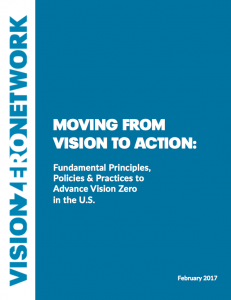
In this report, the Vision Zero Network defines core principles that are essential to a traffic safety approach being a Vision Zero commitment, and the corresponding, high-level policies and practices to implement and sustain a successful Vision Zero program. It provides an overarching set of expectations for a robust Vision Zero commitment that will help communities convert enthusiasm into lasting systems-level changes in their local traffic safety efforts.
-
Vision Zero: Principles and checklist for effective adoption
Based on an environmental scan, this document outlines principles of Vision Zero and provides a comprehensive checklist that municipalities can use when implementing their own Vision Zero plan.
-
Vision Zero: A toolkit for road safety in the modern era (2017)
This article considers the applicability of Vision Zero to real-world traffic-infrastructure is looked at to show the toolkits available for policymakers to increase road safety in a local context.
Applications of these principles to real-world traffic infrastructure are explored in order to show policymakers the toolkits available to increase road safety while taking into consideration local contexts. -
The Drug-Impaired Driving Learning Centre
Developed by the Traffic Injury Research Foundation, this web-based resource shares knowledge and increases awareness about priority topics to inform the planning of road safety policies and programs. It summarizes the latest research about drug-mpaired driving in an accessible, user-friendly format, and contains four modules that are structured in a question and answer format to help users quickly access topics of interest.
-
Sustainable and Safe: A Vision and Guidance for Zero Road Deaths
-
Region of Peel Vision Zero Road Safety Strategic Plan 2018-2022
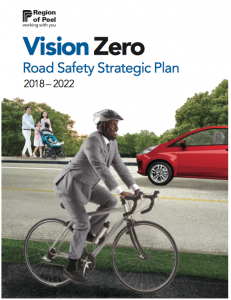
The Region of Peel developed a Road Safety Strategic Plan to address the approximate 1000 annual roadway collisions on Regional roads that result in injury or death. The plan aims to address a number of priorities outlined in the Region of Peel’s 2015-2035 Strategic Plan by promoting healthy and age-friendly built environments and building a community that promotes safe mobility, walkability, healthy living and various modes of transportation.
-
London, Ontario Road Safety
-
P.E.I. Road Safety Strategy 2015: Toward Zero Tolerance
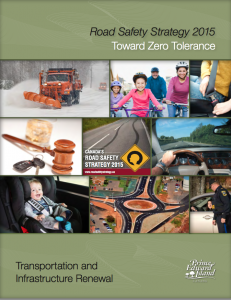
The Prince Edward Island Department of Transportation and Infrastructure Renewal (TIR) developed the Road Safety Strategy 2015 (TIR RSS) to guide initiatives within the department and to support Canada’s commitment to reduce the number of traffic fatalities and serious injuries. The major objectives of the TIR RSS 2015 are to raise awareness of road safety on Prince Edward Island, to work towards safer journeys for all road users, and to promote TIRs best practices toward these efforts.
-
Calgary Safety Mobility Plan 2019-2023
-
Edmonton Safe Mobility Strategy 2021-2025
-
B.C. Road Safety Strategy 2025
-
Toronto’s Vision Zero Road Safety Plan 2017-2021
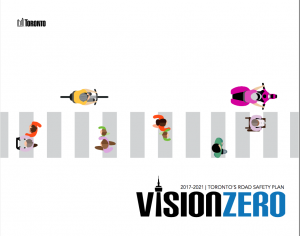
The Vision Zero Road Safety Plan is a comprehensive five year (2017-2021) action plan focused on reducing traffic-related fatalities and serious injuries on Toronto’s streets. With over 50 safety measures across our six emphasis areas, the Plan prioritizes the safety of our most vulnerable road users, through a range of initiatives.
-
Canada’s Road Safety Strategy 2025
-
Stratégie de sécurité routière 2025
-
Policy Makers’ Perceptions of the Role of Research and Injury Prevention Legislation (2018)
-
The Social Determinants of Injury (2011)
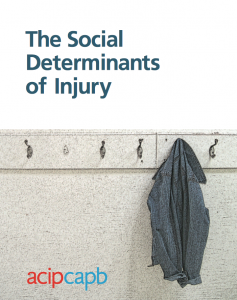
Produced by the Atlantic Collaborative on Injury Prevention, this document applies what we know about the social determinants of injury in the service of injury prevention. This report provide injury prevention practitioners and policymakers with an overview of the social and economic factors that contribute to intentional and unintentional injuries.
-
Les déterminants sociaux des blessures (2011)
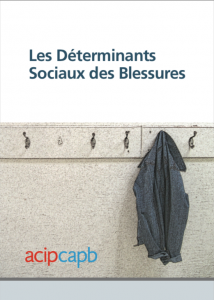
Développé par la Collaboration Atlantique pour la prévention des blessures, ce document expose ce que nous savons au sujet des déterminants sociaux des blessures dans le domaine de la prévention des blessures. Ce rapport fournit aux professionnels de la prévention des blessures et aux décideurs politiques un aperçu des facteurs socio-économiques qui contribuent aux blessures intentionnelles et non intentionnelles.
-
Infographie Maintenir et améliorer la qualité de l’air intérieur
-
Maintain and improve indoor air quality infographic
-
Infographie monoxyde de carbone
-
Carbon monoxide infographic
-
Le monoxyde de carbone dans les établissements de soins prolongés – CCNSE
Le Centre de collaboration nationale en santé environnementale (CCNSE) présente les ressources les plus pertinentes du CCNSE et les ressources externes relatives au monoxyde de carbone dans les établissements de soins prolongés.
-
Carbon monoxide in long-term care facilities – NCCEH
The National Collaborating Centre for Environmental Health (NCCEH) features the most relevant NCCEH resources and external resources related to carbon monoxide in long-term care facilities.
-
Vision Zéro
-
Outil d’adaptation de la stratégie de retour au sport spécifique à un sport
Cet outil garantit que votre Stratégie de retour au sport est adaptée à la pratique d’activités particulières au sport facilitant le retour de l’athlète à son activité sportive après une commotion cérébrale.
71,86 KB Word
-
Sport-specific return-to-sport strategy adaptation tool
This tool will help ensure your Return-to-Sport Strategy is tailored to include sport-specific activities that help athletes return to your sport after a concussion.
44,01 KB Word
-
Sample concussion awareness checklist
A sample tool to help school boards and schools plan the delivery of concussion information and resources to key stakeholders. Use the checklist to identify the key audiences in your school community, what information those audiences need to know based on their roles, and how and when each audience will receive that information.
78,45 KB Word
-
Sample internal email to staff: Student diagnosed with concussion
A sample email to send to school staff about accommodations for students returning to school following a concussion.
109,36 KB PDF
-
Sample school board concussion policy template
-
The Cost of Injury in Canada (2015)
-
Ontario Injury Data Report (2018)
-
Inventory of road safety measures – Canada’s Road Safety Strategy
Road Safety Strategy (RSS) 2025 provides an inventory of road safety initiatives which can be adopted or adapted to address their specific road safety challenges. Some of these have been proven effective and others are considered promising if measured effectiveness is not yet available. The inventory supports the concept of a safer systems approach to road safety to address the road user, road infrastructure and vehicle safety concerns.
-
Drug-Impaired Driving Toolkit
The Canadian Centre on Substance Abuse (CCSA) Drug-Impaired Driving Toolkit contains timely and important resources for new drivers and those involved in drivers’ education.
This toolkit aims to:
- Provide educators with the necessary information needed to increase awareness of the effects of drugs on one’s ability to safely drive.
- Inform interventions aimed at young drivers to help them reduce the harms associated with driving while impaired by drugs.
-
Traffic calming measures – Institute of Transportation Engineers
This website has a series of fact sheets for various traffic calming measures. For each measure, the fact sheet provides its description, applications, design/installation issues, potential impacts, emergency response issues and typical costs.
Traffic calming measures include a number of strategies that work simultaneously toward the goal of reducing speed and improving safety.
-
Driving speed reduction
-
Pool fencing legislation
-
Poison prevention policy
-
Cycling helmet legislation
-
Concussion policy
-
Rowan’s Law: Concussion safety – Government of Ontario
Learn how to prevent, identify and manage concussions. This website contains information about concussions, Rowan’s Law Day, Ontario’s plan for improving concussion safety, as well as concussion awareness resources.
-
Loi Rowan : sécurité en matière de commotions cérébrales – Gouvernement de l’Ontario
Apprenez à prévenir, à détecter et à prendre en charge les commotions cérébrales. Ce site internet contient des informations au sujet des commotions cérébrales, sur la Journée de la Loi Rowan, le plan de l’Ontario pour améliorer la sécurité en matière de commotions cérébrales ainsi que des ressources sur la sensibilisation aux commotions cérébrales.
-
Report of the Rowan’s Law Advisory Committee (2017)
In this report, the Rowan’s Law Advisory Committee provides 21 recommended actions to the government with respect to head injury prevention and treatment. The Committee’s recommendations are directed to all organized amateur sports, both school-based and non-school-based, in Ontario.
-
Rapport du Comité consultatif de la Loi Rowan (2017)
Dans ce rapport, le Comité consultatif de la Loi Rowan fournit 21 actions recommandées au gouvernement respectant les principes de prévention et de traitement des blessures à la tête. Les recommandations du Comité sont adressées à toutes les activités organisées de sport amateur, dans un cadre scolaire ou hors cadre scolaire, en Ontario.
-
Booster seat legislation
-
Carbon monoxide alarm legislation
-
Position Statement on ATV Operation – Alberta Health Services (2015)
The position statement emphasizes no child/youth ATV operation under 16 years of age and other elements of ATV safety; helmet use, passenger restrictions, licensing/registration and training, and alcohol restrictions.
-
Preventing injuries from all-terrain vehicles – Canadian Paediatric Society position statement (2012)
The Canadian Paediatric Society discusses the dangers of children under 16 years of age driving any off-highway vehicles and recommends that children and youth under 16 years of age should not operate an ATV. They also provide safety recommendations for operators over 16 years of age and recommendations for legislation.
-
La prévention des blessures causées par des véhicules tout-terrains – Position de la Société canadienne de pédiatrie (2012)
La Société canadienne de pédiatrie évoque les dangers de la conduite pour les enfants et les jeunes de moins de 16 ans au volant de véhicules hors route et recommande qu’ils ne conduisent pas de VTT. Elle fournit également des recommandations de sécurité pour les conducteurs de plus de 16 ans et pour la législation.
-
Off-highway vehicle policy
-
All-Terrain Vehicles (ATVs) and Children’s Safety – Ontario Medical Association position statement (2016)
Ontario Medical Association’s position paper discusses the danger to children and youth from ATV use, industry activity and legislation in Ontario and other provinces.
-
Enquête sectorielle – Activité des politiques publiques (2016)
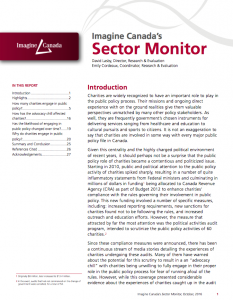
Le programme Enquête sectorielle d’Imagine Canada fournit de l’information pertinente en ce qui concerne les difficultés rencontrées par les organismes de bienfaisance et à but non lucratif au sein du secteur même et les diverses parties prenantes incluant les membres d’Imagine Canada, les décideurs politiques, les chefs d’entreprise, les médias et le public canadien.
Ce rapport traite de :
- Combien d’organismes de bienfaisance participent à l’élaboration des politiques publiques?
- Quel effet le « froid » dans le milieu de la défense des intérêts a-t-il eu sur les organismes de bienfaisance?
- La probabilité de s’engager en politique publique, a-t-elle changé au fil du temps?
- Why do charities engage in public policy?
-
Sector Monitor: Public Policy Activity (2016)

Imagine Canada’s Sector Monitor program provides relevant and timely information on the issues facing charities and nonprofits to the sector itself and to various sector stakeholders, including Imagine Canada members, policymakers, business leaders, the media and the Canadian public.
This report discusses:
-How many charities engage in public policy?- How has the advocacy chill affected charities?
- Has the likelihood of engaging in public policy changed over time?
- Why do charities engage in public policy?
-
Outil de changement de politique
L’Outil de changement de politique est un questionnaire auto-administré qui peut être utilisé pour évaluer la préparation de changement politique d’une communauté ou d’une organisation. Cela inclut une série de stratégies de travail avec les communautés ou les organisations à différentes étapes de préparation pour le changement de politique ainsi qu’une liste de ressources pour plus d’informations. Le but de cet outil est d’aider les défenseurs et décisionnaires politiques à encourager l’adoption de politiques publiques de santé au sein des communautés et des organisations.
-
Policy Readiness Tool
The Policy Readiness Tool is a self-administered questionnaire that can be used to assess a community or organization’s readiness for policy change. Included is a series of strategies for working with communities or organizations at different stages of readiness for policy change and a resource list for additional information. The purpose of the Tool is to help advocates and policy developers encourage the adoption of healthy public policy within communities or organizations.
-
Teen pedestrian safety infographic
-
Infographie sur la sécurité des jeunes piétons
-
Be seen on Halloween infographic
-
Injuries and Violence: The Facts (2014)
-
The Canadian Atlas of Child & Youth Injury Prevention
The Atlas provides child and youth injury information and data to assist practitioners, policy-makers and researchers in making informed decisions that will improve child and youth injury prevention measures in Canada.
The Atlas includes the following:
- Injury data dashboard: a visual overview of trends and patterns
- Injury research insights: a collection of injury prevention research, infographics and resources
- Injury Data Online Tool: a tool to sort, view and query in-depth injury data
-
Global Burden of Disease
The Institute of Health Metrics and Evaluation (IHME) houses the Global Burden of Disease (GBD) database, which contains information pertaining to mortality, disability, disease burden, life expectancy and risk factors. This data is available free of charge to researchers and policymakers around the world, so that they have the evidence they need to make informed decisions about how to allocate resources to best improve population health.
IHME has created a number of data visualization tools, which include dynamic graphs charts which allow for comparison and demonstrate how global health profiles have changed over time.
-
Unintentional Injury Trends for Canadian Children (2016)
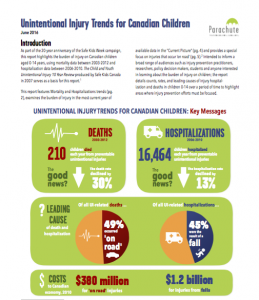
This report highlights the burden of injury on Canadian children aged 0-14 years. It features mortality and hospitalizations trends, examines the burden of injury in the most current year of available data and provides a special focus on injuries that occur ‘on road.’ Produced by Parachute.
569,82 KB PDF
-
Le portail canadien des pratiques exemplaires – Agence de la santé publique du Canada
L’Agence de la santé publique du Canada compile des ressources fiables de qualité pour les professionnels de la santé et les décisionnaires de santé publique pour créer des programmes, promouvoir la santé et prévenir les maladies.
-
Canadian Best Practices Portal – Public Health Agency of Canada
The Public Health Agency of Canada compiles trusted and credible resources for health professionals and public health decision-makers to plan programs for promoting health and preventing diseases.
-
Commotions cérébrales et autres traumatismes crâniens attribuables aux activités sportives et récréatives chez les enfants et les jeunes canadiens
Ces outils en libre accès donnent un aperçu interactif des statistiques sur les commotions cérébrales et autres traumatismes crâniens attribuables aux activités sportives et récréatives chez les enfants et les jeunes canadiens âgés de 5 à 19 ans. Les informations proviennent de la base de données électronique du Système canadien hospitalier d’information et de recherche en prévention des traumatismes (SCHIRPT) pour les années 2011 à 2017.
-
Sport and Recreation-related Concussions and Other Traumatic Brain Injuries Among Canada’s Children and Youth
Interactive tools that show statistics about sports and recreation-related concussions and other traumatic brain injuries among Canada’s children and youth aged 5-19 years, based on data from the electronic database of the Canadian Hospitals Injury Reporting and Prevention Program (eCHIRPP) for the years 2011 to 2017.
-
Étude des blessures chez les enfants et les jeunes : pleins feux sur la sécurité des produits de consommation (2009)
L’Agence de la santé publique du Canada fournit un état des lieux des blessures accidentelles chez les jeunes canadiens, avec une attention particulière sur les blessures liées aux produits de consommation; lits superposés, aimants, marchettes pour bébés et autres produits ménagers.
-
Child and Youth Injury in Review – Spotlight on Consumer Product Safety (2009)
The Public Agency of Canada provides an overview of unintentional injuries among young Canadians, with a focus on injuries associated with consumer product; bunk beds, magnets, baby walkers and other household products.
-
Backyard Pool Safety – Situational Assessment Results (2016)
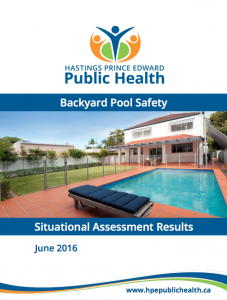
In this report, Hastings Prince Edward Public Health provides an insight on drowning prevention to help policy makers make an informed decision on how to prevent drowning in backyard pools. The report explores whether safer pool fencing bylaws are an effective part of a comprehensive drowning prevention strategy.
-
Recommandations pour la sécurité en motoneige – Société canadienne en pédiatrie (2004)
Dans ce document de principes, la Société canadienne en pédiatrie décrit les blessures liées à la motoneige, la législation au Canada ainsi que les recommandations pour les enfants, les personnes âgées de plus de 16 ans et les fabricants.
-
La route de la sécurité – Mise en place d’un programme de conduite professionnel
La route de la sécurité est un guide développé par la Sécurité au travail dans le nord (STN) pour aider les employés à mettre en place un programme de sécurité routière au sein de l’entreprise.
L’ensemble inclut un aperçu de la façon de mettre en place un programme de sécurité routière, des fiches d’exercices, incluant des plans de maitrise des risques, d’évaluation de la conduite au travail et des listes de vérifications développées pour des entreprises/organisations de petite à grande taille.
-
The Road to Safety – Implementing an occupational driving program
The Road to Safety information package is a guide developed by Workplace Safety North to help employers implement a safe driving program within the workplace.
The package includes an overview of how to implement a safe driving program, worksheets, including Hazard Control Plans and Occupational Driving Assessments, and checklists developed for both small and large sized companies/organizations.
-
Fiche informative tests pré-saison
-
Concussion baseline testing fact sheet
-
Semaine Sécuri
Jeunes -
Safe Kids Week
-
Ondes cérébrales
-
Brain Waves
-
Sécurité des sièges d’auto usagés pour enfants – Santé Canada
Précautions et mesures de sécurité avec des sièges d’auto usagés.
-
Second-hand car seat safety – Health Canada
Safety precautions to keep in mind for second-hand car seats.
-
Kelley Teahen
-
Kelley Teahen
-
David Wilson
-
David Wilson
-
Julie Taylor
-
Julie Taylor
-
Valerie Smith
-
Valerie Smith
-
Brad Offman
-
Stephanie Cowle
-
Stephanie Cowle
-
Michael Gemar
-
Michael Gemar
-
Rachel Lamont
-
Rachel Lamont
-
Margarita Boichuk
-
Margarita Boichuk
-
Online library of road safety campaigns – World Health Organization
Governments use mass media campaigns to increase public awareness of road safety laws and persuade the public to abide by them. This library offers a selection of road safety mass media campaigns to encourage and inspire those developing such campaigns.
-
Global status report on road safety (2018)
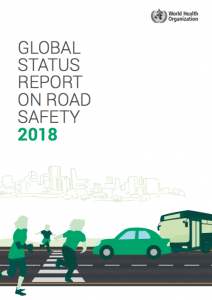
The Global status report on road safety 2018, launched by the World Health Organization (WHO), highlights that the number of annual road traffic deaths has reached 1.35 million. Road traffic injuries are now the leading killer of people aged 5-29 years. The report suggests that the price paid for mobility is too high, especially because proven measures exist.
-
Alcohol and Drug Use among Fatally Injured Teen Drivers (2015)
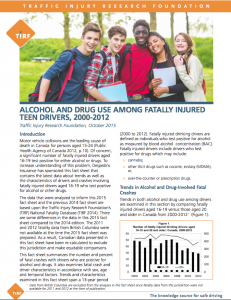
In this fact sheet, The Traffic Injury Research Foundation analyzes the trends of alcohol and drug use in fatally injured teen drivers from 2000 to 2012. The fact sheet outlines the statistics of fatally injured teen drivers that tested positive for drugs and alcohol by age, sex and temporal factors (weekday versus weekend collisions).
-
Texting While Driving Behaviour among Ontario Youth and Young Adults (2015)
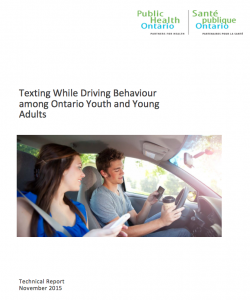
Developed by Pubic Health Ontario, this technical report examines the prevalence, motives and types of texting while driving behaviour among a sample of Ontario youth and young adults ages 16 to 24. This report presents findings from an online survey of 2,000 Ontario residents, aged 16-24.
Some of the objectives of the study were to:
- Uncover the prevalence and predictors associated with texting while driving among Ontario youth and young adults.
- Understand Ontario youth and young adults’ reasons and motives for engaging in texting while driving behaviour.
-
Cycling in Cities – University of British Columbia
This web page looks at the injury risks of cycling, as a part of the Cycling in Cities research program that investigates factors that encourage or discourage bicycling, transportation infrastructure associated with increased or decreased risks of cycling injuries, and air pollution and cycling.
-
The Flotation Report – Lifejackets/Personal Flotation Devices and Boating Fatalities in Canada: 20 Years of Research (2016)
-
Rapport sur la flottaison – Gilets de sauvetage/vêtements de flottaison individuels et décès liés à la navigation au Canada : 20 ans de recherche (2016)
-
Preventing Problematic Substance Use in Youth (2018)
-
Prévenir la consommation problématique de substances chez les jeunes (2018)
-
Pool fencing diagrams
-
Pre-season concussion education sheet
Have all stakeholders review and sign this education sheet, at the time of sport registration or before the beginning of each sports season, to confirm that all participants received key information about concussion.
29,83 KB Word
-
Fiche éducative transmise avant le début de la saison sportive
Faites signer cette fiche éducative à toutes les parties prenantes, au moment des inscriptions ou avant chaque début de saison sportive, pour confirmer que tous les participants reçoivent les informations clés au sujet des commotions cérébrales.
32,35 KB Word
-
Halloween safety: Tips for parents, children and drivers
Download our tip sheet on Halloween safety for parents, children and drivers.
96,00 KB PDF/UA
-
Electrical Safety at Home: Tips for parents
Download our electrical safety tip sheet for parents.
108,11 KB PDF/UA
-
Marque-page règle 2V1 pour l’ajustement du casque
-
2V1 Rule for helmet fitting bookmark
-
The Walking School Bus and Children’s Physical Activity: A Pilot Cluster Randomized Controlled Trial (2011)
Through a pilot cluster randomized controlled trial, this study reports that a pilot walking school bus program improved children’s active community to school and moderate-to-vigorous physical activity.
-
Too Hot for Tots! Evaluation of a Paediatric Burns Prevention Resource (2011)
Too Hot for Tots! is a professionally produced video with an accompanying brochure package developed to teach caregivers about burn injuries that often happen in the home.
The effectiveness of Too Hot for Tots! is assessed through this impact evaluation conducted by the B.C. Injury Prevention Unit. The evaluation results demonstrated a statistically significant increase in caregiver’s knowledge, attitudes and practices around burns prevention in the home after exposure to the program.
-
Lettre d’autorisation médicale
Avant de retourner à une pratique complète du sport avec contact, chaque athlète doit fournir à son entraineur une lettre d’autorisation médicale qui précise qu’un médecin ou un infirmier praticien a personnellement ausculté le patient et l’a autorisé à recommencer la pratique du sport.
27,06 KB Word
-
Medical clearance letter
Before returning to full contact practice and game play, each athlete must provide their coach with a standardized Medical Clearance Letter that specifies that a medical doctor or nurse practitioner has personally evaluated the patient and has cleared the athlete to return to sport.
27,78 KB Word
-
Lettre confirmant le diagnostic médical
Une lettre confirmant le diagnostic médical devrait être fournie aux athlètes à qui on a diagnostiqué une commotion cérébrale, confirmant le diagnostic. Les athlètes qui n’ont pas été diagnostiqués souffrant d’une commotion doivent recevoir une lettre confirmant le diagnostic médical négatif et confirmant qu’ils peuvent retourner à l’école, au travail et aux activités sportives sans restriction.
28,38 KB Word
-
Medical assessment letter
A medical assessment letter should be provided to athletes diagnosed with a concussion, indicating a concussion has been diagnosed. Athletes that are determined to have not sustained a concussion must be provided with a Medical Assessment Letter indicating a concussion has not been diagnosed and the athlete can return to school, work and sport activities without restriction.
29,82 KB Word
-
Designer Chris Moorehead’s background on creating “Canada’s Concussion Leaders.”
-
Canada’s Concussion Leaders infographic
-
Modèle de protocole pancanadien harmonisé sur les commotions cérébrales pour les écoles
Ce modèle fournit un exemple de protocole sur les commotions cérébrales selon les Lignes directrices canadiennes sur les commotions cérébrales dans le sport.
306,59 KB PDF
-
Pan-Canadian harmonized school concussion protocol template
This template provides an example of a concussion protocol that aligns with the Canadian Guideline on Concussion in Sport.
199,92 KB PDF
-
Modèle de protocole canadien harmonisé sur les commotions cérébrales dans le sport
Ce modèle fournit un exemple de protocole sur les commotions cérébrales selon les Lignes directrices canadiennes sur les commotions cérébrales dans le sport.
515,14 KB Word
-
Canadian harmonized sport concussion protocol template
This template provides an example of a concussion protocol that aligns with the Canadian Guideline on Concussion in Sport, 2nd edition.
364,42 KB Word
-
Outil d’évaluation des commotions cérébrales dans le sport 6 pour enfants (Child SCAT6)
L’outil Child SCAT6 est un outil standardisé d’évaluation des commotions cérébrales conçu à l’intention des médecins et des professionnels de la santé autorisés.
Si vous n’êtes ni un médecin ni un professionnel de la santé autorisé, veuillez utiliser l’outil de reconnaissance des commotions cérébrales 6 (CRT6). L’outil Child SCAT6 doit servir à l’évaluation des enfants âgés de 8 à 12 ans. Pour les athlètes âgés de 13 ans et plus, veuillez utiliser l’outil SCAT6. -
Child Sport Concussion Assessment Tool 6 (Child SCAT6)
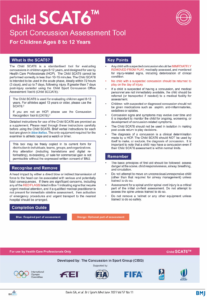
The Child SCAT6 is a standardized tool for evaluating concussions designed for use by licensed healthcare professionals. If you are not a healthcare professional, please use the Concussion Recognition Tool 6 (CRT6). The Child SCAT6 is to be used for evaluating children aged 8 to 12 years. For athletes aged 13 years and older, use the SCAT6.
-
Outil d’évaluation d’une commotion cérébrale dans le sport 6 (SCAT6)
Le SCAT6 est un outil d’évaluation standardisé des commotions cérébrales, conçu pour être utilisé par les médecins et les professionnels de la santé diplômés1. Si vous n’êtes pas médecin ou professionnel de la santé diplômé, veuillez utiliser l’outil d’identification des commotions cérébrales 6 (Concussion Recognition Tool 6, CRT6). Le SCAT6 sert à évaluer les athlètes à partir de 13 ans. Pour les enfants de 12 ans et moins, veuillez utiliser le SCAT6 pour enfants.
-
Sport Concussion Assessment Tool 6 (SCAT6)
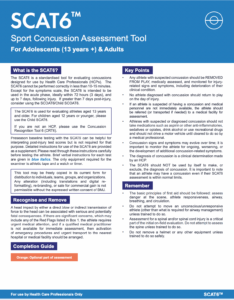
The SCAT6 is a standardized tool for evaluating concussions designed for use by licensed healthcare professionals. If you are not a healthcare professional, please use the Concussion Recognition Tool 6 (CRT6). The SCAT6 is to be used for evaluating athletes aged 13 years and older. For children aged 8 to 12 years, use the Child SCAT6.
-
Outil de reconnaissance des commotions cérébrales (CRT6)
Pour aider à reconnaitre les commotions cérébrales chez les enfants, les adolescents et les adultes.
-
Concussion Recognition Tool 6 (CRT6)
-
Childhood safety advocates urge Canadian families to #Fall
Proof Your Home -
Road Safety Professional Certification
The RSP certification provides for professionals involved in a wide array of safety-related disciplines to establish their competency in providing for the safety of the traveling public. The goals of the RSP certifications are to recognize road safety as a profession, to establish a recognized level of practice and knowledge and to incentivize safety education.
Provided by The Transportation Professional Certification Board (TPCB). -
Canadian Injury Prevention Curriculum
The Canadian Injury Prevention Curriculum (CIPC) is a unique resource focused on the study of injury prevention theory and practice. Built on Canadian content and using real Canadian examples, the curriculum is targeted to community-based injury prevention stakeholders.
-
Canadian Fall Prevention Curriculum (2017)
The CFPC provides those working with older adults the knowledge and skills needed to apply a public health approach to the prevention of falls and fall-related injuries. Participants learn how to design, implement and evaluate a fall prevention program tailored to their work or community setting.
-
Too Hot for Tots!
-
National Drowning Report (2024)
This report identifies key demographic indicators around preventable water-related fatalities such as: who is drowning, when are they drowning, where are they drowning, what were they doing and why did they drown (risk factors). Prepared for the Lifesaving Society Canada by the Drowning Prevention Research Centre Canada.
-
Rapport national sur la noyade (2024)
Ce rapport identifie les éléments démographiques clés concernant les décès involontaires relatifs à l’eau tels que : qui se noie, à quel moment, où, en pratiquant quelle activité et pourquoi ils se noient (les facteurs de risque). Préparé pour la Lifesaving Society Canada par le Drowning Prevention Research Centre Canada.
-
Carbon monoxide safety – Fortis
BC FortisBC’s web page on carbon monoxide safety.
-
Carbon monoxide alarms
The Ontario Association of Fire Chiefs provides information on how to select, install and maintain your carbon monoxide alarms.
-
thesilentkiller.ca
A website developed by Technical Standards & Safety Authority (TSSA) to provide information about what you need to know about carbon monoxide and how to protect yourself.
-
Webinars
Parachute hosts webinars and presentations, whether standalone or as part of online conferences, on a variety of topics related to injury prevention of interest to professionals.
-
Formations et webinaires
Parachute et ses partenaires offrent des programmes de formation : commotions cérébrales, prévention des chutes, sécurité routière, sécurité des enfants. Nous organisons également des webinaires sur la prévention des blessures.
-
Outils
Ces outils interactifs de visualisation de données et ces portails en ligne vous aideront à mieux interpréter les statistiques et les renseignements sur les blessures.
-
These interactive data visualization tools and online portals will help you better understand statistics and information on injury.
-
Policy
Parachute advocates for policies and regulations to reduce serious injury and death. Current focuses: booster seats, carbon monoxide alarms, concussion, cycling helmets, driving speed, off-highway vehicles, poison and pool fencing.
-
Publications
Review current injury reports, recommended journals, systematic reviews, and other publications related to injury prevention.
-
Publications
Bilan des rapports actuels sur les blessures, des revues recommandées, des examens systématiques et de diverses autres publications liées à la prévention des blessures.
-
Le coût des blessures au Canada
Ce rapport 2021 quantifie le coût des blessures au Canada d’un point de vue sociétal, incluant les coûts pour le système de santé, la productivité et pour les individus derrière les chiffres : les personnes, les familles, les communautés.
-
Patricia H. Southern
-
Patricia H. Southern
-
Zoe Robinson
-
Zoe Robinson
-
Donna Wilson
-
Sylvio Deluca
-
Sylvio Deluca
-
Un brigadier et deux brigadières scolaires de l’Ontario et du Nouveau-Brunswick désignés favoris au
Trois brigadiers scolaires dont le dévouement est exceptionnel ont été choisis comme gagnants du Concours 2019 des brigadières et brigadiers scolaires favoris du Canada. Les récipiendaires, qui sont reconnus pour leur contribution extraordinaire à leurs communautés, recevront leurs récompenses au cours des prochaines semaines.
-
Three crossing guards from Ontario and New Brunswick chosen as Canada’s favourites
-
Canada’s Risk Management Strategy on Lead (2013)
This 2013 federal report extensively reviews information on lead toxicity and how it is being addressed in Canada.
-
Stratégie de gestion des risques pour le plomb (2013)
Ce rapport de 2013 du gouvernement canadien examine en détail l’information sur la toxicité du plomb et la façon dont elle est traitée au Canada.
-
Carbon Monoxide Poisonings: Hospitalizations and Deaths in Canada (2017)
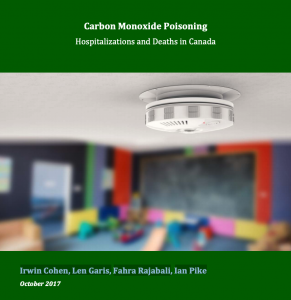
This report analyzes carbon monoxide poisoning hospitalizations and deaths in Canada to demonstrate the need for specific legislation in each province and territory to mandate the installation and maintenance of functioning CO alarms in every residence. Co-published by the British Columbia Injury Prevention Unit and University of the Fraser Valley.
-
Laundry detergent packets – Health Canada
More information about the hazards of your children mistaking colourful laundry detergent packets for candy.
-
Sachets de détergent à lessive – Santé Canada
Plus d’informations au sujet du danger pour les enfants à confondre les sachets colorés de détergent à lessive avec des bonbons.
-
Canadian Association for Poison Centres and Clinical Toxicology
-
Association canadienne des centres antipoison et de toxicologie clinique
L’Association canadienne des centres antipoison fournit les coordonnées des centres antipoison provinciaux ainsi que des ressources au sujet de la prévention des empoisonnements.
-
Alex au parc
-
Alex at the Playground
-
Sécurité des meubles, appareils et télévision – Gouvernement du Canada
Le gouvernement du Canada fournit des conseils de sécurité sur les meubles, appareils et télévisions.
-
Furniture, appliance and television safety – Government of Canada
The Government of Canada provides safety tips on furniture, appliance and television safety.
-
Concussion resources for health professionals
-
Rivermead post-concussion symptoms questionnaire
This questionnaire allows individuals to rate the severity of their symptoms compared with before the concussion incident.
-
La commotion cérébrale et vous (2016)
-
Concussion & You handbook (2016)
-
Informations sur les commotions cérébrales pour les patients et leurs familles (2018)
-
Concussion Information for Patient and Families (2018)
-
4 caractéristiques d’une bonne clinique de commotion cérébrale (2017)
-
4 Characteristics of a Good Concussion Clinic (2017)
-
Collaboration canadienne sur les commotions cérébrales
Une liste de ressources et d’outils au sujet de la prévention et de la gestion des commotions cérébrales fournie par la Collaboration canadienne sur les commotions cérébrales.
-
Canadian Concussion Collaborative
A list of resources and tools about the prevention and management of concussion, provided by the Canadian Concussion Collaborative.
-
Sport Physiotherapy Canada Locker Room: Everything concussion for the physiotherapist, athlete, coach or parent
Sport Physiotherapy Canada (SPC), a division of the Canadian Physiotherapy Association (CPA), provides a list of SPC-created concussion resources and organizations with additional resources.
-
Commotion cérébrale : prévention, détection et gestion dans mon milieu – Université Laval, MOOC
Ce MOOC démystifie la commotion cérébrale, précise le rôle des intervenants impliqués dans la gestion de ce type de traumatisme cranio-cérébral et accompagne le participant dans la mise en place d’un protocole de gestion des commotions cérébrales adapté à la réalité de son milieu.
-
Concussion Awareness Training Tool (CATT) for medical professionals
CATT (Concussion Awareness Training Tool) Medical Professionals is designed to provide medical professionals with the information they need to provide evidence-based care for their patients who have sustained a concussion. Accredited by UBC Continuing Professional Development, Faculty of Medicine. This course is accredited for MOC Section 3 credits
-
Falls in seniors
Key strategies and resources to help older adults prevent falls and the importance of fall prevention with Canada’s aging population.
-
Falls in children
Most fall-related injuries to children under five happen in the home. Here’s how to keep your kids safe from falls in the home.
-
Sécurité des sièges d’auto pour enfants – Gouvernement du Canada
Transports Canada fournit un large panel d’informations sur la sécurité des sièges d’auto et sur la sécurité des enfants passagers.
-
Child car seat safety – Government of Canada
Transport Canada provides a wide range of information on car seats and child passenger safety.
-
Window covering safety – Government of Canada
Tips from the Government of Canada website
-
Sécurité des couvre-fenêtres – Gouvernement du Canada
Conseils du site internet du gouvernement canadien.
-
Standards for post-concussion services and concussion clinics
-
Normes de traitement de la commotion cérébrale
-
Lignes directrices sur les commotions cérébrales / traumatismes craniocérébraux légers et les symptômes prolongés, 3e édition
-
Living Concussion Guidelines: Guideline for Concussion & Prolonged Symptoms for Adults 18 Years of Age or Older
-
Concussion protocol resources for sport organizations
-
Outil de formation et de sensibilisation aux commotions cérébrales (CATT)
L’outil de formation et de sensibilisation aux commotions cérébrales (CATT) est constitué d’une série de modules et de ressources pédagogiques ayant pour visée l’harmonisation de la reconnaissance, du diagnostic, du traitement et de la prise en charge des commotions cérébrales. Une bonne prise en charge peut réduire le risque d’endommagement du cerveau ainsi que de potentiels problèmes de santé sur le long terme.
-
Concussion Awareness Training Tool (CATT)
The Concussion Awareness Training Tool (CATT) is a series of free e-learning modules for different audiences: parents, coaches, athletes, educators, medical professionals, and those working with survivors of intimate partner violence.
-
NCCP Making Head Way Concussion e
Learning Series 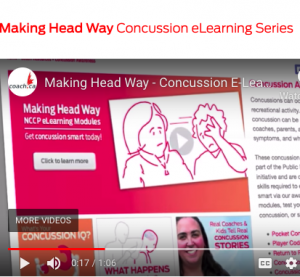
Designed to help you gain the knowledge and skills required to ensure the safety of your athletes, these National Coaching Certification Program (NCCP) Professional Development modules will make you concussion smart! Developed by the Coaching Association of Canada. Requires registration and takes 60 to 90 minutes to complete a module.
-
Prendre une tête d’avance – Série de modules d’apprentissage en ligne
Conçus pour vous aider à acquérir connaissances et compétences pour assurer la sécurité de vos athlètes, ces modules de perfectionnement professionnel du PNCE vous permettront de tout savoir sur les commotions. Développés par l’Association canadienne des entraîneurs.
-
Concussion resources – Sport Information Resource Centre
The Sport Information Resource Centre has a collection of information on concussion.
-
Ressources sur les commotions cérébrales – Centre de documentation pour le sport
Le Centre de documentation pour le sport comprend une collection d’informations sur les commotions cérébrales.
-
Concussion Awareness Training Tool (CATT) for school professionals
The CATT is a program designed to provide school professionals and administrators with the information they need to take an evidence-based approach in responding to and managing concussion.
-
SCHOOLFirst
SCHOOLFirst is a tool that has been developed to help teachers and other school personnel be a Concussion Champion and support youth upon their return-to-school after a concussion.
-
SCHOOLFirst (Français)
SCHOOLFirst est un outil qui a été développé pour aider les enseignants et autres membres du personnel des écoles à être des champions des commotions cérébrales et à soutenir les jeunes au moment de leur retour à l’école après une commotion.
-
Concussion protocol resources for schools
-
Canadian Guideline on Concussion in Sport
-
6th Consensus Statement on Concussion in Sport
Consensus statement on concussion in sport: the 6th International Conference on Concussion in Sport – Amsterdam, October 2022
-
Concussion Harmonization Project
-
Concussion
-
The Epidemiology of ATV and Snowmobile-Related Injuries in Ontario (2019)
-
Épidémiologie des blessures associées au véhicule tout-terrain et à la motoneige en Ontario (2019)
-
Preventing Falls: From Evidence to Improvement in Canadian Health Care (2014)
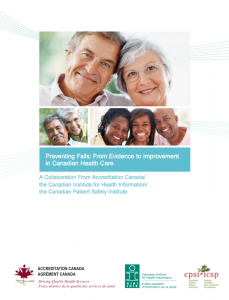
The negative impact of falls highlights a need to understand the burden of falls on Canadians and the health system.
- How are Canadian health care organizations progressing with falls prevention programs? – Which populations are at greatest risk of falls?
- What tools are available to support organizations?
In the report Preventing Falls: From Evidence to Improvement in Canadian Health Care, Accreditation Canada, the Canadian Institute for Health Information (CIHI), and the Canadian Patient Safety Institute (CPSI) take a closer look at these questions and share information about falls and falls prevention in acute care, long-term care, and home care settings.
-
Chutes chez les aînés au Canada (Deuxième rapport, 2014)
-
Seniors’ Falls in Canada (Second report, 2014)
-
Maintaining Seniors’ Independence Through Home Adaptations: A Self-Assessment Guide (2009)
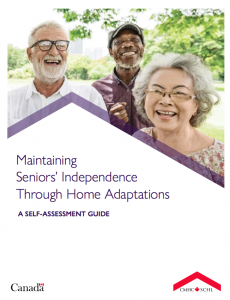
Designed for seniors, this large-print Guide identifies the types of difficulties seniors can experience in the home and describes adaptations to overcome these difficulties. This Guide helps seniors assess their own unique circumstances including using stairs, moving around the house, doing laundry and answering the door.
Developed by the Canadian Mortgage and Housing Corporation. -
You CAN prevent falls – Public Health Agency of Canada
-
Vous POUVEZ éviter les chutes ! – Agence de la santé publique du Canada
-
Finding Balance Ontario
Finding Balance is a campaign designed to increase awareness of fall prevention among older Ontarians. The campaign promotes real life strategies older adults can implement to reduce their risk of falling.
-
Winter outdoor safety
Learn about safe weather for children, how to prevent frostbites and how to tell whether or not ice is safe to go on.
-
Snowmobiling
-
Sledding and tobogganing
-
Skiing and snowboarding Mis à jour
-
Moving up to the big mountains
This is a five-minute segment of the film, GRAVITY: A Film about Serious Downhill Adventures in Safety.
-
Lift safety
This is a seven-minute segment of the film, GRAVITY: A Film about Serious Downhill Adventures in Safety.
-
Alpine responsibility code
This is a four-minute segment of the film, GRAVITY: A Film about Serious Downhill Adventures in Safety.
-
The right clothing, gear and preparation
This is a five-minute segment of the film, GRAVITY: A Film about Serious Downhill Adventures and Safety.
-
Ice hockey Mis à jour
-
Ice skating Mis à jour
-
Winter sports and recreation
Learn about how to enjoy winter by participating safely in ice hockey, ice skating, skiing and snowboarding, sledding and tobogganing, and snowmobiling.
-
Bike Safe Punjabi PSA
-
Annonce de service public « Bike Safe » en punjabi
-
Bike Safe Chinese PSA
-
Annonce de service public « Bike Safe » en chinois
-
Skateboarding
-
Soccer
-
Swimming
-
In-line skating
-
Horseback riding
-
Football
-
Diving
-
Cycling
Cycling is a healthy way to travel and injury risk lessens when roads are built to protect cyclists and vehicle speed limits lowered. Read also safety tips and best practices for cyclists of all ages.
-
Boating and sailing
-
Baseball
-
Summer sports and recreation
Safety tips for baseball, boating and sailing, camping and hiking, diving, football, horseback riding, in-line skating, skateboarding, soccer and swimming.
-
Smoke alarms Mis à jour
How to install and maintain smoke alarms, and the types of alarms you can use.
-
Hot tap water
- How to check and lower the tap water temperature in your home.
- Water temperature for health and cleaning concerns.
-
Burns and scalds
Safety tips to prevent burns and scalds in your home, including reducing tap water temperature and installing smoke alarms.
-
Sécurité à la maison – Kidde Canada
Un site internet présenté par Kidde Canada avec conseils et informations pour aider les Canadians à se protéger des dangers du feu et du monoxyde de carbone.
-
safeathome.ca
A tips and information website to help protect Canadians from the dangers of fire and carbon monoxide, provided by Kidde Canada.
-
Road safety
Prevent motor vehicle collisions by reducing your driving speed, adopting best driving practices and managing distractions.
-
Cannabis Mis à jour
Safety tips to ensure children are not accidentally exposed to cannabis.
-
Radon gas Mis à jour
-
Carbon monoxide Mis à jour
- How to prevent carbon monoxide poisoning at home.
- Installation and maintenance of carbon monoxide alarms.
-
Play parks and water features
How to help prevent drowning and other injuries from occurring on splash pads, wading pools, ponds, fountains and other water features.
-
Lifejackets and personal flotation devices (PFDs)
Key safety information about picking and using lifejackets for you and your child.
-
Around the house
How to keep your child safe from hazards around the house, such as fireplaces and televisions.
-
Safe sleep
Safety considerations for cribs, bunkbeds and sleepwear.
-
Product safety
Learn about consumer product and child safety in Canada, including the regulation of window blind and curtain cords, BPA, lead and pesticides.
-
Poisoning
Make your home a poison-free zone: learn how to prevent carbon monoxide poisoning and child poisoning from medications and recreational drugs such as cannabis, as well household products and personal care products.
-
Electrical safety
Electrical safety tips for parents.
-
Choking
Learn about common choking hazards for children and see our tips to prevent your child from choking, and further tips for preventing choking in older adults.
-
Bathtubs
How to keep your child safe in bathtubs.
-
Backyard pools
Reduce the risk of your child drowning in a backyard pool though pool fencing and safety equipment.
-
Play time
Safety tips for toys, baby walkers and stationary activity centres
-
Canadian Drowning Prevention Plan (6th edition, 2020)
-
Plan canadien de la prévention de la noyade (5ème edition, 2019)
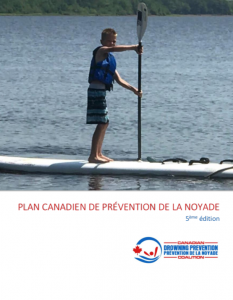
Préparé par le Canadian Drowning Prevention Coalition, la cinquième édition du Plan canadien de la prévention de la noyade comprend :
- Une présentation du rôle du Canadian Drowning Prevention Coalition.
- Un résumé de la problématique de la noyade au Canada.
- Un aperçu de la sensibilisation des collectivités, des coalitions et des outils.
- Un résumé de la méthodologie et participation multisectorielle et des conclusions sur les objectifs clés pour la prévention de la noyade au Canada.
-
Home safety
Key safety tips for parents on keeping your child safe around the house, at bed time, at play time and around electricity.
-
Stay On Your Feet – Australia
Stay On Your Feet® is Western Australia’s falls prevention program for older adults living in the community. Stay On Your Feet® aims to reduce falls and fall-related injuries among older adults living in the community and encourages older adults to feel confident in independent living.
-
Physical activity tips for older adults – Public Health Agency of Canada
The Government of Canada provides tips to get active and tips to help you get active.
-
Conseils d’activités physiques pour les aînés – Public Health Agency of Canada
Le gouvernement canadien fournit des conseils pour vous aider à rester actif.
-
Loop Junior – fall prevention community of practice
A fall prevention community of practice related to children’s falls. Loop Junior Connects you with more than 100 Community of Practice members. These are your peers and experts in the field of childhood fall prevention.
-
Loop Junior – Communauté engagée pour la prévention des chutes
Une communauté de pratique engagée dans la prévention des chutes chez les enfants. Loop Junior vous met en contact avec plus de 100 membres de la communauté de pratique. Ce sont vos pairs et experts dans la prévention des chutes chez les enfants.
-
Child Safety Link – Falls
This website provides additional resources on fall prevention. Child Safety Link (CSL) is an injury prevention program at the IWK Health Centre dedicated to reducing the incidence and severity of unintentional injury to children and youth in the Maritimes.
-
Child Safety Link – Les chutes
Ce site web fournit des ressources supplémentaires sur la prévention des chutes. Le Child Safety Link (CSL) est un programme de prévention des blessures du IWK Health Centre dédié à la réduction de l’incidence et de la sévérité des blessures chez les enfants et les jeunes dans les provinces maritimes.
-
Mois de la prévention des chutes
Notre vision : au Canada, tout le monde a un rôle à jouer pour prévenir les chutes.
Notre mission : donner aux fournisseurs de services et de soins de santé et aux intervenants des entreprises, du gouvernement et des établissements scolaires les outils nécessaires pour sensibiliser et faire participer leurs collectivités à la prévention des chutes et des blessures attribuables à une chute. -
Fall Prevention Month
-
Drowning
Drowning prevention tips for parents to keep children safe in bathtubs, backyard pools and play parks and water features.
-
Rail safety
Learn how to stay safe around railway tracks: see our tip sheets for kids, teens and parents.
-
Child car safety
Read about things to consider to keep your child safe in motor vehicles:
- Air bags
- Add-on products
- Back seat or front seat
- Clothing in car seats
- Leaving your child alone in the car
- Sleeping in car seats
-
Other ways to travel
How to safely transport your child on school buses, airplanes, taxis, ride shares and motor homes.
-
Choosing the right car seat
Should your child be using a rear-facing car seat, forward-facing car seat, booster seats or just using seatbelt? Find out which is the right car seat for your child and watch the video guides on how to install them.
-
Car seats
How to keep your child safe while travelling in a motor vehicle or other modes of transportation, including how to choose the right car seat.
-
Winter holidays
Safety tips to keep in mind during the winter holidays when we add candles, Christmas trees, potentially dangerous plants, fireplaces, holiday lights, entertaining and travel into our lives.
-
Vacation safety
Going on vacation? Check out our safety tips for travelling to both cold and warm weather destinations, and for travelling with children.
-
Trampolines Mis à jour
-
Unstructured outdoor play and risky play
Benefits to your child engaging in unstructured outdoor play and risky play.
-
Pedestrian safety Mis à jour
What you can do to teach children about crossing the street safely and how to determine when they can cross streets safely by themselves.
-
Helmets for winter activities
-
Helmets for bicycles, inline skating, scooter riding and skateboarding
-
Camping and hiking
-
Built playgrounds Mis à jour
What to look out for in community and backyard playgrounds.
-
outsideplay.ca
An online tool to help parents and caregivers gain confidence to allow kids to engage in outdoor play. Outside play.ca was a collaborative initiative between the University of British Columbia, BC Children’s Hospital and the BC Injury Research and Prevention Unit.
-
Outsideplay.ca – Prends un risque, va jouer dehors !
Un outil numérique pour aider les parents et les gardiens à encourager les enfants à gagner en confiance pour s’adonner au jeu en plein air. Outside play.ca était une initiative collaborative entre l’Université de Colombie-Britannique, le BC Children’s Hospital et le BC Injury Research and Prevention Unit.
-
Playgrounds and play spaces Mis à jour
Safety features and hazards to look out for in playgrounds, safety concerns about trampolines and benefits of unstructured outdoor play and risky play.
-
Walk Safe Chinese PSA
-
“Walk Safe” en chinois
-
Walk Safe Punjabi PSA
-
“Walk Safe” en punjabi
-
Vision Zero International Handbook
-
Guide International Vision Zéro (International Vision Zero Handbook)
-
Helmets and concussion
This is a segment of the film, GRAVITY: A Film about Serious Downhill Adventures in Safety.
-
Helmets
Learn about proper helmet fitting and replacements, which helmets are safe to use and which helmets to use for which activity.
-
Espace presse
-
Media
-
Partenaires et donateurs
-
Partners and donors
-
Faire un don
-
Donate
-
Ressources Professionnelles
-
Professional Resources
-
Programmes
-
Programs
-
Injury Topics
-
Sujets Blessures
-
À propos
-
About us
-
Accueil
-
Home
-
Pamela Fuselli
-
Pamela Fuselli
-
Prevent carbon monoxide poisoning – Government of Canada
Learn about carbon monoxide and its potentially fatal effects. Also learn about alarms (detectors) and how to ensure safe home and air quality through appliance maintenance and inspections.
-
Sécurité au monoxyde de carbone – Calgary Fire Department
La ville de Calgary fournit des informations sur la sécurité au monoxyde de carbone et sur les détecteurs.
-
Carbon monoxide safety – Calgary Fire Department
The City of Calgary provides information on carbon monoxide safety and alarms.
-
Sécurité des produits de consommation – Santé Canada
Pour plus d’informations à propos de la déclaration des incidents, des rappels et des alertes, des exigences concernant les produits de consommation ainsi que des renseignements sur les cosmétiques et sur la sécurité des produits de consommation, consultez le site internet ou composez le 1-866-662-0666.
-
Consumer products safety – Health Canada
For more information on incident reporting, product recalls and alerts, cosmetic information, product safety education and consumer product requirements, visit this website or call 1-866-662-0666.
-
The Canadian Vision Zero Landscape: A Parachute White Paper
Parachute is preparing a white paper, to be shared through the Parachute Vision Zero Network and presented at conferences, that will undertake an in-depth analysis of Vision Zero in Canada, examining where different regions of the country are on the continuum of concept to implementation and evaluation.
-
Le contexte canadien Vision Zéro : un Livre blanc de Parachute
Parachute prépare actuellement un Livre blanc, qui sera distribué par l’entremise du Réseau Vision Zéro de Parachute et présenté lors de conférences. Ce document entreprendra une analyse approfondie de la Vision Zéro au Canada, en examinant où en sont les différentes régions du pays dans le continuum du concept, de la mise en œuvre à l’évaluation.
-
Halloween safety
Safety tips for parents, caregivers and drivers to keep Halloween night a safe night for all.
-
B.C. teen Rachelle Clark winner of the 2019 Stacey Levitt Memorial Award
-
Engaging Youth as Community Actors: National Teen Driver Safety Week
Youth hold an important place within Vision Zero. For one, children and youth are among the most vulnerable road users. In Canada, young drivers die in crashes at a higher rate than any other age group[1]. Canadians aged 5 to 14 are at greater risk of being killed as a pedestrian than any other age group[2]. On the road to zero, many jurisdictions are making the safety of children and youth their first priority, as evidenced by Vision Zero for Youth.
-
Gardez vos enfants en sécurité pendant qu’ils passent l’Halloween
La seule chose effrayante au sujet de l’Halloween devrait être les costumes.
-
Keep trick-or-treaters safe on our roads this Halloween
The only thing scary about Halloween trick-or-treating should be the spooky costumes.
-
Young drivers and their passengers need to #Know
What Impaired Means Parachute’s National Teen Driver Safety Week Oct. 22 to 28 aims to reduce drugged driving and teach about driving safely without impairment, distraction, and aggression.
-
Les jeunes conducteurs et leurs passagers doivent savoir ce #quesignifiefacultésaffaiblies
La Semaine nationale de la sécurité des adolescents au volant, organisée par Parachute du 22 au 28 octobre, vise à réduire la conduite sous l’effet de la drogue et à enseigner à conduire prudemment, sans facultés affaiblies, sans distraction et sans agressivité.
-
Légalisation du cannabis au Canada : n’oubliez pas que le cannabis peut être toxique chez les enfant
Une semaine avant la légalisation du cannabis à usage récréatif pour les adultes canadiens, Parachute, le principal organisme de bienfaisance voué à la prévention des blessures au Canada, se joint aux centres antipoison du pays pour rappeler à la population que le cannabis, à l’instar de l’alcool et des médicaments sur ordonnance, peut être très néfaste pour les enfants et qu’il doit, par conséquent, être rangé de façon sécuritaire.
-
As cannabis becomes a legal drug in Canada, remember it can be poisonous to children
As cannabis becomes a legal drug for adults in Canada one week from today, Canada’s leading charity dedicated to injury prevention, along with the nation’s poison control centres, remind Canadians that this drug, just like alcohol and prescription drugs, can do serious harm to children and needs to be stored securely.
-
2017 President’s Report
-
Parachute launches “This was not an accident” Vision Zero awareness campaign
Donated billboards in B.C., Alberta, Ontario and Montreal drive understanding that road collisions can be prevented.
-
Parachute lance sa campagne de sensibilisation Vision Zéro, intitulée « Ce n’était pas un accident »
Des panneaux d’affichage offerts gracieusement en Colombie-Britannique, en Alberta, en Ontario et à Montréal aident les automobilistes à comprendre que les collisions routières peuvent être prévenues.
-
Parachute’s Second Annual National Injury Prevention Day July 5
Parachute, Canada's national charity dedicated to reducing the devastating impact of preventable injuries, is leading National Injury Prevention Day to raise awareness for this important health issue.
-
TD I Think First contest winners announced
Students from Kindergarten to Grade 8 from across Canada were invited to submit creative art projects, explaining in their own words why and how they « Think First! » to prevent injury when they are active at play, school, or at home.
-
Les protocoles sur les commotions cérébrales dans le sport sont maintenant adoptés
À peine neuf mois après que Parachute a annoncé les toutes premières Lignes directrices canadiennes sur les commotions cérébrales dans le sport, un nombre croissant d’organismes nationaux de sport du Canada ont mis en place des protocoles sur les commotions cérébrales qui sont harmonisés avec les principes et les pratiques exemplaires énoncés dans les lignes directrices.
-
Sport Concussion Protocols now adopted by National Sport Organizations in Canada
Just nine months after Parachute announced the first-ever Canadian Guideline on Concussion in Sport, a growing number of Canada’s National Sport Organizations have in place sport concussion protocols harmonized with the guideline’s principles and best practices.
-
Canadian Child Safety Report Card results
Provinces with strong evidence-based injury prevention policies have fewer child and youth hospitalizations and deaths from road-traffic-related causes.
-
Résultats du Canadian Child Safety Report Card
Les provinces qui se sont dotées de solides politiques de prévention des blessures reposant sur des données probantes affichent des taux moindres d’hospitalisations et de décès attribuables à des causes liées au trafic routier chez les enfants et les jeunes.
-
Parachute Safe Kids Week 2018 runs June 4 to 10
Parachute Safe Kids Week, held in communities across Canada from June 4 to 10, 2018, will focus on how parents and caregivers can prevent, recognize, and help manage concussions in children.
-
Trois brigadiers scolaires de la Colombie-Britannique et de l’Ontario choisis comme les favoris du C
Trois brigadiers scolaires exceptionnels qui vont au-delà de leur devoir ont été choisis comme gagnants du Concours des brigadières et brigadiers scolaires favoris du Canada 2018.
-
Three crossing guards from B.C. and Ontario chosen as Canada’s favourites
Three exceptional school crossing guards who go above and beyond the call of duty have been chosen as winners of the 2018 Canada’s Favourite Crossing Guard Contest.
-
Be alert: “Trauma Season” begins on Canada’s roadways
As the Victoria Day long weekend approaches, the days are longer, the bad weather is over – and your chances of causing or suffering traumatic injuries on our roads is 30 per cent higher than they are from September through May.
-
Is the ability to operate a cell phone via Bluetooth influenced by the driver’s vehicle?
Martin Lavallière is a professor in the Department of Health Sciences (Kinesiology Program) at the University of Quebec in Chicoutimi. His research focuses on road safety, human factors and ergonomics and mobility and autonomy.
-
L’utilisation d’un téléphone cellulaire en mode Bluetooth est-elle influencée par le véhicule du conducteur?
Martin Lavallière est professeur au département des sciences de la santé (programme de kinésiologie) de l’Université du Québec à Chicoutimi.Il s’intéresse à la sécurité routière, aux facteurs humains et à l’ergonomie ainsi qu’à la mobilité et à l’autonomie.
-
Nova Scotian teen Kate Walsh winner of the 2018 Stacey Levitt Memorial Award
Walsh, 18, is the elected student council president at Charles P. Allen High School in Bedford, N.S.
-
2018 Vision Zero Advocate Conference in Toronto
The 2018 Vision Zero Advocate Conference in Toronto February 28 – March 2 was a highly informative event, where Canadian and international experts – from government and major corporations, to grassroots advocates – came together to share their experiences and discuss “What’s next for Vision Zero?”
-
Conférence des intervenants de Vision Zéro 2018 à Toronto
Nous avons participé à la Conférence des intervenants de Vision Zéro 2018, qui s’est tenue à Toronto du 28 février au 2 mars. Félicitations au Vision Zero Advocacy Institute, qui a organisé cet événement des plus instructifs, où des spécialistes du secteur public et privé canadien et étranger et de simples citoyens ont pu se rencontrer, se raconter et discuter de l’avenir de Vision Zéro. Au cours des paragraphes qui suivent, nous vous ferons découvrir ce que nous avons appris des nombreuses présentations et conversations enrichissantes qui ont marqué cet événement.
-
Cannabis research suggests feds’ pot laws a guessing game – by Ed Prutschi
For a government that promised to legislate using evidence-based science, the rapid approach of legalized marijuana in Canada is starting to look like a case study in blind faith.
-
Le gouvernement va légaliser le cannabis, même si on en sait somme toute peu de choses – par Ed Prutschi
Même si les dirigeants en place ont promis de baser leurs lois sur des faits scientifiques, la légalisation de la marijuana, qui arrive à grands pas, ressemble de plus en plus à une profession de foi.
-
Using Drones to Make Roads Safer
Unmanned Aerial Vehicles (UAVs) or “drones” are being used by traffic engineers and road safety professionals to enhance data collection and road safety efforts. On September 8, 2017, we sat down with Mark Hearson, a Rhodes Scholar in civil engineering and Transport Infrastructure Specialist from Fireseeds North Infrastructure in Winnipeg, to discuss how drones are changing traditional approaches to road safety.
-
Appel à tous les conducteurs adolescents – mettons fin à la conduite sous l’emprise de la drogue
La Semaine nationale de la sécurité des adolescents au volant de Parachute a pour objet d’aider les adolescents à faire preuve de #prudenceauvolant
-
Calling on teen drivers to prevent drugged driving and save lives
Parachute’s National Teen Driver Safety Week wants teens to #GetHomeSafe
-
Rick Hansen Institute pledges support to prevent spinal cord injuries in hockey
The Rick Hansen Institute is pleased to announce it is partnering with Parachute to support the prevention of spinal cord injuries (SCI) in hockey.
-
Technology, urbanism, and the car: What is the future of road safety?
How is technology changing? To who’s benefit? And what does this mean for Vision Zero?Well to begin with, the world is becoming more urban. By 2050 it’s expected that nearly 90% (87.6 to be exact) of Canada’s population will live in urban areas. This has city planners, architects, engineers and policy makers re-designing our cities to be more dense, mobile, green and economically vibrant.
-
Technologies, urbanisme et automobile : quel est l’avenir de la sécurité routière?
Comment les technologies évoluent-elles? Qui en bénéficie? Et quels sont les impacts pour Vision zéro.
-
Concussion baseline testing not required or recommended for youth athletes: Parachute statement
Parachute has released a set of key recommendations aimed at sport organizations, parents, and healthcare professionals.
-
« Baissez le téléphone et levez la tête » – Cinq étapes pour aider à garder les enfants en sécurité
Parachute et FedEx Express Canada rappellent aux parents et aux conducteurs qu’ils doivent s’assurer que les enfants peuvent marcher en toute sécurité lorsqu’ils se rendent à l’école ou en reviennent.
-
‘Phones down, heads up’ – Five steps to help keep kids safe as they head back to school
Parachute and FedEx Express Canada are reminding parents and drivers to ensure kids can walk safely to and from school on our neighbourhood streets.
-
New Rail Safety Program Plans to Save Lives
Parachute is pleased to announce the two-year #CrossSAFE initiative, aiming to increase rail safety awareness and stop preventable injury in its tracks.
-
An Interview with Operation Lifesaver
Operation Lifesaver (OL) is a not-for-profit that works to educate Canadians about rail safety.
-
Opération Gareautrain : qu’est-ce que c’est?
Opération Gareautrain (OG) est un organisme sans but lucratif qui a pour mission d’éduquer les Canadiennes et les Canadiens en matière de sécurité ferroviaire.
-
Vision Zero: North Bay Road Safety Strategy
Pat Cliche and Staff Sgt. Rick Dubeau are Co-Chairs of the North Bay Road Safety Committee. Pat is also known to Parachute staff in her role as Northern Injury Prevention Coordinator (OIPRC). We interviewed them to find out more about how North Bay is incorporating Vision Zero into their community’s road safety approach.
-
Vision Zéro : la stratégie de sécurité routière de North Bay
Pat Cliche et le sergent d’état-major Rick Dubeau sont coprésidents du comité pour la sécurité routière à North Bay. L’équipe de Parachute connaît aussi Mme Cliche en tant que coordonnatrice de la prévention des blessures dans le Nord, de l’Ontario Injury Prevention Resource Centre (OIPRC). Nous avons rencontré les coprésidents pour en apprendre davantage sur la façon dont le concept Vision Zéro a été intégré à l’approche de sécurité routière de North Bay.
-
Parachute annonce les Lignes directrices canadiennes sur les commotions cérébrales dans le sport
Parachute annonce les nouvelles Lignes directrices canadiennes sur les commotions cérébrales dans le sport.
-
Parachute announces Canadian Guideline on Concussion in Sport to protect health of active Canadians
Parachute is announcing the new Canadian Guideline on Concussion in Sport.
-
An Interview with ATS & The Vision Zero Advocate Institute
The Vision Zero Advocate Institute is the natural evolution of 50 years of traffic safety solutions. Supported by ATS Traffic, the Institute is a network of coaches, experts and Vision Zero innovators.
-
Entrevue avec ATS et le Vision Zero Advocate Institute
Le Vision Zero Advocate Institute est le fruit de l’évolution naturelle de 50 ans de solutions de sécurité routière. Appuyé par ATS Traffic, l’Institute est un réseau d’accompagnateurs, d’experts et d’innovateurs Vision zéro.
-
2016 Annual Report
-
Canada Shines a Light on First Annual National Injury Prevention Day
Parachute introduces its first-ever National Injury Prevention Day to shine a light on preventable injury.
-
Vision Zero Conference Stockholm
Valerie Smith, Director of Solutions at Parachute, had a great opportunity to attend the International Vision Zero Conference in Stockholm, Sweden June 14-15.
-
Congrès international de Vision Zéro à Stockholm
Valerie Smith, directrice, Solutions chez Parachute, a eu la chance de participer au congrès international de Vision zéro à Stockholm, en Suède, les 14 et 15 juin dernier.
-
Vision Zero: What the numbers tell us
Thank you for a very successful launch of the Parachute Vision Zero Network. From partners signing up (by the hundreds!), to community organizations sharing our messages to governments getting engaged, we are thrilled with the response!We are pleased to announce our second Vision Zero Summit! SAVE THE DATE! The Summit will be taking place in Toronto on October 16th and 17th at the Marriott Downtown Eaton Centre Hotel.
-
Three Crossing Guard winners chosen as Canada’s Favourites
Parachute and FedEx Express Canada award three recipients of the 2017 Canada's Favourite Crossing Guard Contest for their tremendous efforts in keeping kids safe on the road.
-
Bruce Peninsula puts ‘safety first’ and becomes a Parachute Designated Canadian Safe Community
After a two-year process, a local effort to create a community that promotes safety and prevents injuries will be celebrated at the Ferndale Visitors Centre Pavilion. This celebration formally recognizes Bruce Peninsula as a designated ‘Safe Community’.
-
An Interview with The Jessica Campaign
An interview with Jeannette Holman-Price of The Jessica Campaign. The Jessica Campaign (“TJC”) is a public advocacy for long overdue upgrades to motor vehicle safety standards and legislation across North America. Started in Canada following the preventable and needless death of 21-year-old Jessica Holman-Price, M.B., TJC continues to strive to become a leading force behind Canada’s Vision Zero Goals.
-
Entretien avec Jeannette Holman-Price, de The Jessica Campaign
The Jessica Campaign (TJC) milite afin que les modifications attendues depuis longtemps soient enfin apportées aux normes et aux lois en matière de sécurité des véhicules automobiles en Amérique du Nord. Créé au Canada après la mort évitable et inutile de Jessica Holman-Price, M.B., à l’âge de 21 ans, TJC continue de tout mettre en œuvre pour venir appuyer activement Vision Zéro dans l’atteinte de ses objectifs au Canada. Depuis la mort de sa fille, Jeannette Holman-Price a fait pression sans relâche pour que nos législateurs, partout en Amérique du Nord, utilisent les outils qu’ils ont facilement à leur portée.
-
Vision Zero Cities 2017 Conference, New York City
The Vision Zero Cities 2017 Conference in New York City provided an inspirational and transformative experience, showcasing the Vision Zero Movement both in U.S. and internationally.
-
Vision Zéro : ce que nous disent les chiffres
Le lancement du Réseau Vison Zéro de Parachute a connu un succès retentissant. Nous vous en remercions! Des partenaires qui adhèrent (par centaines) aux organismes communautaires qui diffusent notre message en passant par les gouvernements qui se mobilisent, nous sommes emballés par la réponse que nous avons obtenue!
-
All-terrain vehicles
ATVs cause more permanent disabilities and death than most other sport or recreational activities. Here are our safety tips for ATV operation.
-
Parachute appoints Steve Podborski as President & CEO, June 5, 2017
Parachute today announced the appointment of Steve Podborski to the role of Parachute President & CEO. Effective June 5, 2017, Steve will assume leadership for Parachute’s strategic direction, fundraising initiatives, program delivery and day-to-day operations.
-
Message from our CEO
Our first blog marks the official launch of the Parachute Vision Zero Network. We discuss the development, goals and some of the resources that we will be publishing on a quarterly basis.
-
Message de la présidente-directrice générale
Notre premier billet de blogue marque l’inauguration du le Réseau Vision Zéro de Parachute. Nous y abordons les origines et les objectifs du Réseau ainsi que certaines des ressources que nous publierons tous les trimestres.
-
Parachute nomme Steve Podborski président et directeur-général à compter du 5 juin 2017.
Parachute a annoncé aujourd’hui la nomination de Steve Podborski au poste de président et directeur-général de Parachute. À partir du 5 juin 2017, Steve gèrera les opérations de direction stratégique, les initiatives de levées de fonds, la prestation de programmes et les opérations quotidiennes de Parachute.
-
Spring time change means ‘sleepy’ Canadians need to be extra alert on roadways
Walk This Way program, a national pedestrian safety awareness campaign, encourages pedestrians and drivers to be extra vigilant on the roads as we set our clocks one hour ahead for spring time change.
-
Parachute and State Farm Canada Partner for Vision Zero
Parachute is pleased to announce its renewed partnership with State Farm Canada for Vision Zero, a multi-national traffic safety initiative.
-
Hands-On Program Teaches Young Minds About Brain Health
Parachute and Economical Insurance announced the renewed two-year partnership for Brain Waves, an interactive, hands-on neuroscience program developed for young Canadian students.
-
Year End Message From Pamela Fuselli
Interim CEO, Pamela Fuselli reflects on Parachute's 2016 accomplishments, and wishes everyone a happy and safe holiday season.
-
Zero expectations drive efforts to drastically reduce traffic-related deaths in Canada
Parachute hosts Canada's first Vision Zero Summit, focused on ways of implementing a comprehensive road safety strategy.
-
Government takes action to develop national guidelines for concussion management
The Federal Government announces $1.4 million to develop an evidence-based approach to concussion prevention, management and awareness.
-
Time
Play puts Moviegoers in the Driver’s Seat to Save Lives A new movie experience called 'Choices,' allows audience members to use their smartphones to interact and help make decisions on the big screen.
-
Driving home the importance of road safety can make Halloween less frightening for trick-or-treaters
Parachute Walk This Way program reminds all road users to be vigilant and stay safe on Halloween.
-
Distracted and Drugged Driving accelerate concerns over teen driver safety
-
Parachute and Safe Communities Encourage Canadians to #Get
Home Safe Parachute's Safe Communities Day encourages Canadians to help reduce the number of distracted drivers by participating in the #GetHomeSafe social media campaign.
-
2015 Annual Report
-
Windsor pledges to put ‘safety first’ as it officially becomes a Parachute Designated Safe Community
Windsor receives certification as it becomes the 67th Parachute Designated Canadian Safe Community.
-
#Safe4Life poll finds young workers unwilling to ring ‘safety alarm’ on workplace hazards
Parachute #Safe4Life poll finds nearly half of young workers aged 16-19 admit they would be embarrassed to ask about workplace safety hazards.
-
Rowan’s Law passes in the Ontario Legislature
Parachute is pleased with the passing of Rowan's Law, the first of its kind concussion legislation in Ontario.
-
Federal Minister of Health launches mobile concussions app
New mobile technology could help save lives, prevent long-term damage
-
Education, rules and enforcement- keys to reducing spinal injuries in ice hockey
The need for continued injury prevention, education and awareness to reduce spinal cord injuries in ice hockey.
-
Parachute and State Farm continue partnership for driver safety
Parachute thanks State Farm for its generous support for National Teen Driver Safety Week in Canada
-
PSHSA Announces Major Donation to Health and Safety Charities
$20,000 donation plus ongoing proceeds from new JHSC standard certification training will be made to Parachute and Threads of Life
-
Cost of preventable injuries continuing to grow says new report
New data from The Cost of Injury in Canada Report shows the financial costs of preventable injuries are rising, while the human costs are catastrophic.
-
Honorary Chair Wayne Gretzky, along with Martin Short and Jason Priestley,
Gala co-chairs Michael Budman, Diane Bald and Don & Denyse Green join Honorary Chair Wayne Gretzky, along with well-known actors Martin Short and Jason Priestley, to honour Dr. Charles H. Tator at the inaugural Parachute Gala on May 20, 2015 at the Fairmont Royal York Hotel.
-
L’excès de vitesse et la circulation intense au premier rang des inquiétudes des parents quant à la
Soixante-quinze pour cent des parents s’inquiètent de voir leurs enfants partager la route avec les voitures nombreuses ou en excès de vitesse et seulement 28 % des élèves se rendent à l’école à pied, selon une nouvelle enquête nationale de Parachute et FedEx Express Canada.
-
Speeding cars and traffic top child pedestrian safety concerns for parents
Seventy five percent of parents are concerned about their children sharing the road with speeding cars and traffic, and only 28% of students are walking to school, according to a new national survey from Parachute and FedEx Express Canada.
-
Safety First: Northumberland County officially marks designation as Safe Community
A ceremony to officially recognize Northumberland County’s designation as a ‘Safe Community’ takes place on Wednesday, April 8, at the Baltimore Recreation Centre (23 Community Centre Road). The event will feature interactive activities and displays from 10 am to 1:30 pm. The formal designation ceremony begins at 11 am.
-
Parachute and Procter & Gamble partner to educate about poison prevention
Parachute, the national charitable organization dedicated to preventing injuries and saving lives, is partnering with Procter & Gamble Canada (P&G) to educate Canadians and help reduce the number of incidents as a result of access to laundry detergent products by children. The announcement was made during Poison Prevention Week, with the focus this year being on laundry detergent packets.
-
L’industrie annonce la publication de lignes directrices volontaires concernant le conditionnement e
L'Association canadienne de produits de consommation spécialisés (ACPCS) vient de publier un document d'orientation volontaire sur l'étiquetage et l'emballage des sachets de détergents liquides à lessive afin de contribuer à réduire les risques d'exposition accidentelle des enfants à ces produits.
-
Industry Announces Voluntary Guidelines for Single Unit Liquid Laundry Detergent
The Canadian Consumer Specialty Products Association (CCSPA) has released a voluntary guidance document for the labelling and packaging of liquid laundry detergent packets to help reduce the number of unintentional child exposures to the products.
-
Town of Halton Hills designated the 65th Safe Community in Canada
Community leaders were today celebrating the designation of Halton Hills as the 65th Safe Community in Canada.
-
Quatre brigadiers exceptionnels désignés comme les préférés des Canadiens
Des brigadiers scolaires qui ont fait une différence dans leur vie des élèves de leurs communautés locales et qui ont fait preuve d’un dévouement exceptionnel ont été sélectionnés pour cet honneur, partout au pays.
-
Cinquante et un pour cent des adolescents canadiens rapportent avoir été heurtés ou presque pendant
Les résultats de cette enquête sur la sécurité des piétons, menée auprès de 510 adolescents, ont été présentés aujourd’hui aux élèves de l’école secondaire Northern. La présentation faisait partie d’une campagne de sensibilisation invitant les Canadiens à observer une minute de silence, à mettre de côté leur appareil et à se montrer attentifs au moment de traverser la rue. Ce message d’intérêt public est dédié aux milliers de jeunes piétons canadiens qui chaque année succombent ou subissent des blessures.
-
51% percent of Canadian teens say they have been hit or nearly hit while walking
The results of the pedestrian safety survey, conducted amongst 510 teens, were shared today with students from Northern Secondary School as part of a national awareness initiative to encourage Canadians to commit to taking a Moment of Silence, by putting their device down and paying attention when crossing the street.
-
Halloween means parents and drivers should focus on the ghosts and goblins
On Halloween, Parachute and FedEx Express Canada are urging all road users to drive with extra care so that all ghosts and goblins, as well as their parents and grandparents, will stay safe and sound this ghoulish night.
-
Parachute asks Canadians to stop the clock on distracted driving during NTDSW
This week, Canadians across the country are focused on the dangers of distracted driving as part of Parachute’s National Teen Driver Safety Week.
-
Le gouvernement du Canada et Parachute exhortent les adolescents à arrêter d’envoyer des messages
Aujourd’hui, l’honorable Rona Ambrose, ministre de la Santé, l’honorable Lisa Raitt, ministre des Transports, et Laureen Harper se sont jointes à Louise Logan, présidente et directrice générale de Parachute, pour exhorter 500 élèves du cycle supérieur de l’école secondaire Nepean à ne plus envoyer de messages textes en conduisant.
-
The Government of Canada and Parachute urge teenagers to stop texting and driving
Today The Hon. Rona Ambrose, Minister of Health, The Hon. Lisa Raitt, Minister of Transport and Mrs. Laureen Harper join Parachute CEO Louise Logan in urging 500 senior students at Nepean High School to stop texting while driving.
-
There’s more to getting ready for spring than wearing a lighter coat
With spring officially here and the warm weather upon us, children and their parents are excited to be able to get outside.
-
Le programme PLAY s’attaque au problème des blessures évitables chez les jeunes Autochtones
Parachute, Right To Play et le ministère de la Santé et des Soins de longue durée de l’Ontario ont annoncé aujourd’hui le lancement d’un programme pluriannuel visant à répondre au taux élevé de blessures évitables constaté chez les jeunes Autochtones en Ontario.
-
PLAY Program to tackle preventable injuries among Aboriginal youth
Parachute, Right To Play and the Ontario Ministry of Health and Long-Term Care today announced a multi-year program as a response to the high rate of preventable injury among Aboriginal youth in Ontario.
-
Chevrolet lance son nouveau programme Sûr et rassurant d’ateliers sur l’installation de sièges
-
Chevrolet launches new Safe and Sure Child Car Seat Installation Workshop Program
Children are our most precious cargo, but when parents don’t know proper car seat safety procedures, they put their children’s lives at risk on the roads.
-
Mc
Connell Foundation Supports Parachute -
Government of Canada Promotes Toy Safety During the Holiday Season
On behalf of the Minister of Health, Rona Ambrose, Parliamentary Secretary, Eve Adams, Member of Parliament for Mississauga – Brampton South, Ontario today reminded Canadians to choose wisely this holiday season when shopping for toys for children and to keep injury prevention top of mind.
-
Le pilote de voitures NASCAR Denny Hamlin, Fed
Ex Express encouragent les conducteurs à ralentir Le pilote de voitures NASCAR Denny Hamlin, FedEx Express Canada et Parachute encouragent les conducteurs à ralentir
-
NASCAR Driver Denny Hamlin, Fed
Ex Express Canada and Parachute Encourage Drivers to Slow Down Denny Hamlin invites Canadians to take the Pace Car pledge
-
No Regrets Live presents at St. Matthew Catholic School
No Regrets Live show at St. Matthew Catholic School.
-
No Regrets Live presents at Pine Ridge Secondary School
No Regrets Live show at Pine Ridge Secondary School
-
No Regrets Live presents at Sexsmith Secondary School
No Regrets Live show at Sexsmith Secondary School.
-
No Regrets Live presents at Ajax High School
No Regrets Live show at Ajax High School.
-
No Regrets Live presents at Sydenham High School
No Regrets Live show at Sydenham High School.
-
No Regrets Live presents at Pickering High School
No Regrets Live show at Pickering High School.
-
No Regrets Live presents at Peace Wapiti Academy
No Regrets Live show at Peace Wapiti Academy.
-
No Regrets Live presents at Dunbarton High School
No Regrets Live show at Dunbarton High School.
-
No Regrets Live presents at Lockerby Composite School
No Regrets Live show at Lockerby Composite School
-
No Regrets Live presents at Lo-Ellen Park Secondary School
No Regrets Live presents at Lo-Ellen Park Secondary School
-
Canada’s Influential Sport, Wellness and Health Orgs Offer Unprecedented Help to Get Kids Active
More than 60 of Canada's Leading Companies and Organizations Join Forces to Get Kids ACTIVE AT SCHOOL. Parachute is one of the partners in this movement.
-
Minister Joe Oliver Announces Support for the CIPSPC
The Honourable Joe Oliver, Minister of Natural Resources and Member of Parliament (Eglinton-Lawrence), today announced funding to enable the organization Parachute to offer simultaneous interpretation and translation services at the Canadian Injury Prevention and Safety Promotion Conference, to be held in Montréal in partnership with the Canadian Red Cross.
-
La ministre des Transports assiste au symposium sur les jeunes et la sécurité routière
Lors d'un symposium national sur les jeunes et la sécurité routière, la ministre des Transports Lisa Raitt a félicité les participants pour avoir fait preuve de leadership et contribué à la sécurité des routes de leurs communautés.
-
Transport Minister addresses Parachute’s youth road safety symposium
Transport Minister Lisa Raitt yesterday congratulated attendees at a national youth road safety symposium on their leadership in working to make roads safer in their communities.
-
No Regrets Live presents at Safe Community Wood Buffalo
No Regrets Live show at Safe Community Wood Buffalo
-
Conduisez comme si c’était l’Halloween en tout temps
FedEx et Parachute, organisme national à but non lucratif dont la mission est de réduire les blessures et de sauver des vies, ont quelques conseils destinés aux conducteurs et aux parents pour s’assurer que les enfants puissent marcher en toute sécurité dans leur quartier, tout au long de l’année.
-
Le discours du Trône marque une nouvelle étape pour la prévention des blessures au Canada
Le discours du Trône prononcé aujourd’hui marque une nouvelle étape pour la prévention des blessures au Canada, indique Parachute.
-
Speech from the throne marks a new chapter for injury prevention in Canada
Today’s Speech from the Throne marked a new chapter for injury prevention in Canada, Parachute said today in a news release.
-
Drive like it’s Halloween every night
Parachute & FedEx Express Canada urge drivers to be mindful of young pedestrians every day of the year, not just at Halloween.
-
Media advisory: Youth Symposium in Ottawa to focus awareness on teen driver safety
A Youth Symposium at Ottawa’s National Arts Centre on Oct. 22 will focus attention on youth and road safety as part of Parachute’s Project Gearshift. Parachute is delighted to host Transport Minister Lisa Raitt for part of the day as an honoured guest and to have her address the students.
-
More than $300,000 granted to five Canadian service-learning projects
State Farm has issued a news release about its support for youth projects in Canada, including working with Parachute to establish a National Teen Driver Safety Week.
-
Youth bring together road safety experts on Sept. 25
Two Northern Secondary School students, youth ambassadors for Parachute’s Project Gearshift, will bring in road safety experts for a Sept. 25 community leader meeting on pedestrian safety.
-
Parents and teen drivers disconnected on graduated licensing
State Farm Canada has issued a news release illustrating a disconnect between Canadian teens and their parents on graduated driver licensing. Parachute is partnering with State Farm to establish a National Teen Driver Safety Week.
-
Les Canadiens invités à agir pour prévenir le suicide et à en parler ouvertement
À l’occasion de la Journée mondiale de la prévention du suicide, la Commission de la santé mentale du Canada, l’Association canadienne pour la prévention du suicide et l’organisme national qui représente les Inuits, Tapiriit Kanatami, invitent les Canadiens à joindre un mouvement mondial pour célébrer la vie et sauver des vies.
-
Canadians encouraged to engage in conversation, take action to prevent suicide
This joint news release of the Mental Health Commission of Canada, the Inuit Tapiriit Kanatami and the Canadian Association for Suicide Prevention, was issued to mark World Suicide Prevention Day.
-
Local students bring safe driving messages to school
Student ambassadors for Parachute’s national Project Gearshift campaign are leading the teen driver safety cause at their Fredericton school.
-
Local students to cheer on their safely crossing peers
Students participating in Parachute’s Project Gearshift, a national teen driver safety campaign, will be encouraging youth to use crosswalks outside their Toronto high school.
-
À la rentrée, conducteurs et parents doivent mettre l’accent sur la sécurité
La rentrée scolaire étant à nos portes, Parachute et FedEx Express Canada souhaitent rappeler à tous les usagers de la route que l’arrêt le plus important qu’ils auront à faire est aux passages pour écoliers.
-
Back-to-School Means Focusing on Safety for Drivers and Parents
It’s back-to-school time, and Parachute and FedEx Express Canada want all road users to remember that the most important stop they can make is at school crossings.
-
Before you think only other swimmers drown, have a word with yourself
During this National Drowning Prevention Week, the Hastings & Prince Edward Counties Health Unit along with the Community against Preventable Injuries (Preventable) and Parachute, are asking Ontarians to have a word with themselves before getting in the water.
-
Media Advisory & Photo Opportunity
Media are invited to attend the July 23rd launch event of a local water safety campaign at Outlet Beach, Sandbanks Provincial Park, in which towels, emblazoned with the words “Before you think only other swimmers drown, have a word with yourself”, will be laid, as a reminder that we are all at risk of drowning.
-
State Farm Canada: Road Hazards Lurk as Summer Driving Season Heats Up
State Farm Canada issued a news release on teen driving risks, with Parachute's support.
-
Wellington County designated a Safe Community
Wellington County issued a press release, with Parachute's support, noting its designation as a Safe Community.
-
Avis aux médias : La Semaine Sécuri
Jeunes de Parachute sera inaugurée dans la Capitale nationale Avis aux médias : La Semaine SécuriJeunes de Parachute sera inaugurée dans la Capitale nationale par une proclamation du maire d’Ottawa Jim Watson
-
No Regrets Live presents at Roland Michener Secondary School
No Regrets Live show at Roland Michener Secondary School
-
No Regrets Live presents at Owen Sound CVI
No Regrets Live show at Owen Sound CVI
-
No Regrets Live presents at Ontario Students Against Impaired Decisions National Conference
No Regrets Live show at Ontario Students Against Impaired Decisions (OSAID) National Conference
-
No Regrets Live presents at Beattie School of The Arts
No Regrets Live show at Beattie School of The Arts
-
No Regrets Live presents at Bedford Road Collegiate
No Regrets Live show at Bedford Road Collegiate
-
No Regrets Live presents at Monsignor Paul Dwyer Catholic High School
No Regrets Live show at Monsignor Paul Dwyer Catholic High School
-
No Regrets Live presents at Oasis National Youth Forum, hosted by Boys and Girls Clubs of Canada
No Regrets Live show at Oasis National Youth Forum, hosted by Boys and Girls Clubs of Canada
-
No Regrets Live presents at Nipissing First Nation
No Regrets Live show at Nipissing First Nation
-
No Regrets Live presents at Wesmor Community High School
No Regrets Live show at Wesmor Community High School
-
No Regrets Live presents at Don Ross Secondary School
No Regrets Live show at Don Ross Secondary School
-
No Regrets Live presents at École secondaire catholique Franco-Cité
No Regrets Live show at École secondaire catholique, West Nipissing,Ont.
-
No Regrets Live presents at École secondaire publique Northern
No Regrets Live show at École secondaire publique Northern, West Nipissing,Ont
-
No Regrets Live presents at Northern Secondary School
No Regrets Live show at Northern Secondary School, West Nipissing,Ont
-
No Regrets Live presents at Denis Morris Catholic High School
No Regrets Live show at Denis Morris Catholic High School at St. Catharines, Ont.
-
No Regrets Live presents at E.D. Feehan Catholic High School
No Regrets Live show at E.D. Feehan Catholic High School, Saskatoon.
-
No Regrets Live presents at Ridgeway Crystal Beach High School
No Regrets Live presents at Ridgeway Crystal Beach High School
-
Tackling the number 1 cause of teen deaths
State Farm and Parachute are joining forces in a major new campaign to tackle the #1 cause of death for young Canadians – motor vehicle crashes.
-
Parachute releases new series of child safety PSAs
Parachute has developed a series of three animated 30-second PSAs: Walk Safe, Bike Safe, and Play Safe.
-
Kids get creative about safety: “I Think
First!” Contest winners announced Winners of “I ThinkFirst!” Contest announced.
-
No Regrets Live presents at St. Aloysius Gonzaga Secondary School
No Regrets Live show at St. Aloysius, Mississauga, Ont.
-
New concussion resources, Ken Dryden keynote at March 18 Dr. Charles Tator Lectureship
Media invitation to Dr. Charles Tator Lectureship on March 18, 2013.
-
NASCAR Driver Denny Hamlin, Fed
Ex Express Canada and Safe Kids Canada launch Pace Car Drivers NASCAR driver Denny Hamlin, FedEx Express Canada and Safe Kids Canada invite Canadians to take the Pace Car pledge.
-
Un nouveau chef de file canadien en prévention des blessures émerge pour combler un besoin croissant
Communiqué de presse – Un nouveau chef de file canadien en prévention des blessures émerge pour combler un besoin croissant grâce à une solidité et une concentration accrues.
-
La rentrée scolaire exige un redoublement d’attention de la part des conducteurs et des parents
Communiqué de presse – La rentrée scolaire exige un redoublement d’attention de la part des conducteurs et des parents.
-
Conduisez tous les soirs comme si c’était l’Halloween
Communiqué de presse – Conduisez tous les soirs comme si c’était l’Halloween.
-
Le pilote de voitures NASCAR Denny Hamlin, Fed
Ex et Parachute encouragent les conducteurs à ralentir Communiqué de presse – Le pilote de voitures NASCAR Denny Hamlin, FedEx et Parachute encouragent les conducteurs à ralentir.
-
New helmet safety campaign launching in 10 Canadian high schools – Diefenbaker
Helmet campaign launched at John Diefenbaker school
-
New helmet safety campaign launching in 10 Canadian high schools – Stanley
Helmet campaign launched at Stanley school.
-
New helmet safety campaign launching in 10 Canadian high schools – Northern
Helmet campaign launched at Northern.
-
New helmet safety campaign launching in 10 Canadian high schools – Hammarskjold
Helmet campaign launched at Hammarskjold school.
-
New helmet safety campaign launching in 10 Canadian high schools – Chippewa
Helmet campaign launched at Chippewa school.
-
New helmet safety campaign launching in 10 Canadian high schools – Ascension
Helmet campaign launched at Ascension school.
-
High school youth take aim at dangerous driving with nationwide peer-to-peer campaign (Ottawa)
IIWI launch in Ottawa.
-
High school youth take aim at dangerous driving with nationwide peer-to-peer campaign (Calgary)
IIWI launch in Calgary.
-
High school youth take aim at dangerous driving with nationwide peer-to-peer campaign (Fredericton)
IIWI launch in Fredericton.
-
Coming together to change teen driver safety perceptions and behaviours
National launch of the Is It Worth It? campaign on Parliament Hill.
-
No Regrets Live presents at Iroquois Falls Secondary School
No Regrets Live show at Iroquois Falls, Ont.
-
Smart thinking for safety on the slopes: national ski hill safety campaign launches at Snow Valley
SNOWSMART launches at Snow Valley.
-
Smart thinking for safety on the slopes: national ski hill safety campaign launches at Mt. Sima
SNOWSMART launches at Mt. Sima.
-
Smart thinking for safety on the slopes: national ski hill safety campaign launches at Poley Mtn
SNOWSMART launches at Poley Mountain.
-
Smart thinking for safety on the slopes: national ski hill safety campaign launches
National launch of SNOWSMART.
-
Smart thinking for safety on the slopes: national ski hill safety campaign launches at Mt. St. Louis
SNOWSMART launches at Mount St. Louis Moonstone.
-
Smart thinking for safety on the slopes: national ski hill safety campaign launches at Brimacombe
SNOWSMART launches at Brimacombe.
-
Growing numbers of Canadians working to create Safe Communities
Sixth annual National Report Card Survey released to mark Safe Communities Day 2013.
-
Drive like it’s Halloween every night
Halloween safety.
-
New Canadian leader in injury prevention emerges
Parachute emerges as new Canadian leader in injury prevention.
